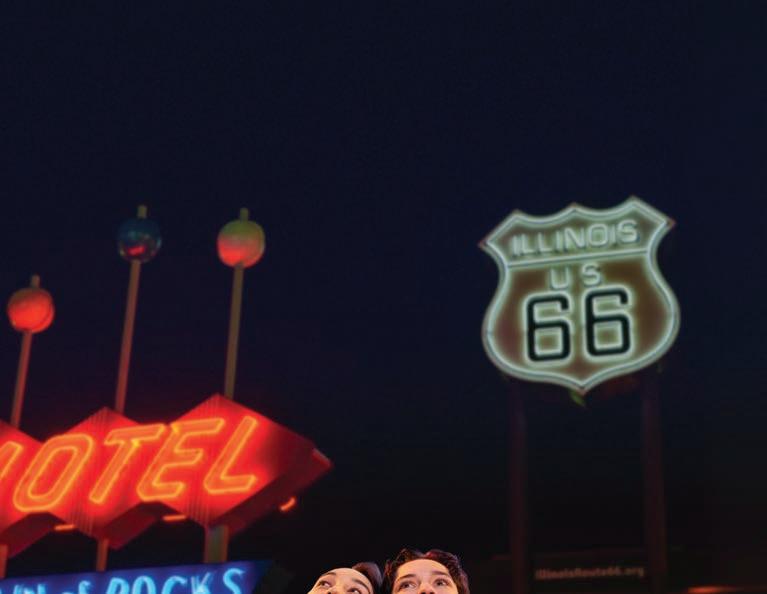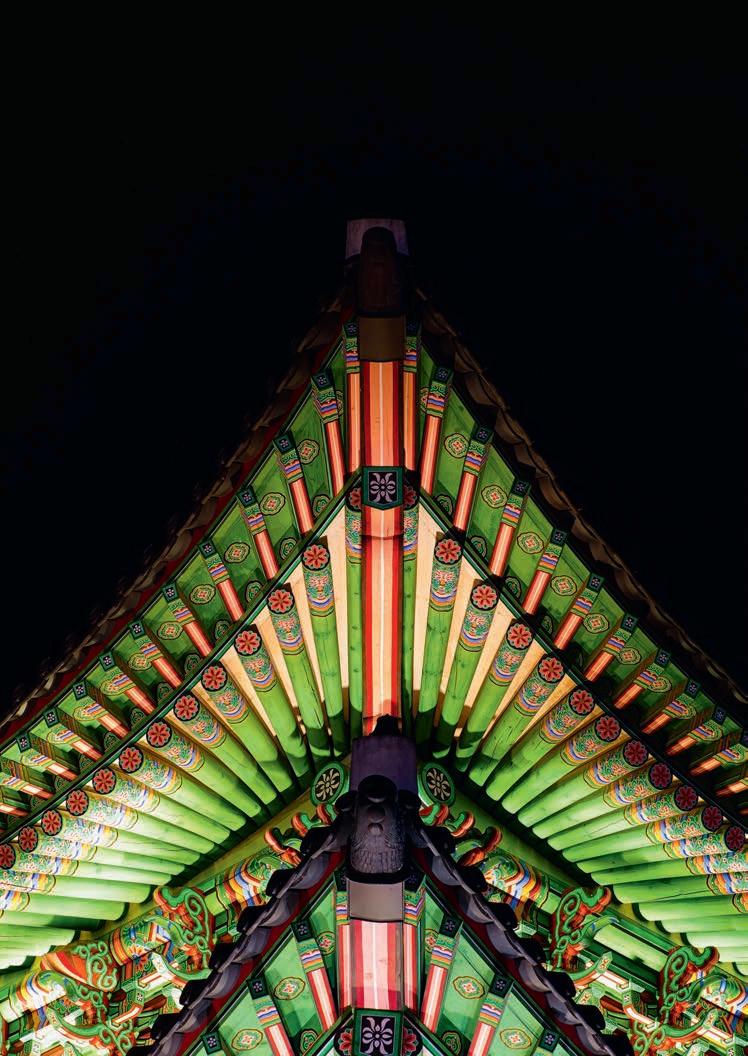

SOUTH KOREA



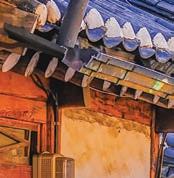




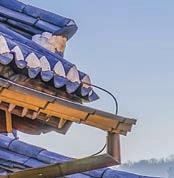















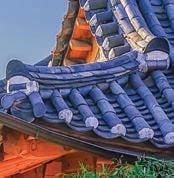
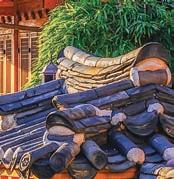











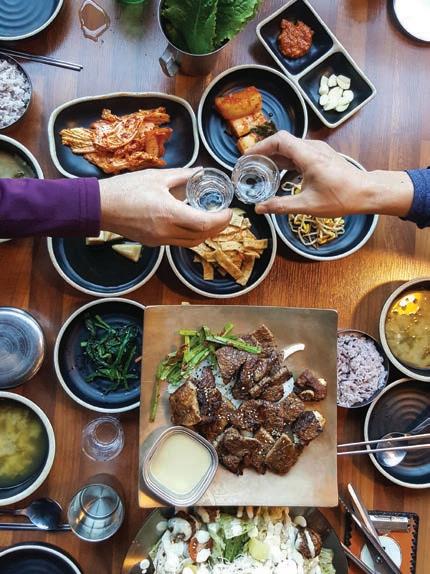






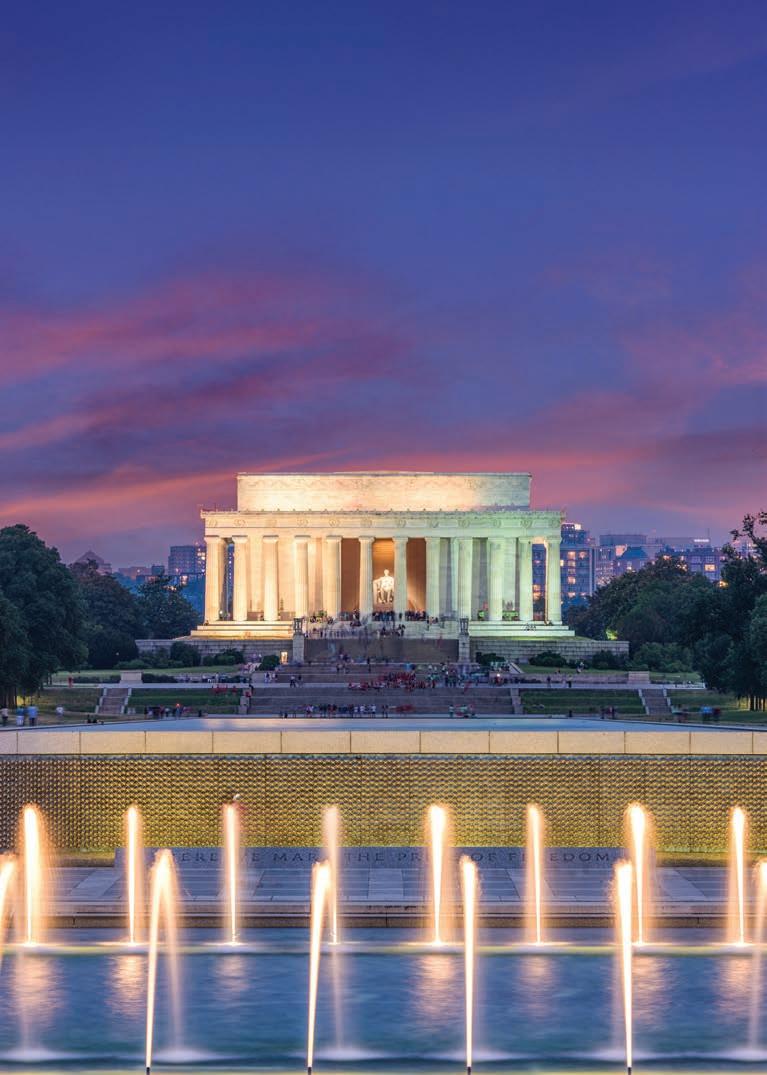
Riding the Hallyu wave

This is the first time that we’ve chosen a Destination of the Year to highlight at Wanderlust. Why have we done so, you might ask? Because we feel there are certain places around the world that deserve more attention from our intrepid travellers. What better way to celebrate a destination’s travel potential than with a grand homage in these very pages?
Picking South Korea (p132) may not have come as much of a surprise. The country has increasingly been in the spotlight over the last few years through the spread of its television shows, films and music, as the world embraces Hallyu (the Korean Wave). However, when visiting this past April – during the magical cherry blossom season no less – I found that many of the country’s incredibly scenic and historic sites were almost devoid of Western visitors. Beyond Seoul’s exquisite royal palaces, I encountered few crowds, a friendly welcome and great prices.
For example, Kyoto in Japan may now be feeling the burden of its popularity, but South Korea’s historic city of Gyeongju is far less busy, better value and equally captivating. I’m not saying it’s an exact doppelganger – we at Wanderlust believe each and every destination is unique – but it’s an interesting parallel.
Elsewhere in the magazine, it’s business as usual, as we cover a variety of places and experiences to inspire you, going beyond the usual suspects that have been dominating travel news coverage this summer. I just returned from visiting Moldova (p124), an unsung European nation that certainly deserves more visitors. Our editorial team has also been crisscrossing the planet: Lyn Hughes encountered an alternative ‘Big 5’ in Malaysia’s Sabah (p90), Jessica Reid explored NewSouthWales’SapphireCoast and beyond (p80), Mark Stratton embarked on an archaeoastronomy tour of Peru’s pre-Inca wonders (p66), while Jacqui Agate explored the rugged beauty of Washington state (p110).
For us, the summer is almost over and we’re already looking ahead. We’re equally busy preparing two mega 260-page issues that will hopefully inspire your travels this coming autumn.
As my Korean hosts would often say, 좋은 여행 되세요 (pronounced joheun yeohaeng doeseyo) – or have a nice trip!
George Kipouros Editor in Chief @georgiostravels



Responsible,conscious andsustainabletravel isattheheartof everything wedo

From courtyard to canopy (top to bottom) History and nature rise to the fore this issue. Whether planning a trip to make the most of South Korea’s heritage sites and Joseon-era palaces (p132), meeting the proboscis monkeys of Sabah (p90) or discovering the ancient cultures buried beneath Cusco’s Inca festivities (p66), we are reminded that every journey has its unforgettable moments

Established in 1993, Wanderlust is the UK’s longest-running travel-media brand and the #1 Consumer Travel Magazine in the UK
Off-thebeaten-path and off-season destinations and experiences around the world
Thought-provoking content for all kinds of travellers, ranging from culture, history, art and heritage through to our unrivalled nature, wildlife and adventure-travel coverage
Extensive coverage of immersive, authentic and longer travel experiences for the passionate travellers who care deeply about our planet and its people
A strong focus on responsible, sustainable travel throughout our publications in print and online, culminating in our unique and annual The Travel Green ListTM issue
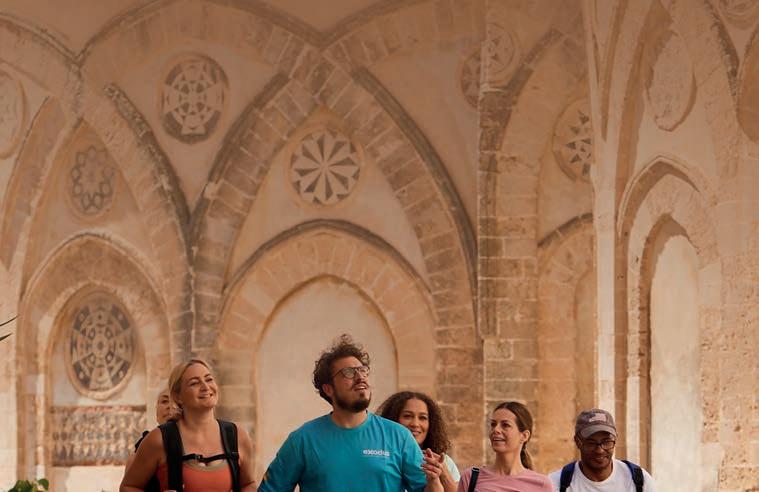




Contributors

HARRY RAKOTOSALAMA
Madagascar, p182
“Even after two decades of guiding wildlife tours, I was astounded to uncover the hidden wonders of Madagascar. The diversity and behaviour of lemurs, the towering majesty of baobabs and the vibrant camouflage of chameleons just leave me in awe.”

ROBYN WILSON
Museum Cities, p176
“Oslo’s cultural scene offered insights into the capital and Norway as a whole. I’d begin my days among the city’s art collections, then hop to exhibitions ranging from polar exploration to the creation of the Nobel Peace Centre. Proof that Norway packs as much cultural punch as its neighbours.”
Diversity In Travel Writing Matters

NICOLA WILLIAMS
Active France, p158
“The remote, wild peatlands of France’s Haut-Jura were formed by melting glaciers 10,000 years ago, and were the biggest surprise for me in uncovering France’s active side. They are a haven for hypnotic cottongrass and carnivorous plants – all sorts of wetland flora that grows nowhere else in the country.”

PAUL STAFFORD
South Korea, p132
“Korea beguiled me with its juxtaposition of high-tech cities alongside centuriesold palaces. But the sight of Seoraksan National Park’s resplendent autumn foliage – a blaze of reds and yellows from the maple and ginkgo trees – swarming the ribbed-roofs of Buddhist temples was a revelation.”

JUNGHYUN PARK
World Food, p52
“While I had studied and deeply considered hansik (Korean cuisine) for a long time in my life, during the process of writing The Korean Cookbook I realised how little I really knew. It taught me the true value of exchanging my thoughts with different people around the world.”

KATIE SCOTT
British Break, p186
“Many historical sites in Jersey are easily accessible to visitors but, even after years of visiting, I didn’t appreciate how much excavation is still ongoing. There are digs as well as projects collating recollections of the island’s past and present. It is a fascinating geographical and geological frontier.”
Since 2020, Wanderlust has committed to working on commissioning at least 20% of its content from travel writers from underrepresented backgrounds and historically underrepresented groups. These include members of Indigenous communities, people of colour, LGBTQIA+ activists, people with health conditions or impairments, and people from disadvantaged socio-economic backgrounds. We want everyone to share their passion for travel with our readers!
© Wanderlust Travel Media Ltd, 2024, ISSN 1351-4733
Published by Wanderlust Travel Media, Capital House, 25 Chapel St, Marylebone, London NW1 5DH. All rights are reserved. Reproduction in any manner, in whole or in part, is strictly forbidden without the prior written consent of the publishers. All prices are correct at time of press. No responsibility for incorrect information can be accepted. Views expressed in articles are those of the authors, and not necessarily the publishers. Wanderlust is a registered trademark. US distribution Wanderlust (ISSN No: 1351-4733, USPS No: 23718) is published six times per year by Wanderlust



Travel Media Limited, and distributed in the USA by Asendia USA, 701 Ashland Ave, Folcroft PA. Application to Mail at Periodicals Postage Prices is pending at Philadelphia, PA, and additional mailing offices. POSTMASTER: send address changes to Wanderlust, 701 Ashland Ave, Folcroft, PA. 19032. Contributions & work experience For details, please go to www.wanderlustmagazine.com/about-us Printing Walstead Roche, Victoria Business Park Roche, St Austell, Cornwall PL26 8LX Newstrade distribution Marketforce (UK) Ltd: 0203 787 9001 Circulation marketing Intermedia Brand Marketing Ltd: 01293 312001


Get In Touch
LONDON OFFICE
Capital House, 25 Chapel St, Marylebone, London NW1 5DH
Subscriptions +44 (0)1371 853641, subs@wanderlust.co.uk
Advertising +44 (0)20 4583 5486, sales@wanderlust.co.uk
General Enquiries: UK: +44 (0)20 8185 0958 USA: +1 64 6844 8718 info@wanderlust.co.uk
EDITORIAL CONTENT
Editor-in-Chief George Kipouros @georgiostravels
Founding Editor Lyn Hughes @wanderlust.lyn
Associate Editor Gareth Clark
North America Editor Jacqui Agate @jacquiagate
Special Features Editor Rhodri Andrews
Special Features Editor Rosie Fitzgerald
Special Features Assistant Editor Laura Field
Sustainability Contributing Editor Karen Edwards @KarenNEdwards_Writer
Sustainability Editor at Large Ketti Wilhelm @tiltedmap
Contributing Editors Lynn Brown, William Gray, Juliet Rix, Sherry L Rupert & Mark Stratton
Assisted by Cynthia Chan
DESIGN
Art Director Graham Berridge
PRODUCTION
Production Manager Peter Helfrich
DIGITAL
Digital Creative Director Anil Karwal
Digital Editor Jessica Reid
Digital & Social Media Executive Nefeli Syriopoulou
COMMERCIAL PARTNERSHIPS
Chief Commercial Officer Adam Lloyds (adam.lloyds@wanderlust.co.uk)
VP Brand Partnerships David Read (david.read@wanderlust.co.uk)
Senior Creative Partnerships Manager Simon Bryson @_bryos
BUSINESS
Chief Executive George Kipouros
Chief Operating Officer Elliot Wellsteed-Crook
Marketing & Social Media Manager
Christina Wildman Mullett (maternity leave)
Wanderlust Club Manager Maria Manta
In memory of Co-founder & Publisher Paul Morrison
















CHECK IN
12 Viewfinder
Wandering bears, empathising with gorillas, boat-building in Bahrain, and a winner returns
20 Just Back From…
Why Northwest Arkansas’ cultural scene now rivals even the wilds of the Ozark mountains for our attention
27 Your Photos
You send us your top travel shots
JOURNAL
31 Grapevine
Keep in the travel loop with all the latest news, views, exhibitions and stays
36 In Focus…
With reports of the serious injuries caused by turbulence in the headlines, we ask: how worried should we be?
39 Set-Jetting
Will Game of Thrones
prequel House of the Dragon inspire as many travellers as its predecessor?
40 Armchair Travel
Travel books and podcasts to give you ideas for the summer
44 Sustainable Travel
As overtourism becomes more prominent, here’s how you can avoid becoming the problem
48 Departures
We pick the accessible trips that open up the world and its wonders to everyone
51 Health
The dangers of tick bites, and how to dodge them this summer
55 Dream Sleep: A Creba
Discover a sustainable private island escape in north-west Spain that puts nature first
DESTINATION OF THE YEAR:
52 World Food
Michelin-starred chef Junghyun
Park unpicks the origins of South Korea’s hansik cuisine, as well as where to find some of its best bites across the country
58 WanderSleeps
Whether escaping to a remote temple getaway or a palatial city bolthole, bag yourself both culture and comfort at these sumptuous South Korean stays
132 South Korea
Trip Planner
From towering volcanic peaks and traditional villages to the palaces and neon buzz of Seoul, we plot the best routes to sample all the regal history, pop culture and wilderness that South Korea has to offer
193 Wanderlust Quiz
Test your South Korean knowledge to see if you know your BTS from your KTX


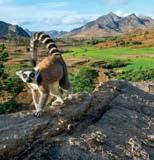



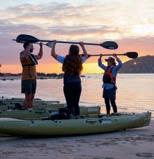

TRAVELOGUES
66 Peru
Time your visit to the Andean highlands to coincide with the solstice and you can explore a world that existed long before the Inca built their citadels, where even the streets are shaped by the heavens
80 New South Wales
Aboriginal history and an abundance of thriving small communities put the twinkle into Australia’s Sapphire Coast.
We hit the road in New South Wales to see just why its deep south shines so bright
90 Sabah
While Sabah occupies only a tiny part of Malaysian Borneo, the breadth of its endemic wildlife and ancient rainforest makes it a living nature documentary –even if it faces many challenges
110 Washington State
While many breeze through the Pacific Northwest on one long road trip, it pays to slow down in Washington state, where lush




islands, windswept sea stacks and temperate rainforest offer the purest hit of west-coast USA
124 Moldova
A renaissance is stirring in Europe’s ‘least visited country’, where Moldova’s celebrated wine scene, revitalised capital
and magical monasteries offers plenty to enchant visitors
158 Active France
As all eyes turn to the Paris Olympics, we look at the best ways to get outdoors in France, from cruising the canals to trekking barefoot in Normandy




DISCOVER
176 Museum Cities

Oslo’s museum and cultural scene is now one of the hottest in the Nordic region
178 Indigenous Culture
As Zambia’s safari operators turn to community tourism, travellers and the nation’s Indigenous peoples are feeling the benefit
180 World Heritage
How Tenerife’s San Cristóbal de la Laguna became the template for every early Spanish-built city in the Americas
182 Wildlife Encounters
Can tourism offer the endemic flora and fauna of Madagascar fresh hope of survival?
186 British Break
Jersey’s medieval castles, prehistoric sites and wartime relics offer a glimpse of the Channel Islands’ wild history
194 Top Guide
Sierra Leone guide and former child soldier Peter Momoh Bassie talks about how travel offered him a fresh start

Katmai National Park, Alaska, USA

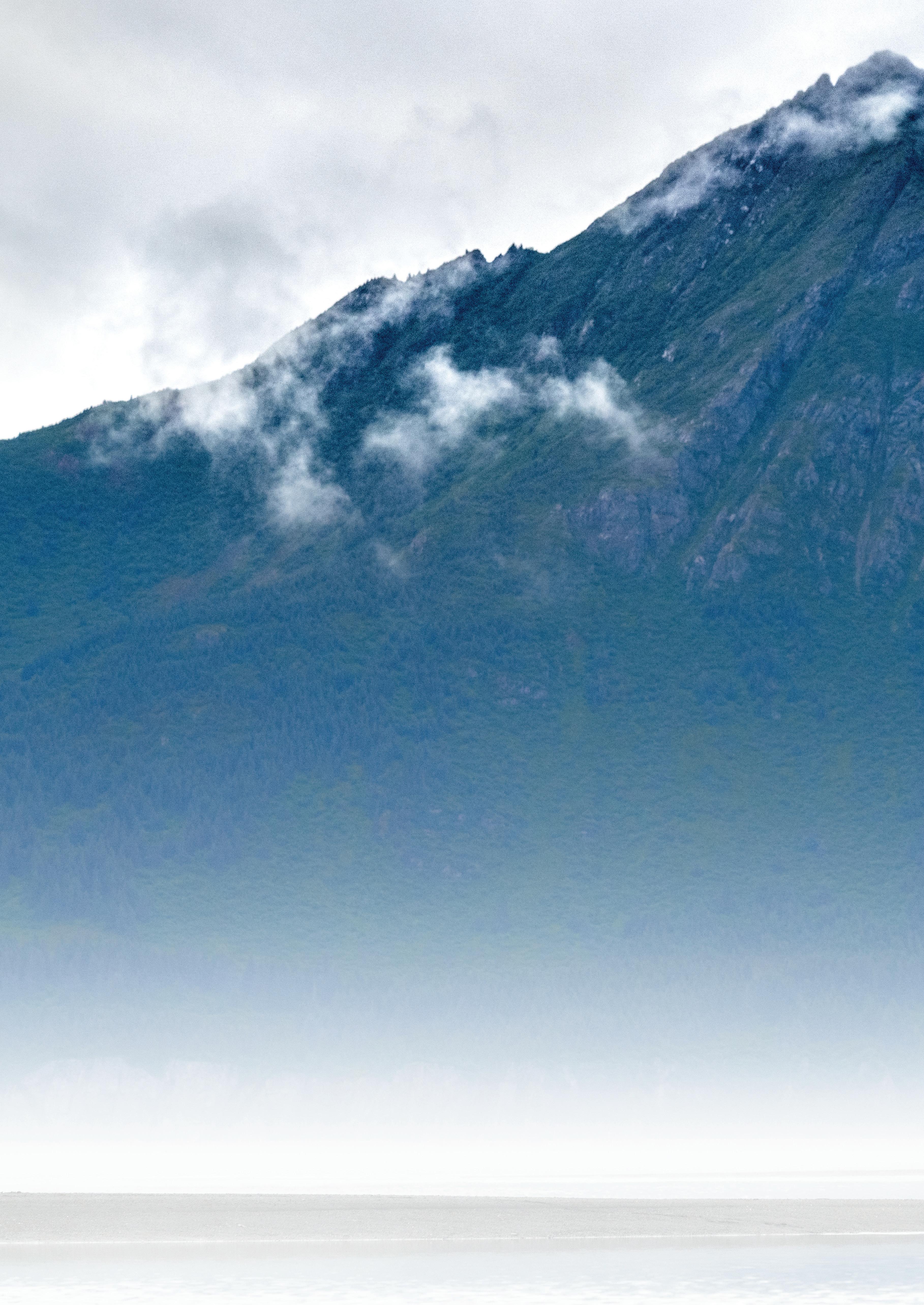
Photographer: Harry Skeggs.
Alaska’s remote Katmai National Park is best known to photographers and travellers for the sockeye salmon-run that draws hundreds of hungry brown bears to Brooks Falls in the summer. It even spawned the much-loved Fat Bear Week in October, ranking the chubbiest contenders of the season online. The sight of bears clawing leaping salmon out of the air is unforgettable, but it is in some ways misleading. It takes a shot like this, taken against the sentinels of Hallo Bay by Harry Skeggs for his new book, Creation, to recall that for all their size (Alaskan brown bears are some of the biggest in the world), these creatures live a largely solitary, fragile life in an environment infinitely more powerful. © Harry Skeggs. Creation: Masterpieces from the Natural World (teNeues; £50) by Harry Skeggs is out now. teneues.com
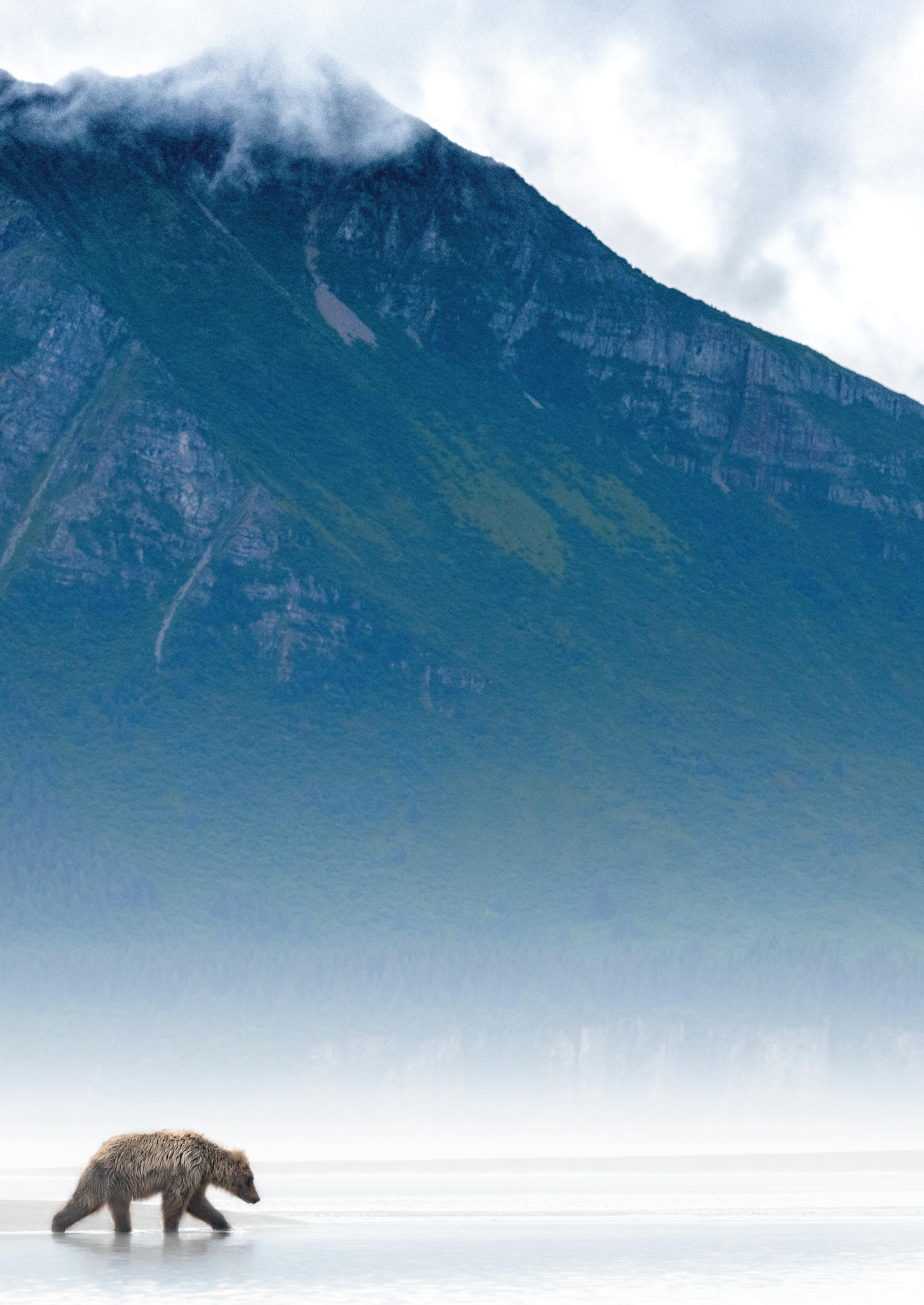


The western lowland gorillas of Central Africa Photographer: Vincent Lagrange. There is nothing like the experience of seeing a family of habituated gorillas up close in the airless jungles of the Republic of the Congo’s OdzalaKokoua National Park. All thoughts of tired, muddy limbs are forgotten in that one moment of pure acceptance. For animals such as the critically endangered western lowland gorillas of Central Africa, whose numbers have fallen 60% over the last 25 years, this connection is vital to their plight. It’s an idea that the photographer Vincent Lagrange explores beautifully in his portraits of often rare species. Collected together in his new book, Between Us, their human-like gaze reminds us that our empathy is often all that stands between these creatures and their extinction. © Vincent Lagrange. Between Us: Animal Portraits (teNeues; £50) by Vincent Lagrange is out now. teneues.com






Muharraq boatyard, Bahrain Photographer: Harald Gottschalk. Prior to the 1930s, when the prosperity of Bahrain soared or fell on the strength of its pearl harvests, the Ghous al Kabir (Great Dive) was everything. It marked the start of a four-month pearling season that began with locals emerging in their thousands to wave off departing wooden dhows filled with divers. Such sights disappeared with the rise of the cultured pearl industry, yet the skills associated with those times live on, as seen in the recently published Bahrain Crafts. Gallaf (ship builders) can still be sighted on trips to the old boatyard in Muharraq, where they continue to make dhows using traditional methods. For visitors, the gentle scrape of chisel on wood offers a link to Bahrain’s past arguably more tangible than any museum exhibit. © Harald Gottschalk. Bahrain Crafts by Sheikha Mariam Hisham Al Khalifa (Assouline; £85) is out now. assouline.com

Bamurru Plains Lodge, Northern Territory, Australia Photographer: Ben McRae.
To mark the 30th anniversary of Wanderlust, we asked you to pick your favourite photo from a selection of shots submitted across the last ten editions of our Travel Photo of the Year competition. Your overall ‘Best of the Best’ winner, Ben McRae, bagged himself a photo commission to Australia’s Northern Territory, from which he recently returned with this incredible shot of magpie geese in the skies above Bamurru Plains Lodge, on the edge of Kakadu National Park. “The geese are easy prey for eagles,” Ben told us, “and thousands took off and filled the sky when a single eagle appeared overhead.” But it wasn’t just the wildlife that took his eye: “I think this image tells the story of Kakadu itself, which is an amazing sanctuary: its wetlands hold a third of all bird species found in the whole of Australia yet see barely 200,000 visitors a year.“ Visit wanderlustmagazine.com to see all the winners in our Travel Photo of the Year ‘Best of the Best’ competition

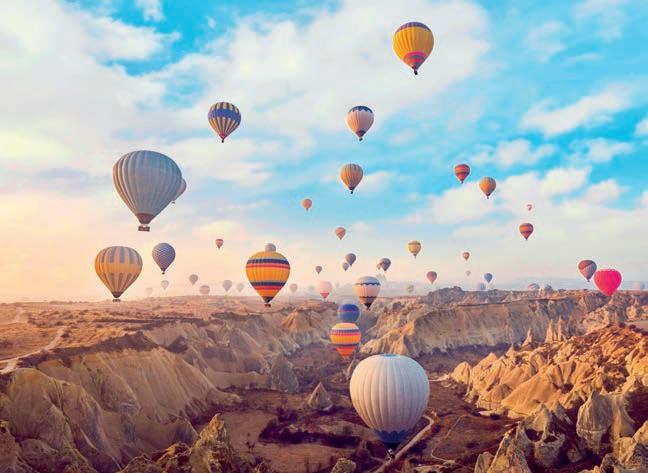
PAIR TURKISH GEMS IN İstanbul and Cappadocia
For a Turkish escape to remember, twin the historical and cosmopolitan charm of İstanbul with the biblical landscapes of Cappadocia
Türkiye is such a huge, diverse country that visiting just one area can feel like you’re being short-changed. So why not visit two very different ones instead: İstanbul and Cappadocia?
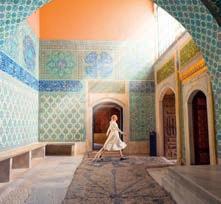
The former is one of the world’s great historic cities, a dazzling metropolis that straddles two continents; the latter is an ancient Anatolian region famous for its magical rock formations. Together they’re irresistible.
SEE İSTANBUL LIKE A LOCAL
With a history stretching back more than 2,500 years, İstanbul has enticed visitors for millennia, having begun as ancient Byzantium before becoming the mighty Constantinople, capital of the Eastern Roman Empire. It attracted the great artists and architects of the era; now modernday İstanbul is a veritable open-air museum, littered with UNESCO World Heritage sites.
You’ll need to set aside at least three hours to make the most of Topkapı
Turkish delights (this page; top to bottom) Soar over Cappadocia’s fairytale rock formations; spend hours strolling around the splendour of Topkapı Palace
Palace, a 15th-century complex of pavilions, courtyards and gardens in the historic Sultanahmet district. It was once home to the Ottoman sultans, and highlights include the harem, palace kitchens and arms collection.
Shop for jewellery and crafts at the Grand Bazaar, one of the oldest of its kind in the world, and spices and lokum (Turkish delight) at the Spice Bazaar, before walking up the hill to the Süleymaniye Mosque complex. This beautiful structure was designed in the mid-16th century by the imperial architect Mimar Sinan, who took his inspiration from the Hagia Sophia, which returned to serving as a mosque in 2020 and remains one of İstanbul and Türkiye’s finest sights.
Spend a few hours on a boat ride up the Bosphorus Strait, the mighty waterway in İstanbul that unites Europe
and Asia. Its pine-clad shores are lined with picturesque villages dotted with open-air cafés and lovely pastelcoloured Ottoman-era houses. Start your day’s sightseeing with a traditional Turkish breakfast, which will keep you fuelled till at least lunchtime. Choose from snacking on a simple simit, a sesame-encrusted bread ring that you can buy from street vendors, or take on the full monty: sucuk, a spicy sausage; a savoury egg dish called menemen; olives; tomatoes; goat’s cheese; freshly baked bread; and homemade jams and honey, washed down with Turkish tea. Some of the most authentic breakfasts can be found in local cafés in neighbourhoods such as Balat and Arnavutköy, or in lively Moda on İstanbul’s Asian shore, and you can finish your day at one of İstanbul’s MICHELIN-starred restaurants.
HOW TO GET FROM İSTANBUL TO CAPPADOCIA
Flying is the quickest way and takes about 1.5 hours. Several airlines operate flights from İstanbul Airport or Sabiha Gokcen Airport to Nevşehir Kapadokya Airport or Kayseri Erkilet Airport in Cappadocia, with different budget options available.
EXPLORE OTHERWORLDLY CAPPADOCIA
The lunar landscapes of Cappadocia are a stark contrast to the bright lights of İstanbul, and offer a fascinating glimpse into millions of years of history, geography and topography. As the soft layers of volcanic rock eroded through various ice ages, they formed tall conical structures – the famous ‘fairy chimneys’. Some are as high as 45m, and past settlers used them as housing; they even built entire underground cities, which
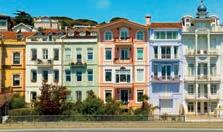



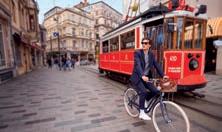
Calming waters (this page; clockwise from top left)
The mansions of Arnavutköy; a Turkish breakfast; marvel at the Hagia Sophia; the Dark Church Göreme Open Air Museum, Cappadocia; the Bosphorus unites Europe and Asia; İstiklal is one of İstanbul’s most iconic streets

the early Christians used as a hiding place from Roman persecution. Later, monks would carve out underground monasteries and churches and cover them in beautiful Eastern Roman (Byzantine) frescoes, some of which, such as Durmuş Kadir and Meryem Ana (Virgin Mary), you can still visit today. At the Göreme Open-Air Museum, a vast monastic complex and UNESCO World Heritage site, there are more of these structures to explore – the Dark (Karanlık) and Tokalı (Buckled) churches being two of the most important.
To get a taste of life as a cave dweller yourself, albeit one with all mod cons, book a night or two in one of Cappadocia’s luxury ‘cave hotels’ or boutique guesthouses. Many of them have panoramic viewing terraces and infinity pools. Another unique experience is to take a hot air balloon flight. Rising at dawn, you’ll be soaring high above Cappadocia by the time the sun rises, gaining a bird’s-eye view of the region’s extraordinary scenery.
For cyclists, Cappadocia’s volcanic landscape offers some of Türkiye’s best and most remote singletrack mountain-bike trails. Explore Görkündere Valley, Swords Valley or the Gomeda and Üzengi valleys on a guided cycling tour led by an expert local. Or for those who prefer to use their hands rather than their feet, you can join a pottery-making workshop. Classes are held in the town of Avanos in Nevşehir Province, where the practice of this craft dates back to the Hittites in the 2nd millennium BCE.



Explore Cappadocia
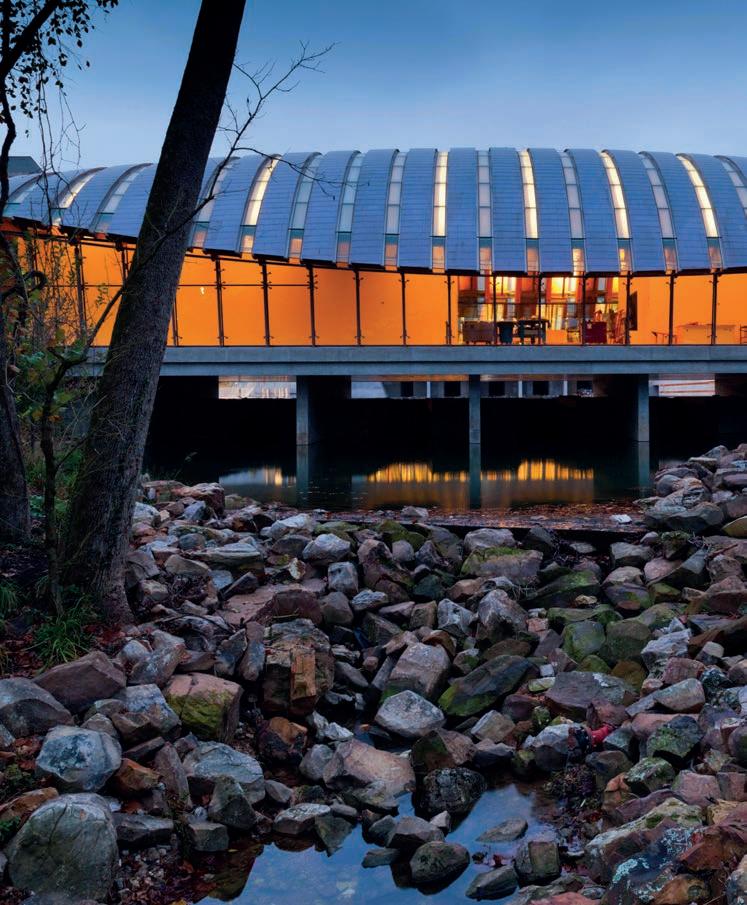

Northwest Arkansas, USA
Wanderlust’s Jacqui Agate reports back from the Natural State, where its north-west cultural scene now rivals even the wilds of the Ozarks for our attention
Over the past decade, I’ve returned year-on-year to the American South, relishing the cocktail of music, food and history that the region is famous for. But Arkansas, parcelled between Tennessee, Louisiana, Mississippi, Texas, Oklahoma and Missouri, had always been something of an enigma to me. I was determined to change that on a trip to the state’s Northwest Arkansas region: a bucolic enclave in the Ozark Mountains that I’d been told offered art and nature in spades. I began in Bentonville, a creative city whose astonishing recent growth means it has more cranes per capita than anywhere else in the US. This is Walmart Country (the superstore was founded by Sam Walton just a few kilometres down the road), and the construction of a new 140-hectare campus is grabbing national attention and attracting newcomers, who are making their mark on the region. My final stop – reached via quaint small cities and state parks along the way – was Fayetteville, a funky college town with a liberal, artsy vibe. Happily, I found this under-the-radar pocket of the South to be every bit as rich in culture and outdoor adventure as I’d hoped.
HIGHLIGHT
The region’s crown jewel is the Crystal Bridges Museum of American Art, an already mighty institution in the throes of a major expansion that should be completed by 2026. This Bentonville museum is just one marker of the Walton family’s defining impact on this area. It was opened back in 2011 by Sam Walton’s daughter, Alice, whose own glittering art reserve formed the foundations of the museum’s original collection. Today the museum represents an incredibly diverse and comprehensive snapshot of American art through the ages. Highlights include Precious jewels by the sea by Amy Sherald (best known for her official portrait of former First Lady Michelle Obama)
and Georgia O’Keeffe’s Jimson Weed. On my visit, the galleries displayed a striking installation entitled We the People, in which rainbow-coloured shoe laces were arranged to spell out the opening three words of the US Constitution’s preamble. Traditional portraiture of the Founding Fathers shared space with poignant works by Indigenous artists. The most striking was The Cost of Removal by Titus Kaphar, in which an equestrian painting of seventh-president Andrew Jackson (who signed the Indian Removal Act into law in 1830) is partly hidden by strips of canvas pinned with rusted nails.
The museum building is a feast for the eyes too. Designed by architect Moshe Safdie to blend into the natural surroundings, it spreads out in a series of shell-like structures clad in glass and floating above glistening reflection pools. It’s purposefully low-rise, becoming almost lost in a lush tree canopy, which was an eye-popping green during my spring visit. Looming outside the entrance is Maman, one of artist Louise Bourgeois’ giant bronze spider sculptures; this one includes a nest of delicate marble eggs.
Be sure to book a free ticket to explore Frank Lloyd Wright’s Bachman-Wilson House (reservations are essential given the small space), which is on-site at the museum. It was acquired and reconstructed here due to flood risks at its original New Jersey location, and its nature-forward, mid-century Modern design – all mahogany

A work of art (left to right) The Crystal Bridges Museum of American Art has an impressive permanent collection that spans five centuries; one of the first fiveand-dime stores opened by Sam Walton, founder of the Walmart chain, is now the site of the Walmart Museum in Bentonville, a quirky attraction that looks at the chain’s impact on the region and beyond – though it is currently undergoing a huge renovation
Alamy
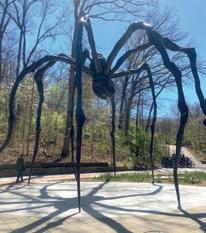
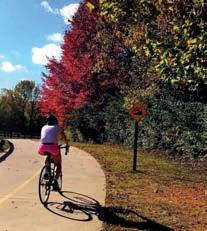

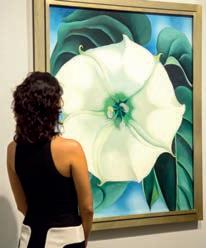


beams and floor-to-ceiling glass – is exemplary of the late architect’s work.
MUST-SEES
An offbeat art space in a former Bentonville cheese factory,The Momentary is Crystal Bridges’ cool younger sister. Its galleries are filled with changing contemporary exhibitions. During my visit, I explored a moving installation on the precarious future of the Amazon rainforest, including infrared photographs by Richard Mosse.The building also doubles as a concert venue, and its roster of eclectic live shows (everything from country rock to indie folk) is hosted in the Fermentation Hall theatre and on the green outside. Bentonville excels at public art too. Wander around the city and you’ll find everything from psychedelic neon installations to intricate paintings of flowers and butterflies. Don’t leave without visiting the Walmart Museum Heritage Lab (this is the Walmart Museum’s temporary location as it undergoes a major renovation). It
might seem an offbeat stop, but the history of the superstore is synonymous with the region, and the museum exploresWalmart’s rippling impact on this slice of Arkansas and beyond.You’ll listen to tales narrated by a hologram of founder Sam Walton and take in fun exhibits such as its customers’ most ridiculous reasons for returning items.
Motor out of Bentonville and make a pit stop at Hobbs State Park-Conservation Area, just over 30km to the east. Offering a wild break from artistic city pursuits, this Ozarks bolthole throws weight behind Arkansas’ ‘Natural State’ nickname. Don’t skip the visitor centre, which primes hikers for the wildlife they might encounter, from bald eagles to black bears. Outside, hiking and biking trails skirt Beaver Lake and wriggle past mushrooming karst-rock formations. Freewheeling Fayetteville should make it onto your itinerary too. The downtown core is pleasingly walkable, and I spent time at the Saturday farmers’ market before ducking into the Clinton House Museum.
This modestTudor Revival-style house was the home of 42nd-president Bill Clinton and fellow politician Hillary Clinton from 1975 – they were even married in the living room. It remains outfitted in gloriously kitsch 1970s decor and is filled with exhibits and memorabilia, including campaign-trail posters and university photos of the pair.
Finish with another hit of north-western creativity at Mount Sequoyah, a former church retreat home to Fenix Arts, a progressive collective whose gallery includes everything from photography to sculpture.There are unrivalled views of the city from its soaring hilltop location too.
TOP TIPS
This region of Arkansas is hailed as one of America’s top places for mountain biking, thanks to its hilly Ozarks terrain, trail network and dedicated cycling community. Plenty of advanced trails zig-zag the parks and forests, and the US Pro Cup 2024 was held in Fayetteville’s Centennial Park while I was in town.
Cultured Arkansas (this page; clockwise from top left) Louise Bourgeois’ Maman sculptures scatter locations across the globe, including Crystal Bridges Museum; the Razorback Greenway connects seven communities in Northwest Arkansas; a hologram of Walmart founder Sam Walton; Hobbs State ParkConservation Area; Crystal Bridges was designed by architect Moshe Safdie; Georgia O’Keeffe’s Jimson Weed; (opposite page) the former home of the Clintons
Alamy; Helen Jackson
The paved Razorback Greenway provides a smoother way to zip around on two wheels. You can rent bikes or e-bikes from E-Bike Bentonville (e-bikebentonville.com) and travel between Kessler Mountain Regional Park in Fayetteville and Lake Bella Vista (north of Bentonville) on this 64km trail.
Fun fact: Bentonville is also home to what’s said to be the world’s first bikeable building.The Ledger is a modern retail and office space with switchback ramps that climb to the top of the structure.
CAUTIONARY TALE
Arkansas is one of the larger Southern states, and although there was plenty to keep me busy in its north-west, more forward planning might have let me hit some other hotspots. Country legend Johnny Cash was born in Arkansas, and his boyhood home lies some 530km to the east of Bentonville; 322km to the south, Crater of Diamonds State Park is one of the only places on the planet where the public can dig for diamonds; and state capital Little Rock is a hotbed of Civil Rights history.
I WISH I HAD KNOWN
A single afternoon is not nearly long enough to take in the galleries and grounds of Crystal Bridges; next time, I’ll set aside a full day.
ANYTHING ELSE
It’s well worth making a detour east of Bentonville to tour the Turpentine Creek Wildlife Refuge. For more than 30 years, this accredited sanctuary has been dedicated to the rescue of abused and exploited big cats across the USA (including those bred by Joe Exotic from the Netflix series Tiger King).You’ll explore on an open-air tram tour with passionate guides, who share details of the sanctuary’s work and introduce the resident animals (there is strictly no interaction, as per the requirements for sanctuary accreditation). The leafy Ozarks location is a bonus too.
RESOURCES
Arkansas.com; visitbentonville.com; experiencefayetteville.com
YOUR LETTERS

Dining in the Caucasus
Soaking up rural Albania
It was delightful to read about community tourism in Albania (issue 232; April/May), not least because it brought back fantastic memories of hiking in the Albanian countryside on the picturesque Via Dinarica, surrounded by the Dinaric Alps – limestone rises so sparkling that they always give the illusion of being snowcapped.
The Via Dinarica (2,000km) stretches through eight countries on the Balkan peninsula. The part I walked in Albania skimmed through bits of Montenegro, finishing in Kosovo. My four nights in the Albanian countryside were spent in modest homesteads: cozy wooden houses that nestled in green valleys surrounded by mountains. What swept me and my co-travellers away was the hospitality of the people in these mountain hamlets. Their affection was genuine and the food served was delicious, homely fare. Our hikes were leisurely, stopping every few hours at the insistence of villagers who simply wanted to extend their kindness with cups of mountain tea, wild berries and yoghurt. We cuddled babies who were brought out to say hello, stroked farm animals and communicated through our eyes and body language. Most would not even accept payment; it was simply hospitality and kindness.
So, when I see Wanderlust mentioning community tourism in Albania, it touches a chord. The most memorable travels are about people. Nandini Chakraborty


Having also just returned from Georgia (issue 232; Apr/ May), I’d like to recommend the food there, and two dishes in particular: khachapuri and khinkali. Khachapuri are breads oozing with melted cheese, and were so irresistible and cheap that I ate them every day, exploring each regional variation. Breakfast in Tbilisi was warm imeruli khachapuri stuffed with sour, salty Imeretian cheese. In the Samegrelo-Zemo Svaneti region, we had the megruli variety with sulguni cheese in the middle and on top, and on the way to Ushguli, one of Europe’s highest continuously inhabited settlements, we tried meat-filled kubdari (stuffed breads) at a local café. But the best was saved for the Black Sea resort of Batumi, where I ate adjaruli (pictured), a canoe-shaped bread full of cheese and butter. Sadly, our trip was not long enough to try the documented 47 varieties. Khinkali, on the other hand, are dumplings filled with brothy beef mince that pair well with beer. They’re always ordered in quantity, and the knack to eating this mushroom-shaped dumpling by hand is to hold it by the stem, taking a small bite from the side so you can slurp out the hot broth before chewing your way into the filling. Needless to say, it’s messy and an acquired skill. The dough stems are then discarded and left on your plate to track how many you’ve eaten. Helen Jackson

Please drop us a line with your stories and travel tips at fromtheroad@wanderlustmagazine.com and help others find their way. Be sure to also follow us on Facebook (wanderlusttravelmagazine), Threads (@wanderlustmag), X (@wanderlustmag) and Instagram (@wanderlustmag).

Transform your idea of adventure
The greatest destinations in the world deserve the grandest adventures. Thankfully, G Adventures’ curated collection of new Geluxe trips offer just that…
Big trips can be life-changing.
But there’s also no denying that at the end of an action-packed day, it’s always nice to relax and enjoy a little luxury. Enter G Adventures’ new Geluxe collection…
Focused on premium accommodation and tailor-made, immersive experiences, these 45 tours (across 26 countries) give you the space to contemplate what you’ve just experienced. Best of all, Trailfinders has hand-picked some of the very best and packaged them up with flights and transfers, so you don’t need to worry about a thing...
THE 3 FOUNDATIONS OF EVERY GELUXE ADVENTURE
1 Sleeps to remember
Every Geluxe trip has comfort at its core, and that begins with your accommodation. Its ‘OMG stays’ are cherrypicked to give that extra sparkle, whether it be compelling history, unique architecture or just the goosebump feeling that comes from being somewhere a little bit special. And if all that’s not enough, you’ll also find otherworldly vistas and compelling experiences, such as kayaking on a lake right outside your bedroom window, lazing by a pool in the shadow of a volcano or gazing

across golden sand dunes from your luxury tent terrace.
These hotels, lodges, bungalows and tents are more than just somewhere to sleep at the end of a busy day; they offer a unique experience in themselves – one that will hopefully stay with you long after you’ve checked out.
2
One day, your way
Is there anything more liberating than doing what you want, especially when travelling? This is the inspiration behind Geluxe’s ‘OMG days’, which let you personalise one of the days of your tour by picking between two exciting experiences. It’s a real-life ‘choose your own adventure’!
Adventures of all kinds (this page; top) Stroll the dreamy beaches of Manuel Antonio National Park in Costa Rica on a signature Geluxe trip; (bottom) you can go canyoning in La Fortuna, Costa Rica
This is your chance to opt for that big hike or explore the UNESCOlisted site you’ve always wanted to see up close. Perhaps you could learn to cook a cherished national dish or gird yourself to finally hit those rapids. It’s a great way to finesse your trip, sculpting it to fit what interests you.
The list of activities varies depending on your destination. In Japan, you’ll pick between a full-day trip to Mount Fiji or taking a foodie tour of Tokyo; in Morocco, you have the choice of meeting the nomads of the Sahara or spending the day with a Moroccan farmer; and in Costa Rica, you can weigh up spotting sloths in the jungle against a waterfall swim. The choice is yours, and yours alone.
3Community tourism is at the forefront
Key to the Geluxe experience is the chance to delve into local cultures, exploring ways of life that have withstood the march of time for centuries. Each itinerary offers meaningful interactions with local people, including the opportunity to experience traditions and skills handed down through the generations.
It’s a chance to gain insights into different ways of life you wouldn’t ordinarily see. This can mean anything from sitting down with local people
and listening to their stories, to sharing a meal at their table, learning to cook their favourite dishes or embracing a host of different traditions. This is your opportunity to both travel thoughtfully and spend time in communities who benefit directly from your presence.
On any given day, you could find yourself uncovering the secret to how coffee is harvested and made in Costa Rica or learning all about oases and the desert from local farmers in the Sahara, or hearing about the legends that surround Lake Tazawa in northern Japan. It’s a unique way to see a side of your chosen destination that isn’t always immediately apparent.
ABOUT THE EXPERTS
Trailfinders has over 50 years of experience in crafting bespoke, oncein-a-lifetime adventures. Its teams can offer expert advice and insights, and can ultimately book your entire escape, so you can focus purely on all that pre-trip excitement. They’ll arrange flights, hotels, transfers and experiences as needed – before and after your Geluxe trip – and are on hand 24/7, 365 days a year, from the moment you book to your return home, so you can concentrate on maximising your adventure –just like you should on every Geluxe trip.


Travel the Geluxe way (this page; clockwise from bottom left) Traverse the Sahara Desert in Morocco with a local guide; spend the night in the luxurious Rio Celeste Hideaway Hotel in Costa Rica; the Shibuya Crossing is an experience in itself in Tokyo; few settings are better for an epic escape than the jungles of Costa Rica
TRAILFINDERS’ TOP GELUXE TRIPS
Japan
Kyoto, Tokyo & the Michinoku Coastal Trail
On this 11-day tour, you’ll explore offbeat villages outside Kyoto, kayak Japan’s deepest lake and undertake parts of the 1,000km Michinoku Coastal Trail as it connects mountain tracks and rice fields. Round off your exertions with hot-spring soaks and sake sips, resting your bones for the next day.
Costa Rica, North and South National Parks, Wildlife & Hot Springs
Costa Rica is a cradle of biodiversity, home to nearly 6% of the planet’s species. This 15-day tour offers the chance to soak up its natural wonders by visiting La Fortuna, Manuel Antonio National Park and the jungles and beaches of the Osa Peninsula. And when you’re not hitting the water in a kayak, you can revitalise your muscles in volcano-fed hot springs.
Southern
Morocco
Marrakech, the Atlas Mountain & the Sahara
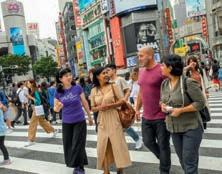
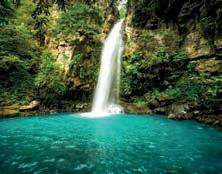

Whether it’s sleeping under the starry desert sky or exploring ancient kasbahs, this eight-day tour of Southern Morocco opens up a different world to the usual Marrakech city break. Hike the Dades Gorge, ride a camel, experience Berber culture and stroll through olive and juniper groves before retiring to your luxury lodge or riad at night.


















#wanderlustmag
You’ve been sending us images of your latest trips and favourite adventures – tag us at #wanderlustmag on Instagram, or email them to us at fromtheroad@wanderlustmagazine.com
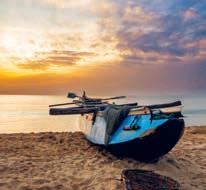
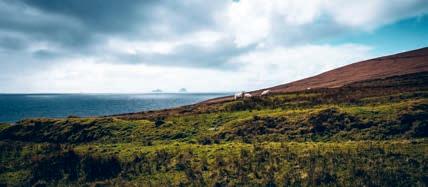
“An unplanned hike on Valentia Island, Ireland, led to an off-trail excursion to capture an image of sheep and the Skellig Islands in one shot. I think I succeeded. Absolutely gorgeous!” @massey_original

“This section of the world’s largest cave, Hang Son Doong in Vietnam, is aptly named ‘Watch Out for Dinosaurs’.” @shuotography
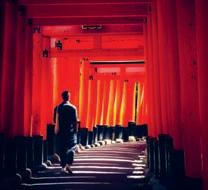
“Though more crowded these days, you can still find moments of serenity among Kyoto’s torii gates.” @mortenvstheworld
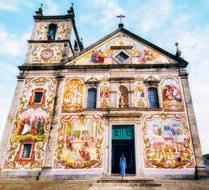
“The Igreja Matriz de Santa Maria in Válega, Portugal, looks like it comes straight out of a fairytale!” @ wayne_and_ling
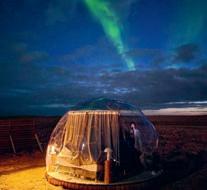
“The gods were kind on our epic trip to Iceland, as you can see from the aurora over our ‘igloo’ near Hella.” MarkWalford

“I was on the Acropolis when Saharan sands swept across Athens, creating this otherworldly sunset.” Peter Hankinson
“The sun rises over the boats of local fishermen as they patiently await a long day’s work in Kalkudah, Sri Lanka.” Kristin Smith
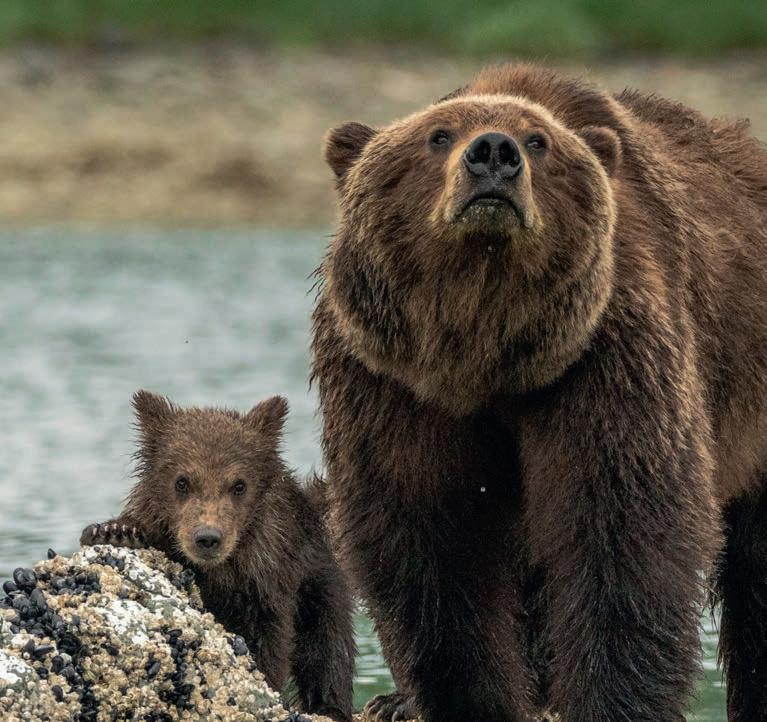


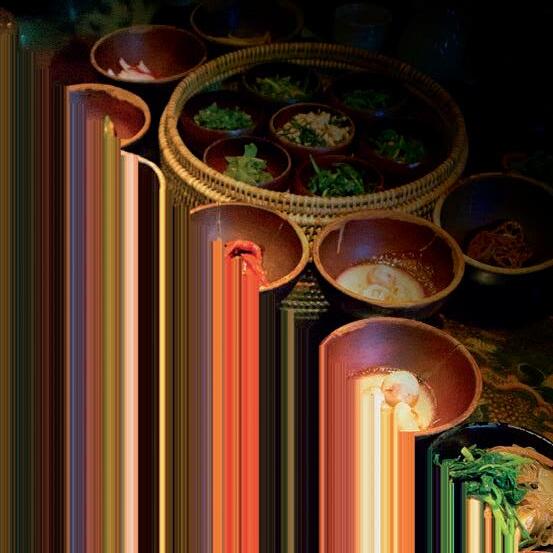

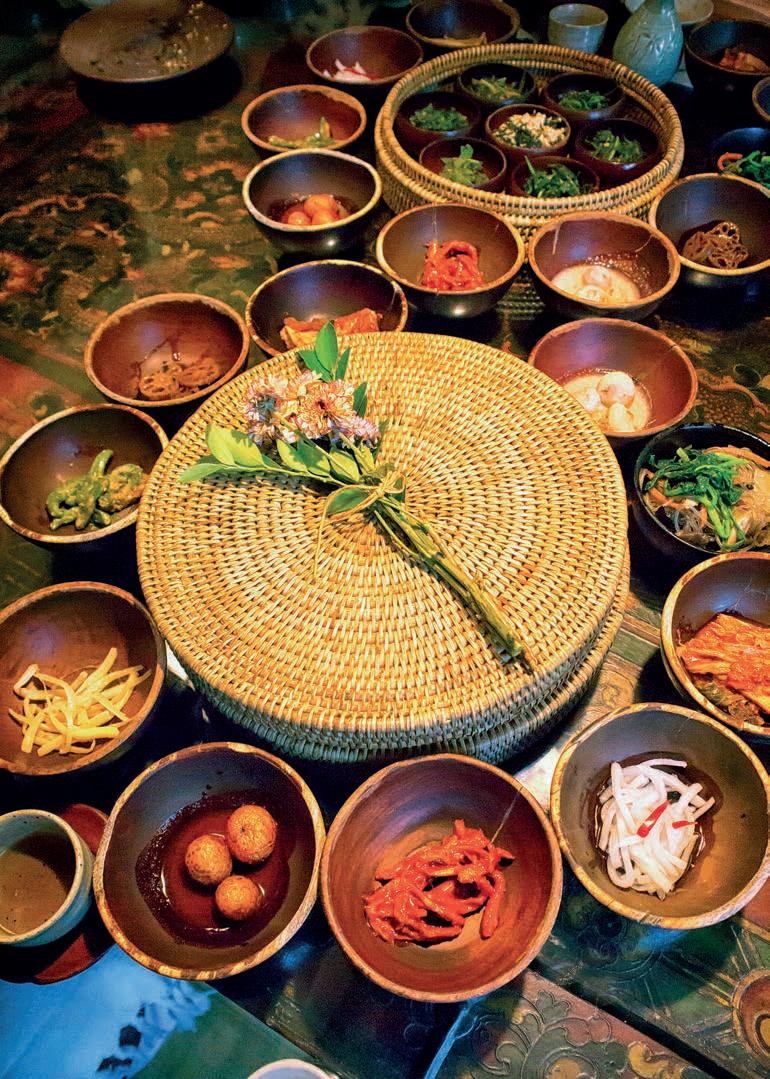
The land of gochujang The story of South Korean cuisine is one of mountainous terrain and 500 years of Joseon kings, which created a food like no other. From the spread of Korean fried chicken to the ever-popular banchan (small plates; pictured), Michelin-starred chef Junghyun Park examines its roots on page 52
Alamy

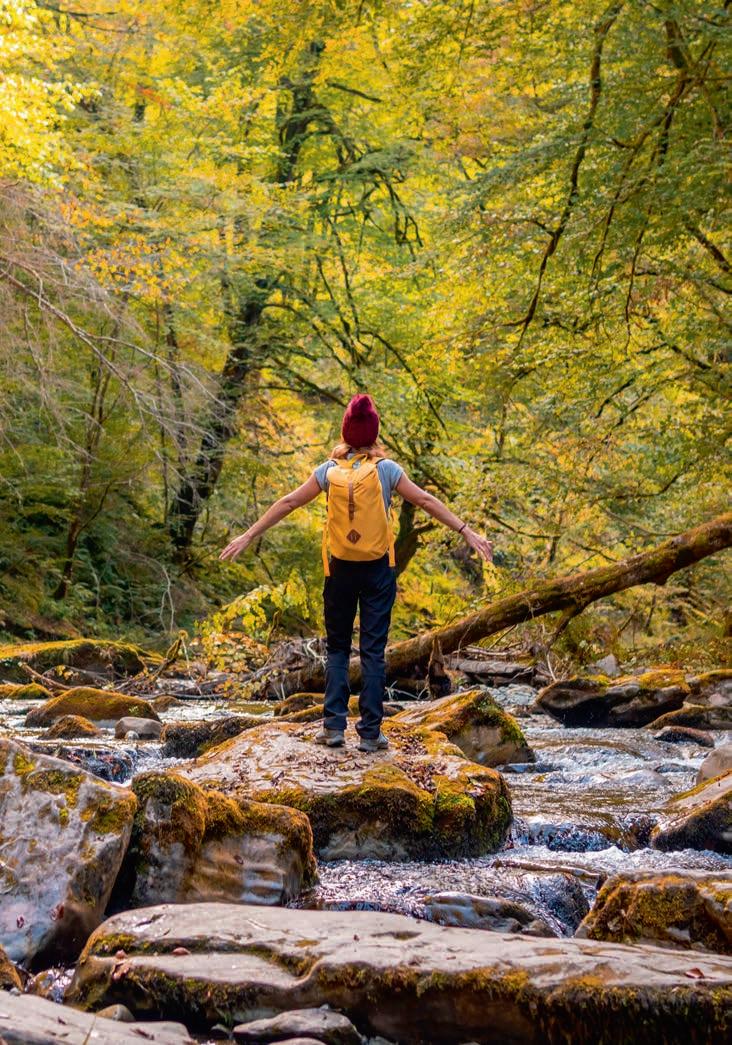

What’s New
The latest gallery openings, festivals, tours and train routes to get your feet moving




Strasbourg turns a page
Strasbourg has become the first French city to be named a UNESCO World Book Capital, taking over from last year’s Accra. It’s a good fit: the Bibliothèque Nationale at Strasbourg University is one of the largest libraries in France, while many of the city’s independent bookshops are set in beautiful old buildings. Under the theme ‘Read our World’, it hopes to use its status to educate visitors on climate change and social injustice through more than 1,000 events and nearly 200 initiatives. The choice is dizzying, but our top picks include the immersive Pages Blanches Programme at the Théâtre Actuel et Public de Strasbourg, featuring weekly themed literature and music events, as well as several summer shows at the same venue. lirenotremonde.strasbourg.eu
Steaming throughVietnam

By early 2025, visitors to Vietnam will have a brand-new opportunity to travel through the country via steam train. Two locomotives built locally in the 1960s have gone through years of painstaking restoration to form the Revolution Express, a new heritage experience that will add a dash of old-fashioned charm to rail travel in Vietnam. The train will include two retro-styled carriages, each carrying up to 57 passengers, plus kitchen and baggage carriages. It will make a daily return trip between Danang city and the former royal capital of Hue, passing the Hai Van coastal mountain range and stopping at Lang Co, just next to the beautiful lagoon and beach. Themed dining can be found at the three railway stations en route, with each having its own menus and entertainment schedules. Make sure to also keep an eye out for the next issue of Wanderlust, where we’ll explore more of the world’s most exciting new rail journeys.

Exhibitions & openings
The former Antwerp home of Flemish artist Peter Paul Rubens reopens on 30 August following the completion of the first phase of its renovation. A visit to Rubenshuis (pictured) now includes the Rubens Experience, an interactive exhibition with videos telling the story of the most influential artist of the Flemish Baroque tradition. rubenshuis.be
Pennsylvania’s Palmer Museum of Art has moved from its former home on Curtin Road to a new building within Penn State University’s Arboretum. The site has doubled its exhibition space to house more than 10,000 pieces. Look out for its Made in PA exhibition (until 1 Dec), a collection of works by local artists. palmermuseum.psu.edu
The Stonewall National Monument Visitor Center has now opened in Manhattan’s Greenwich Village in New York. Based in part of the historic Stonewall Inn, around which the protests and riots in support of gay rights in the late 1960s centred, it’s the first US national monument to tell the story of the LGBTQIA+ struggle. stonewallvisitorcenter.org
Czech artist Alphonse Mucha’s paintings and decorative art embodied what was remarkable about the Art Nouveau movement. Check out the Spirit of Art Nouveau exhibition at Sydney’s Art Gallery of New South Wales to see his influence across some 200 works. artgallery.nsw.gov.au
After a three-year tour of the Yukon, the Honouring Our Future: Yukon First Nations Graduation Regalia exhibition has arrived at Canada House in London (until 6 Oct). The traditional clothing of Indigenous Canadians tells stories that resonate with First Nations communities. This is a great chance to hear them.
⊲
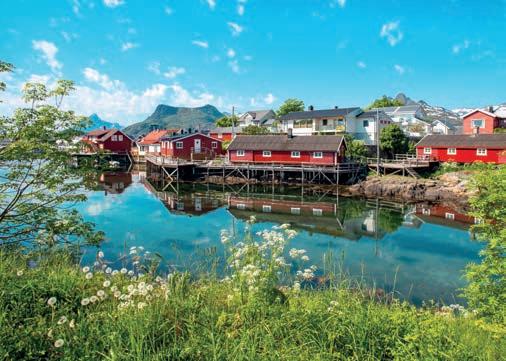
Tour watch
Audley Travel (audleytravel.com) has expanded its Norway portfolio to include options within its tailor-made itineraries for husky-sledding and seeing the northern lights in winter, as well as visiting the Lofoten Islands and their iconic rorbuer (fisherman’s huts; pictured) in summer. In other news: if new operator Journeyscape (journeyscape.com) sounds familiar, that’s because it’s from the team behind Journey Latin America. Taking the ethos of immersive bespoke travel and applying it to the USA and Canada, tours range from rail journeys and expedition cruises to culture, food, music and wildlife trips.
Battling overtourism in Barcelona

In a step to combat mass tourism in Barcelona and the rising housing costs caused by the scramble to profit from short-term lets, the city has announced that it will ban all holiday rental apartments by 2028. Barcelona mayor Jaume Collboni declared that more than 10,000 existing apartments across the city will have their short-term rental licence revoked in efforts to safeguard residents from being pushed out altogether. Over the past decade, long-term rental prices have increased by a massive 70%, meaning many locals can no longer afford to live in the city. The ban aims at luring them back to the centre to restore its vibrant community; hotels are also sure to benefit from the decision, especially smaller, independent businesses.
TheParis2024Olympic Gamesinnumbers
AstheOlympicsgetsunderwayin ParisonJuly26,discoverhowthe Gameswentfromaremotepartof Greece’sPeloponnesetothisyear’s France-spanningspectacular…
776
BC
ThefirstAncientOlympicGames canbetracedbacktoOlympia, Greece,in776BC,aspartofa religiousfestivalinhonourofZeus. Heldacrossthenext250years, theGamesoriginallyconsisted ofjustonemainevent:the stadion race (a 190msprint).
1900
Theyear1900marksthefirsttime ParisheldthemodernOlympics. Moreimportantly,itwasalsothe firsttimethatwomenwereallowed tocompete.Just22entered, withsailorHélènedePourtalès becomingthefirstwomanto win anOlympicgold.
100years
TheFrenchcapitalbecamethe firstcitytobuildanOlympicvillage whenithostedin1924.Thisyear, medalswillfeatureasmallpieceof metalfromtheEiffelTower.
15,000km
Theroughdistancebetween ParisandTahiti,theFrench overseascollectivitystaging thesurfingeventsat2024’s Games.Afterwards,itsTeahupo’o OlympicVillagewillbeconverted intosocialhousingtobenefit local communities.
63
Lyon, Saint-Etienne, Nice, Bordeaux, Nantes and Marseille are other key Olympic cities in 2024 – in total, some 63 French towns will host the Olympic and Paralympic Games.
Svinøya
Rorbuer




New sleeps
The arrival of Sandals Saint Vincent and the Grenadines (pictured) offers a plush base on Saint Vincent for exploring this serene island chain. As well as two-storey overwater villas and suites that feature their own fitness rooms, guests can try sunset paddleboarding, join kayak tours of the bat caves nearby and make soap and jewellery with local artisans. sandalsresorts.eu
COMO Alpina Dolomites has reopened for the summer season after refurbishment. Set on one of Europe’s largest high-altitude plateaus, it consists of 60 rooms and suites, with pine-inspired interiors echoing its surroundings. Guests can also choose from a range of summer experiences, including ancient hay baths and e-bike tours. comohotels.com
A 15th-century hunting lodge, once used by the Prince-Archbishop of Salzburg, has been reimagined to bring you Rosewood Schloss Fuschl. Located on the banks of Lake Fuschl, this Alpine resort has preserved its original heritage while also breathing new life into its 98 guestrooms, which include 46 suites and lakeside chalets. rosewoodhotels.com
Trailborn, a new hospitality brand inspired by the great American outdoors, is set to open a 63-bedroom hotel within North Carolina’s Blue Ridge Mountains. With the lush woodland surroundings inspiring the earthy tones of its interior design, Trailborn Highlands will also feature an onsite restaurant and bar within a restored historic log cabin. staytrailborn.com
Perched on a ridge with views across the Rwenzori mountains and Queen Elizabeth plains, Volcanoes Safaris’ Kibale Lodge in Uganda has now opened four of what will eventually be eight bandas (luxury ‘huts’). The lodge is just 30 minutes from Kibale Forest – known for its chimpanzee treks –and after a day of hiking, guests can use the lodge’s pool, spa and sauna facilities to relax and unwind. volcanoessafaris.com
A greener future
UNESCO have designated 11 new areas to join its World Network of Biosphere Reserves, bringing the total number of sites up to 759 across 136 countries. For the first time, two transboundary reserves have been named: the mountainous Julian Alps – crossing both Slovenia and Italy – and the expansive Kempen-Broek wetlands – which spans Belgium and the Netherlands. It’s a first for Belgium, as well as for The Gambia, whose Niumi Biosphere Reserve stretches alongside the Gambia River and safeguards some of West Africa’s last pristine mangrove forests. Meanwhile, other new additions can be found in Colombia, the Dominican Republic, Mongolia, the Philippines, South Korea and Spain. We can’t wait to explore them all. unesco.org


Theyear of the white rhino
A new initiative by NGO African Parks is aiming to rewild 2,000 southern white rhinos, releasing them into safe areas across Africa over the next ten years. This follows its purchase of the world’s largest captive rhino breeding operation, which was facing financial bankruptcy. The initiative, known as Rhino Rewild, will also renew the habitats in which
the animals are released, and recently conducted its first translocation, donating 40 rhinos to the Munywana Conservancy in Zululand, South Africa. This was followed by sending 120 more to the reserves of the Greater Kruger Environmental Protection Foundation in Mpumalanga and Limpopo, after poaching rates significantly fell.
Michael Dexter; Sandals Saint Vincent and the Grenadines; Shutterstock




The psychology of turbulence
With reports
of
injuries caused
by
turbulence
in
the news, we look at why there is less to fear than you think, and how to stay safe in rough skies
The tragic death of a passenger caused by turbulence on a Singapore Airlines flight recently hit the headlines.
Alongside reports of other commercial flights making unplanned stops due to difficult conditions, it has tapped into a fear many travellers face.
The majority of turbulence can be predicted: cloud shapes, storms and mountains can all indicate choppy air ahead.Websites such asTurbli even offer passengers a pre-flight glimpse of conditions they can encounter on their flight route, allowing them to mentally prepare, even if routes often change based on real-time weather data or first-hand reports from other pilots.
What can’t be predicted is a category known as ‘clear air turbulence’, when erratic air currents occur in cloudless skies.This doesn’t show up on radar systems,and reports suggest it may be on the rise with climate change.
A study by Reading University found incidents rose by 55% over the North Atlantic between 1979 and 2020. But serious injury caused by this or any other form of severe turbulence is rare.
Data from the US Federal Aviation Administration (FAA), which oversees 2.9 million airline passengers a day, records 163 people on US flights were seriously injured by turbulence between 2009 and 2022. Over 75% of these were airline crew, who are more likely to be on their feet and at risk of injury from unstable conditions.
For those seated and buckled in, there should be little to fear.Yet‘fear’is the key word here.For anyone who has ever seen a film orTV show, we know the sight of a bucking cabin rarely ends well.Turbulence can be triggering for the 24% of Brits (YouGov) who admit to anxiety about flying, so it becomes a matter of how to avoid panicking.
“Anxiety might sound like primarily a mental problem, but we all know how physical it can feel: sweating, dizziness, nausea, palpitations, shivering,” explains psychiatrist Charlie Bell. “For some people, turbulence might lead to a full-blown panic episode.”
There are practical ways to deal with turbulence-related anxiety, says Charlie.“Some people find focusing on an activity or preparing breathing exer-
6TIPSFORTAKING ONTURBULENCE
1 All authorities agree that you’re safest when seated and buckled in. Two out of the three turbulencerelated fatalities recorded by the FAA between 1980 and 2008 involved passengers not wearing seatbelts.
2 Sitting over the wings may offer an easier ride than at the front or back during mild turbulence, as you are near the plane’s centre of gravity.
3 A window seat, far away from the galley, can lessen the chances of being hit by flying items or falling luggage in rough skies.
4 Avoiding stimulants such as alcohol and caffeine will help you to feel calmer, as will practising breathing and relaxation techniques.
5If you require a toilet run, know that one type of turbulence only occurs when flying over mountains, so look out of the window or use a flight tracker to time it right.
6 For more accurate predictions, website turbli.com draws on the data many airlines and pilots use. Enter your flight number to see the conditions on your potential route, allowing you to prepare in advance.
cises and relaxation techniques help; others will want to have as much information as they can before boarding, including researching the flight route to remind themselves how safe flying is. And when in the air, try to avoid things that increase your general anxiety levels like caffeine and alcohol.”
For those who are affected more severely, there are therapies that may benefit you. “One is CBT – cognitive behavioural therapy – which helps you to address the negative thoughts and feelings you might experience when flying or thinking about flying,” says Charlie. “An alternative might be exposure therapy, or group therapy.”
Turbulence shouldn’t be a reason for not flying. And with the right knowledge, techniques and tips, it won’t be. Charlie Bell is a fellow in medicine,Girton College,Cambridge,and psychiatry registrar at Oxleas NHS FoundationTrust
RESOURCES
A rough ride (top) While turbulence is the primary cause of injury to air passengers –particularly clearair turbulence, which cannot be detected – fatalities are extremely rare
See the NHS site for resources to help with air anxiety –nhs.uk/mental-health/conditions/phobias/treatment





Chasing dragons
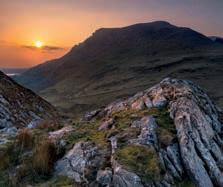
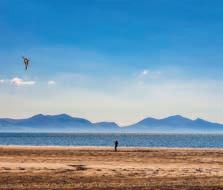
Will the return of Game of Thrones prequel House of the Dragon inspire our travels as much as its predecessor, asks Tom Hawker?
Westeros: a world of dragons, incest and iconic pointy furniture. The original Game of Thrones (GoT) TV series was a game changer when it came to set-jetting, prompting waves of visitors to head to Croatia, Malta and Northern Ireland to see where it was filmed. However, prequel series House of the Dragon (now onto its second season) has given us a new take on the Seven Kingdoms. Filmed in largely fresh locations, many offer a little sunlight in contrast with all that candlelit tension.
One returning locale is the cobbles and Moorish buildings of Cáceres’ OldTown in Spain’s Extremadura region, which doubles for fictional capital King’s Landing.Visitors can take in the Aztec-inspired murals on the walls of the domed PalacioToledo-Moctezuma, once home to the last Aztec empress Isabel Moctezuma, whose story is every bit as remarkable as anything George RR Martin has penned.
One unusual filming location is found over the Portuguese border in the village of Monsanto. Its streets are interlaced with giant boulders and lie strewn across a hill crowned with castle ruins said to have once belonged to the KnightsTemplar.A 15-minute drive away lies the 13th-century Penha Garcia castle, which also features in the series.
If GoT is forever connected to Northern Island, its prequel has made a showcase of the western fringes of Great Britain. Cornwall features often, with the legend-laden island of St Michael’s Mount and its 12th-century buildings
standing in for House Velaryon’s ancestral seat of Driftmark. Elsewhere, the National Trust beach of Kynance Cove at the county’s southern tip formed the setting for theVelaryon camp as it prepared for the War of the Stepstones in season one, a fight whose backdrop was filmed in the dunes and headlands of Holywell Bay (once a Poldark regular).



Season two, however, has gone big on Wales.The north-western county of Gwynedd provided several locations, with filming having taken place at theYr Eifl granite quarry (the exterior of Dragonstone castle), Dinorwig quarry (the cursed Harrenhal castle) and the glacial OgwenValley,where filmmakers have taken full advantage of the sweeping views of Eryri (Snowdonia) National Park.
At Wales’ north-western tip lies Anglesey, whose rocky outcrop at Llanddwyn beach is believed to host a key scene from the latest series. Beaumaris beach has also found itself getting a Westeros makeover as the setting for a cavalry charge. Meanwhile, secluded Porth y Cwch cove is the location for one of the series’ most tear-jerking moments, involving the embattled Rhaenyra Targaryen.Wild Wales is in many ways a spiritual match for Westeros: rugged, epic and a land where a fierce red dragon always flies high. Season two of House of the Dragon is available to watch on Sky Atlantic and Now (nowtv.com)
Got game? (clockwise from top left) Spain’s Moorish castle of Trujillo was a regular filming location in GoT; Eryri National Park and Llanddwyn Bay feature in House of the Dragon; Matt Smith broods as Daemon Targaryen; much of the new series was shot in Spain, Portugal, Wales and Cornwall; Emma d’Arcy’s Rhaenyra Targaryen stands watch
Read this!
From lost roads and histories to taking the slow train, the experts at Stanfords pick the latest reads to get your feet itching
StormPegs
by Jen Hadfield Picador; £19
Stanfords Book of the Month for July

Having moved to Shetland to start afresh, the author recounts the ways that this far-flung Scottish archipelago taught her to live, at the same capturing what makes these islands so breathtaking and unique.
AmuseBouche

by Carolyn Boyd Profile Books; £19 Francophile Carolyn Boyd shares the stories behind the country’s most fascinating foods and ingredients, blending history and travel. It’s the perfect pre-Olympics appetiser.
The
Lost
Paths
by Jack Cornish
Allen Lane; £20

By 2026, some 16,000km of forgotten footpaths around Britain stand
LISTEN
HERE! OFF THE PAGE
to be lost. Jack Cornish’s fascinating book sets out to ensure they aren’t, and en route explains why Britain’s history is buried in these historic rights of way.
Slow Trains to Istanbul
byTom Chesshyre Summersdale; £20
Stanfords Book of the Month for June

At little behest, rail enthusiast Tom Chesshyre sets off on a 7,350km trip shadowing the old Orient Express route across Europe, albeit in considerably less luxury – you and I would call it Interrailing. Across 55 trains, he shows the true value of travel by rail: where every stop offers a side adventure.
Children
of
the
Volcano by Ros Belford September; £20

In another book that addresses starting over, the author –fresh from a break-up
It’s hard to believe that Season 7 of Wanderlust’s popular podcast is about to kick off, starting with the 2023 Race Across theWorld winners Tricia and Cathie, who recount their recent return to Canada’s Newfoundland and Labrador – this time at a much slower pace and with a chance to really experience it. Other inspirational stories in this series include destination episodes on Ecuador, the Florida Keys, Brazil, Barbados and more. Released in conjunction with specialist travel insurance provider True Traveller, you’ll find Wanderlust: Off the Page on all the usual podcast channels.
IN ASSOCIATION WITH

Readers get 10% off by using the code ‘Wandering’ on the Stanfords website (www.stanfords.co.uk). Wanderlust members can get 25% off. See p174
– relocates to Sicily to give her daughters a childhood to remember, and herself a new go at life. What follows falls into the ‘inspirational’ bracket of books about overcoming the odds, though it paints a portrait of island life that will have travellers intrigued.
On the Shadow Tracks
by Clare Hammond Penguin; £25

While working as a journalist in Yangon, Clare Hammond found a map that showed a web of unknown railways across Myanmar. Setting out to discover their origin, she travels from contested areas to border towns while telling the tale of the country’s colonial legacy.
An African History of Africa
by Zeinab Badawi Ebury; £25

Broadcaster Zeinab Badawi is out to set the record straight, by telling a history

of Africa through the eyes of Africans. To do so, she visits more than 30 countries, speaking to experts and storytellers, to unearth not just the larger narrative of the continent, but the smaller stories that shaped local experience. It is a task as enormous as Africa itself, yet achieved with breathtaking brevity and laser-eyed focus.
At the Edge
of Empire
by EdwardWong Profile Books; £25

When Edward Wong became the Beijing bureau chief for The New York Times, he set out to investigate his own father’s mysterious past in the People’s Liberation Army. Balancing this against his day job chronicling China’s economic boom and rapid rise under nationalistic rule, he tells a unique story that is both personal and sweeping, as he finds his own place in modern China.



WIN! A six-day trip for two in the Italian Alps
Lying close to the Swiss border, Livigno’s remote and mountainous location has led to it earning the moniker ‘Little Tibet’. The lofty Italian valley that it’s set in has long been a winter playground, but there’s so much more to do here than ski. Best of all, the experts at Bivio Travel Agency want to prove just that by giving you the chance win a six-night adventure to Livigno for two people.
The lucky winner will stay at the Alpen Resort, with its epic panoramas of the Livigno valley and proximity to the Teola-Pianoni Bassi chairlift, which whizzes passengers to the top of Mottolino mountain. It’s the ideal place to base yourself while you explore the wilds of Livigno, whether during the summer or winter months…

Winter adventures
As part of your prize, two outdoor activities of your choice will be included. In winter, you could embark on a snowshoeing tour with an Alpine guide, taking to one of several tracks that weave across the valley. It’s a great way to soak up views of Lake Livigno and the twisting Forcola Pass. Alternatively, you could hop on a snowmobile panoramic tour with Trepalle Service and zoom up the Eira Pass to Crap de la Paré for one of the finest vistas in the Livigno valley. Or, for something more unusual, ride through the snowy wilderness of Valtellina on a husky sled tour, or test your driving skills at Livigno’s own Ice Driving School. There’s so much to do here that shows off the best of Livigno without ever having to put on a ski.
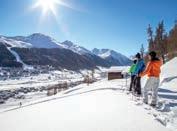

Summer in the Alps
Once the snow melts, Livigno’s slopes reveal lush carpets of greenery, yet the area remains an enduring playground for lovers of the outdoors. During this period, your Alpine guide can take you out on adventures to climb canyons and cross the valley on a Tibetanstyle bridge. Or, for something more gentle, head out on a guided trek to one of Livigno’s natural landmarks, such as the cerulean-blue Vago Lake or the Val Nera waterfalls.
About the experts
Alpine adventure (clockwise from top left) Cycle beside gin-clear lakes in Livigno; summer here is made for hiking among wildflowerspeckled Alpine meadows; winter is a fine time to explore Livigno by snowshoe; whizz through frozen Livigno on a traditional husky tour
The experts at Bivio Travel Agency are a font of knowledge when it comes to crafting your trip to Livigno. They not only have the inside track on the best places to stay but can provide a diverse range of experiences across the region, from outdoor adventures to cultural and culinary events, so you can maximise your time in this heavenly mountain destination.
HOW TO WIN
Bivio Travel Agency is offering a six-night stay for two at Alpen Resort Bivio on a halfboard basis (drinks excluded), plus a five-day skipass and a choice of two activities during the trip. Please note flights are not included. For a chance of winning, please answer the following question:
How high above sea level is Livigno?
a) 1,616m
b) 1,816m
c) 2,016m
To enter, and for full terms, conditions and data policies, please go to: wanderlustmagazine.com/competitions


Bivio Travel Agency















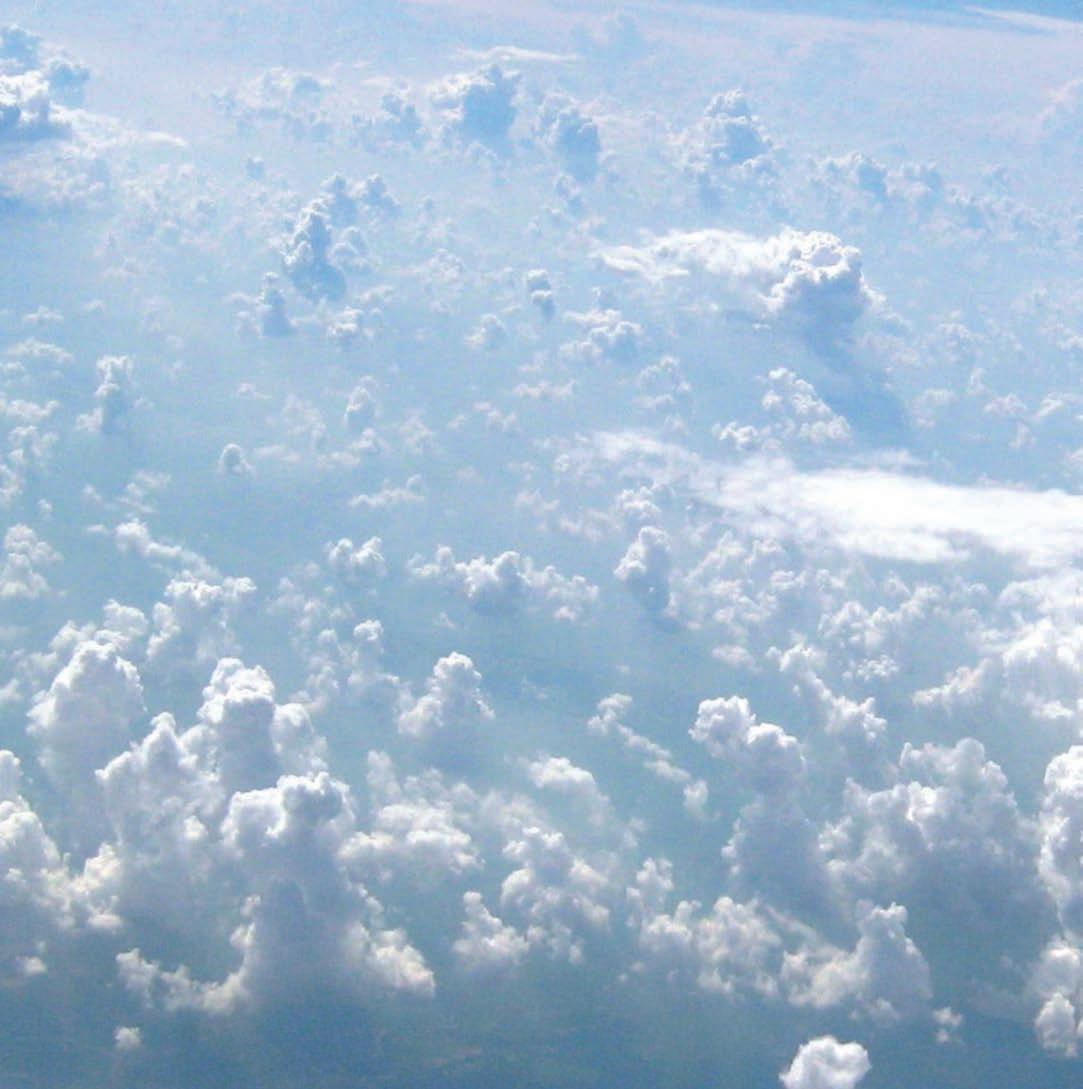
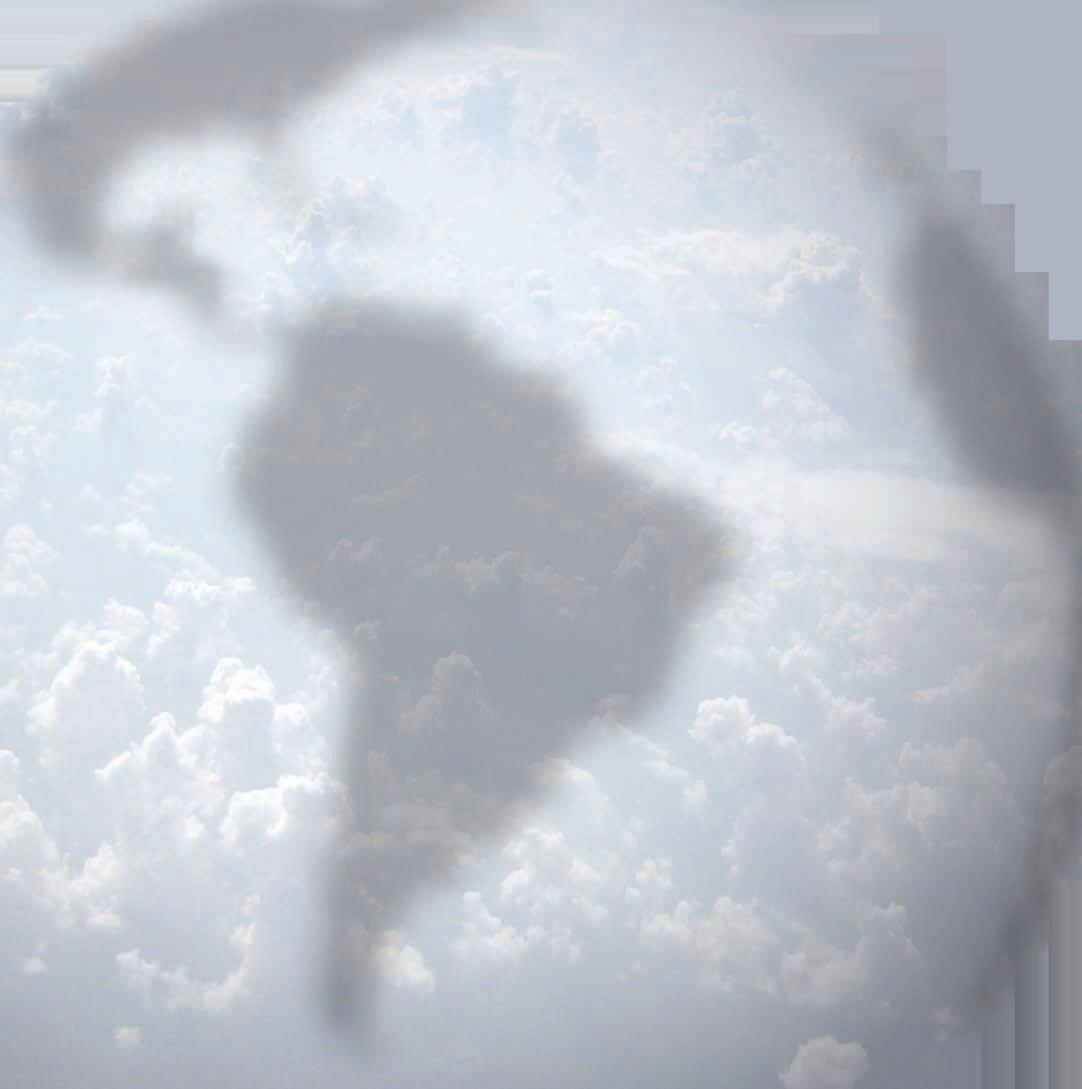











































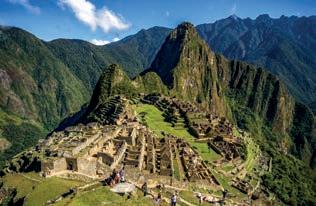










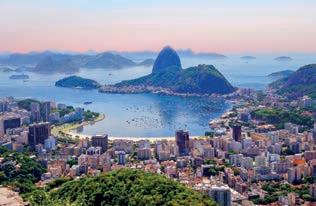


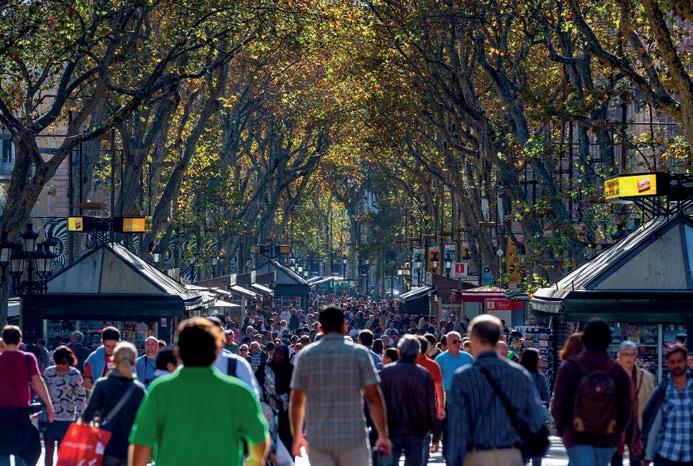
Overcoming overtourism
With 2024 set to become a record-breaking year for visitor numbers around the world, Karen Edwards examines if travellers can become a part of the solution…
Earlier this year, more than 120,000 residents took to the streets of Santa Cruz de Tenerife in the Canary Islands to protest the “destructive growth” of tourism on its coast.Their aim was to stop the creation of yet another beach resort in the south of the island, and to demand that the authorities implement a more sustainable tourism model; one that considers resident welfare, local housing, living costs, environmental degradation and pollution ahead of profit-making.
Canary Islanders are not the first residents to push back against large tourism numbers. In May, around 10,000 residents on the island of Mallorca in Spain raised concerns over how short-term rental accommodation was destroying the availability
of affordable homes in the Balearic Islands.They also drew attention to the road congestion spikes that occur during the summer travel season, and how locals suffer from water shortages exacerbated by the extra burden that hotel swimming pools and spas place on their limited resources.
In recent years, several destinations have implemented measures to reduce overtourism, developing strategies that include restricting the size and number of cruise ships entering busy city ports (Venice); introducing a visitor tax (Bali) or raising the fees of taxes already in place (Barcelona); reducing the number of short-term holiday rentals, including banning Airbnbs (Penang) or putting strict limits on how they can operate (NewYork); and even outlawing the construction of new hotels (Amsterdam). Most
What’s in a name?
(this page; above) The phrase ‘overtourism’ was first coined in 2016, but it seeped into widespread usage a year later when anti-tourism protests in Italy and Spain pointed to the deluge of visitors in places such as Venice’s St Mark’s Square and Barcelona’s La Rambla (pictured)
recently, authorities in Barcelona also warned that short-term, Airbnb-style rentals will be made illegal in five years. However, with theWorldTravel and Tourism Council (WTTC) forecasting that 2024 will be a ‘record-breaking year for travel and tourism’, we are likely to see even more destinations struggling to control visitor numbers.
WHY OVERTOURISM MATTERS
Overtourism typically occurs when too many people travel to one place, leaving local infrastructure unable to cope with the demand for accommodation, transport and amenities.This might be in cities or towns, or in rural areas such as national parks and reserves. In such cases, local people tend to bear the brunt of the problem, with their quality of life often diminished as a result.
Case study
Bhutan’s ‘sustainable development fee’
All visitors to Bhutan must pay a US$100 (£80) per day ‘sustainable development fee’, designed to encourage ‘high value, low impact’ tourism. In the past, this fee has been as much as US$250, and the money collected goes towards maintaining heritage architecture, native forests, education and healthcare facilities. Recently, the nation’s prime minister suggested that the fee could double if numbers grow beyond the quota of 300,000 visitors per year.
Large tourism numbers can cause increased traffic congestion, crowded public transport and the erosion of popular landmarks. In the worst cases, residents are forced to move out of their homes due to price hikes in basic necessities such as rent and food. As more people move away, investors move in, buying up property to convert into holiday accommodation, raising rental rates even further and ensuring more local people are priced out of the property market. And so the cycle continues, with profit-making hotels and entertainment complexes prioritised over local needs. It’s no wonder that locals have started to speak out.
“As residents experience the direct impacts of [overtourism] – and when they feel that tourism is imposed on them, instead of them having a say in how it’s developed and managed – they understandably become more vocal in their calls for change,” explains Rebecca Armstrong, a sustainable tourism specialist at The Travel Foundation.
Poor tourism management and a lack of regulation in natural spaces can also cause environmental and habitat degradation in places such as national parks and protected areas. In such cases, there is more of an opportunity for wildlife to be disturbed by humans, resulting in changed behaviour, creatures moving away from their natural habitat and, eventually, even biodiversity loss.

The right kind of traveller (this page; top to bottom) Bhutan’s ‘sustainable development fee’ ensures that the money spent by visitors goes directly into the public pot rather than to multinational companies; in 2023, Amsterdam launched its ‘stay away’ campaign to reduce the number of rowdy visitors that only see the city as a party capital
WHAT CAN BE DONE?
The Canary Islands protests took place following decades of issues caused by the islands’ positioning as a mass-tourism destination. In 2023, 13.9 million people (more than six times the population) visited the seven main islands, with the majority staying at the archipelago’s many resorts and private rental accommodation. Yet, despite this influx of potential income, the Spanish National Statistics Institute reported that ‘34% of Canary Islanders remained at risk of poverty or social exclusion’, showing that not enough of the money spent by tourists is going towards local infrastructure and services.
“It is useful to consider overtourism through the lens of residents,” explains responsible tourism expert Siobhán Daly. “Residents of popular tourism destinations deserve to have a high quality of life; unfortunately, this is not always the case in many places.

And yet, tourism is more likely to become sustainable in a destination where residents are supportive of it.”
National and local governments also have the power to contribute to long-term solutions by building a sustainable environment for residents. “Listening to residents – and acting on their concerns – is the moral thing to do,” continues Siobhán. “By doing this, destination management organisations have the opportunity to intervene before tourism’s negative impacts become increasingly prominent.”
Affordable housing, a reliable and accessible public transport system, rent control and a liveable minimum
Case study Making Amsterdam ‘liveable’
Amsterdam’s local government is on a mission to not only reduce mass tourism but reconstruct the city’s image, moving away from its reputation as a party destination. “We want to make, and keep, the city liveable for residents and visitors. This means: no overtourism, no new hotels and no more than 20 million hotel overnight stays by tourists per year,” city officials declared in 2024.
SUSTAINABLE TRAVEL
wage are all ways in which to improve societies and allow residents’ welfare to be prioritised. Providing the means for locals to start businesses in areas where tourism is rife can also help to ensure local people gain from the presence of tourists.
Rebecca agrees: “Collaboration is key to managing visitors. As well as improving life for residents, this can offer a better experience for travellers, because crowded sites aren’t pleasant for anyone. Likewise, [authorities] working with communities in less-visited destinations that would like to welcome more tourists is important for making sure that the problem isn’t just inadvertently shifted elsewhere.”
WHATYOUNEEDTOKNOW
According to research conducted by environmental monitoring company Murmuration, 80% of travellers visit
Case study
Venice’smissionto reducedaytrippers
After UNESCO threatened to take away its World Heritage status in 2021, due to the risk to the vulnerable ecosystem in its waterways and the heritage buildings that line them, Venice banned large cruise ships (over 25,000 tonnes) from entering its famous Giudecca Canal. This year, also authorities introduced a trial €5 (£4.30) fee to see if day trippers could be further deterred; however, the move triggered an outcry from residents, who felt the scheme turned their home into a “theme park”.
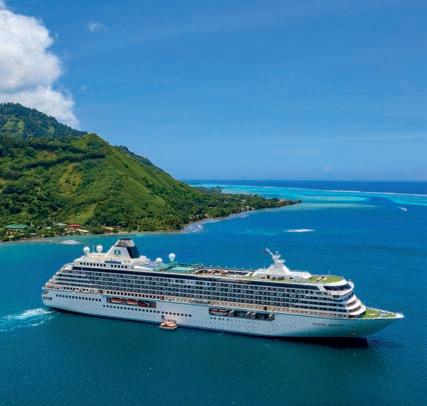
No simple answers (top to bottom)
French Polynesia has put a cap on the number of visitors it welcomes per year, and also limits the size of cruise ship that can unload passengers at its ports; some claim that Venice’s new visitor tax of €5 turns the city into an amusement park and that the low fee offers little discouragement to the huge number of tourists who pack its squares
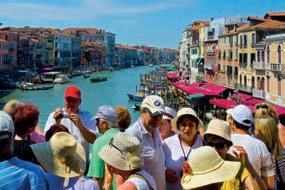
just 10% of destinations around the world. So, the best way to help reduce overtourism would be to swerve the hotspots and explore lesser-visited regions. Even better, explore those famous landmarks via augmented-reality technology such as Wanderlust’s MetaTravel experiences, which allow users to delve into destinations from their computer or tablet.
“Some destinations and attractions also offer high-quality virtual experiences,” explains Siobhán. “Prospective tourists can enjoy the sites from the comfort of their own homes.”
If you do visit popular regions, consider going during the off-peak and shoulder seasons – a way of travelling that Wanderlust has been championing for more than 30 years. Importantly, this also means choosing to stay in locally owned accommodation, hiring a local guide and supporting community-owned restaurants and artisans, to ensure residents benefit from your presence.
Rebecca agrees that these simple decisions can help to spread the benefits of tourism to locals.“Travelling by train, bike or on foot, and stopping along the way, can help to showcase the places you’d otherwise miss,” she adds.Another added benefit is that it
also brings income to those living on the fringes of busy hubs.
While there isn’t an easy solution to overtourism, it’s clear there needs to be mindful collaboration between residents, local tourism authorities and travellers. In the meantime, smarter trip planning is a great place to start.
Case study
FrenchPolynesia putsacaponit
The islands of French Polynesia, including Tahiti, Bora Bora and Mo’orea, have implemented a limit on the number of visitors allowed per year, capping this figure at 300,000 – the equivalent of one tourist for every resident. Since the islands are a major cruise destination, the decision also means that they now only welcome smaller vessels. The reduction in cruise passenger numbers means less of an impact on the natural environment and reduced demand on local amenities.
Alamy






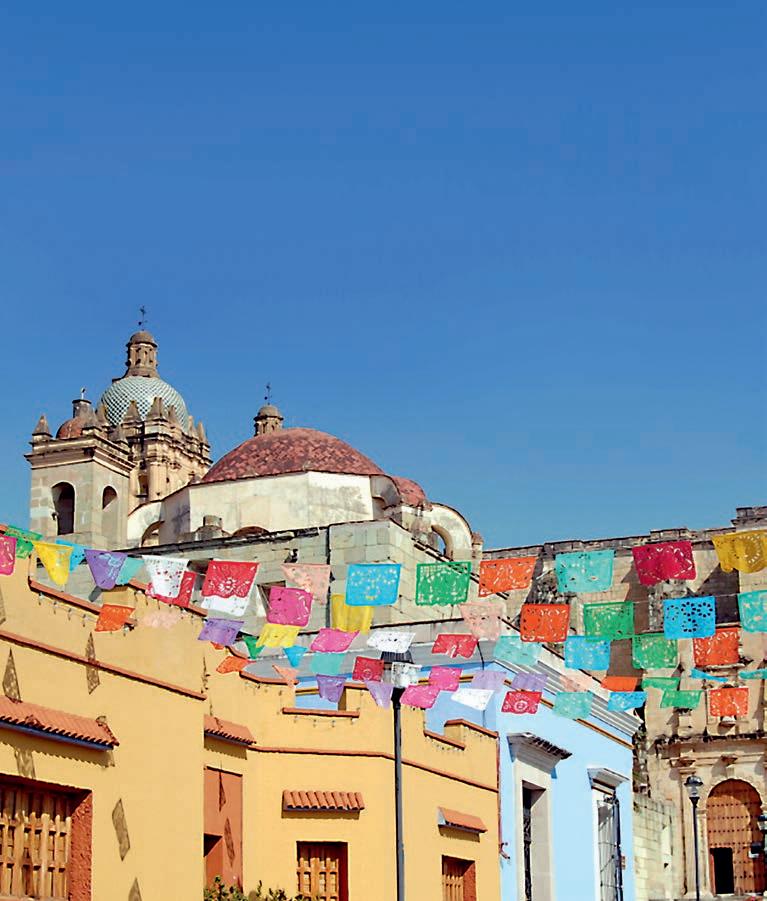




A larger variety of tour-operator trips now allow travellers of all abilities to explore more freely
Accessible escapes
Accessibility can mean a lot of things. Whether you use a wheelchair, a walker or struggle with climbing steps, we pick the trips that are making it physically easier to have incredible experiences
Right to roam

ALASKA AND CANADA BY SEA AND RAIL
Everything is bigger in North America – and the further north you go, the more that becomes true. Audley Travel’s Alaska Cruise & Canadian Rockies by Train private tour offers a loose itinerary you can tailor to fit your needs, swapping a walking tour for, say, a boat cruise of the glacial Lake Minnewanka or taking in Canada’s Icefields Parkway from a sidecar. Certainly, little beats a journey on the Rocky Mountaineer train, whose domed windows reveal peaks and boundless forests as you arrow west from Jasper to Vancouver. From there a cruise picks its way along the Inside Passage, where calving glaciers and waters filled with humpbacks and orcas offer a wild highway into Alaska, where boat trips to the ice-sculpted fjords of Glacier Bay and the gold-rush town of Skagway expand your pupils and horizons. Audley Travel (audleytravel.com). Flexible dates; 15 nights from £6,995pp, including international flights.

DISCOVER SOUTH AFRICA’S WILD EAST
Safaris lend themselves well to accessible escapes, as travellers can often witness nature reddest in tooth and claw from the ease of a 4WD. But too often such transport isn’t wheelchair friendly. From a starting point in Durban, Limitless Travel’s South African Safari group tour takes in the ‘Big 5’ on game drives through the Hluhluwe-Imfolozi nature park on vehicles specially fitted with clamps for wheelchairs. As well as spying yawning hippos on cruises through the iSimangaliso wetlands, you can learn about how conservation projects have helped preserve the largest population of white rhino in the world, visit a wild cat rehabilitation centre and find out more about Zulu culture on a trip that puts the majesty of eastern South Africa on full view. Limitless Travel (limitlesstravel.org). 11 Oct 2024; 9 May, 26 Sep & 7 Nov 2025; 11 nights from £4,199pp, excluding international flights.

SEE THE NORTHERN LIGHTS IN ICELAND
Every ancient civilisation who gazed on the northern lights had a theory as to what they were; the only thing that links them all is a sense of awe. Limitless Travel’s Northern Lights in Iceland group tour puts these shimmering wonders in reach of everyone, with fully accessible stays and vehicles to back up trips exploring the classic Golden Circle route, taking in the geothermal Blue Lagoon, a 3,000-year-old volcano crater andThingvellir National Park, where two tectonic plates meet and boardwalks snake into a natural amphitheatre home to the world’s oldest parliament. Based out of Reykjavik, the capital’s galleries and Viking history are on your doorstep, as is the Perlan nature museum, which offers context for the northern lights in its planetarium.At night, you’ll take in the real thing in a country whose dark skies are legendary. LimitlessTravel (limitlesstravel.org). 14 Oct 2024; 4 nights from £2,699pp excluding international flights.
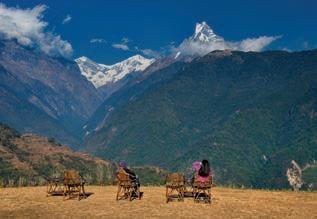
SEE NEPAL IN A BRAND-NEW WAY
A country known for its 8,000m-plus peaks might not seem like the most accessible destination on first glance.Yet Responsible Travel’s Wheelchair Accessible Holiday in Nepal tour can be tailored to suit all kinds of mobility issues. It is specifically designed for wheelchair users, for whom Nepal’s trails aren’t an obvious choice. But with the usual hikes not accessible to most disabled visitors, the country has created a trail purposefully designed for those with mobility issues, taking in views of the hulking Machapuchare and Annapurna II peaks. It’s a chance to see the valley of Pokhara like never before.You can also take an Everest mountain flight, a rickshaw tour of Kathmandu and scour the temples of the capital, soaking up a land of impossible culture and beauty. Responsible Travel (responsibletravel.com). Flexible dates; 7 days from £923pp, excluding international flights.

HIT THE RAIL ON JAPAN’S GOLDEN ROUTE
The Golden Route loosely follows the Edo-eraTokaido road that once connectedTokyo with Kyoto. It’s filled with scenes of old Japan, from the wooden machiya houses of Nara to the timeless sight of Mount Fuji. InsideJapan’s self-guided Wheelchair-Accessible Golden Route tour offers a route tailored to its guests’ mobility, as you speed through the country by bullet train.You might find yourself feeding the deer in Nara Park, pondering the instant-ramen museum in Osaka, soaking up a Japanese landscape garden in Tokyo or visiting the five-storey Toji Temple in Kyoto, which was first built in the eighth century to coincide with the capital moving to the city.There’s detailed transport instructions and also room to tailor the trip to match different abilities, including use of a wheelchair-accessible vehicle and bathroom hoists. InsideJapan (insidejapantours.com).Flexible dates;10 nights from £4,180pp, excluding international flights.

SEE GREECE’S NORTHERN PELOPONNESE
If Greece is the Cradle of Western Civilisation, the Peloponnese is close to its epicentre. From the ruins of Mycenae to the site of the first Olympic Games (Olympia), to an ancient theatre (Epidavros) where an annual festival puts on the great plays of antiquity, history is sketched liberally across this rugged peninsula, particularly in the north. Sunvil’s Tailor-made Northern Peloponnese sets up base in a family-run B&B in coastalTolon that is equipped with a ramp,lift and helpful staff. From there, accessible taxis can be arranged to shuttle you between stops such as the beautiful port town of Nafplion, modern Greece’s first capital after theWar of Independence, or the vast ruins of city-state Ancient Corinth, once home to 90,000 people. Sunvil (sunvil.co.uk).Flexible dates and length;7 nights (28 Sep),for example, from £1,181pp, including international flights.
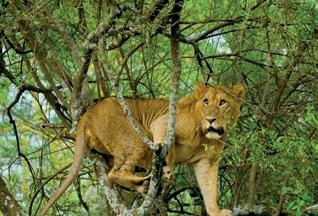
EXPLORE THE WILDLIFE RESERVES OF KENYA
The chance to see some of the largest game herds in Africa is never to be passed up. NatureTrek’s eight-night Tailor-made Kenya for Disabled Travellers offers just that, with its safari vehicles capable of being adapted to different mobility needs.There are so many options. Explore the water holes of the Rift Valley where Lake Nakuru National Park offers rare glimpses of tree-climbing lions, a unique adaptation possibly done to escape biting insects, or witness the thriving white and black rhino populations – the park was home to the first rhino sanctuary in Kenya. One highlight is surely the world-renowned Masai Mara National Reserve, where visits during the Great Migration (July–October) put the life-and-death dramas of some 1.2 million wildebeest on show. NatureTrek (naturetrek.co.uk). Flexible dates; 8 nights from £5,995pp, including international flights.
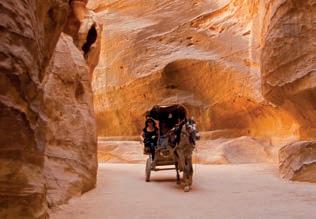
GO LOCAL IN JORDAN
Holiday Architects’ Go Local in Jordan trip squeezes in a number of the country’s classic must-see sights: historical As-Salt,the Mars-like Wadi Rum,the buoyant waters of the Dead Sea.You can even explore the Nabataean ruins of Petra by golf buggy.Where it differs from most accessibletours isthat it also offers a chance for more community-based encounters, as a private driver shuttles you between cookery classes at Amman’s Beit Sitti cooking school or a chance to extract honey alongside local beekeeperYousef, or a morning at a women’s cooperative to learn about the work it does. All trips are tailor-made, so you can pick and tweak activities to meet your mobility needs while still getting a taste of the Jordan few other travellers see. Holiday Architects (holidayarchitects.co.uk). Flexible dates (best Sep–May); 10 days from £3,670pp, including international flights.

The trouble with ticks
Ticks can not only spoil your summer, but the effects of their bites may have lasting consequences if you don’t know what to look for, writes Dr Kevin Barrett
Travellers frequently worry about encountering poisonous spiders and mosquitoes when travelling abroad; however, one bug that typically goes under the radar is the humble tick, a parasite whose tiny bite can have an outsized impact on your life.
The reason for concern is not the bite itself, but rather the diseases that ticks may carry, from encephalitis to African tick-bite fever. By far the most common of these is Lyme disease, a condition whose symptoms – fever, rash, facial paralysis, arthritis – may last months after treatment and frequently go undiagnosed, thanks to their similarity with other conditions.
Takingprecautions
Ticks are found on every continent – even Antarctica – but are particularly common in the fields and forests of Western Europe, where Austria, Czechia and Germany report the highest cases of tick-borne infections. And while the good news is that if you
are bitten, it’s unlikely that you will become ill (only 1–5% of tick bites in Europe results in infection), you can still act to minimise those odds.
Ticks are most active during the warmer months (Apr–Aug), when we are more likely to be outdoors and wearing the least amount of clothing. The best way to avoid bites is to wear long sleeves and trousers, making it harder for a tick to latch on, and to use an effective insect repellent. Keeping to open pathways also helps, as you’re more likely to come into contact with ticks if you’re walking or cycling through long grass or vegetation.
When packing, especially for camping or hiking trips, include an antihistamine bite cream such as Anthisan, which can help relieve any bite area. Also bring a tick remover, so that if you do discover an unwanted passenger, you can safely remove it – a tick’s head left embedded in your skin increases the risk of infection. And before doing so, be sure to cleanse the bite area first with antiseptic wipes.
5TIPSFOR TACKLING TICKS
1 To avoid bites, wear long-sleeved tops and long trousers, with the latter tucked into your socks or boots if hiking. Wearing lightcoloured clothes can also help you to spot any ticks looking for a way in.
2 Bring the right gear. Insect repellents containing DEET or Picaridin are effective on ticks, though garlic is a more natural solution. Also bring antihistamine bite cream and antiseptic wipes.
3 Frequently check your clothing and skin when in areas that contain ticks. It can take from a few hours to a couple of days of feeding for a tick to pass on an infection, so they are best removed quickly.
4Use a tick removal tool to extract ticks. Be careful not to squeeze the tick so the body separates. Get hold of it as close to the skin as possible, then firmly but slowly pull or twist upwards to remove.
5 If you feel unwell or develop any symptoms indicating Lyme disease, visit your GP, pharmacist or call 111 (in the UK) immediately.
Knowyoursymptoms
If you are infected, the speed at which Lyme disease symptoms develop varies, from a couple of days to up to three months.The first sign is often a rash that looks like a bullseye, but even this is not universal. You can develop flu-like symptoms, including feeling feverish, achy, fatigued and nauseous; on rare occasions, nerve pain or a drooping of the face can also occur.
Some 3,500 cases of Lyme disease are diagnosed in the UK every year. If you have any of these symptoms, informing your doctor of a tick bite –even if it was months ago – can help with diagnosis. When caught early, Lyme disease can easily be treated with antibiotics; if left, it becomes harder to treat and the infection may spread.
But if you take anything away from this article,it’s that you shouldn’t avoid the outdoors for fear of picking up a tick. By taking precautions and being aware,you can stay one jump ahead.
Dr Kevin Barrett is a GP at New Road Surgery,Hertfordshire
Bloodsuckers (top) The humble tick is not strictly speaking an insect, but is actually an arachnid; (below) it can take as long as a couple of days of feeding before ticks pass on infections such as Lyme disease, so they are best removed fast using the right tool

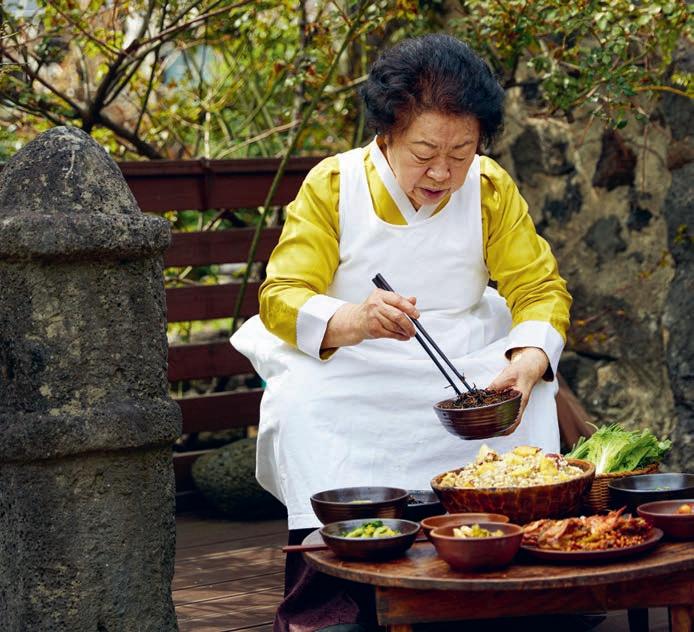
Mapping South Korean food
In doing the research for his new book, The Korean Cookbook, acclaimed chef Junghyun Park discovers that the history of cooking in South Korea is more often than not a matter of geography
Around 70% of South Korea is covered in mountainous terrain. Few areas are suitable for largescale farming, with the north and west mostly smothered in high peaks.The lowlands and river valleys of the south-east naturally became the heart of rice production, while the centre and east were developed for field crops and the cultivation of wild vegetables.This has all had a huge effect on Korean cooking. Before the development of modern infrastructure, transportation and communication were difficult between regions. As a result, each area of Korea developed its own unique cuisine, based on the local food supply. Even today, despite the ease of modern transportation, the unique food cultures and traditional dishes of each region remain.
Broadly speaking: in areas where temperatures run high (the south), food spoils more easily, so is more heavily salted or strongly seasoned; in the mountainous north, where the temperature is low, it tends to be milder; and all along the coast, you’ll find many different varieties of seafood dishes. For example, the southern cuisine of Jeolla-do is noted for its strong seasoning and the use of fermented foods. Look out there for dishes such as the original Jeonju bibimbap (mixed rice), served in traditional brass bowls. Alternatively, northern Seoul is where dishes and ingredients from across Korea collide.The food culture of the royal court developed in the capital, and although locals now prefer a large number of smaller dishes over banquets, these are still characterised by the milder flavours of the north.
Master chefs (above) Ji Soon Kim is one of many masters of Korea’s heavily regionalised cuisine interviewed for The Korean Cookbook, having perfected the traditional food of Jeju island in her restaurant Nangpoon Bapsang
FIVE SOUTH KOREAN DISHES YOU SHOULD TRY (AND WHERE TO FIND THEM)
1
Bibimbap
Bibimbap is Korea’s most iconic rice dish.The traditional Jeonju style is beloved for its formal take on the classic dish, with rice made using ox-bone broth and finished with soybean sprouts topped with namul (seasoned vegetables), mung bean jelly, yukhwe (for example, a beef tartate), a raw egg yolk and stir-fried gochujang (red chilli paste). But styles vary around the country: in Andong, they swap out the gochujang for soy sauce, and in coastal Tongyeong it’s made with seasonal sea vegetables and seaweed, then washed down with a soup of tofu and clams. Where: To try the Jeonju-style version of bibimbap, head to specialists Sungmidang (3 Jungang-dong) or HangukJip (119 Eojin-gil) in its home city.
2 Bulgogi
Bulgogi refers to dishes of thinly sliced meat (often beef) marinated in various seasonings and grilled over an open fire.There are three famous methods: the Seoul style pours beef broth onto the grilled meat for a
simmered effect; Gwangyang-style minimises seasoning, marinating the meat prior to grilling; and the Eonyang style grills the sliced marinated beef in chunkier clumps over charcoal.
Where: Seoul’sWoo Lae Oak (62-29 Changgyeonggung-ro) is known for its bulgogi, which is grilled tableside. Also try Hanilkwan (hanilkwan.co.kr), which originated in Seoul and has branches in the capital and Incheon.
3
Mandu (dumplings)
What sets Korean dumplings apart is that traditional versions almost always use ground tofu and kimchi as a filling; the modern take also now includes glass noodles. However, there are many varieties found around the country, including the beyongsi mandu, the royal court’s traditional half-moon shape, made without any folds; kyu-asang mandu, which are formed like sea cucumbers; and the pyeonsu mandu, a square summer dumpling.
Where: Seoul’s Jaha Son Mandu (12 Baekseokdong-gil) uses recipes passed down through the owner’s family.



4
Korean fried chicken
In Korea, when referring to ‘chicken’, one thinks of Korean fried chicken.This deep-fried (twigim) dish is now ubiquitous across the country, and while many styles exist, it is known for its crispy texture and sauces made from gochujang and soy sauce. Where: You’re never far from a branch of bb.q Chicken (bbqchicken.com.my) in Korea; the brand even opened its own ‘chicken university’ in 2000.
5
Jjigae (stew)
These brothy stews are characterised by strong seasonings, typically falling under the category of doenjang (seasoned with fermented soybean paste), gochujang (seasoned with red chilli paste) or clear jjigae.Traditionally, the proper way to serve this stew was in individual servings as a banchan (side dish); these days, jjigae is usually a communal dish that is to be shared. Where: In Seoul, head to Eunjujeong (32 Changgyeonggung-ro 8-gil) for the kimchi version, or Doma (33Yanghwa-ro 16-gil) for doenjang jjigae.

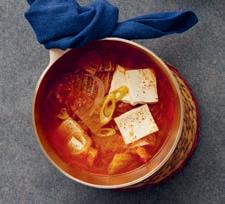

extract was taken from The Korean Cookbook (Phaidon; £39.95) by acclaimed Atomix chef Junghyun ‘JP’ Park and culinary researcher, chef and writer Jungyoon Choi. It celebrates traditional regional dishes and everyday food found in home kitchens from Seoul to Jeju Island. It collects together 350 recipes, including pantry staples, stews and hotpots. Out now.
WANDERLUST RECOMMENDS
Jinny’s Kitchen (Amazon Prime) is a spin-off from a popular Korean reality show that follows chef Seo Jun as he introduces Korean street food to the town of Bacalar in Mexico.
Jinju Kang
This

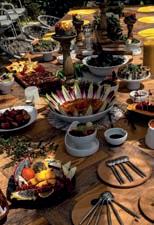

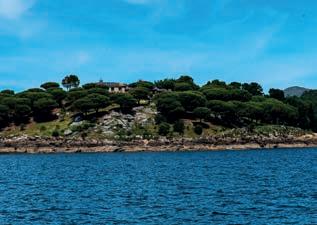
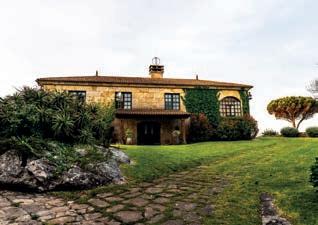


A Creba Private Island, Spain
It’s not often that you find an entire Spanish island for rent, much less one that works in harmony with nature to create a family-run, sustainable stay like no other
Reviewed
by
Mark Stratton
Every year, thousands of pilgrims walk the Camino to Santiago de Compostela. But trust me,there’s a quicker route to heaven in Spain:it’s calledA Creba.This 6.5-hectare family island is located in Galicia in the far north-west, where the coast is pocked by a landscape of finger-like rías (estuaries) that probe the forested granite hills. Here it sits, within the Ría de Muros e Noia, a 45-minute drive and short boat ride from Santiago.
A Creba was bought in the 1970s by Galician businessman Emilio Penas,who built a granite villa here with far-reaching ocean views;this was re-imagined in 2023 by his grandson as a beautiful stay with five rooms.The entranceway to the covered patio doubles as a sun-trap dining area, leading to large rooms, a lounge with a stone hearth for winter fires,a swimming pool and jacuzzi,and a small massage centre.
The island’s name roughly translates as ‘washed-up flotsam’, and it reflects the family’s preoccupation with collecting maritime objects: throughout the property are scattered semaphore flags and lighthouse lamps.Above the patio entrance is a whalebone, and at night I found myself sleeping below the dissected hull of a Galician fishing-boat.
But the island is the real lure here.A circular walk took me through Mediterranean pine forest filled with birdsong as sea air coursed
through my every breath,while the Atlantic waters provided a satisfying way to cool off later. Nature is even harnessed to provide 100% of the island’s energy, created sustainably through solar, wind turbines, and biomass pellets produced by the owners’ onshore farm.
The same family farm contributes to the island’s zero-kilometre food footprint. Other meats and vegetables are sourced locally, and a burgeoning orchard grows lemons,quince and figs.I loved the owners’ refusal to take shortcuts:one morning,there were no eggs for breakfast because the tide was too low to collect them from an elderly lady on the mainland who has her own free-range hens. Provenance is everything.
This philosophy extends to Galicia’s renowned shellfish, sourced from the ría’s family-owned mussel pontoons,and also wine.If Galicia is famous for its albariño grape, the local Ribeiro is a connoisseur’s secret.Vineyards can be visited via the island’s motor yacht, which is at guests’ disposal, and the wine duly flowed on my final night, ably accompanied by a garden barbecue, a pink sunset and a farewell glug of a Galician punch called queimada, which is made using fire, aguardiente (a local spirit) and an ancient pagan incantation. By this stage, A Creba had me under its spell. Five suites sleep up to ten people from £7,660pn (two-night minimum); acrebaisland.com


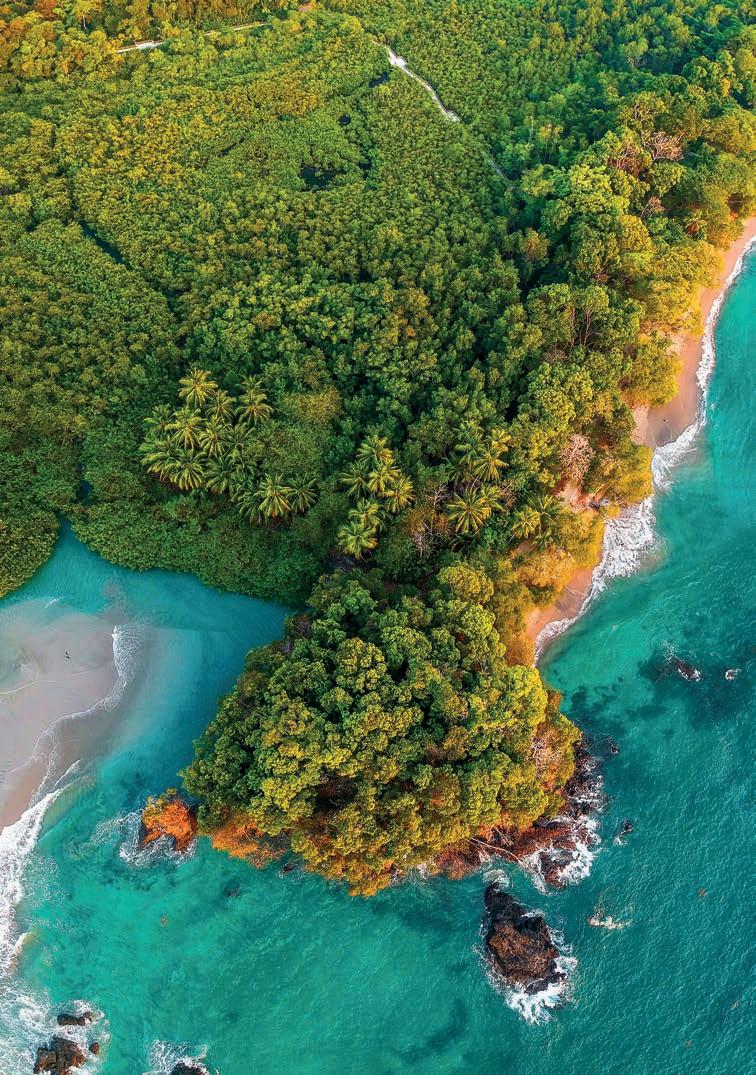
VOTE TO WIN 1 OF 8 PRIZES WORTH OVER £70,000!
The time has come again when we ask you to give us your thoughts. What was your most Wanderlust-worthy destination of the past year? Which tour operators and airlines do you feel are making a difference? We want to hear about the places and businesses that are making travel better. Let us know and you could win some fabulous prizes…

A nine-day Galápagos expedition cruise for two, plus flights, courtesy of Hurtigruten Expeditions

A four-night holiday in Puglia for two, including flights, courtesy of Cox & Kings
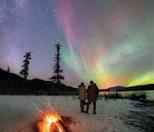
An eight-day Yukon northern lights adventure for two, plus flights, courtesy of Journeyscape

An eight-day self-guided walking trip for two in Cappadocia, courtesy of KE Adventure
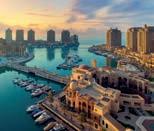
A five-star holiday including three nights in Doha and business-class flights, courtesy of Qatar Airways

An eight-day walking trip for two on the Amalfi coast, plus flights, courtesy of Exodus Travel









An eight-day Spitsbergen voyage for two, plus flights, courtesy of Discover the World and AE Adventures
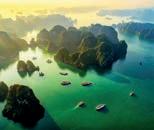
A ten-day Vietnam tour for two, plus flights, courtesy of Intrepid




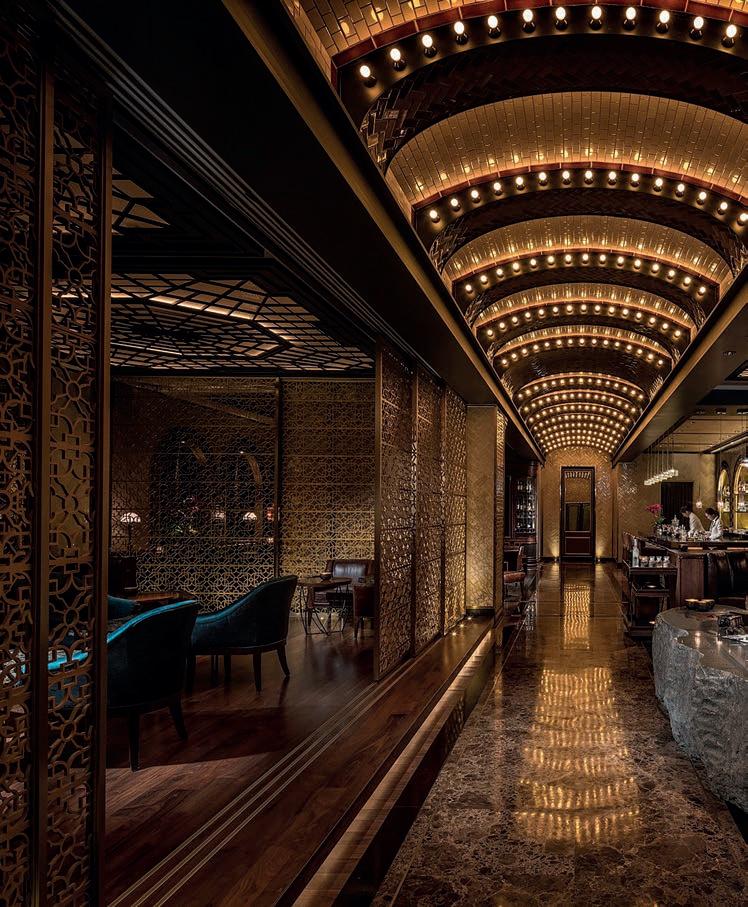
Cultured comfort in South Korea
From palace views to forest-shrouded temples, you can always find a way to squeeze some culture into your stay in the Land of Morning Calm
Retro relaxation
The Four Seasons Seoul’s Charles H bar regularly places in the ‘World’s 50 Best Bars’ list, and its discreet setting and 1920s vibe make it a slick spot for a cocktail. But it isn’t the only treat that you’ll find in South Korea’s top stays…

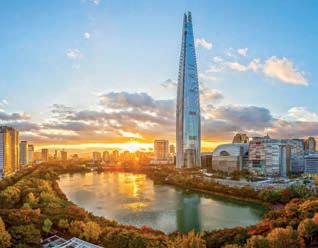
SIGNIEL SEOUL
Not one for those with vertigo, the ultra-modern Signiel Seoul occupies the 76th to 101st floors of the Lotte World Tower, Korea’s tallest building (and sixth-tallest in the world). It shares the skyscraper with the Lotte Museum of Art, so you can touch base with Korean high culture without ever setting foot outside. But when you do venture out, hotel services can arrange such perks as tickets to the Seoul Metropolitan Opera or Rolls Royce transfers, so you can experience the capital in style. Or if you’d rather stay in, the hotel’s Stay (French) and Michelin-starred Bicena (Korean) restaurants have impressive reputations, while the heated pool offers sweeping city views from up on the 85th floor. Doubles from £386 per night, room only; lottehotel.com

FOUR SEASONS SEOUL
Blending the furnishings of a stately manor with the ambitious geometry of a modern high-rise, the Four Seasons Seoul strikes a chic pose even for the Korean capital. It has all the hallmarks of a major hotel in a big city, including a collection of restaurants to rival anywhere in town, encompassing Japanese fusion (Akira Back), Italian (Boccalino) and Cantonese (Yu Yuan) cuisine. The Charles H also regularly ranks among Asia’s best bars, and its gilded speakeasy-style decor makes for an elegant setting to devour some glorious cocktails. But the hotel’s true blessing is its location, with some of Seoul’s top historical sites right on your doorstep – the Palace View Executive rooms even directly overlook Gyeongbokgung Palace. Doubles from £374 per night, room only; fourseasons.com

LOTTE RESORT JEJU ARTVILLAS, JEJU ISLAND
To stand out amid Jeju Island’s many resorts takes some doing. At Lotte Resort Jeju Artvillas, each of its flagship villas were designed by a different luminary from the architecture world, including Japanese luminary Kengo Kuma (V&A Dundee) and France’s Dominique Perrault (French National Library). Each draws on the island’s landscape for inspiration, which is apt given that it’s possible to decamp on a day hike up the shield volcano of Hallasan from the resort. For those looking to slow things down, order up gourmet Korean cuisine at the hotel’s sea-view restaurant, Art Cordelia, or soak in the setting with an outdoor barbecue. B&B villas from £587 per night; lotteresort.com

GOLGULSA TEMPLE STAY, GYEONGJU
In the mountains east of Gyeongju, one of Korea’s oldest Buddhist monasteries has opened its doors to guests. GolgulsaTemple encourages visitors to ditch technology and join in with the everyday activities of the monks who reside here; this could mean prostrations practice or classes in the traditional Korean Buddhist martial art of sunmudo Accommodation is in simple, gender-segregated dorms with ondol underfloor heating and floor mats for sleeping on. Experiential temple stay programmes generally last a couple of days and can involve visits to cultural sites, forest walks, tea ceremonies and archery. Dorms from £40 per person, per night (full board); golgulsa.com

SUN CRUISE RESORT, JEONGDONGJIN
Like something out of a magical realism novel, Sun Cruise Resort looks and feels like a giant luxury cruise ship, except for the fact that it sits beached atop a cliff, high above the East Sea (Sea of Japan). Much of the interior is a warren of suites (some with balconies), while the ship’s bridge hosts its own rotating bar. A second, similarly shaped wing of the hotel, known as Beach Cruise, sits lower down the cliff, offering upmarket villa-style rooms with private pools. There’s easy access to the beach from both and you can even stroll through the on-site sculpture park, which includes a giant set of hands bursting through the ground, to keep the surrealism flowing. Doubles from £305 per night, room only; esuncruise.com
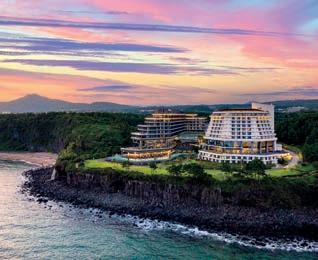
PARNAS HOTEL JEJU, JEJU ISLAND
What better way to take in Jeju Island’s sandy Jungmun Saekdal beach than from the longest infinity pool in South Korea, which wraps its way for 110m around Parnas Hotel Jeju. For those looking for a bit more action, there is also direct access to the long-distance Jeju Olle hiking trail (437km), making this a great base for those after an outdoors fix. Rooms range around the lofty central lobby, with each offering a different take on the island’s volcanic landscape. Fans of K-dramas might also recognise its interior, which was used as a filming location for the King of the Land TV series. Doubles from £249 per night, room only; parnashoteljeju.com
Alamy; Gogulsa Temple Stay; Josun Palace, A Luxury
Collection Hotel; Lotte
Hotels & Resorts; Parnasus Hotel
Jeju

With a grandeur and style befitting Seoul’s stylish Gangnam neighbourhood, Josun Palace makes its point in stately marble and attention to detail. It opened in 2021 on the site of the city’s original Western-style luxury
hotel, and it’s a worthy successor. Common areas dressed in cream, bronze and charcoal are overlooked by fine art and statuary by the likes of Daniel Arsham. Contemporary Korean cuisine is explored at Eatanic Garden,
where tasting menus feature local ingredients and are served in an Art Deco setting, while the rooftop pool offers impressive views over the skyline. Doubles from £348 per night, room only; jpg.josunhotel.com
JOSUN PALACE, SEOUL
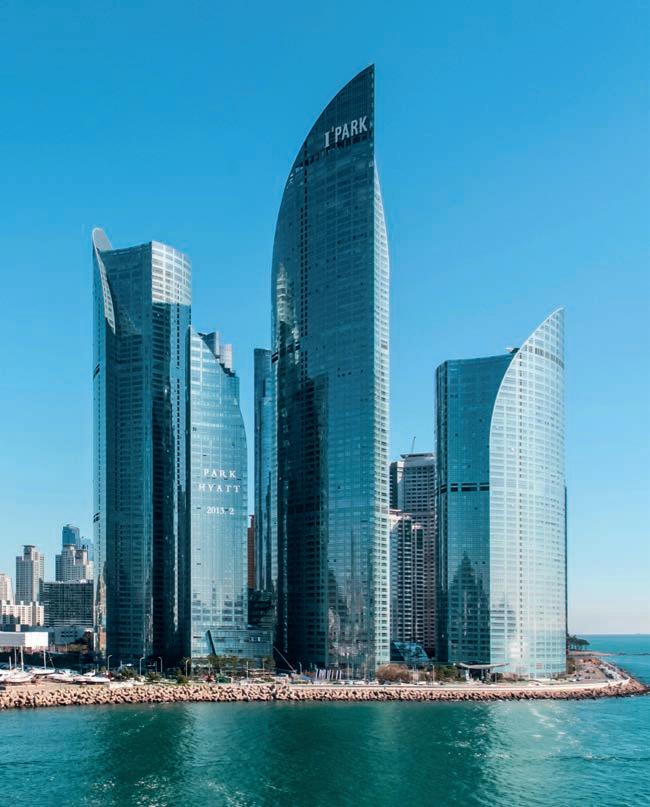
With the 7.4km-long Gwangan Bridge on one side and the golden sands of Haeundae Beach on the other, the Park Hyatt Busan’s floor-to-ceiling windows elegantly frame South Korea’s second city. Inside, some
200 rooms and 69 suites (some with spa bathtubs) put the onus on comfort.Take a dip in the granite indoor swimming pool at sunset or unwind with a treatment at Ocelas Spa. Best of all, the hotel’s water-
front location puts the city’s finest features on your doorstep, with the natural forest of Dongbaek Park and the beach only a few minutes away. Doubles from £187 per night, room only; hyatt.com
Alamy; Gyeongwonjae Ambassador
Incheon/Accor Hotels; JW Marriott; Lahan Select
Gyeongju; Park Roche
PARK HYATT BUSAN

PARK ROCHE, JEONGSEON
The best wellness retreats offer complete isolation from the trappings of modern life. Park Roche, set in the remote east and overlooked by gentle hills, ticks those boxes and more. Rest, introspection and reconnection with one’s mind and body in a natural setting is its raison d’etre, with a daily wellness schedule that includes morning yoga, sound therapy and breathing meditation. Its spa even spills into the outdoors, offering views of the Gariwangsan mountain (1,560m) as you relax in the water.The hotel also runs its own farm, where you can help to harvest vegetables and feed the animals, followed by a cooking class recreating some Gangwon-do favourites. B&B doubles from £218 per night; some classes are extra; park-roche.com
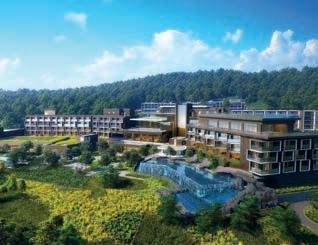
JW MARRIOTT JEJU RESORT & SPA
This Jeju Island clifftop escape blends neatly into its surroundings, having been built using the same volcanic basalt rock as the ground it sits on. Indeed, nods to the island’s landscape and heritage are woven throughout its design, particularly in the lobby’s traditional hanok-style construction, while nature walks offer a great way to explore the grounds and beyond. Be sure to save some energy for the infinity pool and the activity programme, which includes morning yoga sessions overlooking the sea.The half-board rate also covers afternoon tea and an indulgent French caviar brunch, as well as free tickets to the island’s Arario contemporary art museum. King rooms from £630 per night, half board; marriott.com
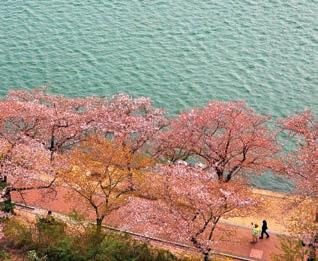
LAHAN SELECT GYEONGJU
On the shores of the Bomun Lake tourist complex lies Lahan Select Gyeongju.There’s plenty to do here, with restaurants, galleries and a drive-in theatre on your doorstep, though it’s worth timing a visit for cherry blossom season (late March), when strolls in the extensive lakeside parklands are at their most enchanting.The activity-focused vibe extends to the hotel itself, which includes a five-lane bowling alley and indoor golf range, though the lake views and waterfront greenery offer plenty of peace and quiet, if that’s what you want. It’s almost enough to make you forget that the UNESCO-listed tumuli and temples of ancient Gyeongju lie just a few kilometres away.Well, almost… Doubles from £93 per night, room only; lahanhotels.com

GYEONGWONJAE AMBASSADOR INCHEON
Looking not dissimilar to a Joseon-era village, the Gyeongwonjae Ambassador’s traditional hanok-style buildings double as luxury accommodation.Yet the design is more than just historical cosplay, with classical flora- and fauna-themed art, often with a mother-of-pearl inlay, adorning every inch of the common area, while restaurant Sura offers a cultured take on Korean royal cuisine. It is set in lush Songdo Central Park after all, which is better known as Incheon’s foodie and tech district.The 30 wood-beamed rooms are likewise designed and appointed with an eye on history, though include plenty of modern comforts too, including wooden soaking tubs and espresso machines. Doubles from £161 per night, room only; all.accor.com



travelogues







Discover how the stars shaped Peru’s Sacred Valley, see what makes Australia’s Sapphire Coast shine, join a modern renaissance in Moldova, and much more…





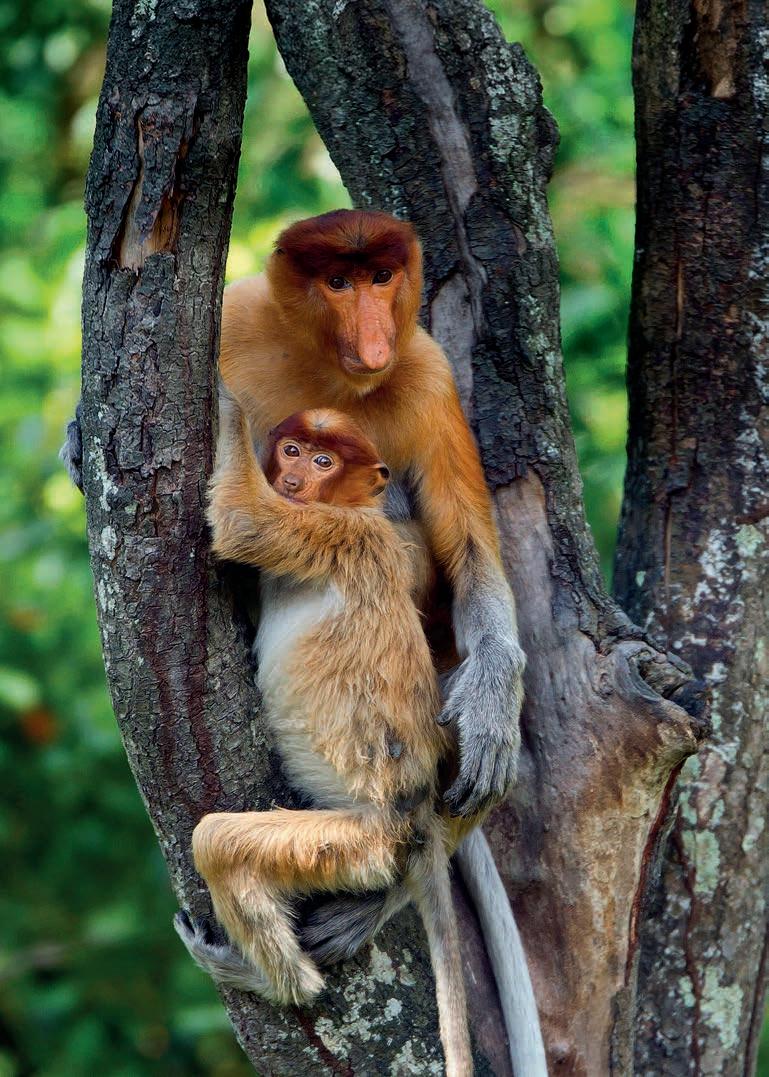



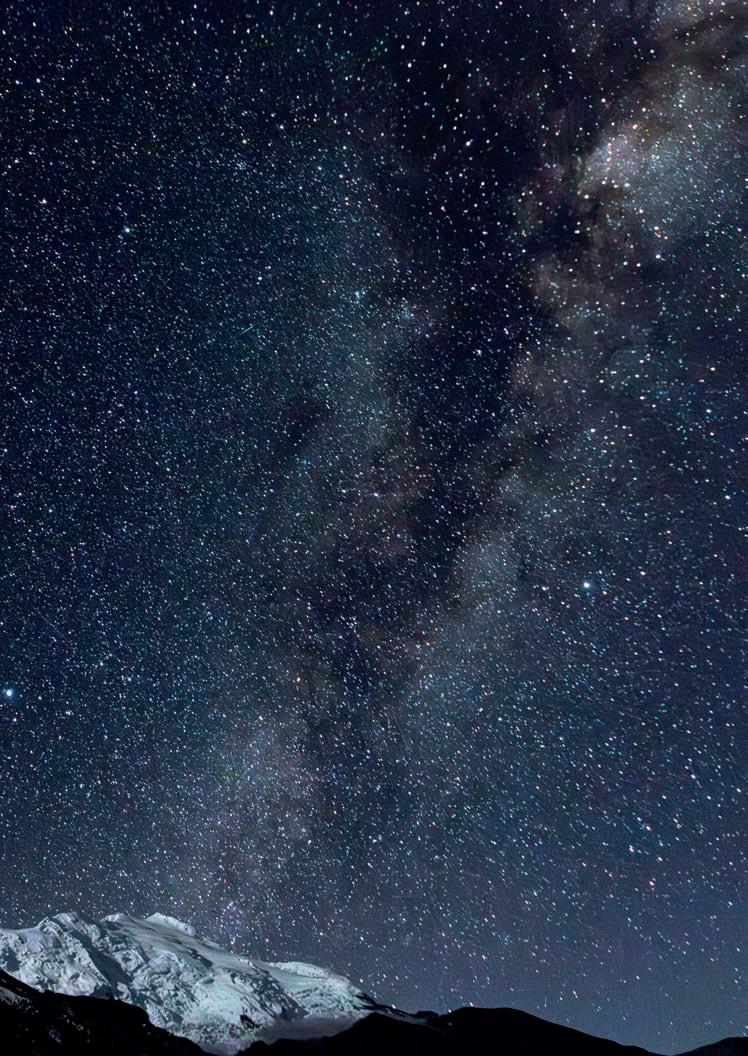
Written in the STARS
While millions come to Peru’s Andean highlands for the Inca ruins and festivals, there are other stories here. Time your visit for the solstice to explore an ancient region where even the streets are shaped by the heavens
Words & photographs Mark Stratton
“Slow down,” I chided myself, sucking in the rarefied Cusco air and hurrying over the cobblestones of Peru’s Quechua-language capital. I needed to be on Calle Siete Culebras (Seven Snakes Street) at 7.05am to witness the southern hemisphere’s winter solstice on 21 June, an eternal timestamp on Peru’s pre-Columbian architecture. Thankfully, I had just about made it.
The street, both narrow and steep, still glistened from the earlier rain and the solstice sunbeam arrowed in on a south-west course with unerring timing, bathing me in light. By design, the sun’s rays filter through Cusco’s central plaza, the beating heart of the city, where they cut across the axis formed during the summer solstice. Nothing here is by accident.
“Six huacas once existed along this solstice line; they were all demolished for churches”
I’d come to Peru’s Andes not to obsess about Machu Picchu, the citadel associated with the Inca whose 2 million-plus visitors a year are taking a toll on its ruins, but to discover the cosmological secrets behind the region’s fanciful archaeological heritage. Square in my gaze were the megaliths of pre-Inca civilisations, which appeared to my uneducated eye to be uncannily extraterrestrial in appearance. My astral guide was Andres Adasme, a 50-year-old Chilean archaeoastronomer and a resident of the Andes for two decades. He promised that
during our seven days together he would “squeeze knowledge from ancient stones” as we headed off the tourist routes to gain a new perspective on just how ingenious and mathematical these ancient cultures were. However, even wannabe archaeoastronomers need to breath. After travelling from Lima (161m) to Cusco (3,400m), I descended into the lower-altitude Sacred Valley to acclimatise. Down here, between Pisac and Ollantaytambo, the flat-bottomed farmland hid a breadbasket of maize and hundreds of potato varieties. But this was also dry season, so the land was coloured a russetbrown and the stubble of cut maize resembled brushed mohair.
I reoxygenated in a stone-built casita at the transcendentally calm Hotel Sol y Luna. Each morning, I sank into my bath and watched gossamer-green hummingbirds levitate around flower-filled gardens. At night, the Milky Way sparkled magnificently overhead. Having acclimatised, I returned to Qusqu (in Quechuan), better known as Cusco –a name the invading conquistadors could more easily wrap their tongues around – to meet Andres. Fate had surely directed him towards archaeoastronomy, which looks at how past civilisations used the sun and the stars to design their temples and guide their lives. His ex-wife was born on the summer solstice, while their daughter, named after the constellation Lyra, arrived on the
winter solstice. During our time together, his energetic, inquisitive mind constantly challenged an Inca architectural orthodoxy that understates the prowess of earlier civilisations, and being in his company was a little like living inside a Dan Brown novel.
OLDER THAN YOU THINK
On our first morning together, Andres and I stuck to the ancient stone streets of Cusco, a town I’d consistently read was founded by the Inca – a heritage it theatrically plays up to. Quechua women cuddling baby alpacas traded photographs for cash while street sellers sold knitted toy llamas and scarves with bright motifs. But Andres is convinced that Cusco’s lineage is far, far older than the Inca.
We headed to the main plaza, which was filled with musicians and dancers warming up for the forthcoming Inti Raymi festival of the sun. Here we saw a mid-17th-century basilica sat above a destroyed huaca (temple) that was once dedicated to the Andean creator god Viracocha.This name is also given to an ancient civilisation from around Lake Titicaca, Andres told me, who spread north into the Andes and likely founded Cusco long before the Inca.
We followed a processional route through the city from north-east to south-west, aligned with the winter solstice line (also known as the secondary axis). Six huacas once existed along this line, I was told, all subsequently demolished for churches. The cathedral plaza also intersects with the south-east/north-west summer solstice axis (the primary), thus quartering the city into the four corners of the Inca Empire. ⊲

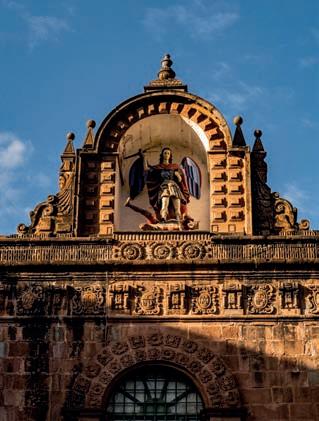
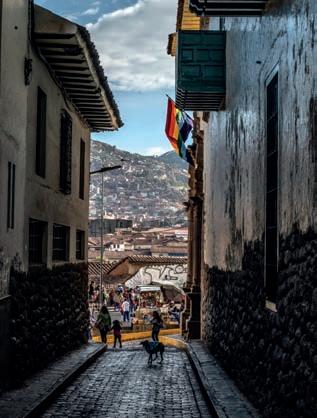

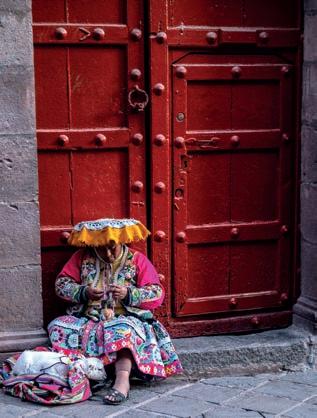
The palimpsest city (this page; clockwise from top left) Sat atop the original location of a Viracocha temple, Cusco cathedral was said to have been built using blocks taken from the Inca site of Sacsayhuamán; solstice light beams down Calle Siete Culebras, which has seven snake reliefs carved into its stonework; colourfully dressed locals pose with alpacas for tourist photos; the rainbow-coloured flag of Cusco dangles over a street with views across to the central plaza; (opposite page) the drive to Ollantaytambo reveals lush farmland backed by rocky peaks; (previous spread) the Milky Way twinkles above an Andean glacier

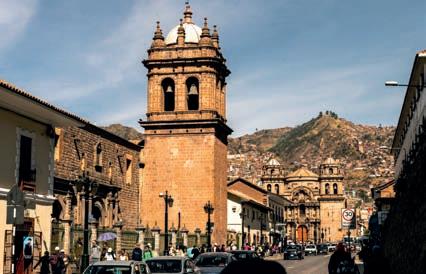
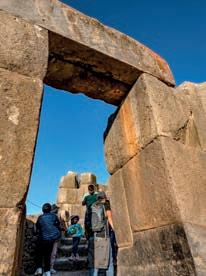
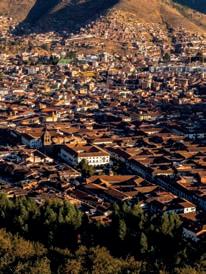
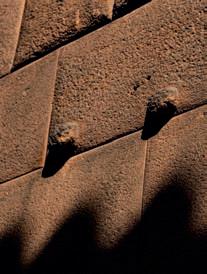
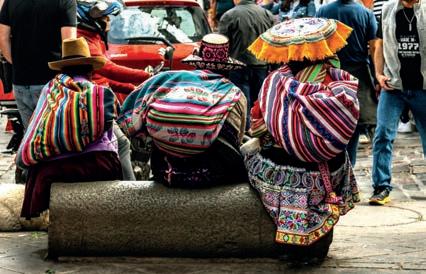
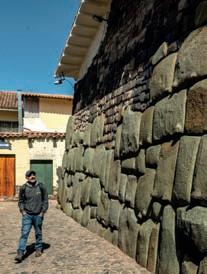
Carving the valley (this page; clockwise from top left) One of the stone reliefs found along Calle Siete Culebras; the row of churches built atop Cusco’s ancient huacas (temples) follows the winter solstice line; Andres believes these protuberances form a kind of shadow language hidden in pre-Inca architecture; Andres stands next to the green-diorite stonework of Calle Inka Roqa; the souvenir sellers of Cusco play on the city’s Inca heritage; a stone lintel in Sacsayhuamán; the view of Cusco from Sacsayhuamán; (opposite page; top right) Spanish colonials tore down much of Sacsayhuamán to use its stone to build houses in Cusco
Building for the future
When Frenchwoman Petit Mirabel arrived in the Sacred Valley 20 years ago, she was shocked by the child poverty that she found in the region. So, in 2000, she founded a remarkable educational and social foundation known as Sol y Luna.
To fund much of the work done by the foundation, she created the luxurious Hotel Sol y Luna in the Sacred Valley, near Urubamba. Income from this has helped to build its school for underprivileged kids, an additional-needs facility and a home for children removed from their parents. The foundation also runs Roots & Wings, which supports students going to university.
I joined project coordinator Kelly Limo (pictured below) on a tour of the school and kindergarten, which was filled with the kind of exuberance you’d expect from small children. Many of the kids come from poor Andean households, so the foundation offers them a future filled with hope.
However, the last few years have left Sol y Luna in a vulnerable position. With £470,000 required each year just to keep operating, first the pandemic and then political instability saw hotel occupancy drop, with the foundation’s funding withering in the process. It needs visitors now more than ever to continue with the good work that it does. You can learn more at
asociacionsolyluna.com
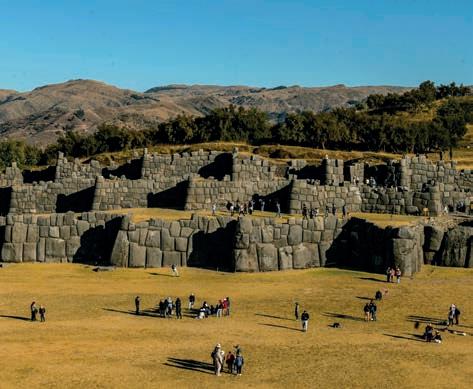
By inputting what he calls his ‘gears’ –the solstices, the Milky Way’s alignment and the position of the Southern Cross –into a computer programme (Stellarium), Andres has produced an estimate that Cusco may be as much as 12,000 years old.
the puma and Earth goddess Pachamama; Uku Pacha, the underworld guarded by the serpent, a keeper of knowledge; and Hanan Pacha, the cosmological world above. He believes the latter’s symbol, the condor, is represented by a stargazing tower on Cusco’s main plaza that is long since destroyed.The condor is, however, also associated with a remarkable hillside construction above Cusco called Sacsayhuamán. It’s such a sophisticated cosmological timepiece that it makes Stonehenge look like children’s Lego.
HIDDEN SECRETS



To emphasise the city’s palimpsest origins, we walked along the summer solstice axis towards a temple called Qoricancha, which was said to have once been covered in gold. Along the way we passed the best verified Inca stonework in the city, on Calle Intik’ijllu, where cushion-sized pink andesite blocks attested to the exquisite workmanship of the period.Yet it was a far cry from what we found on Calle Inka Roqa, where the walls are fashioned from huge green-diorite megaliths with curved joints. “This is older; it’s nothing like Inca design,” Andres explained.
“Andres estimates that Cusco may be as much as 12,000 years old”
When viewed from above, historic Cusco’s streets are said to be configured like a puma with a serpent along its back.The puma’s heart has been calculated to be where the solstices cross and where the Viracocha temple once stood. Showing me the graphics of a model he had made of the puma’s form, Andres explained that the design transcended the three ‘pachas’ (worlds): Kay Pacha, the living realm symbolised by
Naturally, our next stop was Sacsayhuamán. As we entered the site, Andres sighed at a sign reading: ‘Important cultural and ideological legacy of the Inka (sic) culture.’ Ducking through a natural cave, we arrived at a circular plaza, instantly sending several lapwings looping through the air.
The whole complex, Andres told me, was used as a colossal astronomical observatory. The plaza once held water that was used as a mirror to trace the movement of the sun and the Milky Way by reflection.
Beyond the site lay a hillside terraced by huge stone megalithic blocks, aligned geometrically in a zigzagging fashion. Reaching 5m high and weighing over


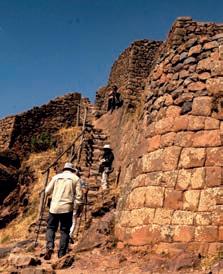
100 tonnes, their joints were cigarette-paper thin. Above them were once three towers built for sky observation. These megaliths were from an unknown and sophisticated civilisation, Andres explained.
“But why so massive?” I wondered.
“To make a lasting impression?” he shrugged. How they were used astronomically remains a mystery. “The knowledge was meant for a select few: the Amauta, or wise ones. But it was lost forever when they fled the Spanish, who had no idea how sophisticated Andean society was.”
CASTING SHADOWS
Further cosmological wonders awaited me in the week that I spent in the Sacred Valley during the lead up to the winter solstice.We soared higher into the Andes, closer to the mountain deities known as Apu. At Pisac, the mountainside fell away for several kilometres and was replaced by colossal terraces.The cliffside burial caves here attract coachloads of visitors, while up on the summit, a series of stone buildings marked with niches ascend to a sheer precipice.
As with everywhere we visited, Andres had a theory: “I believe the mummified dead were brought here so their souls could connect with Hanan Pacha,” he told me.
“The Pleiades constellation is seen near the Southern Cross before sunrise. At winter solstice, if the constellation seems blurred, then it means that more humidity is rising in the Amazon and rain is coming, so they would plant their crops. If clear, it suggests dryness ahead, so they would delay planting.”
A GUIDING STAR
The next morning, my temples pounded as we crossed the 4,400m-high pass into the LaresValley.The road switchbacked via the glaciated peak of Sahuasiray (5,818m) and then descended into Choquecancha, a village with a centuries-old whitewashed Spanish church on the verge of collapsing.
Vaqueros (cowboys) led horses laden with sacks of harvested maize clip-clopping across the plaza’s cobbles. Few visitors make it here.The plaza, Andres said, was another reflective pool for observing the Milky Way and the solstices. In its corner was once a suntur-huasi, a ‘condor tower’, to observe and connect with Hanan Pacha.
“Farmers still go into the mountains to predict next season’s weather by looking at the stars”
Escaping the crowds, we hiked down an old pathway following the mountain’s folds for three knee-jarring hours to an intiwatana (sundial), a word whose rather poetic translation from Quechua means to ‘tie up the sun’. On a mountain saddle, I gazed over the square, roofless stone buildings surrounding the circular tower. Machu Picchu’s intiwatana is off-limits due to the impact of its crowds; here I could freely gaze on the tabular rock altar, its gnomon facing skywards in order to cast the sun’s shadows.
Naturally, Andres had another idea as to its use. He showed me shoebox-sized niches running along the sundial’s steps. “I think these were for candles, which you’d only need at night, so this was also likely an observatory,” he said.
Later, as we were drinking local craft beer in a cerveceria, I asked him why it was so important for these past Andean civilisations to have acquired such cosmological knowledge. It had many uses, he explained, and chief among them was farming.
“It only collapsed 15 years ago,” said Maribel Tito, a villager with whom we ate a lunch of lentils and rice. “It was 10m high and had one window facing west, towards the Milky Way. Farmers still go into the mountains here to predict next season’s weather by looking at the stars, and we know our maize is ripe when the choclopocochi (black-and-white seedeater) calls. It flies here to eat our crop.”
By now, I had sensed that I was immersed within a living Andean landscape that was little changed since the conquistadors arrived. The high-altitude moorland surrounding the remote Huacahuasi Lodge, where I spent the evening, was scattered with adobe and stone farmsteads guarding huge alpaca herds and tiny potato terraces.
More than one-third of Peruvians identify as Quechua. Up here, the women all wore bright knee-length skirts, lliclla woollen shawls pinned with clasps and widebrimmed hats – some of which resembled extravagant fruit bowls. Locals also still observe ceremonies to thank Pachamama, especially in regard to their livestock. In Huilloc, I watched as a very reluctant sheep was daubed with chicha maize beer in the pattern of a crucifix, reflecting a ⊲
A rocky road (this page; top to bottom) Inching the mysterious tunnels, known as chinkanas, that connect sections of Sacsayhuamán; alpaca in the Lares Valley have no respect for the rules of the road; exploring the cliffside burial platforms of Pisac, which have become very popular with visitors; (opposite page; clockwise from top) the intiwatana (sundial) of Pisac is still accessible to visitors, while the candle notches in its steps suggest it may have once doubled as an observatory; a souvenir seller checks their wares on the route to Pisac; one of Pisac’s burial chambers up close; squeezing down the sometimes narrow path to Pisac

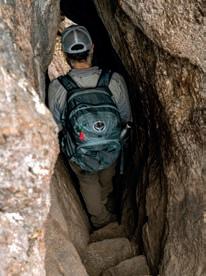





Mountains and stars (this page; clockwise from top) The view back to town from the Sun Temple of Ollantaytambo; qollcas (granaries) scatter the slopes leading up Pinkuylluna mountain; in Peru, the Inca sun festival of Inti Raymi was moved from its traditional date on the winter solstice to 24 June by the Catholic Church; (opposite page; clockwise from top) the people of the Andes know the Milky Way by the name Mayu, meaning ‘heavenly river’, and it is said to be home to animals whose shapes can be identified in the dark blotches between stars; the church at Choquecancha; Ollantaytambo’s Sun Temple; the horsemen of Choquecancha



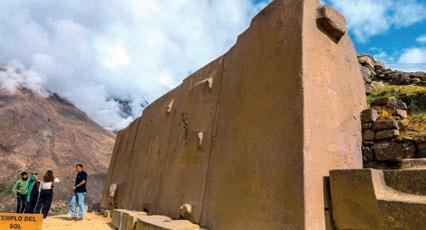
bets-each-way syncretism of Catholicism and paganism still prevalent today.
That night in Huacahuasi Lodge, I experienced the awe that the MilkyWay must have inspired in the Inca and those that came before them.Admittedly, stargazing while sat on a terrace in a Jacuzzi wasn’t in the ancient spirit of things, but just as the pre-Columbians had witnessed, I saw Scorpio shine and used the Southern Cross as my guide. I nearly spilt my coca tea into the bubbles when two shooting stars careened across the horizon.
Yet, for all the sparkle of the Milky Way, it was the forms created by its dark cloud constellations – voids, like Rorschach
inkblots, given life by the people of the Andes – which were particularly auspicious. I pinpointed the twin stars of Alpha and Beta Centauri, said to be the eyes of a sacred black llama (its body a dark mass) drinking from the Urubamba River. Andean people say that it rains during summer because the celestial llama drank too much.
It was the farmer’s constellation, the Pleiades, that I really wanted to see.The next morning, just before 5am, Andres knocked on my door and we went outside to see its seven stars glinting north-east of Jupiter. It was clear. Perhaps a bad omen for my already-planted tomato plants back home.
Not just roasted guinea pig…
Guinea pig (cuy) is a mainstay of the Quechua diet but, for the love of Bow (a one-time pet), I wasn’t remotely tempted by crispy guinea pig legs served with Andean potatoes. No matter, because the choice of foods here is positively gluttonous, driven by the prodigious staples of maize and potatoes (over 3,000 varieties).
A green herb called huacatay (a type of marigold also known as ‘black mint’) flavours ocopa sauce, which is proudly poured over potatoes. Corn may be served dried as maize or choclo (fresh); the latter, steamed, is a delicious street-snack.
Quinoa is ubiquitous, as are hearty Andean soups with veg and meat. Lamb, alpaca, beef, chicken and trout feature on most menus, while snacks include pasty-like empanadas and butifarra, a sandwich overflowing with pork belly. When it comes to altitudinal adjustment, grab a cup of coca tea; muña (mint tea) is great for digestion. It goes without saying that the two Peruvian classics of pisco sour cocktails and ceviche (fish cured in lime juice) are everywhere. My favourite eatery was Alqa (@alqa.restaurante on Instagram) in Ollantaytambo; its menu is designed around tubers, peppers and varieties of corn.
A FINAL SURPRISE
A few days before winter solstice, we reached the fabulous Ollantaytambo, a popular jumping-off point for those taking the train to Machu Picchu. Away from the chaotic railway station, the quiet centre’s megalithic green-stone lanes are laid out in a geometric grid resembling a maize sheaf – one that holds many secrets. Either side of the solstice (21 June) there is a window of around two days when the sunlight is projected at the same angle.With that window still open, we hiked along the River Urubamba and made our way to a terrace facing where the solstice sun would rise,
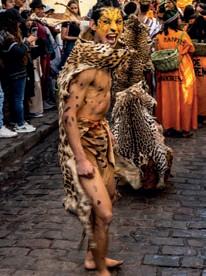
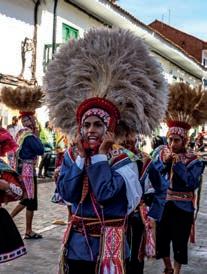

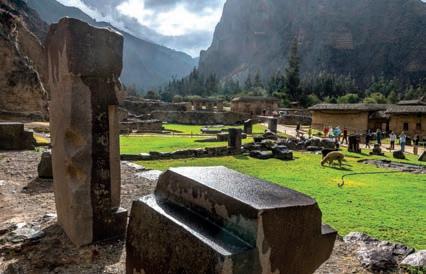

Festive spirits (this page; clockwise from top left) A performer at the Inti Raymi festival gets into character; the temple terraces of Ollantaytambo, as seen from the slopes of Pinkuylluna mountain; Andres points to the unused blocks around Ollantaytambo Sun Temple, which may have been cast down by Spanish colonials; the temple megaliths of Ollantaytambo take the breath away; Inti Raymi dominates the streets of Cusco during the festival (and closes off some parts of the city), with the main celebration areas taking over Qoricancha, the Plaza de Armas and Sacsayhuamán
theoretically, from behind Pinkuylluna mountain to direct a sunbeam towards us.
As we waited, Andres explained how this light would define one side of a hidden optical illusion: a three-dimensional pyramid called Pacaritambo (or Paqariq Tampu, meaning ‘Lodging of the Dawn’). It took a while to get my head around this. He explained that the walled one-dimensional farm fields below us were crossed by a lane shadowing the equinoctial line (the line of the equinox when the sun crosses the equator); this was engineered in such a way that a pyramid manifests itself in 3D as you gain altitude.The idea was almost unbelievable.What level of sophistication and knowledge could have engineered this?
“Nobody comes to see it; there’s virtually no literature about it.Yet it’s one of the world’s greatest phenomena,” said Andres.“I think it’s part of the oldest and biggest sundial in all the Americas: a magical alignment between the sun, the earth’s axis and architecture.”
However, the usually clear winter skies were freakishly cloudy and the solstice light was snuffed out. I had to console myself with the sight of the giant hummingbirds that emerged at dawn.
Yet this optical pyramid is only one part of Ollantaytambo’s celestial interconnectedness, which we then spent time exploring in depth. The solstice beam intersects a mountainside Sun Temple in town. Around that temple’s base are enigmatic green-diorite blocks with unfathomable grooves and notches; these stones were either waiting to be transported up to the SunTemple or were cast down by Spanish philistines. Andres had seen this architectural masonry before, though, at an ancient temple in Tiwanaku, not far from LakeTiticaca. “A Polish scientist dated that architecture to 12,000 years old,” he said.
“The sunbeam defines one side of a hidden optical illusion: a 3D pyramid”
bearded, just as ancient mythology recalled the Viracocha peoples’ appearance. We looked back from here towards the Sun Temple to see the terraces form the outline of the sacred black llama of the Milky Way. Its head is the Sun Temple, which receives the winter solstice sunbeam to create the llama’s illuminated eye. By now, I just accepted the ancient Andeans’ cosmological brilliance, although sadly I never witnessed the solstice here. Perhaps Tunupa Viracocha was disgruntled.We’d clasped three coca leaves in a prayerlike cupping of our hands on the mountainside and blew, as tradition dictates, to beseech clear skies. But old stony face hadn’t listened.
Need to know
We climbed the Sun Temple’s terraced hillside to seek out six humungous rectangular pink granite slabs. Andres remarked that it was one side of an incomplete solar observatory.The 4m-tall blocks had been chiselled with strange protuberances that cast, he believed, a secret shadow language of the cosmos that only the Amauta could decipher. Just as it occurred to me that these slabs resembled the extra-terrestrial monolith in the opening scene of 2001:A Space Odyssey, an excited Chinese visitor hurried over and said: “Can’t be human… must be aliens.”
The following day, we hiked up Pinkuylluna mountain, where the huge face of the god Tunupa Viracocha had been hewn –heavens knows how – from a cliff. He is
No matter. At every place we’d visited during this inspiring week, each archaeological site had been energised by discussions with my brilliant friend Andres on cosmology, the extravagance of design, what protuberances meant, and with what earthly powers the people here had manhandled 100-tonne blocks up a mountainside.
I returned to Cusco to find the city had erupted into the kaleidoscopic Inca pageantry of Inti Raymi.The festival now takes place after the solstice (on 24 June), following a historic merging with the Catholic feast day of St John the Baptist, as the Church saw heresy in worshipping the sun. It is Disneyfied Andean eye-candy at its finest. But, as I’d discovered, there is another way to experience the solstice here. Just a few days earlier, I’d witnessed the sun inflame Calle Seven Snakes and metaphorically stood shoulder to shoulder with the cosmic designers of the past. I’d seen Cusco and the SacredValley in a completely different and wondrous light.


When to go
Year-round. April to November has clearer skies for cosmologists; this coincides with peak crowds (Jun–Aug) and Inti Raymi (24 June).


Getting there & around
The author flew with LATAM (latamairlines.com) from London to Lima via Madrid, then on to Cusco. Daily returns start from around £811; flights take 19 hours.


Carbon offset
A return flight from London to Cusco produces 1,047kg of carbon per passenger. Wanderlust encourages you to offset your travel footprint through a reputable provider. To find one, visit wanderlustmagazine.com/ inspiration/sustainable-travel.


Where to stay
Hotel B (hotelb.pe; from £236pn) is a Belle Époque-style beauty in Bohemian Barranco in Lima. The gorgeous Hotel Sol y Luna (hotelsolyluna.com; from £451pn) offers casitas with roaring log fires near Urubamba. In Cusco, Mountain Lodges of Peru (mountainlodgesofperu.com) offers two lovely Spanish-colonial boutique houses with interior patios: Casa Andenes (from £130pn) and Hotel XO Arthouse (from £285pn). My tour with them also included their remote Sacred Valley properties Lamay and Huacahuasi Lodge


Further reading & information
kindhumantravel.com – Andres Adasme’s new project promperu.uk – Travel information
The Trip
The author travelled with Journey Latin America (journeylatinamerica.com), which offers a 12-day trip in Peru combining Mountain Lodges of Peru’s six-night archaeoastronomy tour, featuring Machu Picchu, plus extra nights in Lima and Hotel Sol y Luna in the Sacred Valley from £4,046 per person. Includes all transfers, accommodation, some meals and guided services.
Cusco
Ollantaytambo
LIMA Pisac
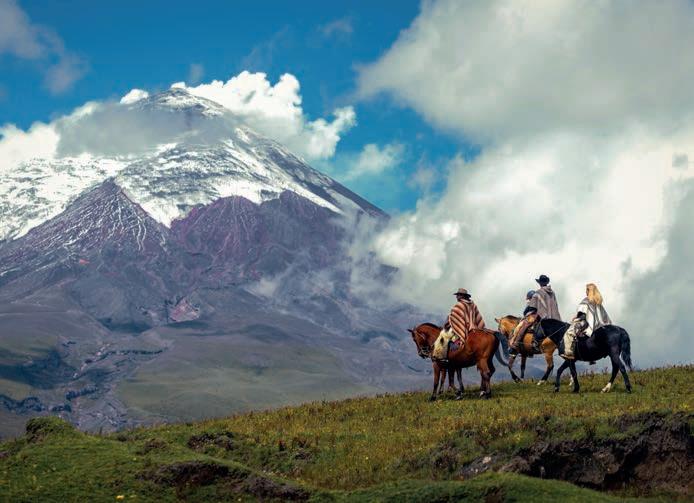
DISCOVER THE FOUR WORLDS OF ECUADOR
From the wildlife of the Galápagos to the shores of the mainland, soaring Andean peaks to the lush foliage of the Amazon, here’s how to experience the four very different sides of Ecuador…
With its lofty Andean peaks separating the steamy Amazon jungle from sandy Pacific bays, Ecuador is one of the most megadiverse places on the planet. Just as the rich volcanic soil helps its highly coveted roses grow strong and tall under the year-round equatorial sun, its natural wonders offer a wild playground for curious travellers.
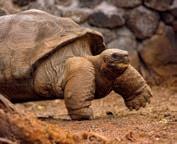
Ecuador squeezes a lot into its compact size, with four distinct worlds to explore: the iconic Galápagos Islands, a living laboratory of evolution; the Andes, its mountains steeped in history and scattered with cities and crater lakes; the Pacific coast, known for its surfing and whale watching; and the Amazon, a birdwatcher’s paradise where you can bask in nature and learn forest lore from Indigenous guides. Here’s how to visit them all…
Unforgettable Galápagos
Of the 127 volcanic islands and islets that make up the Galápagos archipelago, only four are inhabited, which has helped preserve the diversity of the carefree local wildlife. Sea lions, blue-footed boobies and Sally Lightfoot crabs are just some of the wonders that visitors encounter.
Mountain highs (this page; clockwise from top) The Andean Highlands are dotted with mighty volcanoes such as Cotopaxi; culinary delicacies like ceviche celebrate Ecuador’s fresh produce; marvel at wildlife in the Galápagos, including the giant tortoise
At Playa Tortuga, on the island of Santa Cruz, you can laze on the soft white sands or snorkel with marine iguanas. Isabela Island is the place to watch tiny Galápagos penguins torpedo through the water, while scuba divers who want to swim with eagle rays and hammerhead sharks head out to Kicker Rock. Charles Darwin called the Galápagos ‘a little world within itself’, and the islands are as magical now as they were in Darwin’s day.
The cultured coast
Often reached via the gateway city of Guayaquil, Ecuador’s 2,237km stretch of Pacific coast is the place to soak up the sun, enjoy delicious local fruits and seafood specialties like ceviche, or visit a local cacao plantation for a beanto-bar experience. And that’s before you even set foot on a beach.
Montañita is popular for its surf and nightlife, while Mompiche offers hiking through a rainforest that resounds with the throaty grunts of howler monkeys. And to the south of Manta, Puerto López is the gateway to the Machalilla National Park and Los Frailes,
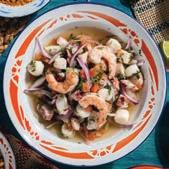

said to be the most beautiful beach in Ecuador.
For wildlife, Isla de la Plata is often likened to a mini Galápagos for its blue-footed boobies, sea lion colonies and scuba diving. From June to October, this section of coast is also a whale-watching hub, when some 7,000 humpback whales arrive to breed and nurse their young.
Majestic Andes
At the heart of Ecuador are the Andean highlands and capital Quito, a UNESCO World Heritage site. One unique attraction among many here is mighty Chimborazo, whose summit is the furthest point on the planet from the centre of the Earth, thanks to an equatorial bulge. Climb to its glacial peak or cycle down the lower slopes.
The Andes region is just as notable for its cities and cultural sites. You can visit artisan workshops and art galleries in Cuenca, or head to Ingapirca, an Inca site dedicated to the worship of the sun, to explore ancient Andean cosmology. Ancestral traditions continue in the weaving town of Otavalo, famous for its Indigenous craft market and its annual Inti Raymi sun festival (June). And for a deeper dive



into this sacred landscape, hike the circuit around the scenic Laguna de Cuicocha (Guinea Pig Lake).
Magical Amazon
Ecuador’s vast expanse of dense rainforest is home to animals including jaguars, giant river otters, pink river dolphins, anacondas and caiman. It’s a dream destination for birdwatching too, with more than 600 bird species having been spotted in the Ecuadorian Amazon alone.


Nature’s bounty (this page; clockwise from top) The volcanic Galápagos Islands are home to many laid-back iguanas; Ecuador’s Amazon region offers peaceful kayaking trips; it is also home to more than 600 bird species; some 120,000 sq km of Amazon rainforest spans Ecuador; learn from and celebrate ancestral Indigenous traditions in the Andes; spot whales breaching in the waters off Ecuador’s coast; Darwin called the Galápagos Islands ‘a little world within itself’

Nowhere is more biodiverse than Yasuní National Park, the country’s largest conservation area. The easiest access to the rainforest is through the town of Tena, where whitewater rafting is combined with canoe trips to Indigenous Kichwa communities.
For a deeper immersion in Indigenous culture, cruise the Napo River on the Anakonda, a luxury boat that visits communities along the water and makes its way deep into Yasuní. And if you want to support Indigenousrun rainforest camps, you can learn how the Kichwa live in harmony with their rainforest home at Sani Lodge.


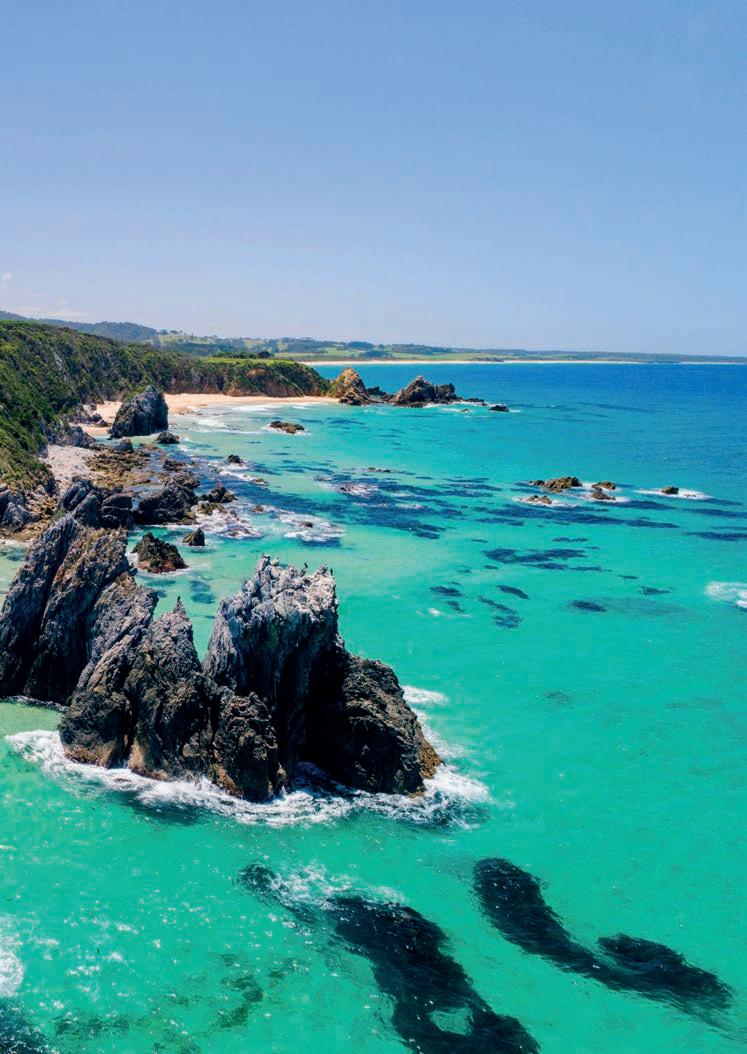
All that
glitters
Hit the road to explore Australia’s Sapphire Coast and beyond, and discover how its Aboriginal history and small communities put the sparkle into New South Wales
Words Jessica Reid
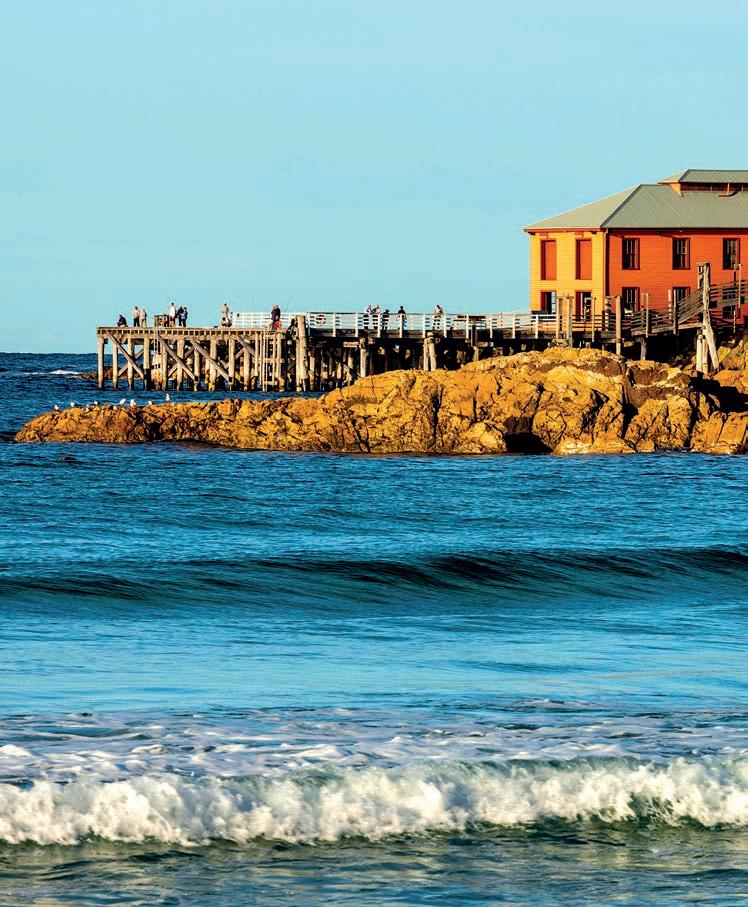

“Iwant to pay our respects to the land, the ocean and the river that we’ll be paddling today,” said my guide Nathan Lygon. His words hung in the orderly silence that followed as I hunkered down in my kayak in contemplation. I peered across the whitesand beach to where the turquoise waters of the Pambula River empty into the Tasman Sea, then over to where moss-speckled rocks stood camouflaged against a forest of eucalyptus. Everything was calm and serene.
Moments like this are what you long for as a traveller: nature in all its nameless, unknowable mystery. Yet I had come here to learn a different way of seeing. For the people of the Yuin Nation, the original custodians of these lands, this was all part of an ancient story that continues to this day. As I would soon discover, it was just one tale among many in Australia’s South Coast region.
beaches, neighbourhoods and First Nations history that not many visitors to New South Wales ever see, and I was taking them all in on a sun-soaked 166km road trip.
“Evidence of First Nation Australians in the South Coast region dates back some 20,000 years”
I’d arrived in New South Wales (NSW) as one of the 38 million or so travellers who land in Sydney, the continent’s busiest hub, each year. Many (about 10%) head to the Blue Mountains for their wilderness fix, but Australia is vast and empty, and there are so many options. This state alone is more than twice the size of Germany, with plenty of corners hiding little-heard stories. Even after catching an hour’s flight south of Sydney to Merimbula, 460km away, deep in the South Coast, I still hadn’t left NSW’s borders.
I was here to explore the small communities that scatter an area known as the Sapphire Coast and beyond. This is a landscape of river creeks, forests, oyster farms,
It was the Indigenous history of the region that I was most interested in. Beowa National Park (formerly Ben Boyd NP) recently had its Indigenous name restored to recognise the land’s original custodians. It is part of an ongoing movement across Australia to acknowledge the damage done during the colonial years. It also reinforces the idea that there are other ways of seeing these lands, and I was curious to explore the area through Indigenous eyes. This was how I came to be on a sheltered beach paying my respects to the land and the water, having joined Navigate Expeditions’ Cultural Kayaking tour to learn more about the people of the Yuin Nation – the Aboriginal community that inhabits the southern coast.
As we took to the Pambula River, Nathan wished the group “Walawaani”, meaning safe journey, and we followed the gentle wake of his kayak upstream. I stayed attuned to my surroundings, listening for the soft splashes of our paddles hitting the water and the bird calls that filled the air. Nathan pointed to the sky just as a set of brilliant-white belly feathers flashed over our heads.
“We call this one myangah, meaning sea eagle,” he shared, highlighting how the species has featured in Indigenous storytelling for millennia. “It’s one of the most important birds to our people.”
Evidence of First Nation Australians in the South Coast region dates back some 20,000 years, and this long history has led to a
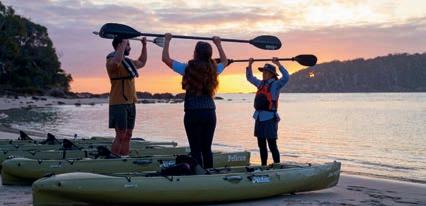
A tale of two waters (left–right) Tathra Wharf was first built in 1862 to accommodate the passenger steam ships that linked the South Coast to the rest of Australia during the late 1800s – now it’s a popular hub for gourmands; Navigate Expeditions run tours to learn about the Indigenous heritage of the area; (previous spread) Pambula River’s name derives from a Yuin Aboriginal word meaning ‘two waters’
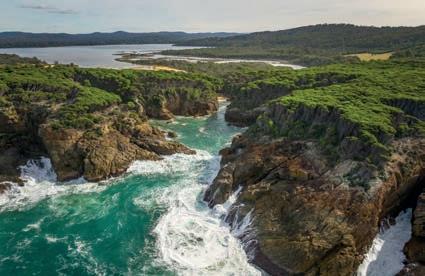




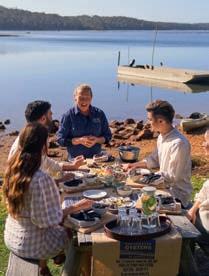
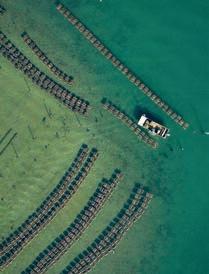
Jessica Reid; Destination NSW
Fruits of the sea (this page, clockwise from top left) The Sapphire Coast covers a 90km stretch of New South Wales, from Bermagui to Eden, and takes its name from the sparkling ocean; Sydney rock oysters are native to Australia and thrive in its brackish estuaries; boats depart Narooma for tours of Montague Island Nature Reserve; there are more than 280 oyster-farming businesses in New South Wales; Broadwater Oysters explains how its shellfish go from sea to plate; there’s plenty to shuck; Aboriginal guide Nathan Lygon crouches beside a shell deposit on Severs Beach; (opposite page) kayaking with Navigate Expeditions

remarkable coexistence with the environment.The river deltas, forests and coast have been an essential resource to theYuin Nation, providing shelter, food, clothing, tools and medicine. This deep respect for nature, passed down through the generations, is embedded in today’s culture; it also lies at the heart of Australia’s growing number of Indigenous-owned businesses and experiences (including Navigate Expeditions), which have increased by around 74% in recent years.
After a long paddle, we dragged our kayaks past damp rocks clustered with molluscs and onto the secluded sands of Severs Beach. Here we found an intricately constructed wall made up of layers of shells that had been cemented together by soil. It marked the boundaries of the beach.
sector in New SouthWales, with more than 280 farms scattering the coast. So, after working up an appetite from kayaking, I set off on my first oyster experience.
In a single-storey shack overlooking the glassy waters of Pambula Lake, Mel Page introduced me to Broadwater Oysters, a local business run by husband-and-wife team Greg Carton and Sue McIntyre for nearly three decades.Their speciality harvest – the Sydney rock oyster – is native to the area and thrives in the brackish waters of the estuary; it’s also a local delicacy highly prized in these parts.
“More than 280 oyster farms scatter the coast of New South Wales”
“This is called a midden,” Nathan explained, crouching next to it. “It’s made from mussel and abalone shells that the old people foraged from the river for thousands of years, depositing here. It’s evidence that people have been collecting, eating and cooking here for a long time.” As he brushed his hand tenderly against the delicate mound of shells, I could see the pride in his smile. “It’s pretty special,” he added.
THRIVING ON THE OCEAN
The river may have been a source of nutrition for First Nation Australians for thousands of years, but it wasn’t until two centuries ago that the region began utilising this natural ecosystem commercially. Oyster farming is now the largest aquaculture
“Australia is lucky to have native species of oyster, particularly in this region,” Mel explained with a grin. Incredibly, this species can take up to four years to grow to full size. Once harvested, they are sold onsite or to the many local eateries that line the coast. In fact, I’d encountered these molluscs at nearly every restaurant I’d visited so far, tempting even the most squeamish into giving them a try.
Broadway Oysters is part of the Sapphire Coast Oyster Trail, which highlights the community of aquacultural farms scattered among the region’s estuaries. As well as inviting seafood-hungry travellers to taste their oysters and learn how they go from farm to plate, it also runs a shucking school. I signed up for a lesson and, after rolling up my sleeves, I was directed by Mel to “scrape, cut, nudge and roll”. Before I knew it, I’d shucked my first oyster.
Apparently, founders Greg and Sue have been named New South Wales’ shucking
Four coastal highlights of the South Coast
Pambula river mouth
This area is known for its historical connection with the Aboriginal Thaua People of the Yuin Nation. Take the Cultural Kayaking tour with Navigate Expeditions (navigateexpeditions.com) to gain a deeper understanding of its heritage. Pambula Beach and Lions (Jiguma) Beach are both sheltered, so offer nice conditions for stand-up paddleboarding. You might even see the odd dolphin, and it’s possible to spot humpbacks offshore in spring.
The
Sapphire Coast Oyster Trail
This trail consists of five key locations along the region’s pristine estuaries, including Broadwater Oysters on Pambula Lake. Follow the trail to taste native-grown, award-winning Sydney rock oysters; try your hand at shucking; and to learn more about the fascinating farming processes of the region’s most important aquacultural product. visitnsw.com
The Blue Pool at Bermagui
Considered one of the most beautiful rock pools along the coastline, the Blue Pool can be reached via a set of stairs trailing down to the bottom of a small cliff. Marine life can often be spotted in the ocean surrounding the pool. Horse Head Rock, a scenic rock formation, is just a 15-minute drive north.
Montague Island
Known as Barunguba within the Yuin Nation, this island lies 9km off the coast of Narooma and is a protected nature reserve. It can only be visited via guided tours, with Narooma Charters (naroomacharters.com.au) offering experiences such as snorkelling with fur seals. A colony of little penguins can also be found on the island, along with a lighthouse.

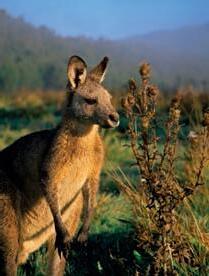
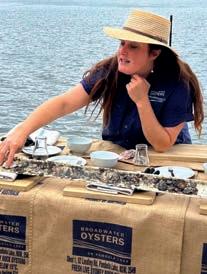


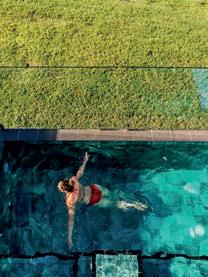
Alamy; Jessica Reid; Scott Stramyk
Cultural revival (clockwise from top left) The once struggling heritage town of Mogo is now home to a community of artists and craftspeople who run small businesses such as Mogo Pottery; wild kangaroos scatter the landscapes around Mogo; Mel Page of Broadwater Oysters educates visitors about the local oyster species and aquaculture; Bermagui Blue Pool is a beautiful ocean rock pool on the Sapphire Coast which – if you’re lucky – offers the odd glimpse of cavorting fur seals; Mogo’s Jaguar Stay has a collection of six luxury villas; best of all, each of Jaguar Stay’s private villas has its own plunge pool
champions at several seafood festivals across the South Coast, and Greg is able to open 250 dozen oysters in four hours. I still had some way to go to beat that, but I could see the value of what they were doing here.
“Being able to invite people to see working farms and learn how oysters are grown is a big part of the Sapphire Coast’s tale,” Mel told me. More than 100 million oysters are produced in New South Wales every year, and businesses like this are, for many small communities, the success story of the coast. For the growing number of travellers who just want to know where their food comes from, its tours also offer a way to connect with the area and to know that they’re helping put money in the pockets of local people.
“Mogo sprouted overnight after word spread that gold was found in nearby Cabbage Tree Creek”
the cultural landscape here forever, as entire towns were born on the whisper of a promise. One of these was Mogo,which sprouted practically overnight after word spread of a find in nearby CabbageTree Creek in 1857. Cottages, churches and shops were all constructed to support the new community.
I was curious to see how much of this history remained in Mogo’s streets after the devastating bushfires of 2020 that saw much of the original town reconstructed. As I wandered, I spied pointed rooftops and timber cladding similar to that of a traditional miner’s dwelling – only a fresh lick of paint here and there gave the game away. But this is no museum, and it was the more recent story of Mogo that made me want to stay longer.
Need to know
Following my shucking efforts, it was finally time to taste my first Sydney rock oyster. Topped with a squeeze of lemon, I tilted my head back and tipped the raw oyster into my mouth. Mel smiled as she watched me parse all the flavours.The taste was intense, creamy and slightly sweet, accompanied by a kick of salt from the estuary water. Even after just one, it was clear to me that I had discovered another jewel of the Sapphire Coast.
BEYOND THE GOLD RUSH
The northernmost point of this stretch of coast is the small town of Bermagui, an ideal spot for a dip in the shimmering ocean. From my vantage point, up on the cliffs, it was easy to see how the Sapphire Coast had got its name: the blue waters below sparkled like precious gems in the warm sun.
After descending the rugged cliffs, a beautiful seawater-filled rock pool revealed itself, inviting me to dive straight in. As I leant against the pool’s rocky walls, some unexpected visitors emerged from the water: a dozen or so Australian fur seals playing in the choppy waves. I thought back to Nathan and his calls to respect nature, and watched them cavort with both gratitude and glee.
The Sapphire Coast had given up its treasures freely so far, but my final stop, Mogo, lay just beyond its reach. I’d wanted to finish here because it unravels a chapter of New South Wales’ history that isn’t often talked about: its role in one of the biggest gold rushes in history, which saw the state’s population nearly double in just ten years.
Gold was first discovered in New South Wales in 1851, prompting prospectors from across Europe, the USA and China to flood into Australia in search of their fortunes.The communities formed in their wake changed
The town has had something of a rollercoaster ride since the last mine in the region closed here in the 1980s. For a period, it became a sad highway town that rarely saw a soul; however, over the past few decades it has experienced a revival, attracting artists, craft-makers and entrepreneurs, who run a throng of small businesses here. It’s still a tiny community – barely 350 people – but one that is home to charming galleries, jewellery studios, sweet shops and bookstores.
My accommodation, Jaguar Stay, was another example of how a local business can flourish from even a small stream of visitors. Based on a 65-hectare riverfront farm, its villa complex provides bicycles for guests, encouraging exploration of its farmland and the wider town in the gentlest way. On two wheels, it’s easy to see why you’d leave the twinkling Sapphire Coast behind for this.
Before I hit the tarmac and bid the region a fond farewell, I took a moment to soak up the serenity of nature that I’d discovered in abundance one last time. Dipping my feet into my own private plunge pool, I watched the surrounding pastures turn shades of ochre under the late summer sun.Then, as if on cue, I spotted something in the fields: a mob of kangaroos peacefully grazing on the grass in front of me. It was one final glittering find in an area whose treasures no longer lie underground.
My road trip along NSW’s South Coast had taken me from Aboriginal history to the industries that make its towns along the coast tick. I’d also seen how resilient communities could be, from the revitalised Mogo to the ongoing fight for recognition by the original custodians of this land.The Sapphire Coast might get its name from its glistening ocean, but it’s far from the only thing that sparkles in this unique region.


When to go
The NSW South Coast experiences a mild climate, making it suitable for exploring year-round. Spring (September to November) is when you can spot whales migrating along the coast. The author travelled in early autumn (March to May).


Getting there & around
Various airlines offer connecting flights between the UK and Sydney. Emirates (emirates.com) operates services from London Heathrow via Dubai with a total flight time of 22 hours 45 minutes. An economy class return ticket costs from £1,055; business class return from £5,665.
NSW’s South Coast is located between Sydney and Melbourne. It takes around six hours to drive from Sydney to Merimbula, the author’s starting point; flights are also available to Merimbula with local airlines, which take just over one hour from Sydney.
Sapphire Coast Buslines (scbuslines.com.au) operates regular services between most towns, including Merimbula, Pambula and Tathra, but hiring a car is the best way to explore the coastal region at your own pace.


Carbon offset
A return flight from London to Sydney via Dubai produces 2,185kg of carbon per passenger. Wanderlust encourages you to offset your travel footprint through a reputable provider. To find one, visit wanderlustmagazine.com/ inspiration/sustainable-travel.


Where to stay
Tathra Hotel (suites from £112pn; tathrahotel.com.au) is a traditional country house with ocean views and an in-house bistro. Jaguar Stay (from £229pn; jaguarstay.com) is a collection of six luxury villas complete with private plunge pools set on a riverfront farm in Mogo. It also provides guests with kayaks and bikes for exploring the area.
The author travelled with support from Destination New South Wales (visitnsw.com) and Emirates (emirates.com).
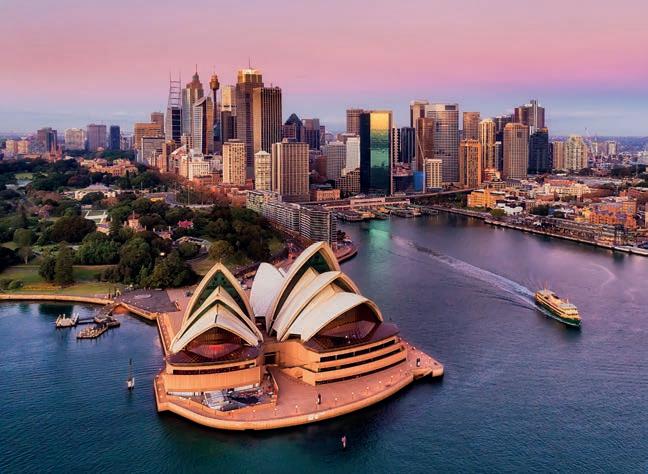
Authentic
AUSTRALIA
IMMERSE YOURSELF IN THE CULTURE OF AUSTRALIA ON ONE OF THESE BEHIND-THE-SCENES TOURS…
Discover authentic Australia, thanks to these incredible encounters which open up the country’s famous sporting, historical and cultural attractions and allow you to peer behind the scenes. Here are seven locations to savour with Cultural Attractions of Australia (CAOA)...
1HAVE A UNIQUE EXPERIENCE AT THE SYDNEY OPERA HOUSE
Go behind the scenes at this cultural icon with CAOA. Taste of Opera features a private recital woven into a tour, dinner or event. The Backstage Tour takes you behind the scenes to see the rehearsal space and the orchestra pit before breakfasting in the Green Room. Take the Architectural
Beneath the sails (this page; top to bottom) The instantly recognisable Sydney Opera House first opened its doors in 1973 and is now the busiest performing arts centre in Australia; with Cultural Attractions of Australia, you can pre-book exclusive tours that allow you to go behind the scenes at the Melbourne Cricket Ground with a guide
Tour to learn about architect Jørn Utzon’s vision for a building Frank Gehry declared “changed the image of an entire country”, or book the Midden Experience for a one hour tour before a two course meal at Midden by Mark Olive, one of Sydney’s best restaurants. Finally, end the day admiring the Badu Gili, the free, nightly lighting of the sails to celebrate Australia’s First Nations artists.
2LEARN MORE ABOUT THE MELBOURNE CRICKET GROUND
With a capacity of 100,024, Melbourne Cricket Ground is the largest stadium in the southern hemisphere, having been built in 1853, barely 15 years after the city was first established.
A VIP Premium Access Tour offers travellers a private guided visit that lets
you step onto the hallowed turf and visit the Australian Sports Museum. The new Keepers’ Collection Tour even includes a private walk of the archives with a museum team member, bringing the 60,000-strong collection to life.
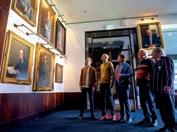
3BEHIND THE SCENES AT THE BANGARRA DANCE THEATRE
It’s a privilege to share an intimate window into the culture of the

Bangarra Dance Theatre, one of Australia’s leading performing arts companies. These professional Aboriginal and Torres Strait Islander performers thrill with dance techniques forged across 65,000 years.
The Behind the Scenes at Bangarra Dance Theatre experience opens with a personal Acknowledgement of Country and a traditional smoking ceremony, followed by Indigenous canapés and cocktails. Bangarra’s artistic director Frances Rings then takes guests on an exclusive tour of what makes the company so special by taking in the Bangarra rehearsal room, before you see the real thing on the stage at the Sydney Opera House.
4GO BACK IN TIME AT PORT ARTHUR
Some 40 hectares of gardens and grounds, alive with more than 30 historic buildings, ruins and museums, make up the UNESCO-listed Port Arthur Historic Site in Tasmania. This is Australia’s best-preserved convict settlement, having served for 40 years until its closure in 1877. Join the Wheel of Fate tour with a guide to hear tales of life in this prison settlement. After, enjoy a lunch of regional produce.
5
ENJOY AN EXCLUSIVE PRIVATE DINNER AT THE NATIONAL GALLERY OF VICTORIA
The National Gallery of Victoria (NGV) is the oldest, largest and most-visited public gallery in Australia. Enjoy the NGV Collection’s rich treasury of more than 76,000 works, across two architecturally designed venues –NGV International and The Ian Potter Centre: NGV Australia. Pharaoh, currently on display, is the largest exhibition of ancient Egyptian objects ever staged in Australia. With CAOA’s private tour, see highlights from the NGV Collection before dining in front of the NGV’s masterpiece, Giambattista Tiepolo’s The Banquet of Cleopatra.
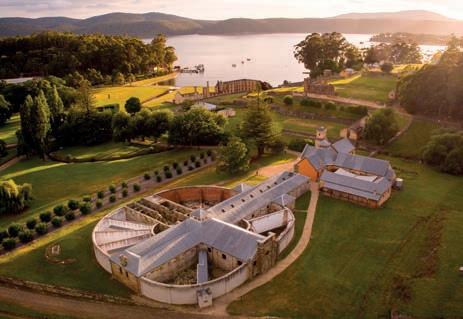
Backstage treats (this page; clockwise from top left) Bangarra Dance Theatre is one of Australia’s leading performing arts companies, and has been running for over 30 years; the Port Arthur penal settlement started as a small timber station in 1830 and is now a UNESCO-listed site; you arrive at the Museum of Old and New Art by ferry on the Mona Like a Rockstar tour; enjoy an exclusive dinner at the NGV
6
FIND RICH HISTORY ON A PRIVATE WALK OF THE NATIONAL MUSEUM OF AUSTRALIA
Australia’s purpose-built capital, Canberra, is a national treasure awash with iconic institutions, including Parliament House, the Australian War Memorial and the National Gallery. The National Museum of Australia is arguably its cultural crown jewel, and the exclusive CAOA Big Histories experience includes a private walking tour of the museum with a curator, who can show you highlights such as an early all-Australian-made Holden car. The tour ends with a seasonal lunch at the waterfront cafe.
7EXPERIENCE MONA LIKE A ROCKSTAR
The Museum of Old and New Art was conjured up by Tasmanian collector David Walsh within a winery in Hobart. Join the man behind the largest private museum in the Southern Hemisphere on CAOA’s Dinner with David, for a


chance to have a chat with its enigmatic creator.
Mona is also home to one of the largest collections of artworks by light artist James Turrell. The Full-On Turrell experience offers 24 hours of art and luxury, plus exclusive access to the artist’s works, as you stay on-site. Mona Like a Rockstar serves cocktails, great food and wines with rockstar executive chef Vinnie, plus exclusive entry to Turrell’s Event Horizon
ABOUT THE EXPERTS
Cultural Attractions of Australia offers a chance to pre-book more than 30 curated experiences designed for travellers looking for meaningful ways to engage with the country’s cultural, historic and sporting attractions. It’s the perfect way to immerse yourself in Australia’s rich cultural life.


up close Borneo
Despite occupying just a fraction of Malaysian Borneo, tiny Sabah’s ancient rainforest and endemic wildlife make it a living nature documentary of epic proportions
Words Lyn Hughes

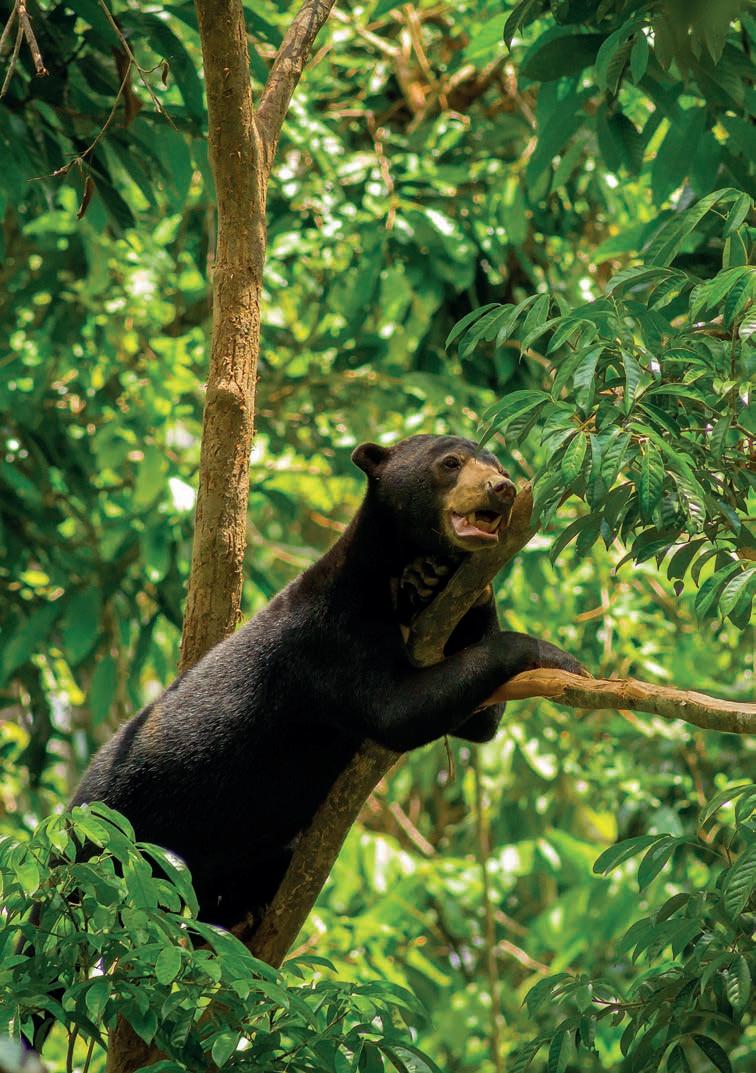

ÒOh, there’s an orangutan.” I’d been in Sabah, the jungle state in the far north of Malaysian Borneo, for less than two hours. It was barely 30 minutes since I’d checked in at my first hotel in Sepilok and there, in a tree facing my balcony, was a large and hairy ginger shape. In fact, there was another in the next tree along.The two wild orangutans were just going about their business, one casually sitting, the other pulling on branches and eating. It was an apt introduction to a destination where some of the wildest sights you could ever hope to see often linger just outside your bedroom.
I’d wanted to visit Borneo for decades, ever since I’d seen it on David Attenborough’s acclaimed documentaries, yet somehow it had never happened. I must admit that I’d been concerned whether I’d left it too late.Would Sabah still be full of the weird and wonderful wildlife that had caught my imagination back then? So, to have my first sighting of a critically endangered Borneo orangutan happen so fast felt serendipitous.
The rainforest facing the MY Nature Resort hotel was to yield more surprises,
as guests were invited to congregate just before 6pm to watch the resident red giant flying squirrels. As we munched on banana fritters, manager Edmundo explained that there is a species of giant cicada that starts singing at 6pm; this is the sign for the squirrels to emerge from their holes and nest boxes in the trees. But the cicadas were late that evening, and dusk was well and truly falling when they finally burst into a cacophony of sound.
previously been taken as babies for the pet trade, their mothers killed in the process. It was a joy to watch young orphans play and to know their futures were secured.
“The sun bear faces an added danger to its survival: the Chinese love of bear paw soup”
As if on cue, a red head popped gamely out of a nest box.The squirrel scampered up the tree to the top and then launched itself off into space, gliding effortlessly for around a hundred metres or so to another tree. A full moon was rising, and we all turned to each other and hugged, a little emotional at the magic of it all.
Sepilok is famous around the world for its Orangutan Rehabilitation Centre, which I visited the next morning. Established 60 years ago, it rescues orphaned, displaced and injured orangutans, some of which have
Across from the orangutan centre lies the lesser known Bornean Sun Bear Conservation Centre. Founder Dr Wong Siew Te showed me around, explaining how the plight of the sun bear, the world’s smallest species of bear (about the size of a large dog), was just as serious as that of the orangutan, but that their situation was simply not as widely known.
“Sun bears were not a priority species,” said Wong. “So, to change that, I had to do something myself.”The threats are much the same as for orangutans: a lack of habitat is taking its toll and poaching is a problem, with babies often taken for the pet trade. But they also face an added danger: the Chinese love of bear-paw soup. Just recently, a Chinese tourist had been caught offering a lot of money for someone to put on a banquet for them that included this soup.
The bear necessities (opposite page) The sun bear is the second rarest bear species, after the giant panda, and has a giant tongue (20–25cm) that helps it to extract honey from beehives; (this page) the endemic proboscis monkey is found in Borneo’s mangroves and alongside its rivers and estuaries, but deforestation has seen its numbers fall by 50% over the last 40 years; (previous spread) Sabah’s critically endangered orangutan is, for many people, the symbol of Borneo
The centre is home to over 40 bears, and seeing them up close was eye-opening. Some stood on their hind legs in that characteristic pose that makes them look like a child in a bear suit. But for all the good being done here, I still longed to get out in the wild.
THE PLAYBOY OF THE EASTERN WORLD
Between the two conservation centres and the nearby Rainforest Discovery Centre, I had already learned so much about Sabah’s wildlife.To see it for myself, out in the wilderness, it was time to visit the region’s longest river, Kinabatangan, a mecca for wildlife lovers.
My first lodge, Abai, was only accessible by water, and twice-daily excursions revealed crocodiles, otters, macaques and birdlife galore. I grew rather fond of the large and colourful stork-billed kingfishers, while another highlight was seeing a pair of rhinoceros hornbills.
I was particularly keen to see a certain primate I had glimpsed many times on nature documentaries, and which generally lives along rivers or on the coast. As we put-putted along the water, scanning the trees to the left and right of us, it wasn’t long
before guide Junior suddenly pointed with a triumphant cry of “There!”.
The male proboscis monkey perched languidly in the crook of a tree, sitting as a human might, one leg stretched straight along the branch, the other bent at the knee.With its huge nose, velvety-looking pantaloons and pot belly, it looked like a character in a medieval play.
“They’re known as the playboy of Borneo,” I’d been told, due to groups consisting of a large-nosed male with a harem of females. Or perhaps, I wondered, it’s because of the male’s bright-red penis, which is permanently erect. Less flatteringly, they are also called orang belanda (meaning Dutchman) because the locals saw a resemblance to the sunburnt Dutch colonists that used to live on the island.
The house was built on stilts overlooking the river, and the host’s grandchildren had arrived back from school and were playing along the riverbank.
“It is said that the river people never get attacked by crocodiles,” recounted Junior. “I’ve seen children splashing in the water here with a crocodile nearby and they were just left alone.”
“The river people never get attacked by crocodiles… I’ve even seen children splashing in the water with one nearby”
Back at Abai, I recalled that the resort was situated opposite an Indigenous river community, the Orang Sungai. I took a boat across to have lunch in one of their homes.
Moving further upriver, I stayed at another lodge, this time in the growing village of Sukau. I was initially flummoxed by the pleasant but loud sound of tweeting birds both day and night, then a Swiftlet House was pointed out to me on the opposite bank of the river. These man-made buildings are erected to attract swiftlets to nest in them; the goal is to harvest their edible nests, which are much prized by the Chinese. It appears to be a sustainable industry: the birds won’t return if their nests are taken before they raise a brood, and if it is done early enough in the


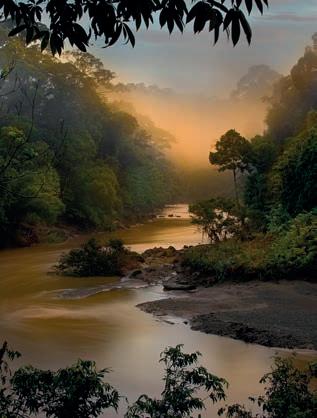
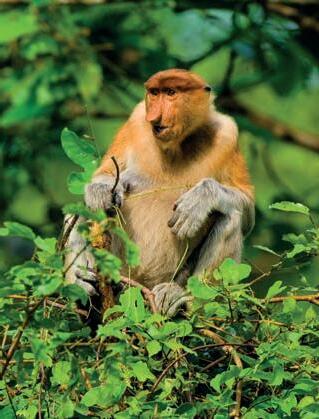

Up in the canopies (this page; clockwise from top left) Red giant flying squirrels can glide large distances, often breezing 100m between trees; as well as their impressive noses, proboscis monkeys have a unique digestive system that allows them to neutralise the toxins in a number of otherwise poisonous leaves; stork-billed kingfishers are one of the largest species of kingfisher and can be spotted along Sabah’s rivers; the rainforest in the Danum Valley is untouched and among the oldest rainforests in the world; (opposite page) some male orangutans develop flanges on the sides of their faces, which help to amplify their calls


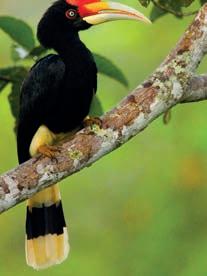


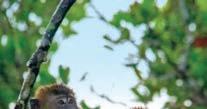
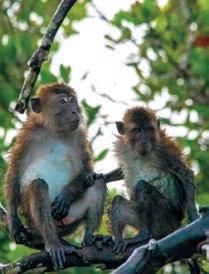
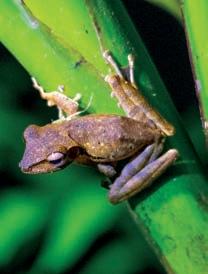

Great and small (this page; clockwise from top left) The rhinoceros hornbill is Malaysia’s state bird; both pig-tailed and long-tailed macaques live in large social groups and are commonly found along the Kinabatangan; an array of frogs and insects can be found at your feet in the forest; the Kinabatangan’s tributaries offer great wildlife spotting at the start and end of the day; the Bornean ground cuckoo has a sneeze-like call; the Borneo Rainforest Lodge’s manager, Calixtus Laudi, can smell wildlife before he spots it; (opposite page) Borneo’s pygmy elephants are confident in the water and often use their trunks like a snorkel
season, the birds have time to rebuild in order to lay their eggs.
From here we headed out in search of proboscis monkeys again, taking a boat into the Mananggul tributary of the Kinabatangan River. As we turned into it, undisturbed forest unfolded on every side.
Junior pointed to a now-abandoned lodge: “That’s where David Attenborough stayed when he was filming here.” It transpired that Junior had worked on several documentaries, initially as a porter on 1995’s The Private Life of Plants. “Sir David inspired me to think about nature; I’ve been 30 years now in nature guiding.”
We stopped next to see a family of pig-tailed macaques, which were sitting on a large patch of invasive water hyacinth, pulling out the roots to eat. It was like watching a soap opera as dozens of small dramas played out in front of us: some stole from their neighbours, others flirted, while the young ones, oblivious to it all, just played.
Boats from other lodges began crowding round, so we headed further along the river, passing under a rope bridge.
“That’s for the orangutans to cross,” explained Junior. “They can’t swim but they will use a bridge.”A little further on, we came across a group of proboscis monkeys. They were making their way resolutely through the trees on the riverside. Junior was checking his watch and looking in the distance because unlike orangutans, proboscis monkeys can swim.
“Just ahead is a crossing where most filmed sequences of proboscis monkeys jumping into the water are shot,” said Junior, “but it’s late in the day for them to do it.”
We sat and waited at a respectful distance with the engine off. “That’s the matriarch,” he nodded, gesturing to a large female.” She’ll decide whether they cross or not.”

“Borneo’s elephants are some 20% smaller than other Asian pachyderms”
Ever the optimist, I was scouring the banks when a shout went up from him: “In the river!” Up ahead, the pachyderm was swimming across the water in plain view, its trunk acting as a snorkel.We drew a bit closer, then turned off the engine and bobbed around, quietly watching. After a few minutes, it reached the opposite bank and clambered out, then was swallowed up by the dense vegetation. We burst into applause, as did the occupants of another boat which had been lucky enough to witness the sight.
why the guides at the lodge had been so excited at the news of a sighting.
However, I was to get an even closer look at Borneo’s largest mammal on my way into Deramakot Forest Reserve later that day. Driving along the gravel entrance road, which was with thick vegetation on each side, we came across large piles of dung. My new guide, Hamid, jumped out of the car.
“Elephant dung,” he announced excitedly. “And it’s fresh!”We drove a bit further on for safety reasons, then got out of the vehicle, our senses alert.
The cautious leader made her way to a tree right next to the known crossing point and seemed to ponder her next move for a moment. But then she turned away, the rest of the group following her. As even Attenborough must have found, not every encounter makes the showreel.
GHOSTS OF THE FOREST
The most surprising sight along the Kinabatangan appeared the next morning.We’d heard that a solo male elephant had been seen near the river the day before, but the odds were against us spotting it.As Junior said:“It will be like looking for a needle in a haystack.”
Borneo’s elephants are the biggest mammals found in these jungles, but as with the sun bears, they are also the littlest of their family, some 20% smaller than any other Asian pachyderm. Consequently, they are often known as pygmy elephants.
There is some debate as to whether they have descended from introduced elephants or whether, as DNA suggests, they are their own distinct subspecies. Certainly, it is not just their size that is different; they also have larger ears and longer tails, and are often described as “rounded”. Worryingly, they are now also considered severely endangered, and it is thought that their numbers may be as low as a thousand, with most of them found in Sabah. I now understood
We heard the crunch of branches breaking and the occasional trumpet and low rumble. They were so close now that we could even smell them. “They know we’re here,” said Hamid as we cautiously stood next to our 4WD, ready to make a getaway if needed.
For a few minutes, all we could see was the occasional sway of branches and bushes. But then a senior female came out of the forest on the other side of the road, took a curious look at us and presumably signalled to a few others that it was OK to cross.Three mature and three young elephants came slowly down the road towards us, ears flapping against the insects, then peeled off into the undergrowth, melting into the greenery to join the ones we could already hear.
The encounter was all the better for being completely unexpected. Perhaps even less expected was the curious drawing of a dancing man that I had spotted on the







Welcome to the jungle (this page; clockwise from top left) Mist hangs over the lowland dipterocarp rainforest after sunrise in the Danum Valley; it doesn’t have to be a big creature to catch your eye; Borneo’s pygmy elephants are the smallest of their kind and, when fully grown, stand less than 2.5m tall; opportunistic estuarine crocodiles lurk in the shallows; the endemic Sabah partridge is an elusive bird; tarsiers are shy and reclusive, though are sometimes spotted on night walks; flying foxes play a part in the regeneration of the forests by dispersing seeds from the fruit they eat; (opposite page) Borneo Rainforest Lodge at dusk
information board on the way into Deramakot Forest Reserve.
On a break from our wildlife watching, I asked Hamid what it meant; he explained that the figure was Michael Jackson. On seeing my puzzled look, he continued: “The people here believe in ghosts, and there have been cases of ghosts seen along the road. So the forest decided to add something to the sign. And, well, Michael Jackson…”
GOING GREEN
In just a few days I had been lucky enough to see all of Borneo’s ‘Big 5’ species: orangutan, proboscis monkey, pygmy elephant, rhinoceros hornbill and estuarine crocodile. Now, I was keen to seek out some of the lesser-known mammals.
Deramakot is a managed forest that practises what is known as ‘reduced impact logging’, ensuring that its wildlife still thrives. It is gathering a reputation as one of the best places to see Borneo’s array of nocturnal creatures, including the clouded leopard. I knew the odds of seeing one were not stacked in my favour – there is around a one-in-ten chance, if that – but I crossed my fingers in hope.
Each evening, I headed out on night drives willing one to appear.We saw several palm civets – long and slender animals that look like a cross between a mongoose and a cat –but none of the reserve’s actual five species of feline. One highlight was a tiny mouse deer, frozen in our vehicle’s headlights. It was so exquisite that it was hard to believe it was real. A daytime drive also produced one very rare sighting: a binturong, sometimes called a bearcat (though also not a cat), snoozing in a tree. It is the largest of the civets found here, and apparently has a scent similar to popcorn; sadly, it was too high up to get a whiff.
There was a drive of several hours to my next stop, Utan Rainforest Lodge. It was a rather dispiriting journey, as we passed endless oil palm plantations.Throughout my trip, guides, conservationists and other locals had brought up the subject of oil palms without me asking, and my driver on this occasion was no exception, telling me how he used to work on one but he much preferred being a driver. Like everyone I spoke to, he stressed that no more forest is being lost to palm oil, though his concern was more for the economic risk of relying on a monoculture than its environmental impact.
“There is so much competition now from other countries that the price will drop. And what if they get a disease?” he fretted.
At the Rainforest Discovery Centre in Sepilok, I had been told that the plantations were built on land that was already deforested. This was echoed by Silvia Alsisto, the district manager for Kinabatangan at the Sabah
Where to stay
Borneo Rainforest Lodge, Danum Valley
For sustainable luxury in pristine rainforest, you won’t find better than this. Celebrating its 30th anniversary in 2024, this is probably the best place in Sabah to see wild orangutans, with 65 known individuals found in the vicinity of the lodge. Guided walks are in groups of six to eight people, but private guides can be hired and customised itineraries arranged. Best for: Orangutans, red leaf monkeys, hornbills, colugos and a chance of seeing elephants. danumvalley.rainforestlodge.com
MY Nature Resort, Sepilok, Sandakan
This is the ideal first stop in Sabah, as it’s conveniently located near the Sepilok Orangutan Rehabilitation Centre, Sun Bear Conservation Centre and the Rainforest Discovery Centre. It backs onto the Kabili-Sepilok Forest Reserve, where you can watch out for orangutans in the trees. There is a boardwalk through the forest, and on most evenings you can see red giant flying squirrels glide between the trees. Best for: Flying squirrels and visiting Sepilok’s numerous attractions. sitoursborneo.com/web
Abai Jungle Lodge, Kinabatangan
This riverside lodge connects to Kinabatangan Wildlife Reserve and is only accessible by water. Its 24 rooms are scattered along a boardwalk that extends through the forest and includes watchtowers. A male orangutan called Sam sometimes hangs out behind the property. Best for: Proboscis monkeys, macaques, orangutans, crocodiles, kingfishers, hornbills, otters and a chance of spotting elephants. sitoursborneo.com/web
Kinabatangan Riverside Lodge, Sukau
Sister to the Abai Jungle Lodge, this stay has a prime location in the growing tourist village of Sukau. Sprawled along the riverfront, it has multiple decking and viewing areas, a small pool and beautiful flowering plants that attract butterflies. Best for: Proboscis monkeys, hornbills crocodiles and kingfishers. There is a chance of seeing elephants and orangutans. sitoursborneo.com/web
Deramakot Tourist Chalets
Expect basic accommodation and facilities, but that’s not what you come here for. The Deramakot Forest Reserve is renowned for its nocturnal wildlife, including sightings of the clouded leopard. Drives are along the road through the reserve, which some wildlife also use for travelling. Best for: Various cats. You have a chance of seeing a Sunda clouded leopard, and a higher chance of spying a leopard cat. Civets, Thomson’s flying squirrels and elephants are a possibility. To book, make a pre-arrangement with a tour operator..
Utan Rainforest Lodge
This new and intimate lodge is tucked away on the edge of Sungai Kapur Forest Reserve, adjacent to Tabin Wildlife Reserve and close to the palm oil plantations, making it a great spot for seeing leopard cats and civets. There are a couple of bird hides and a camera trap. A nearby jetty also gives access by boat to the river, estuary and ocean.
Best for: Leopard cats, civets, owls and flying foxes. Rare endemic birds such as the Sabah partridge and Bornean ground cuckoo can be spotted. There is a chance of seeing Irrawaddy dolphins, proboscis monkeys and orangutans. utan.my

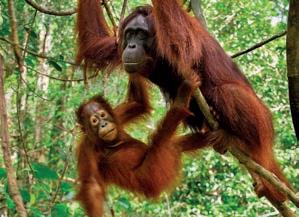

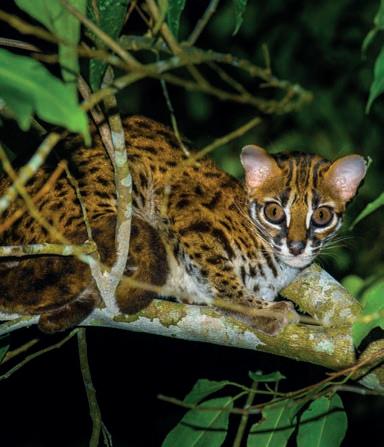
Wildlife Department, who explained:“If you go back 50 or 60 years, there was logging, then coffee and rubber estates. It’s those former estates that are now growing palm oil.”
The best news is that the protection of Sabah’s forests is now part of government policy, with a cap having been put on the total area of palm oil plantations since 2019, while Malaysia is one of more than 100 countries to have pledged to halt deforestation by 2030.
The situation is also more complex than it first appears, as Junior was eager to explain to me: “If everyone boycotted palm oil, people would lose their jobs and go back to hunting.” I thought of my weekly grocery shop and how I avoided anything with it in.
tions and communities was about reducing animal-human conflict. “We Malaysians care about our wildlife, so it’s about finding solutions that work for everyone.”
RIGHT PLACE, RIGHT TIME
“I discovered that the fringes of the plantations were great places to spot certain wildlife”
One positive thing that I discovered was how the fringes of the plantations were great places to spot certain wildlife. Utan Rainforest Lodge had only just opened and was situated where a plantation meets the rainforest. A night drive produced a leopard cat sighting within five minutes, and then another and another.
White in colour, it seemed to be sniffing the air with its long snout before scurrying off. Moonrats are said to exude a peculiar and pungent smell – something similar to burnt coffee. I sniffed the air expectantly but can’t pretend that I smelled anything other than the usual rich and earthy forest smells typical of the sultry nights here.
Silvia stressed: “The important thing now is to ensure palm oil is produced sustainably and without harming wildlife.” She told me about the Malaysian Sustainable Palm Oil (MSPO) Certification Scheme and how a lot of her own work with planta-
The size of a large domestic cat, these creatures are omnivorous and highly effective at controlling rats in the plantations.
A nocturnal walk the following evening produced another new spot: a moonrat. Technically not a rat at all, it is actually related to the hedgehog, and did indeed look like one – except with fur instead of spines.
The lodge lies near to the mouth of the Segama River. We explored its mangroves, estuary and quiet backwaters by boat, sometimes passing a community of Sama Bajau, also known as ‘Sea Nomads’, but otherwise seeing no other people. Neither was there any sign of the Irrawaddy dolphins sometimes spotted here, though we enjoyed sightings of flying foxes.The night’s journey also turned into a natural light show: trees twinkled with fireflies in the dark, the sky overhead was heavy with stars and bioluminescence streaked the water in our wake.
After experiencing a range of habitats, it was now time to encounter truly ancient rainforest. Borneo Rainforest Lodge is located in the heart of Danum Valley Conservation Area, one of the most pristine places in Borneo and home to virgin
Just a glimpse (this page; clockwise from top left) The relationship between mother and baby orangutans is one of the closest in the animal world; leopard cats are one of five species of wild cat found in Sabah, though they are typically only seen at night; palm oil plantations dominate the landscape away from the protected areas; (opposite page; top to bottom) flying foxes are one of the largest types of bat; red leaf monkeys are highly acrobatic when in the trees
rainforest that is 130 million years old.The Lodge has only been here 30 years, but the orangutans within the vicinity have been studied extensively. A wall in the reception area displays their mugshots and details as if they were famous. Nevertheless, I still wasn’t prepared for the opening few minutes of my first guided walk there to be so eventful.
My guide Calixtus paused on the boardwalk, raising a hand, so I stopped too.
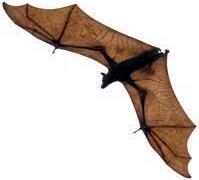
“I can smell them,” he said.
I was puzzled: ”Smell what?” He stepped off the boardwalk and slowly walked along while scanning the trees.
“Orangutans; there,” he pointed up into the adjoining fig trees where two ginger shapes were languidly moving.“That’s Kate,” said Calixtus,“named after Kate Middleton; the other is a young male called Kai.They go around together but are just friends.”
Over the next couple of days, I was to have several more orangutan sightings, and realised with a shock that I could now recognise their smell before I saw them too. But there was so much more to see here. Just as memorable was my immersion in the rainforest, senses alive to every movement, sound and scent. My face dripped with the humidity, and leech socks were tied around my calves, yet it was exhilarating to walk among the trees – some true giants – while following the tracks of pygmy elephants, or freezing still when watching a secretive argus pheasant, or peering into leaves to admire tiny frogs.
On one walk, we came across a troop of red leaf monkeys racing though the trees and occasionally scampering across the forest floor.They had reddish-ginger coats, fluffy heads and dark faces, and their acrobatic feats had us mesmerised until they eventually moved on and out of sight. It really was like being in the Attenborough documentaries I had watched as a teenager. All it needed was that familiar voiceover.
Yes, the wildlife and ecosystem here does face challenges, but enough people care about both – and ecotourism plays its part, too – that I left with hope for the future. More than anything, I felt privileged to have experienced somewhere so special in real life rather than on a TV screen.

Need to know


When to go
Dry season (it still rains) is mid February to October. Peak season is June to September, when lodges can get full, so between March and May is a good time to avoid the crowds. Rainy season is from November until early February, but Sabah is still very visitable and you’ll benefit from low-season prices.
Visa: British nationals don’t require a visa for stays of up to 90 days.


Health & Safety
Watch out for thieving macaques! Never feed them, and don’t leave any items outside your room. Some lodges leave sticks in your room to ward them off. Malaria is present but very low risk. Leeches can be a pain but aren’t harmful (see ‘What to take’).


Getting there & around
There are no direct flights from the UK to Sabah. Malaysia Airlines (malaysiaairlines.com) fly via Kuala Lumpur to Sandakan (the nearest airport to Sepilok) and Kota Kinabalu from London Heathrow from about £864 return, taking 18 hours. Lahad Datu is the closest airport to the Danum Valley and Tabin, and it also has flights to Kota Kinabalu.
Note that many roads are in poor condition, and some lodges can only be reached by water or unsealed gravel roads.


Carbon offset
A return flight from London to Sandakan produces 1,334kg of carbon per passenger. Wanderlust encourages you to offset your travel footprint through a reputable provider. For advice on how to find one, visit wanderlustmagazine.com/ inspiration/sustainable-travel.


Currency & visa
Currency: Malaysian ringgit (MYR), currently around MYR6 to the UK£.


What to take
Bring a lightweight waterproof jacket (or rain poncho), long trousers and shirts. Walking is mostly on boardwalks, which can be slippery, so take walking boots or shoes with good grips. Binoculars are a must, though some lodges will provide them. If you’re doing forest walks, then leech socks are a good idea (again, some lodges will provide). And don’t forget bug repellent and sun protection
The Trip
The author travelled with Wildlife Worldwide on a tailor-made trip (wildlifeworldwide.com). The company runs a Borneo’s Orangutans tour, which includes stays at MY Nature Resort, Kinabatangan Riverside Lodge and Borneo Rainforest Lodge, from £5,170pp, including international flights. A 12-night Borneo’s Rare Mammals tour, which includes a week at Deramakot Forest Reserve, costs from £4,295pp, including flights.
Kota Kinabalu
Experience the essence of
UZBEKISTAN
From ancient Silk Road heritage to traditional festivals, mesmerising architecture to comforting homecooked cuisine, Uzbekistan is the ultimate cultural adventure

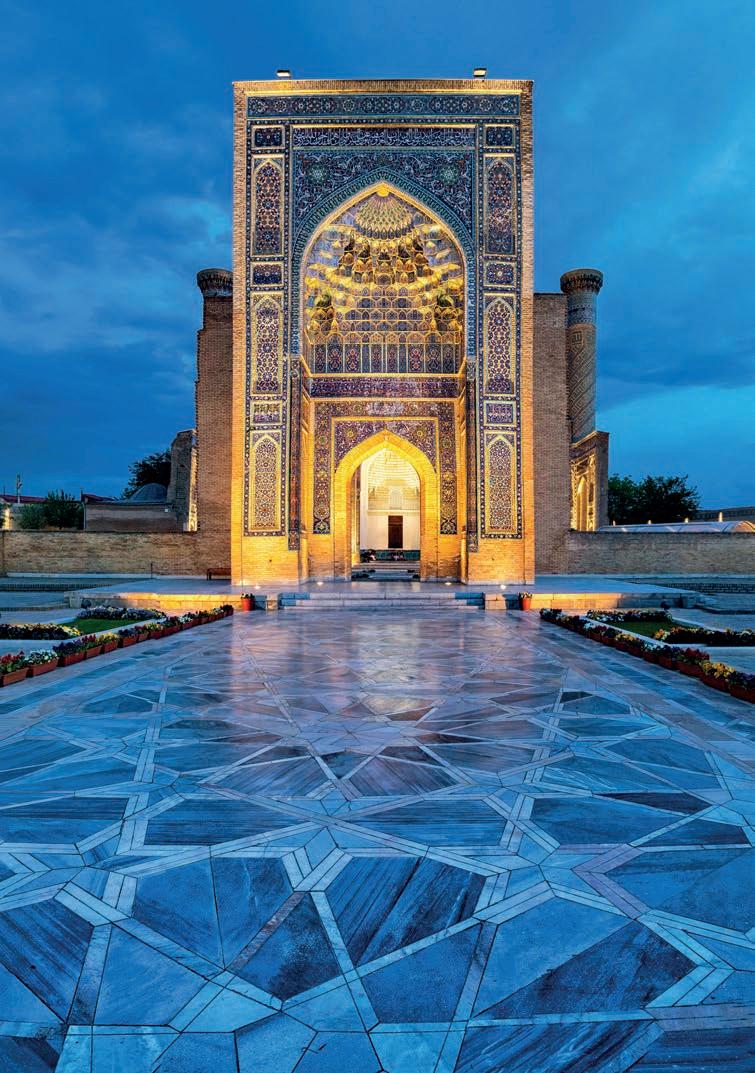

Uzbekistan is the heart of the Silk Road, culturally and geographically. This vibrant Central Asian republic is blessed with a wealth of attractions, including dazzling UNESCO-listed monuments, archaeological sites and idyllic mountain lakes. Travelling by highspeed train, you’ll follow the same desert routes the old caravans did, but the surprising thing about cities such as Samarkand and Bukhara is how they blend the rich cultural heritage of the past with modern life.
SILK ROAD HERITAGE
Uzbekistan lies at the epicentre of a web of ancient intercontinental trading routes known as the Silk Road. Caravans of merchants, their horses, camels and goods, journeyed between the oasis cities. Wealth made in the bazaars was invested in magnificent buildings, in infrastructure, culture and education. It was a golden age.
To understand the ancient history of Uzbekistan, start with the archaeological sites and museums that help interpret them. The 50-plus Desert Fortresses of Ancient Khorezm pair well with the Savitsky Museum in Nukus; the Archaeological Museum in Termez helps bring to life the Buddhist monasteries of Fayaz
Tepe and Kara Tepe; and at the Afrosiyob Museum you can see the remarkable wall paintings excavated from the Sogdian city of Afrosiyob, the predecessor to Samarkand. Uzbekistan’s monuments, encrusted with glazed ceramic tiles, are as impressive as when they were built centuries ago, with Samarkand’s Registan a high example of this style. But don’t miss the 15th-century Ulugbek Observatory too, built by the astronomer-king, nor the Gur-i Amir with its interior of jade and gold.
COMFORTING LOCAL CUISINE
Uzbekistanis often talk of 365 days of sunshine, and such weather blesses them with an abundance of agricultural produce. Orchards are
Sights to behold (left page) The entrance to the Gur-i-Amir in Samarkand; (this page; clockwise from top left) Ayaz Kala, a hilltop fort in Kyzylkum desert; admire wall paintings at the Afrosiyob Museum in Samarkand; the striking walls of the ancient city of Khiva; the excavated caves at the Kara Tepe archaeological site date back to between the 1st and 4th centuries; don’t miss the intricate Ulugbek Observatory in Samarkand



weighed down with apples, apricots and cherries, and strawberries and raspberries are piled into pyramids waist high. Nothing beats the taste of freshly squeezed pomegranate juice, and the sweetness of winter melons is discussed in reverential tones.
Many of the foods you’ll find in Uzbekistan reflect the country’s Silk Road heritage. The national dish, plov (pilaf), has UNESCO Intangible Cultural Heritage status, and every region, every family, has a recipe they’ll swear is the best. In cafés and at street-food stalls you can feast on somsa, hot pastries stuffed with diced meat or pumpkin, and shashlik, fragrant, juicy kebabs sizzled on the grill.
The local dining scene is booming, with new restaurants opening almost every week.

Alamy; Shutterstock


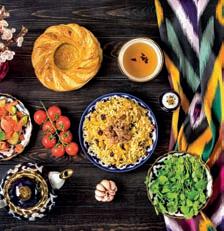
In Shakhrisabz and Samarkand, you can eat in converted caravanserais, and in Bukhara, the best-located tables are typically found outdoors in Lyabi Hauz. Chefs such as Bahriddin Chustiy experiment with contemporary variations of traditional recipes, served in stylish surroundings.
TRADITIONAL CRAFTS
Amir Timur brought the world’s greatest architects and artisans to Samarkand to build his grand capital city. Their mastery of many different crafts is evident today in the UNESCO-listed monuments they left behind, and their descendants continue their creative work.
In Tashkent, the State Museum of Applied Arts offers a good introduction to Uzbekistan’s intangible cultural heritage, in particular its textiles, wood carving and ceramics. But the best place to learn about these crafts is direct from the artisans themselves, so plan to include plenty of workshop visits in your trip.
Margilan is Uzbekistan’s centre for silk production, and local people continue to raise silkworms as well as spin, dye and weave silk; Gijduvan and Rishtan have their own distinctive styles of ceramics; and for carpet making, pop into the Khiva Silk Carpet Workshop, which is the subject of the excellent book A Carpet Ride to Khiva
You’ll want to leave plenty of space in your suitcase for shopping. The vintage and modern textiles pack well, and though they are fragile, hand-painted tea bowls are inexpensive yet beautiful gifts.
INTRICATE ARCHITECTURE
Uzbekistan’s magnificent architecture is its calling card, and no matter how many marvellous mosques, madrasahs, and mausoleums you see, there will always be plenty more. Most of these monuments, many of which are protected as UNESCO World Heritage sites, date from between the 10th and 18th centuries, and Uzbekistan is investing in longterm conservation plans.
If you only visit one city, make sure it’s Samarkand. The Registan is Uzbekistan’s answer to the Eiffel Tower or the Taj Mahal, but is more colourful. Nearby is the Bibi Khanym Mosque, built by Amir Timur, and the Shah-i Zinda royal necropolis, which has the best tilework found anywhere on the Silk Road.
The historic centres of Bukhara and Khiva are more compact, and are well preserved. Here, secular and religious architecture mingles freely: Bukhara’s Ark Fortress is only a stone’s throw away from the Kalyan Mosque and Miri Arab Madrasah; and in the open-air museum of Khiva, you can wander easily from the Tash Hauli Palace to the Juma Mosque, then climb the ancient city walls.
VIBRANT CULTURE
Flavours to savour (this page; clockwise from top) The Kalyan Mosque in Bukhara is a staple landmark in the city; national dish plov (pilaf) holds UNESCO Intangible Cultural Heritage status; Uzbek cuisine’s rich flavours gain their powers from the country’s abundant orchards and locally grown produce
Uzbekistan’s intangible cultural heritage is continually evolving, and the best way to appreciate it is with a live performance. Local traditions such as storytelling, poetry, and dance often have UNESCO status, but although the performers are proud protectors of the historical legacies they have inherited, they continue to innovate both in their styles and in their choice of performance venues.
There are plenty of opportunities to immerse yourself in local culture during your visit to Uzbekistan. The El Merosi Theatre of Historical Costume in Samarkand has nightly performances, as does the dance troupe that performs inside the courtyard of Bukhara’s Divan-Begi Madrasah. Out and about in Khiva’s Ichan Kala, you might well meet
members of the local puppet theatre, as they often wander the streets, enthusiastically accosting visitors with their almost life-size marionettes.
The quality of ballet and opera at the Navoi Theatre in Tashkent is superb, with both domestic and international companies performing popular works on the stage. There are also plenty of regional theatres, concert halls and stadiums where tickets are always reasonably priced.
ABUNDANT NATURAL LANDSCAPES
Uzbekistan’s natural wonders are often overlooked in favour of its cities and cultural sites, but those who take the time to explore rural areas and wildernesses are richly rewarded. The diversity of Uzbekistan’s landscapes is remarkable, and each unique habitat supports a different array of flora and fauna, including many rare species.
One of the easiest natural attractions to reach is the UgamChatkal Natural National Park in Tashkent Region. It is part of the Western Tien Shan range, a UNESCO World Heritage site in its own right, and encompasses mountains and canyons, lakes and rivers, which are best enjoyed from one of the many hiking trails. Whitewater rafting here is also possible, but challenging, as is backcountry skiing.
The Nuratau Mountains are developing as an ecotourism hotspot, with wonderful opportunities for community-based tourism. Hiking


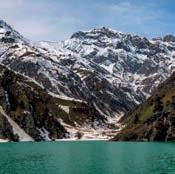

from village to village, you can combine the pre-Islamic shrines and the petroglyphs of Sarmyshsay Gorge with birding, picnicking, and swimming in the pools below waterfalls. Staying in a village such as Sentob, you’ll be treated to warm local hospitality and fresh produce straight from the garden.
LOCAL FESTIVALS
There are multiple festivals throughout the year in Uzbekistan,
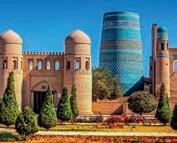

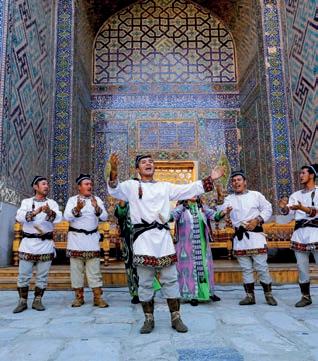
Natural flare (this page; clockwise from top left) Uzbekistan is home to turquoise alpine lakes; singing and dancing are important elements of Uzbek culture; Ichan Kala is the colourful inner town of the old Khiva oasis; the gidjak, a stringed instrument played with a bow, is the national instrument of Uzbekistan; Samarkand’s Bibi Khanym Mosque was built by Amir Timur; Uzbekistan’s expertly honed artisan crafts include textiles, wood carving and ceramics; sunset views in the wilds of Uzbekistan
showcasing everything from the traditional Khorezmian dance form lazgi to jazz; family-friendly puppetry to the latest electronic beats. Some of these events are tied to specific occasions, such as Navruz (Persian New Year; 21 March) or Independence Day (1 September), but for others you’ll need to keep an ear out for local announcements. Often, events are organised at the last minute, so keep a degree of flexibility in your schedule and be prepared to party on the spur of the moment!
One of the quirkiest but most popular annual events is Stihia Festival, which takes place in Moynaq, a former port city on the Aral Sea. Deep in the desert, it is often described as Central Asia’s answer to Burning Man, but this does it a disservice: Stihia is as much about environmental stewardship and awareness-raising as it is about the DJs and other electronic music artists who get the dynamic, young audience jumping. The juxtaposition of music stages, sunset over the sands, and rusting ‘skeleton’ ships is quite something.



THE HEALING POWER OF PLANTS
The Cayman Islands grows lush with traditional botanics. Special features editor Rosie Fitzgerald speaks to Hannah Reid Ford (aka Bush Girl Medicine) about how visitors can get back to nature in the islands…

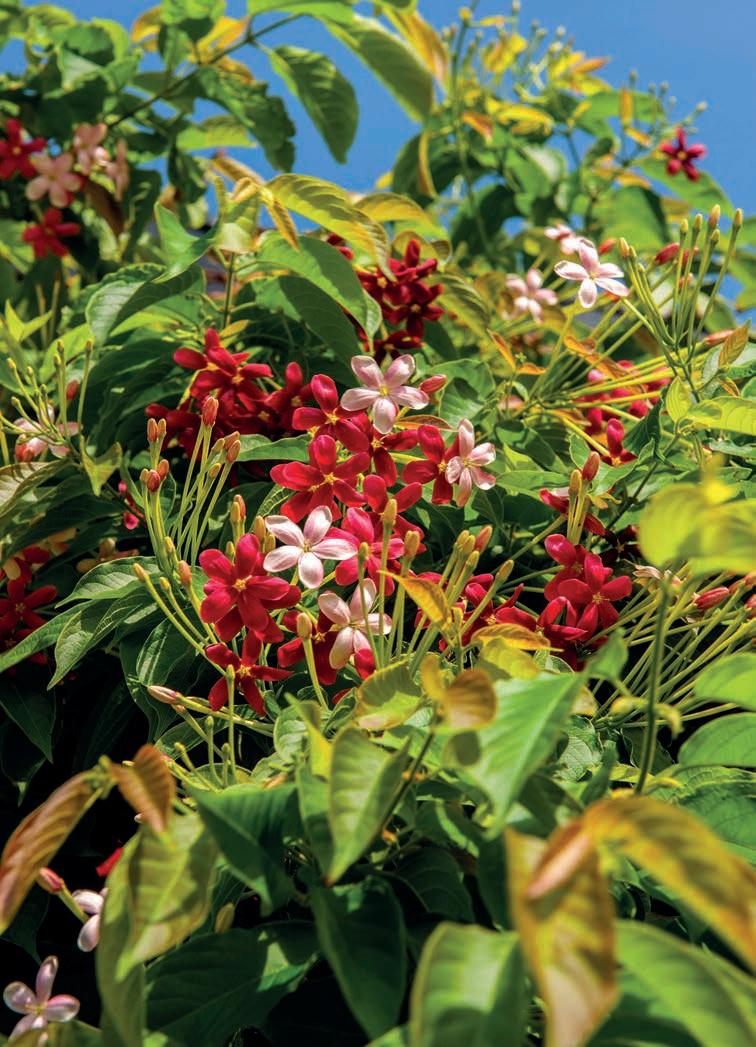

What inspired you to start your blog, Bush Girl Medicine?
I really learned about the islands’ plants from my mum. She was a big inspiration for me. I have always been interested in local plants, particularly native and endemic species. I started to get especially interested in the cultural uses of plants that would have sustained my own ancestors and previous generations of Caymanians. I also wanted to introduce people to flora they wouldn’t normally see in their everyday life, as some of our species are incredibly rare and unassuming.
How would you define bush medicine?
Part of the isolation and the remoteness of Cayman in the early days meant if something went wrong, you had to be able to fix it yourself, and that included your health. Bush medicine is about being able to utilise specific plants, herbs, fruits and flowers to heal ailments, and in those early days in Cayman, this was an important part of maintaining health.
Caymaninan culture developed in close relationship with the natural environment because early Caymanians didn’t have access to many imported goods. There had to be a relationship with the land and sea in order to survive. When looking at plants and bush medicine, it’s interesting to consider the common names, rather than the scientific ones. These common names can change from district to district in Cayman and often contain important cultural information about what those plants were used for. We have a plant called headache bush that was used to treat headaches, and another called fever grass that was used for fevers; worry vine was used to calm anxiety
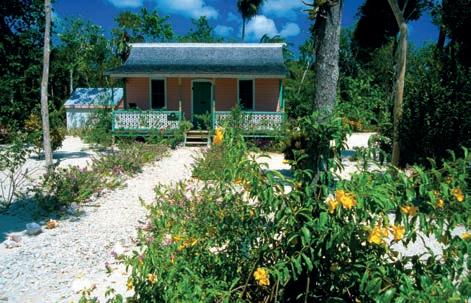
and heart bush was used to fix heart issues. What would have happened around a traditional Cayman cottage is there would have been fruit trees in the yard, some beautiful flowers for aesthetic purposes and also a medicinal part of the garden, so the remedies were close by if you needed them.
How can visitors learn more about these traditional botanics for themselves?
The Queen Elizabeth II Botanic Park has a heritage garden with a traditional Cayman cottage showing the typical layout of a Caymanian home, including a medicinal garden section. Over at the Farmers’ Market on Grand Cayman, you will find vendors selling medicinal herbs as well as fresh local produce. Also, the Teatime in Cayman company
Nature’s bounty (opposite page)
The Queen Elizabeth II Botanic Park covers 26 hectares of Grand Cayman; (this page; clockwise from top) Hannah Reid Ford, the founder of Bush Girl Medicine, was born and raised in the Cayman Islands; the botanic garden has an example of a traditional cottage where you can see what grows in the medicine garden; spot the likes of endemic century plants (Agave caymanensis) in Little Cayman
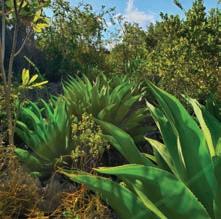
5 must-sees in the Queen Elizabeth II Botanic Park
1
The Floral Garden
This garden is organised by colour tones. The Blue Garden is the largest, with blooms in shades of blue, purple and lavender.
2
Orchid Boardwalk
Stroll along this boardwalk to see some of the island’s wild orchids, including endemic species. In May and June you can see the Caymans’ national flower, the wild banana orchid.
3 Xerophytic Garden
Cactus, succulents and other drought-tolerant plants flourish here.
4 The Heritage Garden
Imagine yourself back in the Caymans of yesteryear in this garden centred around a turn-ofthe-century cottage from Grand Cayman’s East End. Healing plants grow along with tropical fruit and the national tree, the silver thatch palm.
5 Woodland Trail
At nearly 2km long, this path traverses swampy and dry areas. Spy the rare cockspur tree and bull thatch palms.
Alamy; Hannah Reid Ford
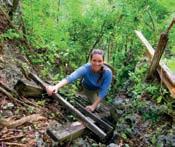
brews teas with blends inspired by local botanicals. Pedro St James is a historic site where you can learn about how early Caymanians lived.
How do you think Cayman will surprise visitors?
A lot of people see those glossy images of Seven Mile Beach, but once you go off the beaten track it’s a completely different place. In the interior of Grand Cayman, little Cayman and Brac, you’re faced with a terrain of tangled, thick undergrowth
Islands of surprises
Travel writer Rachel Truman shares her impressions of Cayman with us…
“Iguanas bake in the sun, stingrays swoop around shallow sandbars and wild chickens strut around colourful stilted houses with gardens where trees hang heavy with guavas and naseberries. I follow trails through old-growth forests where butterflies flutter and lizards scutter. I hear tales of the shipwrecks that lie scattered offshore from local fishermen resting in the shade of bentdouble palm trees. I nibble scotch-bonnet spiked conch fritters with my feet in the sand on the North Shore and wash down blackened snapper with ice-cold Caybrew at a rustic beach shack. It’s a world away from Seven Mile Beach’s sleek hotels. Over on Little Cayman, my days are spent pedalling around the teeny, flat isle, dodging dozy iguanas (who outnumber islanders) and swimming in bath-warm waters where spectacular walls and coral reefs lie close to shore.”
and canopies where you will hear parrots flying overhead and see land crabs in the undergrowth.
Where can visitors see Cayman’s more natural side for themselves?
The botanic park is one of the more accessible options for getting a glimpse of that wild Cayman. Its Woodland Trail leads you through a variety of terrains but is very flat and easy to walk. Another accessible option here is the Orchid Boardwalk. In May and June, the orchids are out in full force and you can see the Cayman national flower, the endemic wild banana orchid.
The National Trust has the Mastic Trail in Grand Cayman, an historic walking path originally used to connect the northern side of the island with the southern side of the island before the roads were built. It’s an incredible option for its variety of landscapes, from mangrove wetlands to rocky, dry forests and everything in between.
Little Cayman also has a nature trail maintained by the National Trust, with a boardwalk displaying the coastal shrubland environment where rock iguanas nest. Cayman Brac is just a nature lover’s paradise with well-

Wildlife wonders (this page; clockwise from top left) A historic ladder leads up the face of the Bluff on Cayman Brac; the Caymans are home to a variety of birds, including the Cuban parrot; Grand Cayman’s endemic blue iguanas can grow up to a metre-anda-half long
maintained trails, a parrot reserve and lots of caves and sinkholes.
How can visitors immerse themselves in the Cayman Islands’ culture?
The Cayman Collection Centre is a newly opened facility displaying our tangible cultural history. There’s lots of cultural artefacts there that haven’t been displayed before. I would also really encourage people to check out the National Gallery. It’s a visual art museum, but it’s so much more than that; it has poetry slam nights,
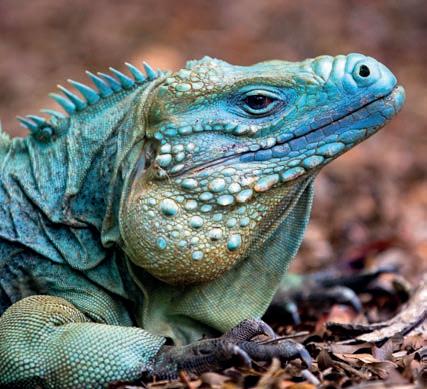
Alamy; Hannah Reid Ford
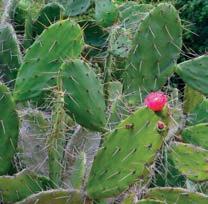

immersive exhibits and lots of work done within the local community. It also hosts travelling exhibits on the sister islands and is a great place to experience the artistic expression of the Cayman’s cultural identity.
As well as writing your blog, you also work in the Ministry of Sustainability and Climate Resiliency. How can visitors ensure their trip is sustainable?
Anyone travelling to Cayman automatically supports our natural environment by paying a fee which goes straight into our Environment Protection Fund, a key resource for preserving land in Cayman.
Be sure to visit places that are off the beaten path. The Cayman Islands National Attractions Authority has good information on these lesserknown spots. Make sure you visit the sister islands; there is so much hidden history there waiting to be explored, as well as incredible diving, hiking and a very different pace of life.
And of course, bring your own water bottle – the water in Cayman is fine to drink – and bring a reusable shopping bag.
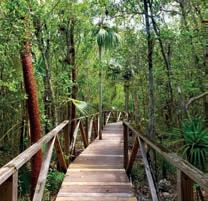

What is your favourite thing to do in Cayman?
To walk nature trails such as the Mastic Trail, as well as the trails on the other islands, is a wonderful way to spend your time, because they really give an insight into a natural world we still know so little about. Collectively, the 14 UK Overseas Territories contain 90% of the UK’s biodiversity, and a recent study has predicted that there may be as many as 70,000 new species to be discovered. People think because these islands are so small, we must have seen everything, but just two years ago I was involved in the discovery of new plants in the Cayman Islands.
My advice is to walk those trails with a guide from the National Trust, or to have an expert guided tour at the botanic park and to seek out a different perspective on what you’re seeing. It may look like a bunch of green bush, but when you start to really look at what these individual plants are, then you get an understanding of the cultural connections between Caymanians and nature, and can delve into a completely different side of our beautiful islands.
Hit the nature trails
Mastic Trail
Go with a naturalist guide to get the most from this hiking trail that strikes a route north from near Bodden Town through the Mastic Reserve. This preserved patch is one of the last remaining examples of the Caribbean’s subtropical, semi deciduous dry forest. At just over 3km, the trail is flat but surprisingly challenging. As you pass through dry forests and swampy mangroves, guides will point out various trees, including the rare mastic that once flourished here, flowers and many birds. Lizards, snakes, tree frogs and hermit crabs are also likely sightings.
Barker’s National Park
Take a walk on the wild side (this page; clockwise from top left) See an array of cacti in the botanic park’s Xerophytic Garden; the Orchid Boardwalk in the botanic park makes nature accessible to more people; the botanic park’s Woodland Trail is just under 2km long but is home to 40% of Grand Cayman’s native flora; walk out into nature with a local guide and you can learn more about not just the islands’ plant life, but also the other species that thrive here
For a quiet and wilder beach experience, make for Barker’s National Park. On the tip of the West Bay, this secluded area is accessed by a long and bumpy dirt road. Enjoy a peaceful wander around the shoreline’s mangroves followed by a solitary snorkel. Native sea grape trees grow along the shores, where you can also enjoy a picnic –there are no facilities here, but it’s all the more special for it.
Colliers
Wilderness Reserve
Head to Grand Cayman’s undeveloped East End to get a feel for traditional Caymanian life and see its rare endemic blue iguanas. Colliers Wilderness Reserve was established in the eastern region’s wild interior by The National Trust. The shrubland forest habitat is the ideal environment for the reptiles, who are released here as part of ongoing conservation efforts. An easy-going nature trail twists through the reserve where you may well spot iguanas as well as birds and butterflies.



The land of the
Wild
While many explore the Pacific Northwest as part of one big road trip, it pays to slow down in Washington state, where the lush islands, windswept sea stacks and rainforest offer a wild hit of west-coast USA
Words Jacqui Agate

Istood on a gnarled bluff above the Haro Strait and watched a bald eagle soar overhead. It hovered a moment, mighty wings turned out as if deciding whether to dive for dinner, then it disappeared behind a lighthouse guarding the coast. A few beats later, another emerged. It swirled above a huddle of Douglas fir trees before spiriting away behind the same beacon. I’d been promised a natural bounty, and here it was on a silver platter.
Plenty of travellers rush through Washington state, parcelling it into an itinerary that explores parts of Oregon and southwest Canada too. But I was slowing things down with a full week in the Evergreen State, beginning with the San Juan Islands, a wildlife-rich archipelago in the Salish Sea that butts up against the Canadian border.
It’s no wonder that nature is king here. San Juan County – comprising 172 named islands carved by glacial erosion – has more marine shoreline than any other county in the US.The isles unfold in a bucolic jigsaw of wildflower-stitched meadows, bird-filled forests, wetlands and rugged coast.There are no fast-food chains, no traffic lights, no single-use plastic bags. The landscapes are unspoilt and the pace is slow.
What the islands do have is one of the highest densities of breeding bald eagles in the contiguous US. I even spied a third bird before tearing myself from a spot at Lime Kiln Point State Park on the eponymous San Juan Island. But now the water was calling.
Birdlife aside, this archipelago offers some of the finest orca watching on the planet. I ventured out with San Juan Safaris, based in Friday Harbor, in hope of a sighting.
The waters stayed calm as the town’s crayon-coloured buildings melted behind our boat. Ahead, the shadow of the Cascade mountains decorated the horizon.The odd house peered out from the tree-lined beaches, but civilisation was otherwise forgotten.
The Salish Sea is home to both whale species and different populations of orca (southern and northern residents, as well as the transient Bigg’s), explained our naturalist guide, Kelly, who examined the water’s surface through a pair of binoculars. But while this remote sea should be a safe haven for marine mammals, orca populations here have plummeted over the decades.
“The San Juan Islands have one of the highest densities of breeding bald eagles in the contiguous US”
The problem was previously down to a booming marine park industry that began in the 1960s: breeding mothers were plucked from Pacific Northwest waters in great numbers and trained to do tricks for paying crowds.These days, dams on the Snake River – which provide substantial hydropower to the Pacific Northwest – are the issue, making it harder for the large, fatty Chinook salmon that the southern residents feed on to reach their spawning grounds, leaving the orca hungry and critically endangered. It’s estimated that today’s southern resident population numbers between just 70 and 76 orca.
Salmon are also of great cultural importance to the Indigenous Coast Salish
peoples, the San Juan Islands’ original inhabitants. I’d previously spotted a sign bearing the words ‘Snake River Dams’ with red protest marks plastered across it. Now I began to understand why.
An hour or so passed without any wildlife activity, though views of peaks and richly forested shores were rewarding enough. Then Kelly lowered her binoculars and told everyone to turn their attention to the threeo’clock position.There, in the distance, the mighty fins of four orcas broke through the water.They travelled in unison, their bodies moving in graceful arcs as they ploughed through seafoam-green surf. I realised I was holding my breath.
“Sightings never become less magical,” said Kelly as she raised the boat’s whale-warning flag, featuring a giant tail set against a yellow-and-red background.Time seemed to stop with our boat as we watched these mammals surface for air again and again before eventually disappearing into the deep. Our final journey shoreward gifted us views of Steller sea lions, harbour porpoises and a bounty of birdlife. I was decanted back into Friday Harbor in a daze.
GLIMPSING A GIANT
It’s hard to believe that Seattle shoots skyward just a 50-minute seaplane ride away. It was ranked as the nation’s fastest growing city in 2021/2022, and the metropolitan area is the birthplace of commercial heavyweights ranging from Amazon and Starbucks to Microsoft. But the Emerald City also anchors some of the USA’s greatest wildernesses.
I first glimpsed Mount Rainier from my hotel room window. The peak is



Air, land and sea (left to right) Bald eagles are a common sight in the skies above San Juan Island; the southern resident orca of the Salish Sea have been hit hard by the depletion of their preferred prey, Chinook salmon, thanks to the damming of major rivers in the Pacific Northwest; you can sometimes spot humpback whales from the rocky shores next to Lime Kiln Point Lighthouse on San Juan Island, where they have been known to indulge in a spot of ‘kelping’, frolicking wildly among the seaweed and bull kelp; (previous spread) the bleached wood and sea stacks of Ruby Beach have been sculpted by the elements
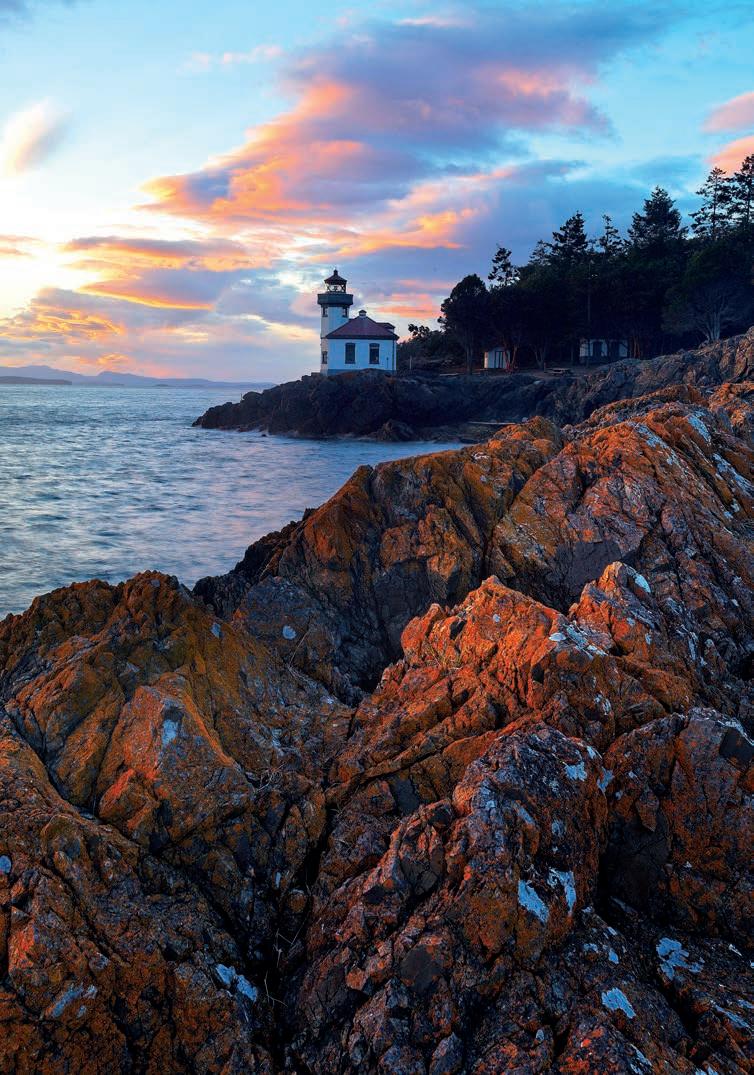

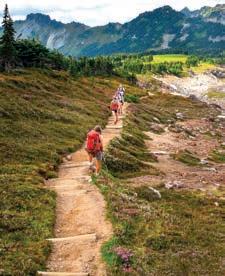
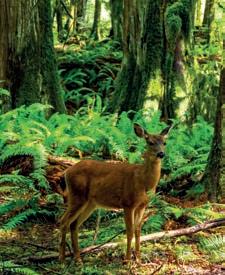
embarrassingly large, one of the tallest in the Lower 48, spiking to some 4,392m. Its snowy mass hulks over Seattle’s Elliott Bay like a deity holding the city in judgement.
“In Seattle, we just call it ‘the mountain’,” said Karen Woodworth, a born-and-raised Pacific Northwesterner and my tour guide with Evergreen Escapes. “It’s like a beacon for us – it’s so often visible from the city.”
Now it was time to see it up close, as our day-long tour took us into Mount Rainier National Park, a forested oasis dominated by its namesake peak.The mountain was named by British Navy officer and explorer Captain George Vancouver after his friend, Rear Admiral Peter Rainier, who had never actually visited the region; now there are calls to reinstate the peak’s Indigenous name, Mount Tacoma. The park’s boundaries spread across the ancestral homelands of the Puyallup, Cowlitz, Muckleshoot,Yakama, Nisqually and Squaxin Island peoples.
Washington was one of the last states to be colonised and was admitted into the Union less than 150 years ago, in 1889. Just ten years later, in 1899, Mount Rainier National Park was formed, showing the extent to which conservation is embedded in the state’s psyche.
Old-growth forests thick with Douglas firs, western hemlocks and western red cedar characterise the region. Just outside the protected park boundaries, these gangling trees once supported a booming lumber industry; however, the decline of logging in the region is largely down to a single species: the northern spotted owl.
“This is what a mature forest without much human interaction – apart from this road – looks like,” said Karen as our tour bus snaked along the woodland-fringed park byway. “Some of our oldest trees are 1,000 years old.We’re lucky to have a place that has been preserved for more than 100 years; it would have looked very similar back then.”
Last year, Mount Rainier was the 18th most-visited national park in the US system, and visitation has risen by about 40% over the past decade.This year, for the first time ever, timed reservations are being tested throughout the summer months.
“It’s a trial run to help combat overtourism,” Karen explained. “With COVID, and even the year or two before that, many national parks became overwhelmed… We’re hoping this will ease some pressure.”
“There are growing calls to reinstate Mount Rainier’s Indigenous name, Mount Tacoma”
My early spring visit meant I was outside of the reservation window, and the summer crowds were yet to descend. As we drove, Mount Rainier played a perpetual game of peek-a-boo with us, winking from between soaring old-growth stands before disappearing once more. My ears crackled as we gained in elevation, eventually reaching the aptly named Paradise area. Here, the muscular flanks of Mount Rainier were still plastered in snow, so we donned snowshoes for a waterfall hike.The trail unfolded in a string of Alpine-esque vistas: cedar trees heavy with ice, the rippling ridges of the Cascades, and finally Myrtle Falls, a waterfall that tumbles 18m and has Mount Rainier’s summit as a backdrop.
This bird once thrived in Washington’s old-growth forest, but was declared ‘threatened’ under the Endangered Species Act in the 1990s. It led to a halt in logging within areas that included the forest habitat critical to the owl’s survival – a victory for environmentalists and conservationists but a blow to the mill workers whose livelihoods quickly evaporated.Today, the northern spotted owl remains on the brink of extinction.
As we passed through the gates of the national park, the contrast between the human-impacted tracts of forest and those that have been long protected is blinding. In the park, the trees spit towards the sky, with mighty trunks forming dense thickets and broad canopies that explode like emerald fireworks. My neck ached from looking upwards.
BLOWN AWAY
Snow still lingered in Olympic National Park, too. I had reached it from my base in Seattle, crossing the Puget Sound on the ferry to Bainbridge Island and cruising north towards Port Angeles, a key gateway. As I drove, views of the mirror-like Sequim Bay revealed themselves in flashes.
I metTommy Farris, owner of the Olympic Hiking Company, and we pushed into the park, the Olympic Mountains spiking around us as we followed the Hurricane Ridge Road, a byway leading to one of the park’s most popular viewpoints.
“I grew up here. Back then, I really had no idea how lucky I was to call this place home,” saidTommy as the road rose and the
Alamy
The evergreen state (clockwise from bottom left) Blacktail deer are often spied on the fringes of Olympic National Park; there are 418km of maintained trails within Rainier National Park; in the 1990s, the preservation of the now-rare northern spotted owl became a controversial topic in Washington, as vast stretches of the state’s forest were set aside to ensure their survival, decimating the local logging industry; both Tacoma and South Seattle are built on 30.5-metre-thick mudflows from past eruptions of Mount Rainier; sunrise over blustery Hurricane Ridge; Friday Harbor on San Juan Island has a charming small-town vibe
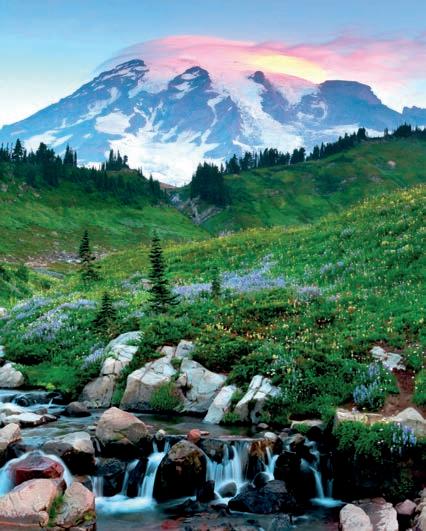
ground dropped beneath us. “Diversity is really what makes this place so special: you essentially get multiple national parks in one visit – there’s the mountains, the coast and the Hoh Rainforest, which could be its own unit entirely.Then there are lakes and rivers and waterfalls; all those different ecosystems are within a few hours of Port Angeles.”
Originally designated as the Mount Olympus National Monument in 1909, the site was awarded full national park status in 1938 after then-president Franklin D Roosevelt explored the wilderness for himself.We saw one piece of the park’s natural jigsaw as we reached Hurricane Ridge, a scenic area so named for its propensity for gales, where flower-embroidered mead-
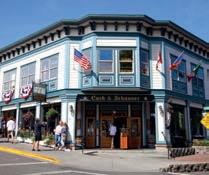
ows rush out beneath skyscraping peaks. I watched as a marmot chomped on grass right in front of us. “He probably just woke up,”Tommy said.
“This is a place that can be explored pretty much all 12 months of the year,”Tommy added as we climbed back into the van. “It’s not like they just close the gates in September. Come in December and go storm-watching on the Pacific Coast, or see raging, swollen waterfalls like Marymere Falls.”
The latter was our next stop, reached via a relatively mellow (though stair-filled) hike through sweeping tracts of old-growth forest. Early evening sunlight melted through the trees and the paths were blissfully quiet.
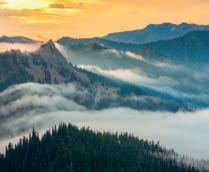
Need to know


When to go
Washington state is a yearround destination, though try to avoid the parks in peak summer. Instead, opt for spring or fall, when the weather is mild but the high country often still has snow.


Getting there & around
Seattle is a springboard for the San Juan Islands (a 50-minute seaplane ride with Kenmore Air; from £133 one way), Mount Rainier National Park (a two-hour drive) and Olympic National Park (2.5 hours, including a 35-minute ferry to Bainbridge Island). Airlines including British Airways (ba. com) fly direct to Seattle-Tacoma International from London Heathrow; flights cost from £478 return and take around ten hours. When in-state, you’ll need a car, or you can opt for guided day tours from Seattle with companies such as Evergreen Escapes (evergreenescapes.com). Excursions with the Olympic Hiking Company leave from Port Angeles (hikeolympic.com).


Carbon offset A return flight from London to Seattle-Tacoma produces 767kg of carbon per passenger. Wanderlust encourages you to offset your travel footprint through a reputable provider. To find one, visit wanderlustmagazine.com/ inspiration/sustainable-travel.


Where to stay
In Seattle, base yourself at the music-themed Edgewater Hotel (edgewaterhotel.com; from £234pn) on Pier 67 for fine views of Mount Rainier. In Olympic NP, the 1916-built Lake Crescent Lodge (olympicnationalparks. com; from £164pn) offers cute cabins or a room in the lodge.


Further reading & information
Visit stateofwatourism.com, portseattle.org, visitsanjuans. com and olympicpeninsula.org
The author travelled with support from State of Washington Tourism and the Port of Seattle.
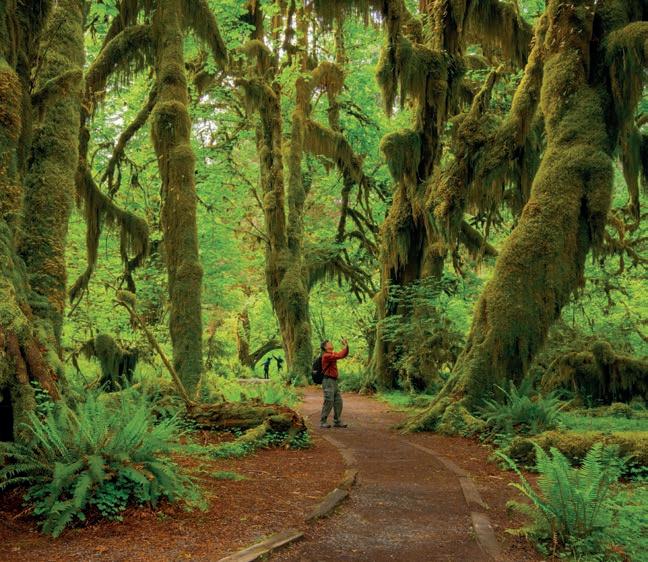
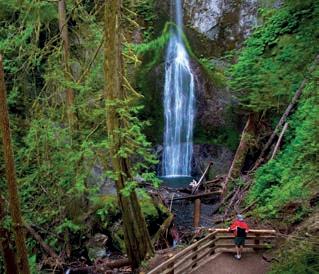
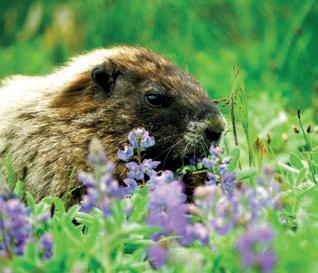
Alamy
Forest of plenty (this page; clockwise from top) The Hall of Mosses Trail offers a lush taste of the Hoh Rainforest, which makes up one of four distinct temperate rainforests within Olympic National Park, including Queets, Quinault and Bogachiel; hoary marmots are commonly spotted in the subalpine meadows of Mount Rainier National Park, where they’re sometimes known as ‘whistlers’, owing to the shrill call that they make to warn against predators; Marymere Falls can be seen on a walk from Lake Crescent Lodge or Storm King Ranger Station; (right page) orca can be spied year-round in the waters of the San Juan Islands
“This is the perfect time to be on the trail,” Tommy mused as we made our final ascent to the 27m-high falls, whose roar filled the hushed forest.
GATHERING MOSS
It was into the woods again the next day, this time with Olympic Hiking Company guide Oscar Hammer, who shared an encyclopaedic knowledge of the ecosystem as we walked the Hall of Mosses Trail in the Hoh Rainforest.
“All that moss needs is a surface to adhere to and a constant source of moisture. As long as it’s warm enough and wet enough, moss will grow – and that’s why it’s so prolific here,” explained Oscar.
Almost 3.6m of rain is recorded in the rainforest each year, turning the leaves of the spruces, hemlocks and maples an acidgreen colour that looks almost man-made. Mosses crawl across the forest floor and scramble over gnarled trunks, while lichens hang like bunting from twisted boughs. Life and death is laid bare in the rainforest too. The sea of green is occasionally interrupted by a white and weathered stump, while new growth sprouts from fallen giants.
Our final stop was Ruby Beach, a windswept strand where driftwood scattered the pebbles like bones.The Pacific waters were staked with sea stacks, their summits circled by gulls.With his boot, Oscar gently tapped a weathered wooden board studded with nails.
“That’s possibly from a shipwreck,” he said. “All kinds of treasures tend to wash up on this beach. Each little part of this park tells its own story.”
That’s true of Washington as a whole, I thought, staring out across the Pacific Ocean, its white-capped waves curling over the shore. Each pocket of this state – from its mountain-jewelled national parks to its mellow islands, to its orca-filled seas – tells its own distinct tale of the wild.They’re stories of conservation, of growth and renewal, and of humankind’s ongoing dance with nature. For me, Ruby Beach was the dramatic epilogue. I’m keen to return for another chapter.
Top 5 wildlife encounters in Washington state
1
Whales & orcas
Incredible marine life can be sighted along the north-west coast, from the Pacific waters off Olympic National Park to the Salish Sea. Minke whales and orca can be seen year-round; seasonal whale visitors include greys (Mar–May) and humpbacks (best time is Aug–Oct in the San Juan Islands). Take a wildlife-watching trip with a trusted outfitter such as San Juan Safaris (sanjuansafaris.com), whose three-to-four-hour boat tours with a naturalist guide cost from £98.
2 Bears
Throughout the 19th century, grizzly bears were hunted to extinction in most of Washington state; they’re only now beginning to be reintroduced into the North Cascades area, where the last sighting was previously in 1996. Black bears are more prolific in areas
such as Olympic and Mount Rainier national parks. Seeing these creatures in the wild is a life-affirming experience, but familiarise yourself with bear safety at nps.gov before embarking on a hike.
3 Birds of prey
Washington’s skies are filled with raptors, ranging from bald and golden eagles to peregrine falcons and ferruginous hawks. The Great Washington State Birding Trail (wa.audubon.org) includes seven looping routes through various birdrich regions, including the Cascade mountain range, the Olympic National Forest and the Coulee Corridor National Scenic Byway.
4 Mountain goats
These hardy creatures can be found scaling the peaks of the Olympic Peninsula (where they’re not native) and the Cascades (where they are).
5 Sea otters
Washington’s sea otters are a conservation success story, after being hunted to extinction by the
hunted to extinction the early 20th century, at the height of the fur trade. They were first reintroduced in 1969 and numbers continue to rise. Spot them off the Olympic Coast in areas including Ruby Beach
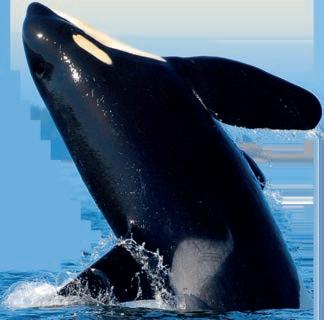
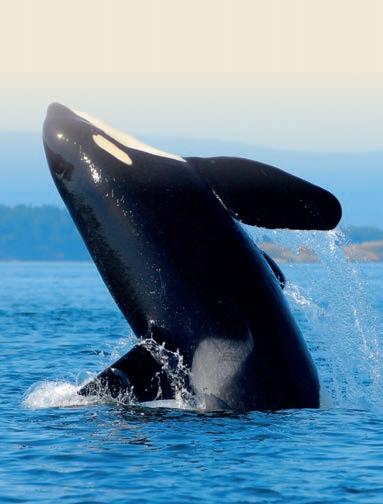
San Juan Islands
Seattle
Mount Rainier NP
Olympic NP
Ruby Beach
BRAZILIAN AMAZON Journey into the
Your ultimate guide to experiencing the best of the Amazon in the most biodiverse
nation on the planet…
Lush, green and teeming with an incredible array of plants and wildlife, Brazil’s Amazon rainforest region is a must-visit. It’s crisscrossed with rivers and waterways, including the mighty Amazon itself. Here you’ll have the chance to meet, and learn from, Indigenous peoples who have made this area their home for thousands of years, as well as observe unique flora and fauna; you’ll enjoy different adventures and immerse yourself in – and help to protect – the most important forest in the world. Here are some of the top experiences you can enjoy in the Brazilian Amazon...
AMAZONAS
Amazonas is Brazil’s largest state and is almost entirely covered by the Amazon rainforest. Here’s how to enjoy it...
What to do
One of the most fascinating sights is the Encontro das Águas, or ‘Meeting of the Waters’. This unusual
natural phenomenon occurs at the confluence of the black water of the Rio Negro and the muddy water of the Rio Solimões, where the two rivers run side by side without mixing for nearly 6km.
Manaus, on the banks of the Negro, is the cosmopolitan capital of Amazonas. Soak up some of the city’s best sights and culture before heading into the rainforest. Take in the striking Teatro Amazonas, a beautiful Belle Époque-era structure built at the height of the region’s rubber-producing boom. Still used for opera performances, its lavish interiors feature 198 Italian chandeliers, and its dome is covered in over 36,000 ceramic tiles painted in the colours of Brazil’s national flag.
Manaus also has several interesting museums. You can learn more about the city and the region’s history and evolution at Museu da Cidade, which features interactive exhibits and ancient artefacts. Immerse yourself in the sounds and smells of Manaus’ historic Municipal Adolfo Lisboa market, modelled on Les Halles

Rolling on a river (right) Meet local riverside community members and gently canoe down the Amazon’s many waterways; (left) the Teatro Amazonas is an architectural wonder in Manaus

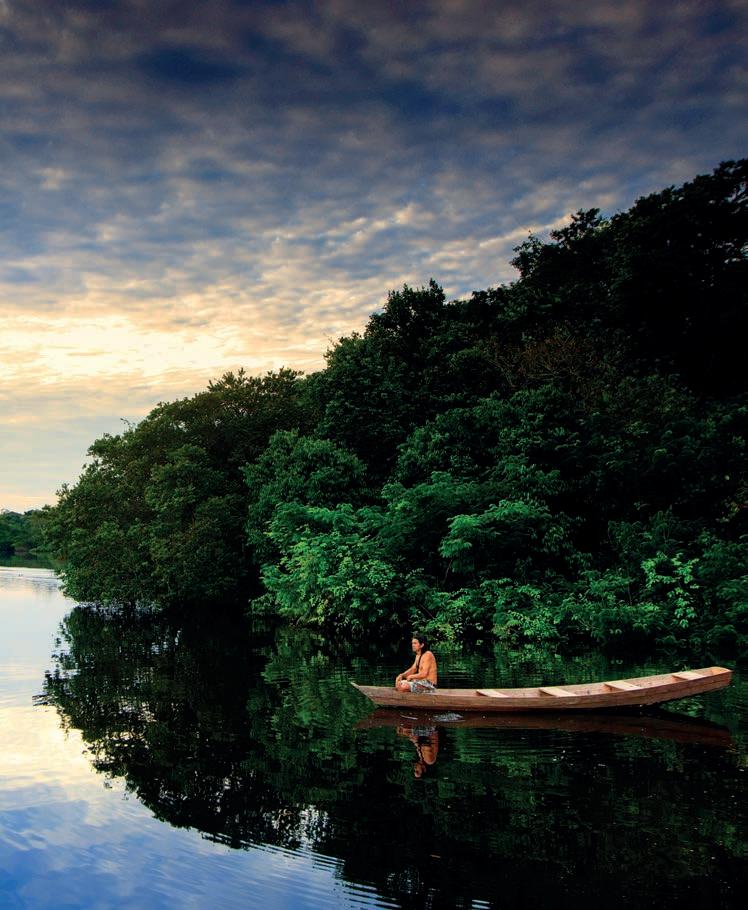
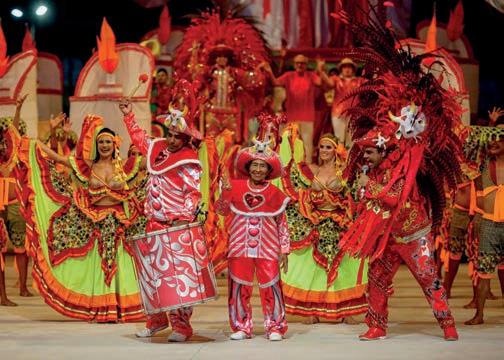


in Paris. Inside the brightly coloured red-and-yellow building, you’ll find stalls selling fresh fruit, spices, fish, souvenirs and traditional Indigenous medicines. And don’t miss sunset at the Mirante Lúcia Almeida viewpoint, overlooking the Rio Negro. Here you’ll also find a modernist retail and entertainment complex with restaurants and bars.
Get involved with the protection and conservation of some of the Amazon’s most precious wildlife. Freshwater turtles are becoming endangered, but there are several initiatives aimed at helping sustain their population. You can visit one of the projects in the Nossa Senhora do Perpétuo Socorro community via a boat tour and see how volunteers monitor turtle spawning and dig holes for incubators, and even take part yourself.
Time your visit for the annual Parintins Folklore Festival in the city of Parintins, to the east of Manaus. Held in June, it’s second only to the Carnivals of Rio and Salvador in terms of size. Also known as the Festival do Boi-Bumbá, it’s based on a traditional dance which tells the story of the death and resurrection of an ox. Two boi-bumbá teams, one dressed in blue, one in red, compete with flamboyant dances; the winners are judged on criteria including best music, best floats and best crowd support. Don’t seek to understand too much, just immerse yourself in the spectacle (and admire the ox costumes).
What to eat
With access to some incredible produce, eating out in Manaus is a highlight. At Caxiri, you’ll find dishes
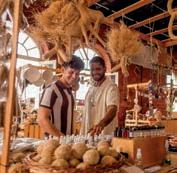

using local fish like tambaqui and arapaima, and at fine-dining Banzeiro you can sample some more unusual ingredients, such as leaf-cutter ants or tucupi (the juice of the wild manioc root). At the floating restaurant Flor do Luar, which sits by the Rio Negro, you’ll find traditional dishes such as fried cassava, ceviche and farofa (toasted cassava flour).
Where to stay
Injecting some colour (this page; clockwise from top) The Parintins Folklore Festival is second only to Brazil’s carnivals; browse Belém’s Ver-o-Peso market; admire lush foliage at the Villa Amazônia in Manaus; embark on a sunrise boat tour along the river at Anavilhanas Lodge; Ver-oPeso market also features traditional artwork
Immerse yourself in nature at Anavilhanas Lodge, a hotel set in the jungle on the banks of the Rio Negro. It’s found next to Anavilhanas National Park, a UNESCO World Heritage site home to over 350,000 hectares of preserved forest. Here you can arrange sunset or sunrise boat tours along the river, or scenic journeys into the river’s archipelago of some 400 islands, where you may spot the Amazon’s famous pink dolphins in the water.
If you prefer a city stay, Manaus’ elegant Villa Amazônia –a restored historic mansion – is just a few minutes’ walk from the Teatro Amazonas and close to the Museu da Cidade. For an unforgettable experience of life on the river, take a cruise with Belo Shabono, spending several days onboard a vintage-style wooden boat. This offers incredible access to the Amazon’s wildlife.

PARÁ
To the east of Amazonas lies the state of Pará. This is spanned by the Amazon rainforest, and offers similarly awe-inspiring opportunities for immersing yourself in nature. Here’s what you can expect...
What to do
Belém: In 2025, Belém will host COP 30. It is the first time the event has been held in the rainforest, highlighting Brazil’s commitment to fostering sustainable ways of living and travelling. This handsome port city is the gateway to Brazil’s lower Amazon region, but it’s worth lingering here for a few days. By Guajará Bay you’ll find the riverfront district of Cidade Velha (or Old Town), where Portuguese colonial architecture abounds and you can explore colourful azulejo-tile houses, churches and the 17th-century fortification Forte do Presépio.
A short walk from the fort is the lively open-air Ver-o-Peso market,
one of the city’s main hubs. Its name dates from the colonial era, when the Portuguese would ‘ver o peso’ (check the weight) of merchandise so that they could impose taxes. Here you’ll discover plenty of tropical fruit and vegetables, dried goods, Indigenous handicrafts and freshly made juices, but you’ll also want to explore the area dedicated to natural remedies.
Lying a short stroll away is the handsome, Neoclassical Theatro da Paz, dating from 1874. Inside, it’s decorated with statues, furnishings and busts from across Europe, and features an imposing Italian marble staircase as well as gilt carvings and hand-painted ceilings.
Back on Guajará Bay you’ll find Estação das Docas. Formerly Belém’s main port, it’s been regenerated into a stylish entertainment complex with three different areas focusing on restaurants, retail and event spaces. It’s the perfect place to stop for a drink by the river. Escape the buzz of the city at Mangal das Garças, a ⊲
Architectural grandeur (this page; top to bottom) Belém is home to riverfront splendour; the Neoclassical Theatro da Paz in Belém dates back to 1874; stroll around the pastel-hued Feliz Lusitânia Complex in Belém
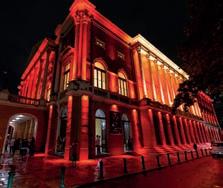



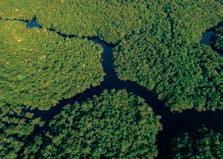
beautiful ecological park which gives a taste of the Amazonian rainforest and has examples of native trees, plants, butterflies and birds. It is also home to the impressive 47m-high Belém lighthouse.
In addition, Belém (and Pará as a whole) is devoted to music, and you will find many examples of some of Brazil’s most interesting genres, both traditional and modern. Calypso (also known as Brega-pop) was born here by mixing elements of more regional genres of music, such as the lambada, carimbó and guitarrada, with international music from Caribbean countries, like ska and reggae. Tecnobrega remixes and reworks popular music and songs from the 1980s, while carimbó derives from a sensual Brazilian dance, performed to the beat of carimbó drums.
At any time of day, you’re likely to hear music drifting from the insides of bars, homes and restaurants; by night you can check out live music
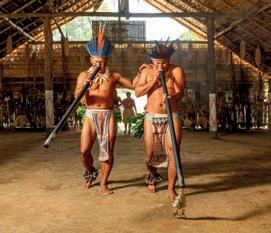

venues such as Caso do Gilson or the Cosanostra Café.
What to eat
When it comes to food in Belém, you won’t be disappointed; it was designated a UNESCO Creative City of Gastronomy in 2015, thanks to the diversity of its produce.
Try restaurants like Point do Açaí, where you’ll find simple dishes such as moqueca fish stew or maniçoba, pork simmered with cassava. At Casa do Saulo das Onze Janelas, you’ll find the likes of fried tapioca, arapaima carpaccio and grilled tambaqui.
At Martens Cafe, which is set within the grounds of Mangal das Garcas, you’ll discover a lovely place to sit and enjoy a coffee, while at Ilha do Combu, a small islet on the river, you can eat traditional local dishes at Chalé da Ilha.
Where to stay
Atrium Quinta das Pedras is an elegant hotel situated in a historic


Jungle fever (this page; clockwise from top left) Tropical wildlife abounds in the Amazon; visit Indigenous communities in Manaus; soak up rainforest sounds on a regional boat; learn from the Indigenous Cipiá community in a hands-on culinary class; the Brazilian Amazon is an incredible network of waterways and lush foliage; stop by the Estação das Docas in Belém
18th-century building. The location couldn’t be better; it’s moments from Mangal das Garças and the Portal da Amazônia. There are pools for both adults and children, which makes it the perfect escape on a hot day.
What to do
Alter do Chão: Nearly 1,300km to the west of Belém lies the city of Alter do Chão, which sits on the bank of the Tapajós River. Set in the heart of the rainforest, it provides easy access to tropical nature and some of the most beautiful freshwater beaches in Brazil.
How can you resist nearby locations like the seductively named Ilha do Amor, or ‘Love Island’, a long strip of sand separated from the mainland by the river? Accessed only by boat, it’s best visited during the Amazonian summer, which runs from July to November, when the water levels are lower. You’ll feel like you’ve been washed up on a serene desert island, far from the hustle and bustle of modern urban life.


Marvel at the beautiful water lilies in the Jardim da Vitória-Régia, looked after by Dulce, a local woman, who will feed you a range of dishes made with the lilies, from cakes to pickles. She also takes guests on a canoe tour so that you can see these beautiful plants up close.
The Enchanted Forest is a beguiling area that showcases some of the region’s diverse flora and fauna beneath chattering monkeys in the trees. You’ll see different species of orchids and, if you’re lucky, you might spot dolphins in the river. If you still want to explore, nearby Lago Verde also has 14 natural springs that you can navigate by canoe.
However, one of the most fulfilling experiences is spending time with the Borari Indigenous community. Alter do Chão is the most well-known Indigenous village in the Amazon, and the Experiências do Brasil Original Project aims to expand and diversify Brazilian tourism by creating memorable and transformative visitor
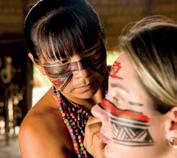

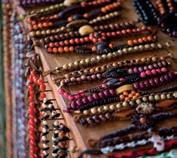
experiences directly provided by traditional peoples and communities in their own areas.
You can participate in a variety of activities, from learning how to cook traditional meals to enjoying dance performances, playing instruments, making handicrafts and much more. This way, you will really learn about the Borari culture, and your input will help transform the lives of community members, especially young people and women, by valuing their culture, customs and way of life, while also creating new jobs and increasing community income.
What to eat
One of the best foodie experiences you can have here is a piracaia dinner. The name comes from either the words for ‘fried or burnt fish’ (pirá+caia) or ‘the shoal’ (pirá+quaia). The piracaia is a joyful nocturnal gathering of locals on the beach, clustering around a bonfire to eat together, sing and dance under the

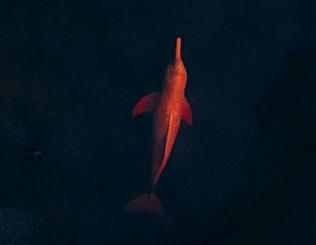
Community spirit (this page; clockwise from top left) Learn about the ancestral heritage of the Indigenous Cipiá community; the Brazilian Amazon offers a true immersion in nature; be in with a chance of spotting pink river dolphins; visit local riverside communities and buy their artisanal handicrafts for meaningful souvenirs; taste the fresh flavours of Amazonian cuisine
silvery glint of a full moon. Or try Casa do Saulo, where the family which owns the restaurant serves up traditional dishes such as prawns breaded in cassava flour, moreish cheese pastries and fish moqueca
Where to stay
Vila de Alter is a traditional pousada, or inn, close to the rainforest. It has a set of minimalist but cosy and welcoming wooden bungalows spread across its grounds. You can choose to relax in one of their hammocks, soak in the hot tub or embark on a local excursion. They can arrange serene boat trips down the river or meetings with local riverside communities.

Toasting to the future
Moldova might be the ‘least visited country in Europe’, but in its restored monasteries, millennia-old wine culture and revitalised capital, something special is happening…
Words & photographs George Kipouros
As we drove, seemingly without direction, through a succession of dimly lit tunnels nearly 100m below ground, I became increasingly convinced that we were lost.
“Don’t worry, we know this place inside out,” assured resident guide Slavik. So on we ploughed, navigating a labyrinth of passageways totalling some 120km beneath a small town in central Moldova, pursued by the unmistakable woodsy scent of alcohol.
Reaching an intersection of sorts, I managed to catch a glimpse of a street sign written in Cyrillic: ‘Cabernet Street’. “Now you know what’s inside the casks all around us,” smiled Slavik.To the left and right of me were tens of thousands of barrels and bottles lining the tunnels of Cricova

Winery, the second largest wine cellar in the world.This really was the underground city I’d been promised at the start of my tour.
As it happens, Moldova also boasts the largest underground wine cellar too, Slavik told me, though he was at great pains to highlight the uniqueness of Cricova, host of the national wine collection.
We were navigating tunnels dating back to the 16th century, when the site was a mine; the limestone extracted here was used for building Moldova’s capital, Chișinău, a mere 15km to the south. Its conversion into an underground wine emporium came much later, in 1952, when the Soviet Union was in charge here (1940–91).
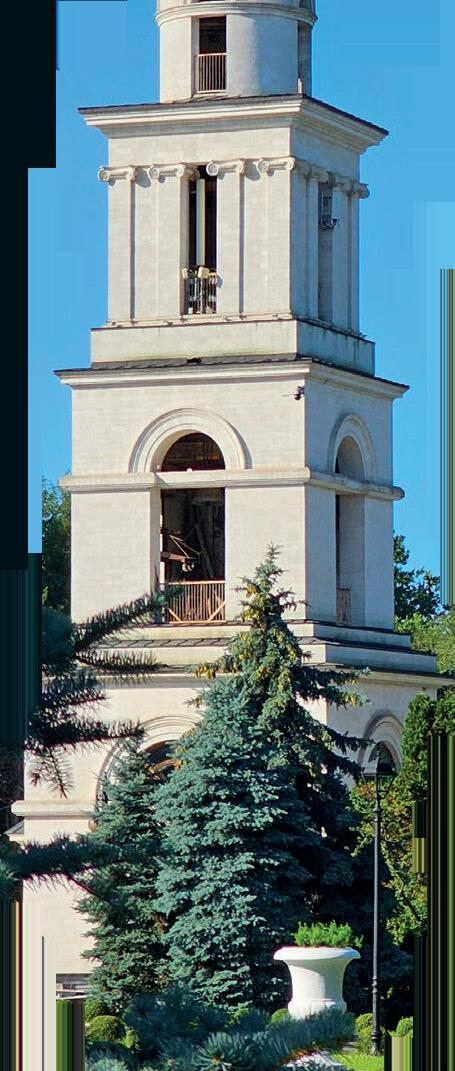
Around 80km of the tunnels are now used for wine production and storage, while 40km are still actively mined for limestone. Inside, it was a bracing 12 degrees Celsius, a temperature that barely fluctuates yearround; it felt even cooler thanks to the high humidity of 85%.
“Around 80km of Cricova’s tunnels are used for wine production and storage”
Cricova Winery is government owned, which is perhaps not surprising given its history and size.What is more remarkable is that little Moldova (a country of barely 2.6 million people) is currently the 14th largest wine producer in the world.
“During the Soviet era, we produced even more, as it was all about quantity back then,” explained Slavik. He quickly reassured
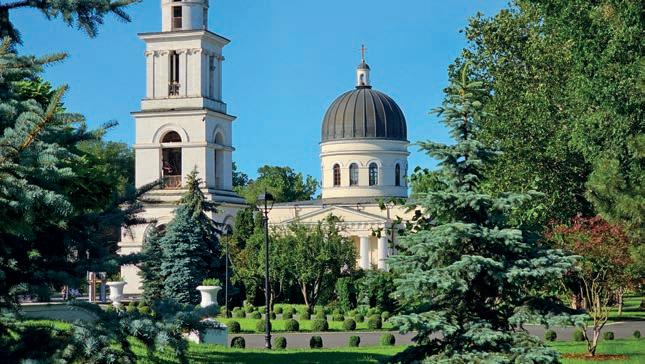

Scenes from the Nativity (this page) Chișinău’s Neoclassical Nativity Cathedral was built in 1830 and lies on the city’s main square, though like much of the capital it was badly damaged by the 1940 earthquake, and then again during the Second World War. Most of its interior and dome was rebuilt in the 1950s and later added to. It was also used as an exhibition hall during the Soviet era, and it was the site of the first-ever radio broadcast in Moldova; (opposite page) a mosaic at Cricova Winery of a Moldovan wine drinker dressed in national costume – there




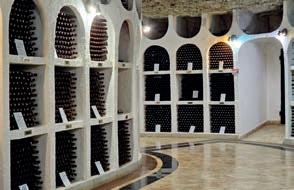
me that production today was “finally” focused once again on quality.
The country has the silverware to back up such heady claims, with a Moldovan late-harvest traminer bagging ‘best wine’ at last year’s London Wine Competition. It’s just one award among many, I’m told. We concluded our visit with the obligatory 11am tasting, as Slavik enthused over the growth potential of Moldovan enotourism.
“We have just as much to offer as other famous wine regions, yet not many tourists think of visiting Moldova,” he said.The 80,000 visitors to Cricova last year might disagree, though many of those came from neighbouring Romania; few arrive from outside Eastern Europe. A map near the exit showed a further 200 wineries; about 30 are equipped with facilities to welcome visitors.
“But we have so much more in addition to great wines,” chimed in Natalia, the tour guide taking me around a country still very conscious that it is yet to win its fair share of tourists. “We are apparently the least visited country in Europe, but you will see how unfair this is!” she assured me while pointing out our next stops on the map.
Leaving Cricova’s tunnels and their chilly microclimate behind, I was eager to venture above ground and experience more of Moldova’s undiscovered sights and flavours.
Beyond the vineyards
While Moldova has no mountains, the farming landscapes surrounding us were a kaleidoscope of vibrant colours.Visiting in early June, we drove past verdant fields brimming over with fruit and vegetables, all jostling for space with mile after mile of vineyards.
“Our soil is very fertile, and in terms of agriculture we’ve always been very rich,” confirmed Natalia, though even this wasn’t enough during the Soviet era, when chemicals were widely used to boost production. “There was serious degradation of the local environment, she told me. “It’s taken years to recover.”
towards a pond reflecting the complex’s 19th-century Baroque-style Naşterea Domnului Cathedral in its waters.
“It’s a miracle that it still stands,” she explained, and began narrating a story of creation and destruction repeated many times over the past three centuries.
“Not unlike the story of our country, the tale of Curchi is one of survival against all odds”
It wasn’t just environmental degradation that the modern Moldovan state has had to endure. Natalia explained how our next stop had weathered its own misfortunes, and last served as a psychiatric hospital. It didn’t sound much like a typical visitor site, though the drive down a lane dotted with orchards was pleasant enough. It was then that the ornate, towering dome of Moldova’s tallest church came into view.
“Curchi is the most beautiful monastery in our country,” beamed Natalia as we walked
In just the last 100 years alone, Curchi was destroyed by fires during the Second World War, only to be restored shortly afterwards; then it became sadly neglected when the Soviets shut down the monastery and turned its grounds into a psychiatric hospital that operated until 1995. It wasn’t until ten years later that most of the site was reopened – although restoration work is still ongoing.
“Not unlike the story of our country, the tale of Curchi is one of survival and resurgence against all odds,” remarked Natalia stoically.
These days, monks are once again back in residence at the monastery, and pilgrims are arriving in healthy numbers.
“Visitors are helping us to raise funds for restoring our historic sites,” explained Natalia, highlighting one positive impact that a growth in tourism numbers might bring.

One in a million (this page; clockwise from left) Slavik shows off the wares of Cricova Winery’s cellar, which contains around 1 million bottles of wine, including Moldova’s national wine collection; the entrance to Curchi Monastery, whose grounds are home to several churches built from 1775 onwards; Cricova’s tunnels hold around 40 million litres of wine in total; (opposite page) Naşterea Domnului Cathedral has the highest dome in Moldova, rising to a height of 57m


The food proved to be another unexpected highlight of my visit to Moldova, and none more so than my first lunch at a rural guest house, Casa din Lunca.This was one of the first agrotourism businesses to open in the region; now it’s part of a burgeoning scene of locals combining farming with traditional hospitality. In the face of limited hotel options, Moldovan guest houses offer a charming and rustic alternative.
“They are now sprouting like mushrooms,” chuckled Natalia as we toured the beautifully kept grounds, carefully avoiding the cockerel-in-chief and his army of chickens.
Casa din Lunca started out by offering a few rooms in the family home; they have
since renovated a number of previously abandoned houses in the village to meet growing demand for stays in the area.
At lunch, we feasted on true farm-to-fork fare. Its simple flavours were focused on fresh fruit and vegetables, and I was transported back to childhood visits to my grandparents’ rural home in Northern Greece, especially when savouring sarmale, the Moldovan version of stuffed cabbage leaves.
When expressing a liking for the local pie, plăcintă, the cook emerged from the kitchen and invited me for an impromptu lesson on making filo pastry. Her warmth and heartfelt hospitality I would encounter in different forms time and again throughout the country.

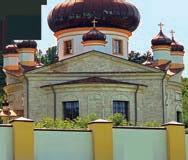
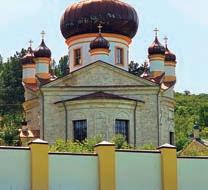

A capital reborn
Having gotten a flavour of the countryside, it was time to explore capital Chișinău, home to nearly a third of all Moldovans in the nation.
It’s fair to say that Chișinău was not love at first sight. The arrival from the airport transports visitors back to the Soviet era, as a parade of identikit apartment towers and Brutalist edifices scrawls past the car window. But it has a good excuse. Some 70% of the city was destroyed during the Second World War, so I was surprised to discover a historical centre dotted with surviving architectural jewels, many now enveloped in well-manicured green spaces.
hard to believe that the Church
with a traditional Moldovan
to make filo
Crowning glory (this page; clockwise from top left) The golden domes of St Theodor Tiron Cathedral in Chișinău; it’s
of St Nicholas in Condrita was abandoned after the monastery closed in 1947; Ecaterina Popescu, founder of Artă Rustică, poses
rug; (opposite page; clockwise from top left) Chișinău’s Central Park fountain; rice-stuffed cabbage rolls (or sarmale); learning
pastry at Casa din Lunca; Căpriana Monastery is one of the oldest in Moldova; a Moldovan salad; the Church of St Nicholas is known for its fine frescoes; the interior of a modern Moldovan winery




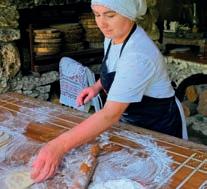



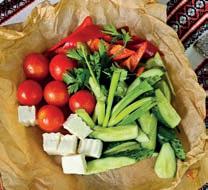
Sadly, quite a few of these 18th- and 19th-century marvels are still in dire need of attention, although aid funding from the EU and the US has helped to speed up their restoration over the last decade.
The city’s numerous Christian Orthodox places of worship were among the first to be brought back to life. Chișinău’s Neoclassical Nativity Cathedral lies at the heart of the city’s main square. It, too, was bombed during the SecondWorldWar, and it endured further hardship when the local Communists destroyed its belltower in the early 1960s.Today, it once again towers above the myriad restaurants and cafés that teem the city centre, giving it life and charm.
“There is a small renaissance happening in Chișinău,” said Natalia, who shared the success stories of restaurateurs and entrepreneurs that had recently returned to Moldova.
It’s a far cry from what the city would have looked like 30 years ago. In the early 1990s, the country was synonymous with poverty in Eastern Europe.As a result, around a million Moldovans left, emigrating to find work and a new life.Yet Natalia told me that they have increasingly started returning: “Some are feeling homesick, others are simply coming to try their luck.” It was a positive sign.
Reviving lost arts
“There is a small renaissance currently happening in Chișinău”
The city also recently welcomed tens of thousands of Ukrainian refugees escaping the Russian invasion.
“Moldovans know what it means to be an immigrant, so we naturally opened our homes to people who needed them,” said Natalia with a tinge of pride.
It would not be fair to say that it was only the returning diaspora that is fuelling Moldova’s economic and cultural revival. Having left the city behind for the Moldovan countryside once more, I met Ecaterina Popescu, founder of Artă Rustică, a centre for weaving in a village almost deserted by Moldovans fleeing the economic hardships of the 1970s. Passionate about the art of weaving, and equipped with plenty of family know-how, in 2003 she moved her collection of heirlooms to an abandoned kindergarten and set up a workshop.
“Our mission is to revive traditional weaving, but the ultimate goal is to contribute

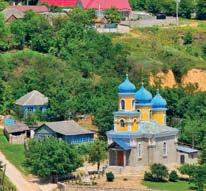


to restoring the Moldovan identity,” declared Ecaterina. In addition to showcasing historic collections, she also trains and employs many local women, who weave carpets and traditional costumes that they then sell.
“Involving the younger generation is key to our art’s future,” Ecaterina exclaimed, and we saw several children attempting to create their own masterworks in the courtyard.
Leaving Artă Rustică behind, we continued our cultural immersion with a visit to a trio of monasteries: Căpriana, Hâncu and Condrița – each reachable on a day trip from Chișinău.
Căpriana is one of Moldova’s oldest and most prominent monasteries, Hâncu is the country’s largest nunnery and Condrița boasts a beautifully flamboyant onion-domed
church.At each entrance, a common pattern emerged, as my eye was immediately drawn to a collection of small kiosks filled with jars of local honey, jam, pickled vegetables and beautifully bottled wines.
“The monasteries sell some of the finest and purest products you can find,” explained Natalia. A bonus is that this is both a major source of income for the monks and also helps with funds for the restoration works.
Another common trait they share is that, much like Curchi, all three had ceased to operate as monasteries during the Soviet era. Hâncu was turned into a sanatorium, Căpriana became a children’s hospital and Condrița was a forestry school.Their return to working monastery life is a relatively
recent development, but their time in the wilderness was not without consequence.
“While there was some functional use for all these buildings, it also meant that we lost priceless iconography and frescoes,” said Natalia. I left pondering some of the treasures that would be forever lost to time.
Back to the future
The final stop in my itinerary took me to the cultural and spiritual heart of Moldova.The site of OrheiulVechi shines with the remnants of civilisations that once called this land home, from the ancient Thracians and the Golden Horde to the Ottomans and the Russians.This is all framed by an Eden-like valley of prelapsarian beauty, a limestone gorge carved over
Green Moldova (this page; clockwise from top) Hâncu has the finest gardens of any monastery in the country; the complex of Orheiul Vechi is known for its cave church, but the full site contains ruins dating back millennia; guide Natalia Cojuhari; a traditional village in Orheiul valley; (opposite page; clockwise from top left) a visit to one of the 200 or so wineries that scatter Moldova – wine production accounts for nearly a third of the country’s export earnings; the setting for DescOperă, held at the foot of Orheiul Vechi‘s limestone cliffs, is as breathtaking as the music; monk Efimie found his calling in the cave church

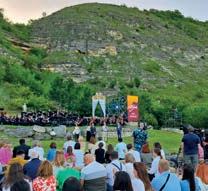

millennia and still dominated by the Răut river.Amid the charming villages and inviting hiking paths, a spiritual gem lies in the cliffs.
Following a brisk walk up, we entered into the hill itself, where the eerily mystical cave church of the Virgin Assumption awaited. This is the oldest still-functioning church in the country, and its unique setting, carved into the limestone, is well matched by the breathtaking views across the Orheiul valley.
I was lucky to meet resident cave monk Efimie, caretaker of the 15th-century church for the last 20 years. During the Soviet era he was an engineer, but he found his calling here.
“This is a very special location; every pilgrim can feel it,” he smiled, then began reading a psalm for a long and satisfying life.
In the background, I could hear an unexpected kind of singing. Echoing from a short distance away was the sound of an opera singer performing an unidentifiable aria.
“You are very lucky to be visiting during the DescOperă festival,’ announced Natalia.
While opera is not a deeply rooted Moldovan tradition, I was surprised to discover that its local singers excelled in the genre. Over 200 artists had been lined up for the three-day event, and with the stage set in a seemingly impossible natural amphitheatre below the cliffs, the acoustics were incredibly powerful.Though they were arguably enhanced by the copious amounts of Moldovan wine that guests were plied with during the evening.
It was my final glimpse of a country once known as the poorest in Europe. Moldova has since shed itself of this mantle and is now looking towards the future with optimism. Surprises await travellers everywhere here, not least in its wine cellars and monasteries, but it’s the hospitality of the people that will win their hearts.All it needs now is visitors.
Need to know

When to go
Year round, but we recommend avoiding the summer heat of July and August, and the piercing cold of winter (December to March).

Getting there & around
Nonstop return flights operate from London Luton to Chișinău with Wizzair (wizzair.com) and local airline Flyone (flyone.eu), and from Stansted with HiSky (hisky.aero). These take less than three hours and cost from £72.
Moldova is best explored with a tour guide and driver, as English is not yet widely spoken. Tour packages are very reasonably priced, and no visa is required for UK, EU or US citizens.

Carbon offset
A return flight from London to Chișinău produces 368kg of carbon per passenger. Wanderlust encourages you to offset your travel footprint through a reputable provider. For advice on how to find one, visit wanderlustmagazine.com/ inspiration/sustainable-travel.

Where to stay
Moldova has lots of good local hotels and guesthouses, all well priced and with warm hospitality. However, international hotels and luxury options are very limited, even in Chișinău. For a full list, visit the excellent official website moldova.travel
The author travelled with local support from ANTRIM Moldova.
CHIȘINĂU
Cricova
Orheiul Vechi
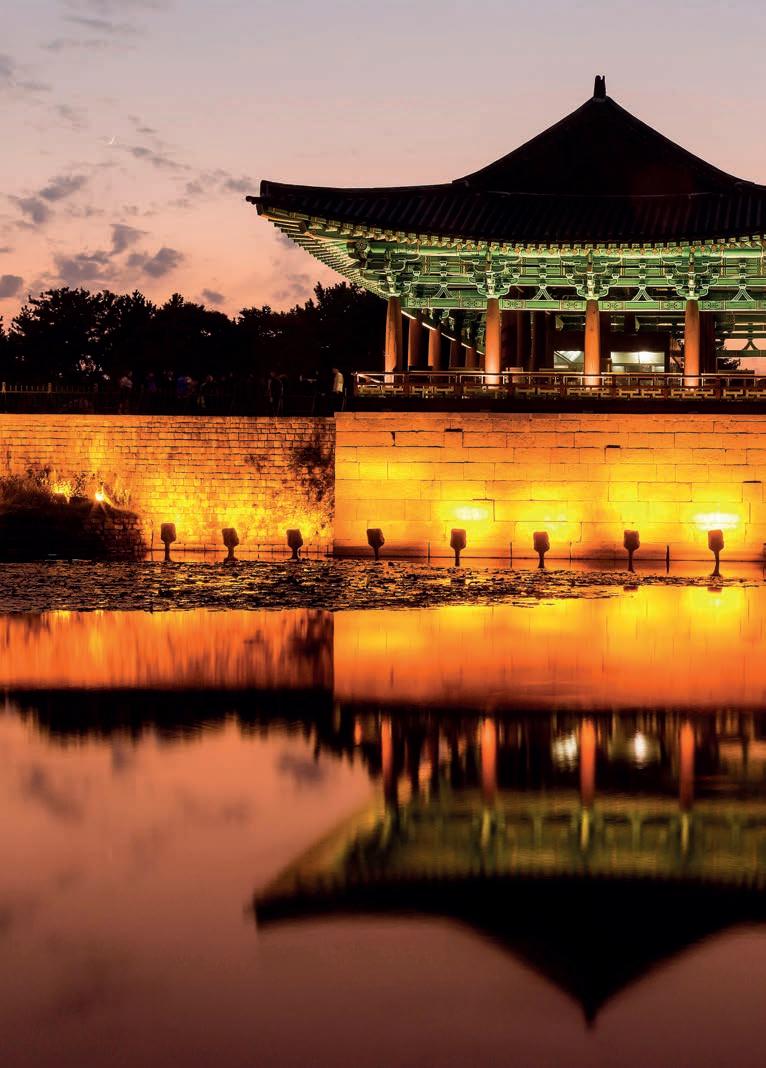

TRIP PLANNER:
South Korea
From the painted eaves of mountain temples to the neon kaleidoscope of Seoul, we pick the best routes to sample all the regal history, culture and wilderness that South Korea has to offer
Words Paul Stafford
A world of heritage
Absorb ancient temples, traditional folk culture and sacred shrines, journeying from South Korea’s untouched rural idylls to its megacities
Best for: Architecture, history, treasures, crafts and heritage
Why go: From Joseon palaces to Buddhist temples, unearth South Korea’s cultural gems across an array of glorious UNESCO-listed heritage sites
Route: Gyeongju; Andong; Seoul; Suwon; Jeju Island
Gyeongju, former capital of the Silla Kingdom (57 BC–935 AD), is a charming city that retains an ancient mystique. Grassy tumuli burial mounds scatter the area, holding the remains of Silla kings, queens and their retinue.You can see 23 of these tombs atTumuli Park on the southern edge of town, while the artefacts recovered from various archaeological digs lie in Gyeongju National Museum.
Nearby, Silla royals once cavorted in Donggung Palace beside the waters of Wolji Pond, a perfect spot to visit at sunset.You’ll also find the seventh-century Cheomseongdae, Asia’s oldest known observatory. It consists of 365 stones built atop a 12-slab base, suggesting an advanced understanding of the observable cosmos. Collectively, all these sights form one UNESCO World Heritage site. And further

south, BulguksaTemple is worth a detour for its restored Silla-era architecture and setting. From Gyeongju, take a bus ride north to Andong, a city known as Korea’s spiritual capital. Its reputation comes from having retained many of the Confucian traditions guarded by the yangban, the upper classes during the 500 years of Joseon dynasty rule. Away from the concrete blocks of the city, you’ll still see traditional hanok homes, with their maru wooden porches, tiled roofs and hanji sliding doors made of mulberry paper. To find out more, stop by the Municipal Folk Museum and Andong Folk Village. However, the jewel here is the UNESCO-listed Hahoe FolkVillage, west of the city, which offers a flavour of Joseon-era South Korea and is still a living, breathing community rather than a historical recreation.
Next, hop on the direct train from Gwangju to Seoul, whose metropolitan area is home to half the country’s population. For many people, explorations of South Korea begin and end here. Among the cluster of UNESCO-listed sites is Jongmyo Shrine, where you’ll find ancestral tablets detailing the feats of the 27 Joseon kings.Visit on the first Sunday in May to catch the Jongmyo jerye, a Confucian rite honouring Korea’s royal ancestors that is rendered in music and dance; this is the only time this court music is ever heard.
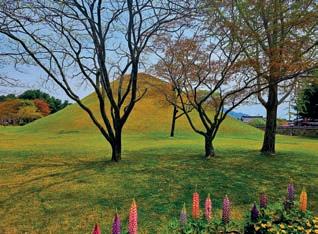
Of the city’s five royal palaces, north of here lies the grounds of Changdeokgung and Changgyeonggung, while further west is Gyeongbokgung.
South Korea’s official list of 354 National Treasures includes structures, statues, pagodas and texts. Many are on display at Seoul’s National Museum of Korea.The grounds of Gyeongbokgung are also host to the National Palace Museum, which contains many more.
Two UNESCO-listed fortresses to the south of Seoul hint at the struggles caused by Japanese invasions in the late 16th century. Namhansanseong was built as an emergency fortress capital in the mountains south-east of Seoul for besieged Joseon monarchs, while the city of Suwon,which is linked to the Seoul area by train, is surrounded by the mighty Hwaseong Fortress, whose stone bastions and walls were built to accommodate a new capital – a move that never came to fruition.
On the volcanic outlier of Jeju Island, you’ll find a different kind of culture.The island is one giant biosphere reserve, prized for its lava tube system, but it’s the traditions found here that catch the eye. Jeju’s Haenyeo are female divers whose traditional practice of free-diving for seaweed and shellfish is recognised by UNESCO for its Intangible Cultural Heritage. Finish your journey by learning more about them at Jeju Haenyeo Museum.


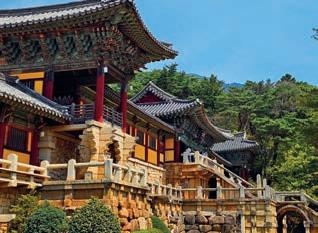
Step back in time (this page; clockwise from top) A golden belt that was worn by the Silla kings, which is on view in the National Museum of Korea; much of Bulguksa Temple was destroyed during a Japanese invasion in the 16th century, but it has been masterfully rebuilt; the 23 royal burial mounds of Daereungwon were built to house the Silla kings and their retinue; (opposite page; clockwise from top left) though it burnt down during the reign of the Joseon dynasty, Gyeongu’s Woljeonggyo Bridge was rebuilt in 2018 to become Korea’s largest wooden bridge; when Wolji Pond (Anapji) was drained for repairs, archaeologists found some 30,000 cultural artefacts; Gyeongju Gyochon Traditional Village is filled with traditional hanok houses that offer a glimpse of an older Korea; inside a Silla-era tomb in Gyeongju; the exterior of Woljeonggyo Bridge; (previous spread) Donggung Palace and Wolji Pond are beautiful at night

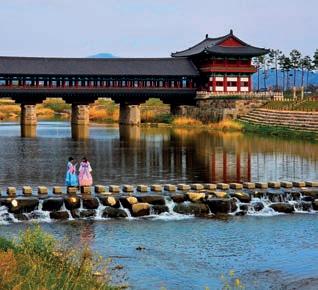



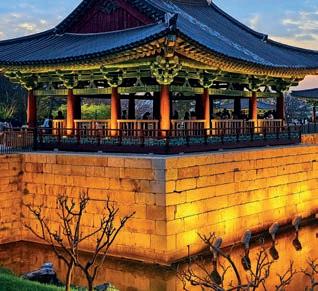

Top three experiences
1Discover a historic temple and grotto near Gyeongju
Bulguksa Temple lies hidden in the forests south-east of Gyeongju, lending it a rather mystical setting.The stone pagodas and gilt-bronze Buddha statues within are some of South Korea’s most striking, and are officially listed as NationalTreasures.The temple was originally constructed in 528 AD, although the current structure, with its jaunty stone staircase and bridges, was built on the hillside several hundred years later. At the same time, Seokguram Grotto, containing exquisite granite Buddha sculptures, was being carved into the mountainside nearby. Together, these joint-UNESCO-listed sites combine some of the finest Silla architecture to have survived, and the temple remains among the most important sites in Jogye Buddhism in South Korea. Highlights include the nine-pillared Museoljeon hall, the 10.4m-high Dabotap pagoda and the guardian deities that scatter the temple. eng.bulguksa.or.kr


2Wander the Korea of yesteryear at Hahoe Folk Village
Hahoe FolkVillage is not only a glorious showcase for Joseon-era architecture, which unravels all around you as you wander its quiet lanes, it is also a living community of people. Unlike other folk villages, which tend to be purposely preserved or restored, Hahoe has naturally remained unchanged over the last century, earning itWorld Heritage status alongside the village of Yangdong. Hahoe belonged to the Ryu clan for six centuries, a noble lineage that produced notable Confucian scholars and a prime
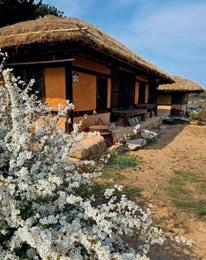
minister during the Joseon era. Among its 124 houses you can see simple thatched-roof peasant homes as well as wood-framed yangban mansions, with their fish-scale or ribbed tile roofs. At the heart of the village stands a 650-year-old elm tree, said to be inhabited by a goddess, onto which visitors pin scraps of paper bearing their deepest wishes.
Don’t miss the village’s Hahoe Byeolsingut Tallori mask dance. Part ritualised drama, part slapstick comedy, performances are held on weekend afternoons at the amphitheatre. Also look out for the Seonyu Julbul Nori fire festival, which takes place one night a year, usually in October. hahoe.or.kr

Ask a local
“What makes Korean temple life special? When I lived in Seoul, I started making temple food through my teacher, the head of Bongeunsa Temple. In temple cuisine, it’s important to convey the original taste of the ingredients, rather than pushing a sensational flavour. It embodies the spirit of non-killing and respect for life, which was transmitted with the introduction of Buddhism.”
WooKwan Sunim, Buddhist nun and author of the cookbook WooKwan’s Korean Temple Food


3Visit Seoul’s royal palaces
Seoul was made the capital of Korea at the start of the 500-year reign of the Joseon dynasty. As such, the city has a bounty of imperial palaces, with the oldest, Gyeongbokgung and Changdeokgung, built at the turn of the 15th century. The two palaces are set a kilometre apart in the north of the city, though Changdeok-
gung was favoured by the Joseon kings and is the best preserved; its throne-room and living quarters are still lavishly decorated.Within its grounds you’ll also find Changgyeonggung Palace, which was first built for KingTaejong by his son and successor King Sejong in 1418.
Regal opulence was often demonstrated by displays of nature, and Changdeokgung’s complex is impressively green, home to some

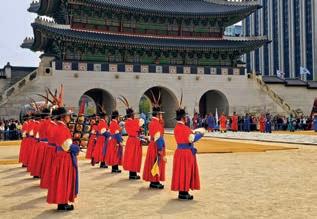

26,000 trees. Many are found in the Biwon (secret garden) behind Changdeokgung, alongside bridges and octagonal pavilions. After visiting the palaces, be sure to explore the Bukchangdong and Samcheongdong districts in between the two complexes, which are filled with remnants of Seoul’s traditional hanok houses, now home to many fine restaurants and boutiques. royal.cha.go.kr



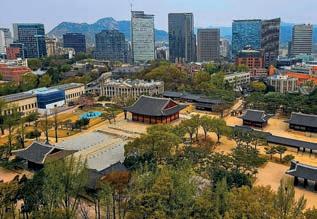

Historic Seoul (this page; clockwise from top left) Gwanghwamun Gate, the main entrance to Seoul’s Gyeongbokgung Palace, was restored to its former design last year, a century after it was damaged during Japanese occupation; Junghwajeon was the main throne hall in Deoksugung Palace; a guard at Gyeongbokgung; those wearing traditional hanbok get free entry to Gyeongbokgung; Deoksugung is one of five palaces built in Seoul during Joseon rule; the traditional streets of Seoul’s hanok village; blossoms in Gyeongbokgung; (opposite page) Hahoe Folk Village has stayed miraculously unchanged over the centuries
Into the Woods
Inhale the woody aroma of South Korea’s forest-shrouded mountain trails and the sea-salt air of the coast
Best for: Mountain trails, seasonal festivals, forest-temple stays, wildlife and coastal island parks
Why go: Thrilling hikes along welltrodden and maintained trails are the best way to experience Korea’s lively seasonal landscapes and mountain temples
Route: Jirisan; Changwon; Seoraksan NP; Bukhansan NP; Suncheon Bay Nature Reserve; Pyeongchang
Although 70% of South Korea is covered in mountains, these aren’t the ice-encrusted granite peaks of the Himalaya. Most are smothered in thick forest; indeed, some two-thirds of the country is covered in largely deciduous trees. Jirisan, at a mere 1,915m, is the mainland’s highest mountain and is characteristically lush, while South Korea’s highest point (only 32m higher) is the shield volcano of Hallasan on Jeju Island, where you can often spy wild deer grazing the sub-alpine forest leading up to its crater lake.
Given the rugged terrain, Koreans take hiking seriously, joining walking clubs and heading out with all the requisite gear.The

Jirisan RidgeTrail (45km) is one of the country’s classic dulle-gil (mountain trails).The ultimate example, however, is the 688km Baekdu-Daegan trail, which traverses its namesake mountain range from Samcheong (near Jirisan in the south) to the North Korean border. So sacred are these mountains, which run the length of the Korean peninsula, that pungsu-jiri, the local alternative to feng shui, holds that the nation’s energy stems from this range and radiates outwards.
South Korea during spring and autumn is a different world.Timing your visit to coincide with one of its nature-loving festivals will convince you of this. Cherry blossoms paint the forests pink, but nowhere celebrates the seasonal bounty quite like Jinhae Cherry Blossom Festival in Changwon. Another spring festival worth checking out is Gangneung Danoje, usually in May; expect shamanistic dancing and light-hearted rituals. Come autumn, the mountains turn orange and red. Like Jirisan, the valleys and peaks of Seoraksan National Park are criss-crossed with trails for every ability, including the scenic Biryongpokpo Waterfall Trail and the more challenging Ulsanbawi Rock Trail. Much simpler is the trail to Sinheungsa, one of many sansa (mountain temples) found across South Korea. These temples are ubiquitous and
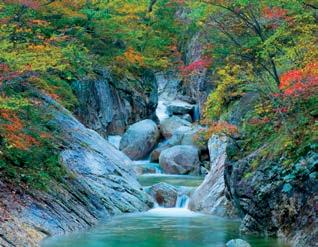
can be seen along many of the trails already noted. Some of the finest examples include the eighth-century Beopjusa and Haeinsa, where it’s possible to spend a few nights.
Although South Korea’s national parks are usually trickier to reach without your own transportation, good day hikes through Bukhansan National Park are accessible from Seoul. A trek up to the weathered-smooth rock formations and granite outcrops of Dobongsan is particularly rewarding, with expansive views over the sprawling capital.
Surrounded by sea on three sides, South Korea’s 2,413km of rocky coastline represents another wild frontier, characterised by traditional fishing villages where rows of squid hang on lines to dry in the sea breeze.The south coast is particularly wild, as the mainland fragments into thousands of islands. From Mokpo, it’s possible to take local ferries to Hongdo, a remote and rugged island within Dadohaehaesang National Park.
South Korea experiences the kind of long, cold, snowy winters that made it a good choice as aWinter Olympics host back in 2018, when the trails and pistes of theTaebaek Mountains, near Pyeongchang, became the focus of the world. Seonjaryeong in Gangwon-do is a particular haven for winter hiking, and you’ll find plenty of opportunities to don snowshoes and trek blanket-white trails.
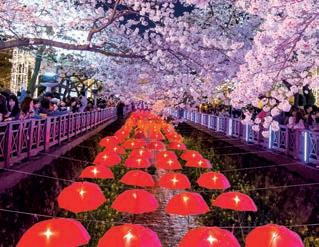
Alamy; Shutterstock
Korea in bloom (this page; clockwise from top left) Cherry blossom season tends to begin around mid-March in the southern regions of South Korea before moving gradually north; Jinhae Gunhangje Festival is the largest cherry blossom festival in Korea and was originally created to commemorate a famous general of the Joseon dynasty – its centrepiece is still a grand military street parade; Seoraksan National Park is home to more than 1,000 plant species; (opposite page; clockwise from top left) Jeju Olle Trail consists of 21 main routes that loop the volcanic island of Jeju, measuring 437km in total; hikers make the ascent up Jeju’s Hallasan, South Korea’s largest mountain, which has numerous routes to the top, though Yeongsil is the quickest (2.5 hours) and is a spectacular sight when its slopes fill with pink azaleas in spring; Hallasan is topped by the Baengnokdam crater, which spans 3km in circumference
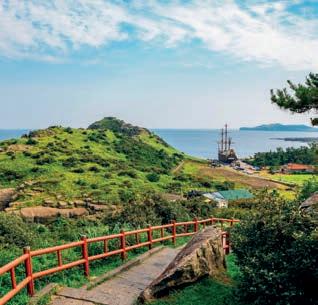
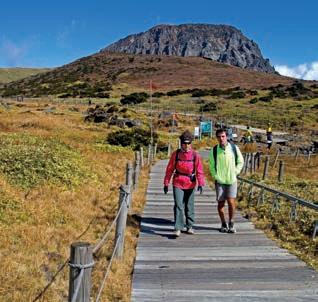

Top three experiences
1Trek to the summit of Hallasan volcano
Mount Halla (the suffix -san means ‘mountain’ in Korean) is the dominant feature of Jeju Island. Indeed, some would argue that the volcano is Jeju, given the island’s geological origins. Not only is
Hallasan South Korea’s highest peak, but summits can begin from sea level, making it by far the country’s largest vertical climb.
Different treks to the top suit walkers of differing abilities: the north and south routes are more difficult, while the well-paved east slope hike is easiest.The best time to attempt
the hike is in May, when the lower slopes, carpeted in azalea fields, bloom a bright pink.
A popular alternative hike is the Jeju Olle Trail, a 437km loop of the island that is broken into 21 main ‘routes’, plus smaller spurs such as Route 10-1, a simple 2.2km trek on tiny Gapa Island. juolle.org
2Multi-day hiking along the Jirisan Ridge Trail
Once upon a time, or so the old tales go, people came to Jirisan to seek the truth, living the lives of hermits on its slopes.When this became South Korea’s first national park in 1967, they began coming for the hiking, though the area still continues to hold a special place in local lore.
The challenging three- or four-day 45km Jirisan Ridge Trail scales the peaks of the Sobaek Range, several mountains of which top 1,700m. Part of the allure of hiking here is its impressive array of fauna,with elk and deer commonly sighted.The area is also home to the country’s only remaining wild population of Asiatic black bears (aka moon bears), part of a successful reintroduction programme.
On this and other multi-day treks in Korea’s national parks, it’s possible to spend the night in a daepiso, a simple mountain shelter that must be booked in advance (they usually rent blankets too). Some, such as Byeoksoryeong Shelter – which is worth aiming for on you’re first night on the Jirisan Ridge Trail – have space for more than 100 people. reservation.knps.or.kr/foreigner/main.do

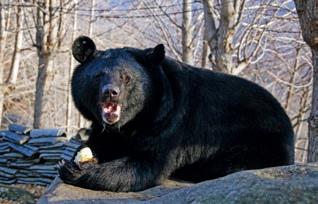
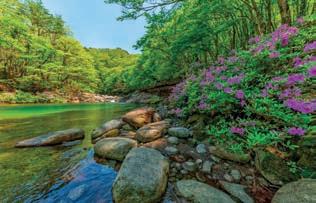
Hitting the peaks (this page; clockwise from top) In 1967, Jirisan became the first national park to be established in South Korea and is scattered with several peaks topping 1,000m, making it popular with hikers; the park is especially beautiful in spring; a handful of Asiatic black bears were first reintroduced to Jirisan in 2004 – just 20 years later, 86 wild bears now roam here; (opposite page; top to bottom) the 81,000-plus woodblock scriptures of Haeinsa make it one of the most remarkable temples to visit; the peaks of Gayasan National Park are typical of the lush but mountainous terrain that makes up much of South Korea Alamy; Shutterstock

3Slow things down with a Haeinsa temple stay
Many visitors seek out the forests of South Korea to take a walk through the proverbial woods of the mind. A temple stay such as Haeinsa, about an hour from Daegu by bus, is the perfect way to escape the city hustle; its location, in the remote forests of Gayasan National Park, is also beautiful. Just don’t turn up on a whim and expect to find a bed; stays are generally limited to a few select nights of the year.
Part of the experience includes sampling Korean temple cuisine, a zero-waste, organic food movement whose origins can be traced back 1,700 years.The star attraction, however, is the Janggyeong Panjeon, a depository of theTripitaka Koreana, the most complete collection of Buddhist texts, laws and treaties in Hanja script. Its collection, engraved onto some 81,000 wooden blocks during the 13th century, has miraculously survived numerous wars and fires throughout the centuries. eng.templestay.com

Ask a local
“As you look over the geography of the Korean Peninsula, you understand why Koreans like hiking so much. Korea has no worldfamous mountains, but it has beautiful trails with wonderful views of rocky ridges and friendly forest. I love hiking Bukhansan National Park in Seoul. When I have time, and my spirit pulls me strongly, I explore Seoraksan, Jirisan or Hallasan.”
Jeong-ho Park, founder of Seoul International Hikers Club, runs group hikes via Facebook ⊲



From Hanbok to Hallyu
Ride the wave of Korean culture, from past traditions to modern-day music and film
Best for: K-pop, TV and movie filming locations, traditional arts and cultural festivals
Why go: Soak up Hallyu, the popular cultural phenomenon also known as the Korean Wave, at live K-pop shows and modern art collections, and embrace Korean traditions at annual festivals
Route: Seoul; Yongin; Chuncheon; Busan; Yeosu
Much of South Korea’s traditional culture was forcibly wiped out during Japanese colonisation, surviving only in remote villages and temples ensconced in the mountains.Today, those customs are embraced with a national fervour, particularly at modern annual festivals such as Seoul Lantern Festival in winter, as well as lunar calendar celebrations such as Chuseok, the mid-autumn harvest festival that involves ancestral memorial services and rituals, which you can witness at Seoul’s National Folk Museum of Korea. A good place to catch traditional dance and music performances around Seoul are at folk villages such as Namsangol HanokVillage
on the lower slopes of Namsan, which is topped by a landmark tower. In the capital, performances of gugak (traditional Korean music) and various national dances are held throughout the year at Seoul Arts Center complex, which includes the National Gugak Center and Seoul Calligraphy Museum. You can still find stores selling seoye (Korean calligraphy) supplies alongside handmade hanji paper amid the teahouses and restaurants of the city’s Insadong neighbourhood. Next, visit Gangnam, the upscale district that inspired a different kind of dance (invented by superstar Psy),which opened the door for K-pop to gain greater global recognition. Major K-pop concerts often take place at Seoul’s KSPO Dome and Gocheok Sky Dome, as well as the Inspire Arena in Incheon. Head south to Yongin, a satellite city of Seoul whose Korean Folk Village has appeared in many localTV dramas.Throughout the year at folk villages and palaces across South Korea, you’ll see people dressed in traditional hanbok (Korean clothing), typically a two-part ensemble decorated with elaborate patterns. In fact, don hanbok to visit Gyeongbokgung or Changdeokgung palaces and you’ll be allowed to enter for free.This style of dress has even become well known globally, thanks to the meteoric rise of K-dramas.

Known as Hallyu (aka the KoreanWave), Korea’s prodigious output ofWestern-influenced K-pop and K-dramas over the past decades has placed it in the global cultural zeitgeist.This phenomenon began in the early 2000s with series such as Winter Sonata (2002), filmed on Nami Island, near Chuncheon, which gained widespread popularity across Asia. Filming locations have put many areas on the tourism map, particularly in Busan, South Korea’s second city.
Thanks to its beach lifestyle, Busan is decidedly laid-back compared to Seoul, with trendy restaurants and a lively nightlife scene.This is especially true of the white sands of Haeundae Beach, which have featured in everything from The King: Eternal Monarch to Hollywood’s Black Panther
Around three hours east of Busan, Yeosu is the latest city to attract visitors on K-drama pilgrimages.Top cultural attractions include Arte MuseumYeosu, the street art of Angel Mural Village and AdmiralYi Sun-Shin Square. At the latter, you’ll find a statue of the Korean seafaring hero, subject of numerous period dramas, including The Admiral: Roaring Currents, plus a replica of one of his revered turtle ships (Joseon-era battleships).



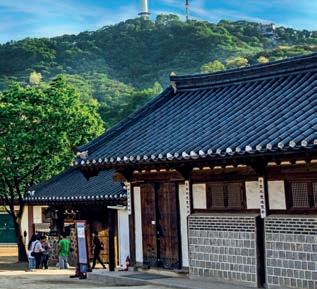
Off screen (this page; clockwise from top) The TV series Squid Game is one of South Korea’s most popular cultural exports; one of the traditional buildings in Namsangol Hanok Village; a monument to the breakout success of the song Gangnam Style in Seoul; (opposite page; clockwise from top) a GangnamDol of BTS on Seoul’s K-Star Road; Jogyesa Temple’s Lantern Festival; the view from N Seoul Tower; K-Star Road is home to many of Korea’s biggest entertainment companies



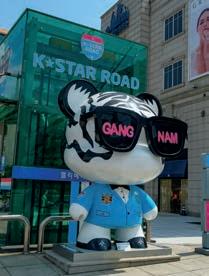


Top three experiences
1Take in the view from N Seoul Tower
N Seoul Tower is a national landmark that has featured in many Korean dramas and movies. The mountain it crowns, Namsan (meaning South Mountain; 243m), lies at the core of the capital, and its parkland is covered in forest and bisected by parts of the old city wall. Cable cars run to the summit from Myeongdong, the commercial district synonymous with Hallyu and home to the Star Avenue tunnel, a local take on Hollywood’s Walk of Fame with walls boasting signed celebrity handprints.
The tower practically doubles the mountain’s elevation, giving you panoramic views of Seoul from the viewing platform. From here it’s possible to see the mountains cradling the city to the north and the broad sweep of the Han River to the south. If you’re feeling peckish after all that walking, pay a visit to Korea House, a traditional Korean restaurant in a heritage building just outside Namsangol Hanok Village. nseoultower.co.kr

2Get a taste of the Korean countryside on Nami Island
To visit the beautiful nature reserve of Nami Island (aka Namiseom), take a train from Seoul to Gapyeong, near Chuncheon, then walk to the wharf to catch a ferry – the island is man-made and lies right in the middle of the Han River.Your ticket is a mock visa to the ‘Republic of Naminara’, since the island playfully styles itself as a cultural micronation.The more adventurous might consider arriving by zipwire, flying over the riverside and water for nearly a kilometre.
On Nami, the absence of traffic allows nature to reign. Lanes are lined with ginkgo trees that turn pink in spring and yellow in autumn. It’s perhaps what attracted all the film crews, and signs across the island point out locations where key scenes from the K-drama Winter Sonata were filmed.
Slightly north of Nami is Jade Garden, where dozens of other K-dramas and movies have been shot, including That Winter, the Wind Blows. Chuncheon is also seen as the gateway to the Korean lake district, a series of reservoirs created by dams along the North Han River. namisum-en.imweb.me

Ask a local
“Whether you are a big fan or just interested in K-pop and other Korean pop culture, Songdo (near Incheon) is often used as a filming location for Korean dramas, movies and music videos – especially Songdo Central Park and around Triple Street and the Tri-bowl. When you visit, you can see how the global and the local are blended in an ultra-modern environment, which is one of the main characteristics of K-Pop, and even of South Korea itself.”
Gyu Tag Lee, associate professor at George Mason University and K-pop expert


Alamy; George Kipouros
3Visit South
Korea’s
second city
During the fighting phase of the Korean War (1950–53), Busan became the de facto capital of the south.Today it exhibits much of the same modern spirit as Seoul but enjoys a distinct character defined by its links to the sea.You can even see this in the city’s cultural scene – whether in the stone bridges
and lantern-strung courtyards of Haedong Yonggungsa temple on the headland, or in the National Maritime Museum.
Many come just to see Jagalchi Fish Market, the most-visited market in the country, or style it out on the city’s beaches, which have featured in countless films. Even the train journey to Busan from Seoul spawned its own zombie-horror movie franchise.
Inland, forest-clad mountains give way to artistic communities such as Huinnyeoul and Gamcheon culture villages, where brightly painted homes and murals have transformed these formerly rundown areas. And don’t forget to unwind at one of Busan’s legendary spas, set over multiple floors, including SPA LAND Centum City and Heosimcheong Spa. busan.go.kr
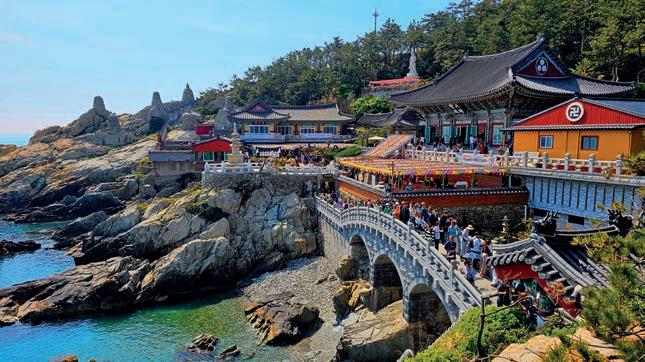
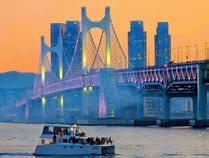

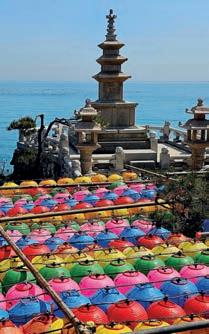


The second city (this page; clockwise from top) Busan’s Haedong Yonggungsa is one of few temples on the coast; it’s no wonder the seafood in Busan is so good, since the city is home to the largest fish market in South Korea; the stylish sands of Haeundae Beach; colourful Haedong Yonggungsa; Gamcheon is known as the ‘Santorini of Korea’; Busan’s Gwangan Bridge is 7.4km long; (left page; top and bottom) the autumnal colours of Nami Island make it a staple location in K-dramas
Overlooked cities and wild frontiers
Discover the sides of South Korea that most visitors miss, from rolling tea plantations to groundbreaking museums, plus the wilder stretches of the Korean Demilitarised Zone
Best for: Science and history museums, historic gardens and palaces, food festivals and the DMZ Why go: Experience South Korea’s natural and cultural riches away from the main tourist trail, including secluded chapters of Korean history, a science-centric city and beautiful nature, as well as a hands-on kimchi-making festival
Route: Gwangju; Jeonju; Daejeon; Daegu; Yanggu
Joseon kings and queens loom large in the South Korean imagination. And while most visitors speed between Seoul, Gyeongju and Busan on the high-speed rails, some of the country’s most cultured and picturesque cities are overlooked entirely.
Gwangju is the perfect example, home to a National Museum that depicts a crucial piece of South Korea’s past in its collection of Joseon dynasty scroll paintings and Neolithic relics. For fans of kimchi, be sure to stop by in early autumn for the annual
Kimchi Festival, where you’ll find plenty of cookery classes and the opportunity to try just about every conceivable variety of South Korea’s favourite dish.
Next, grab a bus north to Jeonju, a UNESCO City of Gastronomy, where Korean cultural tradition still looms large. See how traditional Korean paper is made at the Hanji Museum, then explore crafts such as woodworking and ceramics at the Korea Traditional Culture Center. Balance this out with more modern examples of local creativity at the Factory of Contemporary Arts.

Next, hop on a train to Daejeon to discover Korea’s own SiliconValley. Daejeon is a city that once thrived thanks to its rail connections in the early years; now it’s known as the ‘Science City’, with sights including the National Science Museum and the imaginative structures at Daejeon Expo Science Park. Daejeon Museum of Art is also one of the country’s best contemporary art museums, and features Nam June Paik’s modern take on a ‘turtle ship’ (a type of warship built
during the Joseon era), constructed entirely from video screens. From Daejeon, cross-country trains run east to Daegu, which is South Korea’s fourth-largest city (after Seoul, Busan and Incheon). Nowhere else in the country better exhibits the Korean dichotomy between traditional rural values and 21st-century urbanity. On the one hand you haveYakjeon Alley and the Museum of Oriental Medicine, which both explore traditional medicine in a medley of pungent ingredients; on the other hand you have some of Korea’s most raucous nightlife around Seomun Shijang, a traditional street market. Finish inYanggu, which is best reached from Seoul and is one of the finest places to see the autumn leaves in South Korea. It is also only a few kilometres south of the Demilitarised Zone (DMZ) that separates North Korea, and this remote and mountainous spot was the site of some of the KoreanWar’s most brutal battles.This history can now be explored on eye-opening tours and treks.
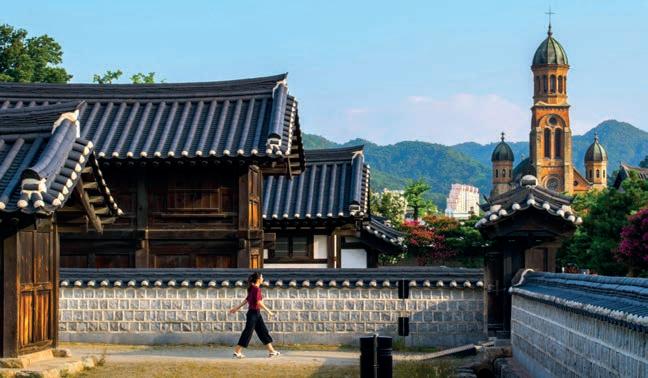
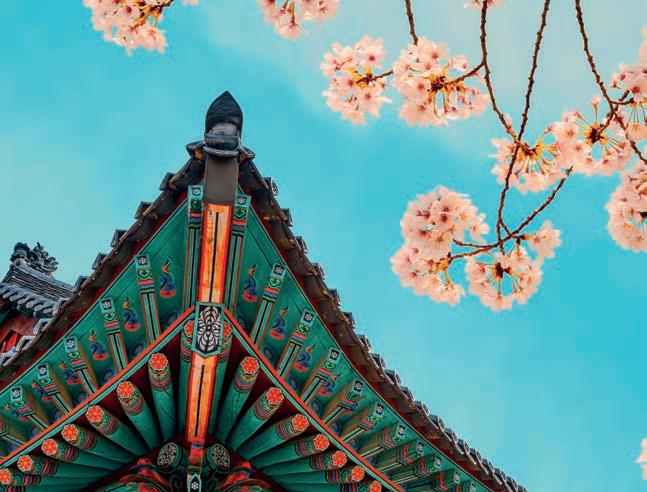
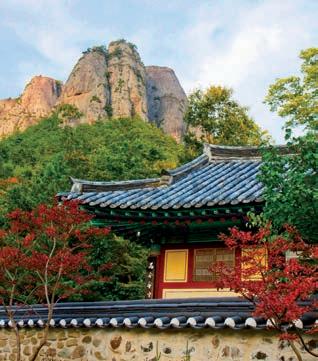
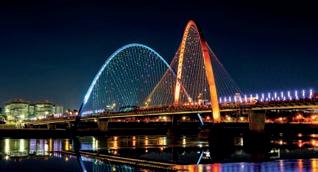
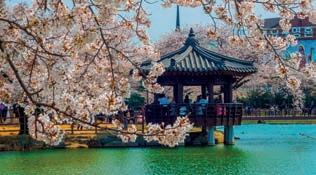
Missed gems (clockwise from top right) There is so much to admire about traditional Korean architecture, not least its decorated eaves; the Expo Bridge of Daejeon spans the Gapcheon River and is lit a dazzling red and blue at night; the blossoms and lakeside temples of Gwangju make it a scenic jumping-off point; Juwangsan mountain towers over Daejeon temple; Jeonju is home to the largest hanok village in South Korea; don’t miss the kimchi festival in Gwangju



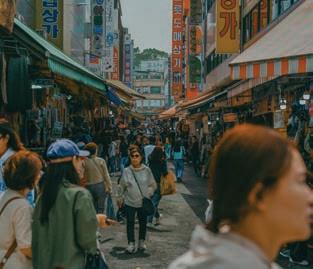
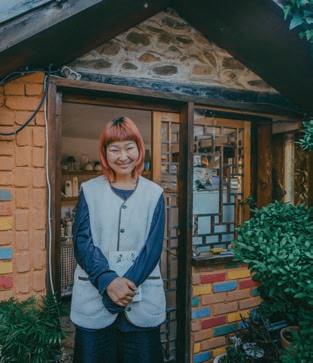
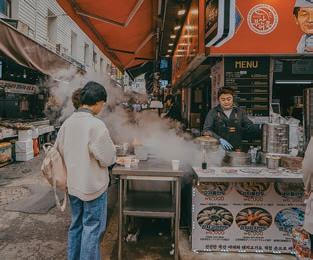

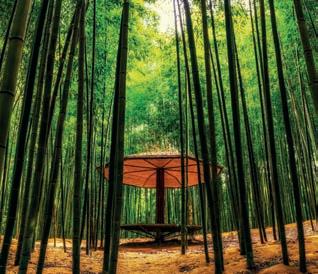

Top two experiences
1Take a day trip from Gwangju
From Gwangju there are plenty of examples of greenery to explore. It’s impossible to miss nearby Mudeungsan, a trail-covered mountain that overlooks the city; its slopes offer excellent views across the surrounding countryside.
To the north-east of Gwangju, Damyang is the country’s centre of bamboo cultivation.The Bamboo Museum there explores the many uses of this versatile plant, and the towering bamboo forest outside makes for some excellent photo opportunities.
Visits to the Boseong tea fields south of the city take in the verdant tea bushes that contour the hillsides; its GreenTea Festival usually takes place in May.And to the east lies Soswaewon Garden, a Joseon-era garden that is an oasis of peace. gjcity.go.kr

Wild country (clockwise from top left) Green tea has been cultivated
over from China; the vast bamboo forest of Damyang takes your
its highest peak, Cheonwang-bong (1187m), offering great
on the terraces of the Boseong tea fields since the seventh century, when it was first brought
breath away; Mudeungsan National Park sprawls the fringes of Gwangju, with trails leading up
panoramas of the surrounding area; the hikes of Mudeungsan lie just 30 minutes’ drive from the city



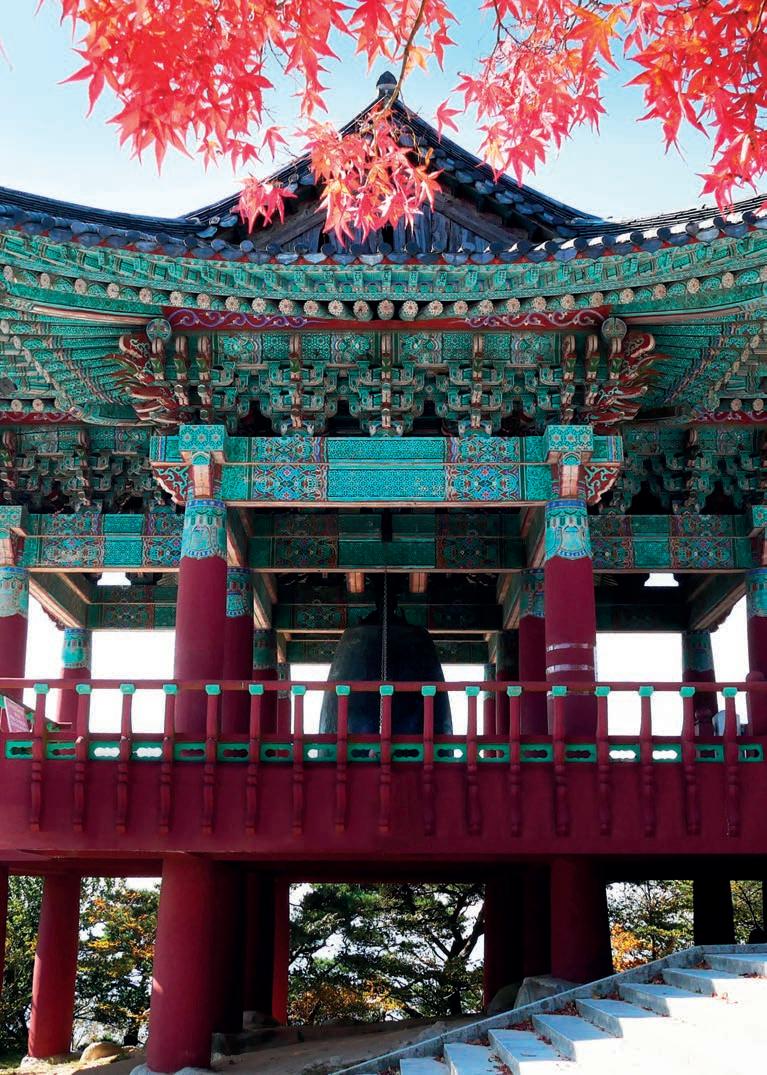
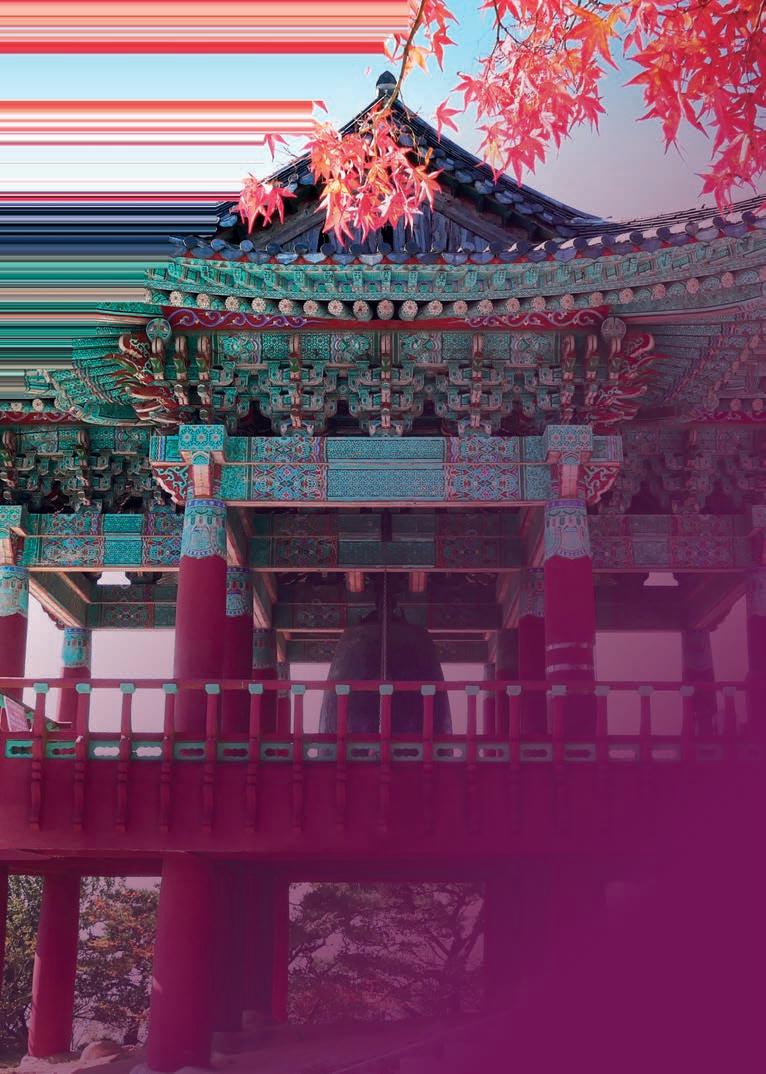

2Visit a stretch of the DMZ
The Demilitarised Zone (DMZ) is a living piece of unresolved history. Running the width of the Korean peninsula, this military zone, little more than 4km wide, separates two very different nations that were united until the post-SecondWorldWar break up of the Japanese Empire, when the north surrendered to Soviet troops and the south to the US. YangguWar Memorial Hall, located in the town, is a memorial to those who fought in the KoreanWar that followed. Head north and you’ll encounterThe FourthTunnel, dug beneath the DMZ by the North Korean Army, and Eulji Observatory,which gazes across to the Hermit Kingdom. For the best views, get out on the 73km DMZ Punch Bowl Trail, which traverses mountains named after the fierce battles fought there. dmz.go.kr
Need to know

Whentogo
Any one of South Korea’s four seasons is a delight, but the splendour on display during spring and autumn make these months the stand-outs. The weather is especially friendly to hikers, with dry, warm spells and little rain.
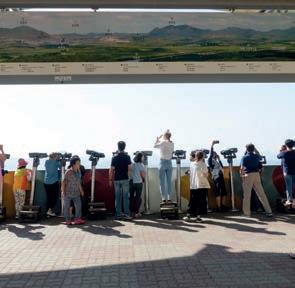

To catch the cherry blossoms, visit between mid-March and early April. Jeju usually leads the way, with the blossoms moving north with the onset of spring. The reverse is true of autumn foliage, which starts in October up in the north and continues south into November, with the peak for Seoul usually during the last two weeks of October.
The country experiences a vast swing in temperatures between winter, when it can reach -20°C, and summer when temperatures rise into the 30s (°C). Summer sees by far the most precipitation.

Gettingthere &around

Carbonoffset
A return flight from London to Incheon-Seoul produces around 760kg of carbon dioxide per passenger. Wanderlust encourages you to offset your travel footprint through a reputable provider. For advice on finding one, visit wanderlustmagazine.com/ inspiration/sustainable-travel.

Currency&visa

Korean Air (koreanair.com) and Asiana (flyasiana.com) operate the only direct flights between the UK and South Korea. These depart London Heathrow for Incheon International Airport, which is 45 minutes by express train from Seoul. Flights cost from around £800 return and take from 12.5 hours.


Although the Korea Trains (KT; koreatrains.com) rail network is limited somewhat by the mountainous nature of the country’s terrain, modern high-speed trains (KTX) reduce maximum travel time along the entire length of the country to under three hours.
The cities of Seoul, Busan, Daegu, Daejeon, and Gwangju all have metro networks. Seoul’s is one of the most modern and extensive in the world, with 768 stations across the wider capital area. The country’s bus network is vast, although can require some ability in reading Korean to decode the destinations.
Currency: Korean won (KRW), currently around KRW1,750 to the £UK. Visa: UK nationals can visit visa-free for up to 90 days. It may be necessary to get electronic travel authorisation, known as a K-ETA, in advance when the rules are reviewed in December 2024. For longer stays, anybody earning over $64,000 (£50,600) per year can apply for a two-year digital-nomad visa.

Further information
english.visitkorea.or.kr –The official website of the Korean Tourism Organization is a good starting point for building your itinerary.
Award-winning tour operator
TransIndus offers a rangeoftailor-madeand grouptrips to South Korea, including the nine-day Essence of South Korea tour, which is priced from £4,395 per person. Book at transindus.co.uk/south-korea
SEOUL Suwon Yongin
Chuncheon Pyeongchang Incheon
Daejeon Jeonju South Korea
Gwangju Busan Changwon Daegu Daegu Andong Yanggu Yeosu
Jeju Island
Looking north (top to bottom) The Dora Observatory is one of a handful of lookouts lining the southern side of the DMZ, offering a far-off glimpse into the Hermit Kingdom of North Korea; the site of one of four tunnels discovered beneath the DMZ since 1974, which were all part of North Korean attempts at infiltration – you can now visit them on tours Alamy
Gyeongju

Beat the end-of-summer blues in
BORDEAUX
Visit the Bordeaux region in September to see the city at its most colourful, the grape harvest in full swing and an uncrowded coastline still warm enough to take a dip in...
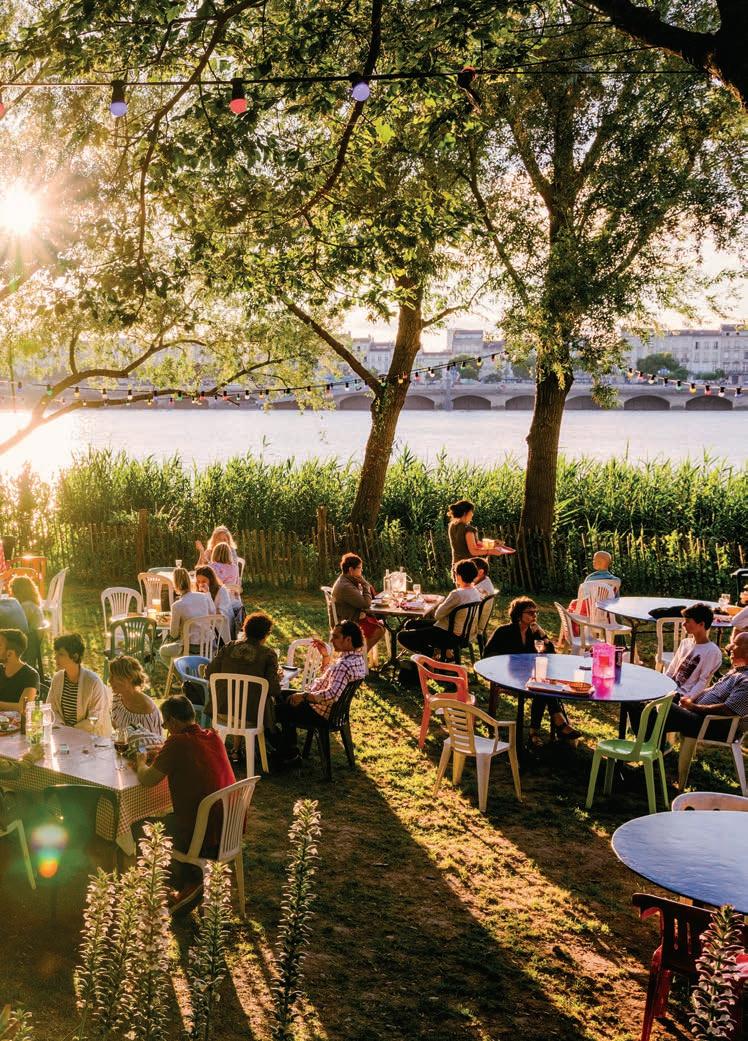
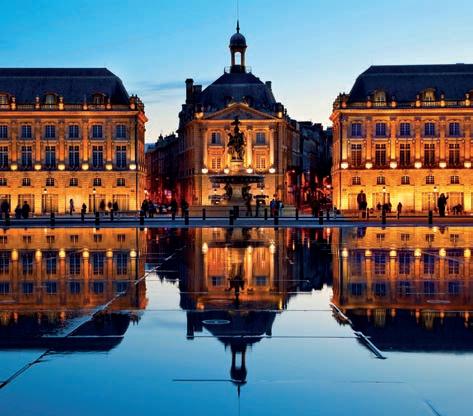
THE CULTURAL WAY
Explore the city Mild climes and lashings of sun make the end of summer a fine time to visit the city of Bordeaux. Marvel at UNESCO-listed sites and Gothic and Neo-Classical architecture, then stroll the vineyards that lie 30 minutes from the city centre, or head to the beaches that fringe the coast just 50km away.
For some of that classic French art de vivre, the city provides the ultimate combination. Meanwhile, Bordeaux’s firm commitment to sustainable development and living endears it to lovers of slow and green travel.
Here’s what to expect from the rest of the region come September.
Go back in time
Of Bordeaux’s six wine regions, Entredeux-Mers and Blaye and Bourg stand out for their small, family-run estates; the kind of places where you might be welcomed with a glass by the owners themselves. They also have a rich history that goes far beyond wine.
Entre-deux-Mers is known for its bastides (fortified towns), among them Créon with its 14th-century arcaded square where a local-producers’ market takes place. Bourg stands out
for its upper town, whose medieval fortifications, ancient houses and citadel make for a charming stroll.
Elsewhere, the World Heritagelisted wine village of Saint-Émilion has underground quarries to explore. These are the remnants of mines that were dug for extracting the sandstone used to build the ancient town. An early 12th-century church, whose three naves and small catacombs were cleaved into the rocky hillside, is formed from a single monolithic monument and is just one of the highlights that you’ll find here.
Find more architecture in Arcachon, a bewitching seaside resort where you can enjoy a guided tour of the Belle
Art in architecture (this page; top to bottom) The water mirror at the foot of the Place de la Bourse has been reflecting the surrounding 18th-century buildings since 2006; Arcachon’s Ville d’Hiver, translating to Winter Town, features a collection of eccentric villas built in the 19th and early 20th century
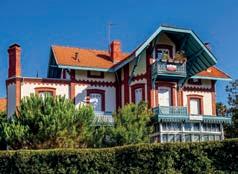
Époque villas, Swiss chalets, Gothic manors and Moorish pavilions of the Ville d’Hiver (Winter Town), constructed for convalescents in the 19th century. Look out too for quirky balconies, turrets and Neo-Classical facades.
Back near Libourne, the Château de Vayres is a mesmerising mix of medieval, Renaissance and 17th-century architecture on the banks of the Dordogne river. And on the eastern side of the Gironde estuary, Blaye has a spectacular citadel that is best discovered on a guided tour.
For an immersive experience, head to Château de La Brède, a Gothic castle once home to philosopher Montesquieu. Eight of its buildings are classified as historic monuments and the old farmhouses and stables have been transformed into an event space where you can enjoy themed talks and candlelit evenings.
THE EPICUREAN WAY
Meet the winegrowers
The Bordeaux region is full of winegrowers to visit; some are upmarket and famous, others more under-the-radar, but all are friendly.
Among the exceptional tasting experiences are those held at Monconseil-Gazin in Plassac, ten minutes from Blaye. One of the oldest wine-producing properties in the area, it’s now run by a fifthgeneration winemaker.
In the heart of Entre-deux-Mers, the Domaine Grand Jour is equally intimate and welcoming, while in the Fronsac wine-growing region, Château de la Dauphine offers the rare chance to see an 18th-century castle interior in addition to hosting workshops, picnic visits, environmentally educational nature tours and even Citroën 2CV heritage tours and microlight flights.
Meanwhile, the wine school at the Maison du Vin in Saint-Émilion has guides running sensory wine tastings.
For something different, head to Château Prieuré Marquet in Libourne to horseride through the vines.
Back in the city, don’t miss the Cité du Vin. This cultural centre offers a state-of-the-art, immersive journey through the history and science of wine around the world including the Via Sensoria tasting trail.
Get hands-on with food
As well as learning more about wine, you can opt for some special foodie


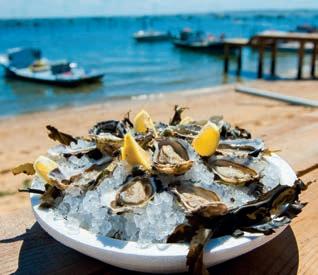
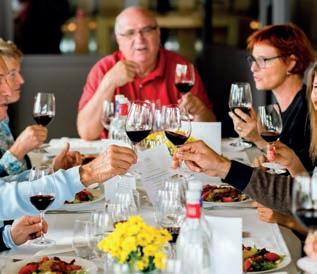
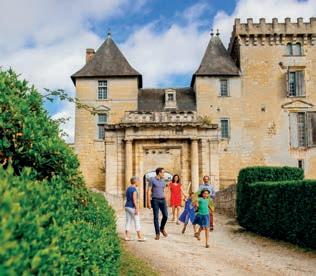

Wine and dine (this page, clockwise from top left) The Dune du Pilat is the highest dune in Europe; at Château Chauvin you can eat lunch with the winemaker; Château de Vayres in Libourne is a medieval castle that has been classified as a Historic Monument; Château Haut Pourret is just one of the many vineyards that can be found in Saint-Émilion; Arcachon Bay is the perfect place to feast on local seafood; meet Rémi Lamerat, a former professional rugby player who owns the Domaine Grand Jour in Entre-deux-Mers, for a walk around his vineyards
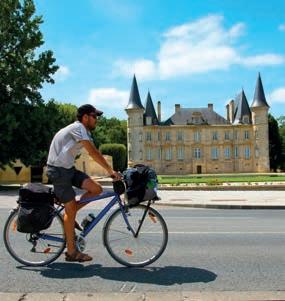
experiences in this region. In Arcachon Bay, gourmet cruises aboard a traditional boat invite you to savour fresh local oysters, prawns and other seafood as you float past oyster beds, cabanes tchanquées (stilted cabins), the villages of Cap-Ferret and the Dune du Pilat, Europe’s tallest sand dune. Or at the family-owned estate of Château Roquefort, you can take a cookery class in the orangery with chef Olivier Straehli, then join a convivial table to share dishes accompanied by the château’s wines.
Pair fine food with views
Much of the charm of visiting this region consists of simply taking your time over a meal in an atmospheric
The great outdoors (this page; clockwise from top left) Weave between the vineyards of the 19th-century Château Pichon Baron on a cycle tour; the glasslike waters of Arcachon Bay are perfect for windsurfers; the medieval village of Saint-Émilion is named after the legend of a monk who fled Vannes and found refuge in one of the natural caves here in the 8th century
spot. Many of the city of Bordeaux’s squares are lined with inviting restaurants, cafés and wine-bar terraces; the likes of Place du Palais and Place Fernand Lafargue make for great spots to drink in the sights.
In coastal Saint-Vivien-de-Médoc, north-west of the city, La Petite Canau serves up fresh seafood accompanied by glorious sunset views, while the proud owners of Domaines de la Parrhèsia in Beautiran in the Graves region south of Bordeaux have given its Château du Tuquet a new lease of life for the 2024 season by opening a guinguette (tavern) in its grounds, offering traditional local dishes and hosting pétanque, sports matches, concerts and dancing.
THE NATURAL WAY
Take to the water
This is a region for getting out on the water. With its long sandy beaches, Arcachon is adored by fans of watersports for its kitesurfing, windsurfing, kayaking and sailing, accompanied by views of Arcachon Bay and the Cap Ferret peninsula. It also has plenty of watersports schools that can teach the basics. Alternatively, hop aboard the pinnace (traditional boat) Lou Pinassotte on Hourtin-Carcans lake for a leisurely cruise, including a picnic or aperitif and a stop-off for swimming.
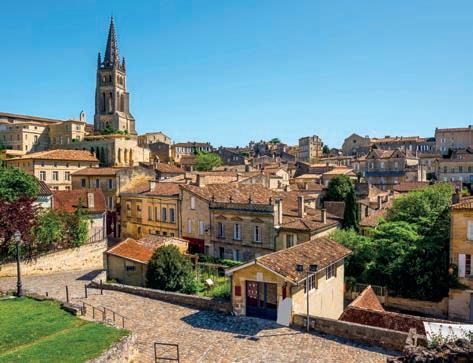

Or head for the natural pools between Verdon-sur-Mer and Soulac-surMer instead, which were created as defences against erosion and are filled with blissfully warm water at low tide.
Watch wildlife
Surprising wildlife can be found in Bordeaux, especially at Pereire Beach in Arcachon Bay, which is rich in crabs, prawns, sea urchins and fish. A guide will help you to identify the species that inhabit this fragile ecosystem, as well as teach you about preserving biodiversity and pass on some eco-responsible things to do on the beach while communing with nature. Over at the Terres d’Oiseaux ornithological park, one of the last reedbeds on the Gironde Estuary, you can spot rare birds such as reed buzzards, herons, storks and snipe.
Hit the trails
Walking routes and bike paths thread the Bordeaux region, enticing hikers and cyclists. The Bordeaux GR (Grande Randonnée) footpath runs for 160km across 17 communes, crossing parks, forests, plains, hillsides, rehabilitated riverbanks and preserved marshes. For a bike ride with a cultural edge, Saint-Émilion’s Remarkable Architecture loop combines vineyards, châteaux and churches over 19km. You can also try out the first vélorail in Gironde – a uniquely French bike track on a historic rail line from Guîtres station, taking you on a 16km roundtrip. Or why not walk between a pair of wineries? The Jounel family’s two estates, Château Couloumey and Château Le Tuquet, are a two-hour stroll apart through forests and vineyards. You can even bookend your walk with wine tastings.
Alamy



ADDRESS BOOK
Take note of these recommended eateries and accommodations ahead of your visit
BASSIN D’ARCACHON
Sleep
Les Villas de la Ville d’Hiver
Stylish villas in Arcachon’s Winter Town: one with two bedrooms, the other with four bedrooms and a pool. villasvilledhiver.com
Eat
Le Patio Thierry Renou
Discover Michelin-starred cuisine near the beach. The menu, which has been given an Asian twist, is heavy on local ingredients and seafood. lepatio-thierryrenou.com
BLAYE & BOURG, TERRES D’ESTUAIRE
Sleep
Clos Marcamps
A chic five-bedroom guesthouse in the heart of the Bordeaux vineyards, set in fabulous grounds dotted with centuries-old trees and a pool. closmarcamps.fr/en
Eat
La Citadelle
This restaurant in a Logis de France hotel serves inventive south-west cuisine accompanied by glorious Gironde sunset views. logishotels.com/en
BORDEAUX
Sleep
Mondrian Bordeaux Les Carmes
A cosy, chic hotel in a former winery in Chartrons. It has a
in Chartrons. It has a destination Japanese restaurant, courtyard garden and spa book.ennismore.com/hotels/ mondrian/bordeaux
Eat
Les Récoltants
A no-waste restaurant without a menu, offering daily specials based on ingredients from its organic farm (20km away) as well as other local producers. lesrecoltants.fr
ENTRE-DEUX-MERS
Sleep
La Maison d’Orion
A welcoming one-bedroom cottage with original features in the medieval heart of La Réole on the Garonne. maisondorion-lareole.fr
Eat
La Bonne Table
Situated at the foot of the Château de Camarsac, this restaurant serves up food that has been grown on their very own farm so fresh, local produce is a guarantee. labonnetablecamarsac.fr
LIBOURNE
Sleep
La Maison Mulato
This serene guesthouse, just a few minutes from Saint-Émilion, has indoor and outdoor pools and a little gem of a spa. lamaisonmulato.com
Eat
Restaurant Lune
MÉDOC ATLANTIQUE
Sleep
Le Tedey
A lakeside campsite near the surfing resort of Lacanau Océan. campingletedey.com
Eat Sunrise
Expect sunset views of Lake Lacanau and a menu ranging from poké bowls to a modern twist on the classic magret de canard sunriselacanau.com
SAINT-ÉMILION
Sleep
Château Hôtel Grand Barrail
A five-star hotel set amid the vineyards of Saint-Émilion, with upscale dining and a Sothys spa. grand-barrail.com
Eat
Restaurant Le Tertre
A famous and creative eatery in the heart of the medieval village. restaurantletertre.com
TERRES DE MONTESQUIEU
Sleep
Le Lodge des Pessac Léognan
A wooden cabin set in nature, complete with an outdoor hot tub, shower and a mini wine cellar. lelodgedespessacleognan.com

An ancient inn transformed into a prime venue for refined, contemporary dining. It lies only a few steps from the Château de Vayres. restaurantlune.com


Eat
O’Bouche à Oreilles/O’bo Bar
A convivial spot in Martillac, south of Bordeaux, with alfresco dining. obo-bar.fr


FRANCE Active
With the Olympics taking over Paris and beyond this summer, we pick 20 ways to get outdoors in France –from riding a vintage moped through the vineyards of the Loire to sailing the gulf off southern Brittany
Compiled by Nicola Williams
1Wander contemporary art and historical sites in Nantes, Pays de la Loire
Explore the history and culture of the handsome city of Nantes, the Breton capital until 1532, by taking a 19km urban walk, following a pea-green line painted underfoot.
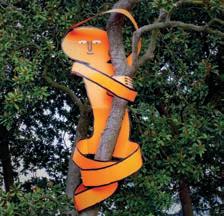

Known as LeVoyage à Nantes, this whimsical trail (levoyageanantes.fr) zips up staircases and alongside the Loire river, crossing café terraces and squares, wandering courtyards and the walls of Nantes’ mighty Château des Ducs de Bretagne (pictured below), and even pays a visit to a heritage biscuit factory.
Join the dots to explore 120 outdoor art works and dozens more ephemeral installations while dipping a toe in local history.To get started, pick up trail maps at the tourist office, go online or just look for the green line. Also try… Keep an eye out for urban walks in Lille, Grenoble and Clermont-Ferrand.

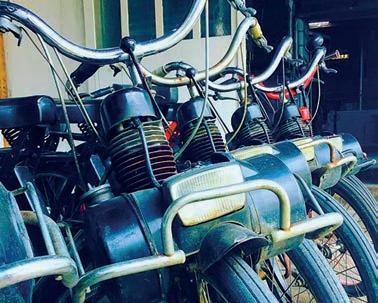
2Cruise through the vineyards of the Loire Valley on a vintage moped



Purring past vines on the back of an old Solex is exhilarating. At the Domaine de Pied Flond winery (piedflond.fr), near Angers, seventh-generation winegrowers Franck and Catherine Gourdon run moped tours of their estate.With no licence required to join, they’re open to anyone. Solex bikes were built between 1946 and 1988 in Normandy, and gained a certain cinematic cool in the ’70s when they were ridden by the likes of Brigitte Bardot and Steve McQueen. It’s a stylish way to explore the vineyard, with stops explaining how overripened chenin blanc grapes are made into naturally fermented AOC Coteaux du Layon wines, culminating in an all-important tasting session at the end. Also try… Head to the hilly Lubéron area of Provence for vineyard tours by Citroën 2CV or hot air balloon.

Try coasteering on Brittany’s Presqu’île de Crozon
Head-spinning sea views, dramatic rock formations and the odd sea cave or seal sighting are the rewards for scrambling the cliffs of the Crozon peninsula on coasteering trips. This craggy headland was once a nefarious place, and the route that customs officers used
to patrol, searching for smugglers and ensuring shipwrecks washed up from the Iroise Sea weren’t picked clean, has been made into a hardy trail (GR34). Coasteering leaves that far behind, as you get a closer look at an area known for being a sanctuary to nesting red-billed choughs and geological curiosities. Wetsuit, helmet and a qualified guide are coasteering essentials, so pay a visit to
Dizolo Nature (dizolo-nature.fr) in seaside village Morgat first, which organises halfday outings. The post-activity refuel on moules-frites and crêpes soaked in warm salted caramel is all part of the experience. Also try… There’s great coasteering to be found on Brittany’s Plouha cliffs on the Côtesd’Amor, Normandy’s Cotentin Peninsula and south of Marseille in Les Calanques.
4
Speed ride in the Chamonix Valley, French Alps
Well-seasoned skiers know the hamlet of Vallorcine, a half-hour ride on the Mont-Blanc Express mountain train from Chamonix, for its cult vintage ski fest in March, when those dressed in retro onesies race down the slopes on wooden skis (comptoirdeslegendesduski.com). But it is the fairly new winter sport of speed riding (or speed flying) that is currently turning heads here – a daring cross between skiing and paragliding. Book lessons at the Maison des Guides de Vallorcine to learn the basics. Needless to say, this is for experienced skiers only, but the chance to fly across undulating snow fields inVallorcine’s LeTour–Balme ski area is rather special indeed. Also try… Speed-riding classes are found across the Savoie inValfréjus,Tigne and Les Arc.





5
Take to the water and explore by stand-up paddleboard in Lyon
The city of Lyon, where the waters of the Rhône meet the Saône, was built on two hills: a ‘hill of work’ (the now hipster Croix-Rousse area) and a ‘hill of prayer’ (basilica-capped Fourvière, above the OldTown). Both bob
tantalisingly on the horizon during SUP river paddles led by Lyon Canoë (lyoncanoe.com).
Gliding into the water at Parc Saint-Clair on the Rhône’s right bank, a 7km-long route meanders through Lyon’s heart, offering glimpses of its 17th-century city hall and the glass-domed roof of its Neoclassical opera house. Paddle past péniche (houseboat) bars
moored between the Passerelle du Collège and Pont Wilson bridges, the monumental Palais de la Bourse and the riverside sweep of Hôtel-Grand Dieu, a 12th-century hospital now filled with boutiques. End at the nautical base in La Confluence, where the rivers meet. Also try… Bordeaux, Strasbourg and Paris are all excellent for touring by water.
Surf with legends in Biarritz, Basque Coast
Late last year, a sculpture by Basque artist Joël Roux feting Biarritz’s pioneering ‘tontons surfeurs’ (the first surfers in Europe) was moved from an inconspicuous spot by the Côte des Basques beach to centre stage beside
its historic baths. It’s a reminder that it was on this runway of golden sand that surfing finally crashed onto the European scene in 1956.
For beginners and intermediates, the surf schools on the beach where it all began make for a worthy pilgrimage. Book lessons and board hire with Jo Moraiz Surf School

⊲
(jomoraiz.com), which was the very first in France, set up by surfing legend Jo Moraiz in 1966 and now run by his son, Christophe. Also try…You’ll find good surfing all along the Atlantic coast at Hossegor, Seignosse, Anglet and Cap Ferret, as well as at Plouharnel on Brittany’s Quiberon peninsula.


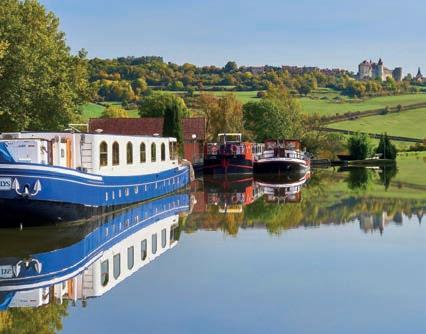
7
Boat along Burgundy’s Canal de Bourgogne
Few outdoor activities are so well aligned with the traditional vision of France’s unharried lifestyle as canal boating. And for those looking to lessen the impact of their travels, it also makes for the perfect slow adventure.
In Burgundy, you can trundle a section of the Canal de Bourgogne, passing through architecturally dashing provincial capital Dijon and the abbeys, chateaux, vineyards and medieval towns that bead the 242km course between Laroche-Migennes and St-Jean-de-Losne.
This is France’s most bucolic waterway, and no boating experience is required to captain a self-drive vessel rented from France Afloat (franceafloat.com) or Locaboat (locaboat.com) in Joigny.Along the way, be sure to stop and cycle tree-shaded towpaths, stock up at local wineries and collect baguettes from the harbour master. Also try… Pair boating with wine tasting on the Canal de la Marne au Rhine,Alsace, or try piloting a barge around Angers or Le Mans.

8Go landsailing on the Côte d’Opale, Hauts-de-France
The sight of sandyachts wafting down the beach is synonymous with the Opal Coast of northern France, where the seaside resort of Le Touquet is a great spot for beginners.
The first sandyachts, or char à voile, appeared on the sands here in the early 20th century, complete with wooden wheels and a stubby sail. Soon these rudimentary carts developed lightweight chassis and bicycle wheels better suited to hurtling the wet sand flats. But while modern sandyachts fly four
times faster than the wind, amateur pilots at the Centre Nautique de la Manche Bertrand Lambert (letouquet.com) on Le Touquet’s chic Paris-Plage will be lucky to top 65kph. Alsotry… Other landsailing hubs can be found in Berck-sur-Mer on the Côte d’Opale, and just south of there in Fort-Mahon and Quend.
9Stargaze from the top of Pic du Midi de Bigorre, Pyrénées
One of France’s true authentic wildernesses spans the country’s border with Spain in the Pyrénées.This rugged mountain range is as old as 100 million years, and its star-studded dark skies were dazzling astronomers
long before the world’s oldest high-mountain observatory was built on the summit of Pic du Midi de Bigorre (2,877m) in 1878. Guided evening ascents (13km; 750m elevation gain) shine a light on the infinity of starry constellations that make the Pyrenean night sky above Pic du Midi a designated Dark Sky Reserve (espritparcnational.com).
Alternatively, non-hikers can summit Pic du Midi by cable car in just 15 minutes and stay overnight. Hole up for an evening of stargazing preceded by a gourmet sunset dinner at the observatory hotel (picdumidi.com). Also try… Both Mercantour and Cévennes national parks and Vercors Regional Park are all International Dark Sky Reserves.
⊲
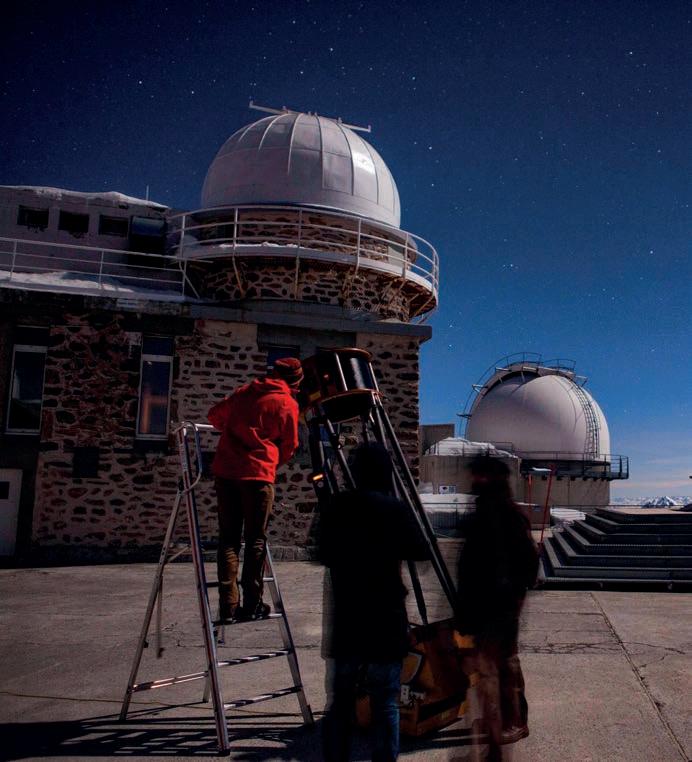
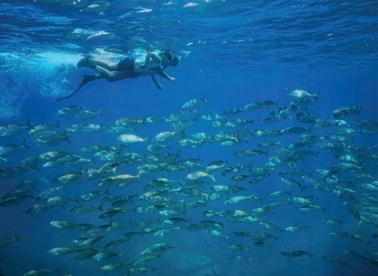
10
Snorkel the seas around Port-Cros, Côte d’Azur Posidonia seagrass meadows – some as deep as 40m – provide a lush habitat for the 180 fish species that thrive within Port-Cros National Park, Europe’s oldest marine park. To reach them, join any of the ferries that yo-yo between the Riviera seaside towns of Hyères and Le Lavandou and Île de Port-Cros. On reaching this green dot of an isle, head for La Palud beach, where you can don snorkel gear and plunge beneath the waves to discover an aquatic world of sea bream and groupers, green wrasses, spiky red scorpion fish, sea urchins and secretive anemones.There is also an offshore underwater trail to explore, delineated by six yellow buoys that extend as far as the tiny isle of Rocher du Rascas. Also try… Check out the snorkelling trail at nearby Domaine du Rayol, east of Le Lavandou.

11
Climb like a pro in Forêt de Fontainebleau, Île de France
With sport-climbing making its Olympic debut at this year’s Summer Games in Paris, it’s only fitting that a bouldering mecca lies just 65km from the capital. Climbers from all over the world congregate in the thick oak, beech and chestnut forests west
of Fontainebleau’s emblematic chateau to tackle thousands of boulders formed from white sand deposited 35 million years ago. French kings hunted game here for centuries; now climbers can pick their way along 20,000 bouldering problems (sequences of holds) of all grades. Breadcrumb trails painted in coloured numbers on the rocks ease the way for beginners cutting their teeth
on yellow, orange and blue circuits. And if you don’t know where to start, try booking a Sunday-morning initiation session with a bouldering instructor at Fontainebleau tourist office (fontainebleau-tourisme.com); these are run between April and October. Also try…The climbing routes and via ferrata in Dentelles de Montmirail, Provence, make fine use of its chain of limestone mountains.
12
Swim crystalline waters around Île de Beauté, Corsica
France has no shortage of wild swimming spots; the country is wrapped by 5,500km of coastline, and its lakes and iconic rivers offer endless freshwater escapes. However, if
you want to be surrounded by pure natural beauty and gin-clear waters lapping pearlwhite beaches, turn your attention to Corsica.
Most enticing of all is the chance to bookend your swims with a larger adventure. Combine with trekking the 26km-long Sentier des Douanes coastal path around Cap Corse,
taking a 4WD ride along dirt tracks to remote beaches in the Agriates desert, grabbing a taxi boat to the tiny Lavezzi islands off the southern coast or sailing to a far-off anchorage at sea. Also try… You’ll find some incredible open-water swims in Antibes, St-Tropez and Villefranche-sur-Mer on the Côte d’Azur.


13
Take a bog walk in the Jura mountains of eastern France
A side to France that few travellers encounter are its wild and green tourbi•res (peat bogs).These humid wetlands teem with wildlife and include some great rambles, frequently accessed via wooden boardwalks built above the fragile bog.
In Haut-Jura, a green haven in the east protected by its own regional nature park, trails through peat bog surround the highest lake in the region, Lamoura (1,155m), and offer the chance to spy carnivorous sundews that trap insects with the hairs on their leaves.There’s more rare flora and fauna to be enjoyed in the peat bogs of Frasne, a reserve less than an hour’s drive north, where you can follow a 4.5km discovery trail. Also try… The south-west also has many bog walks, with Mées in Les Landes,Vendoire and Dordogne serving up incredible variety.
Alamy
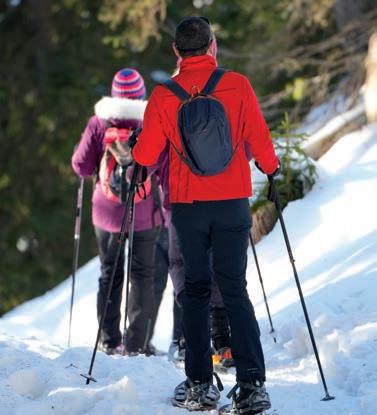
14 Snowshoe in La Plagne, French Alps
For those who want to flee the slog of the pistes and head into nature, snowshoeing is the perfect retort. In the downhill ski resort of La Plagne, a child of France’s radical 1960s Plan Neige, which saw a flurry of resorts built ever higher in the mountains, snowshoeing in the little-known protected area of La Cembraie offers a lesson in alpine flora, fauna and slowing down. Its rollercoaster landscape of snow-covered sink holes interspersed with gypsum rock needles, stone pines and larch trees is ideal for a more thoughtful trek – and if you get the chance to playfully tumble off snowy hillock tops into heaps of fresh powder, then so much the better. The occasional call of a nutcracker, the reserve’s natural forester who hoards away pine seeds here each autumn, only heightens the mystique of this unique snowshoeing landscape. Also try… Vanoise, Mercantour and Écrins national parks are all snowshoeing idylls.
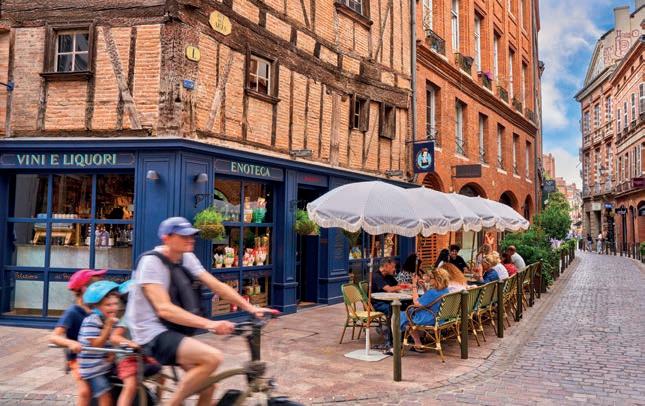
15 Explore Toulouse by bike
Trade the crowds and cacophony of the capital forToulouse in the southwest, where a vibrant café life, epicurean dining and romantic flânerie abound on the riverbanks. It also has more cycling paths than you can shake a baguette at: you could even be forgiven for thinking France’s
fourth-largest city (by population) is a Paris in miniature as you pedal its scenic towpaths. Slow, two-wheel exploration suits Toulouse’s easy-going nature. The city’s public-sharing bike scheme,VélÔToulouse (velo.toulouse.fr), makes light work of getting around, letting you glimpse the Romanesque St-Sernin basilica, the Old Town’s recently reopened Fondation Bemberg and the
400-year-old Pont Neuf bridge with ease. Lengthier routes ribbon through the leafy voie vertes (greenways) by the Garonne river or alongside the UNESCO-listed Canal du Midi – perfect for cyclists keen to make a day of it.You could even pedal the 270km of canal paths betweenToulouse and Bordeaux. Also try… Bike-friendly Strasbourg, Nantes and Grenoble are great for cyclists too.
16
Trek the tricky sands of Baie du Mont-StMichel, Normandy
To soak up the powerful magnetism of France’s most famous abbey, Mont-StMichel, try walking in the footsteps of the medieval pilgrims who risked hell and high water to cross the treacherous sands that encircle it. It’s a trek you won’t soon forget.
The tidal variations in the bay are the biggest in Europe. It’s no wonder that during the Hundred Years War (1337–1453), this abbey-island was the only bit of Norman land not to fall into English hands. Now tales of 14th-century pilgrims being swallowed by quicksand are meat and drink for the guides that lead shoeless walkers across the bay from St-Léonard (lestraverseesdeludo.com).
This 14km barefoot trek through salt meadows, rivers up to 80cm deep and rippled sandflats is a memorable one, but it’s the hands-on lesson in squirming out of gloopy quicksand that will forever stick with you. Also try… You can explore more shifting sands barefoot at Dune du Pilat, Europe’s highest sand dune, which lies near Arcachon on the Atlantic coast. ⊲
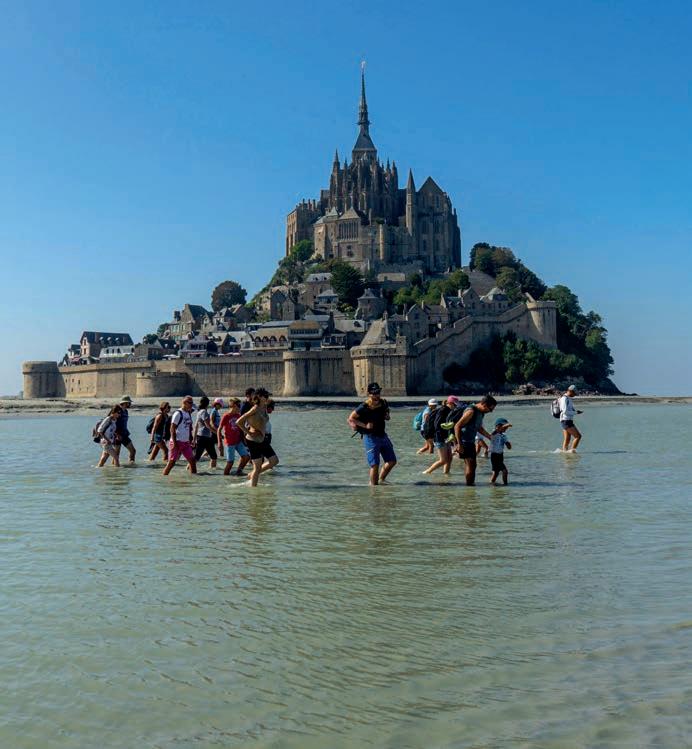
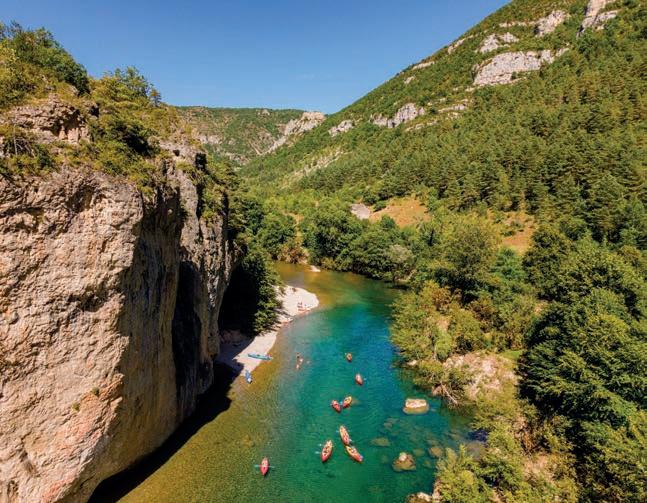
17
Canoe or kayak in the Gorges du Tarn, Languedoc
Motoring or biking the sinuous D907 balcony road through the precipitous gorges carved by the Tarn river is thrilling enough, but on a hot day in the south-west, there’s only one place you want to be.The descent
by canoe or kayak into the Gorges du Tarn thrusts you into the heart of a primeval stone wonder – and it’s a great way to cool off. Kayaks can be rented in Sainte-Enimie (canoe-gorges-tarn.com; canoe-mejean.com), a medieval village clamped improbably onto the cliffs at the gorge’s northern end. One-way paddles to La Malène (13km) and
the Cirque des Baumes (21km) include a lift back to the village. Do also remember to look up occasionally while on the water – griffon vultures can be spotted riding the warm thermals that bubble up from this stone abyss. Also try… Canoeing trips along the Gorges du Verdon in Provence and Auvergne’s Gorges de l’Ardèche are just as wondrous.
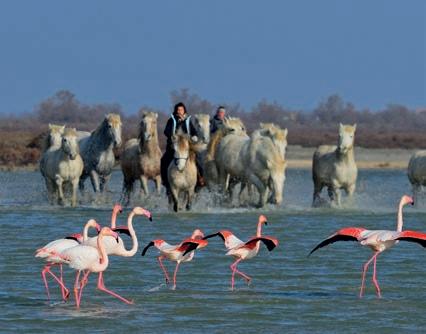
18
Go horse riding in the bird-rich delta of the Camargue, Provence
Splashing through the wetlands of the Camargue, Europe’s largest river delta, on horseback is a quintessential experience, but you don’t need to be a seasoned equestrian to saddle up. The estate of Domaine de la Palissade (manade-a-cheval-palissade.fr) runs trekking tours of the delta for all abilities from its remote perch on the right bank of the Rhône river.
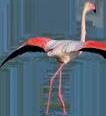

From here, riders forge out amid the salt lagoons, marshes, reed beds and swatches of soft-blue sea lavender, offering a glorious way to take in the wildlife of the delta, including its 400-plus bird species. Mount handsome white Camargue horses for treks along the beach or scenic rides through salt meadows speckled pink by the resident flamingo colony – the only regular nesting site for these birds inWestern Europe. Alsotry…Ride donkey tracks ridden by 19th-century novelist Robert Louis Stevenson in Travels with a Donkey in the Cévennes in Languedoc.
19
Fly with the birds over Lake Annecy, Haute-Savoie
No technical knowledge or expertise is required for tandem paragliding over the glittering blue of Annecy’s eponymous lake. On clear days, views from the air of the surrounding medieval villages, peaks, chateaux and ornately canopied boat jetties are sublime. And because you’ve got someone with you taking care of all the technical aspects, you’re free to soak it all in as a passenger.
Paragliding schools (annecy-parapente.fr; deltaevasion.com) operate from huts in the field beside the Doussard landing zone on Lake Annecy’s southern tip. It’s worth it for the perspective alone: alpine views from the panoramic Col de la Forclaz (1,150m), where the flights take off, are truly celestial. Also try... Fly above St-André-les-Alpes, Haute-Provence, or float over the volcanic hills of the Chaîne des Puys in rural Auvergne.


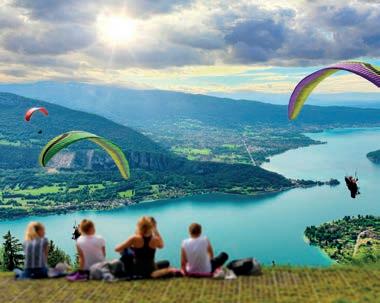




20
Learn to sail in the Golfe du Morbihan, Brittany
With its confetti-like scattering of 40-plus islands and granite-rock inlets, southern Brittany’s Golfe du Morbihan is a sailing idyll where you can sample a bygone France.
‘Mor bihan’ in Breton means ‘small sea’, and the gulf’s sheltered waters are perfect for novice sailors. Learning the ropes on a day cruise aboard the elegant Fleur de Lampaul (fleurdelampaul.fr), a twin-masted oak schooner with rust-red sails that was built in 1948, makes for a fantastic introduction.
Across the water from port town Vannes, in the fishing village of Séné, trips in sinagots (small boats) once used by fishermen are the preferred method of sailing (sinagot.bzh). Also try... Yacht charters let you hop Corsica’s pristine coast and islands from the harbours of Ajaccio and Bonifacio.

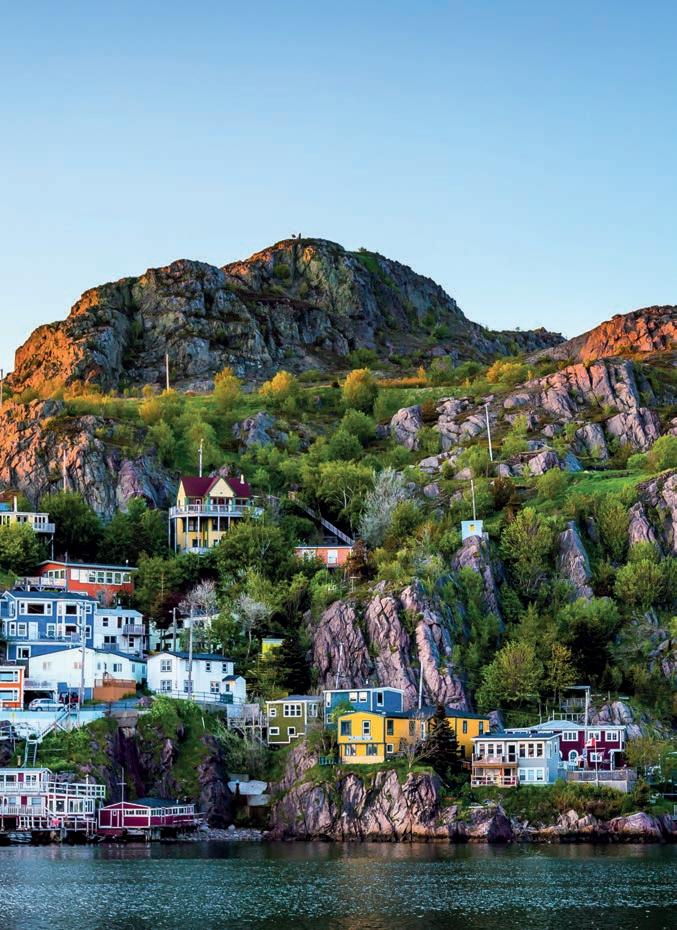



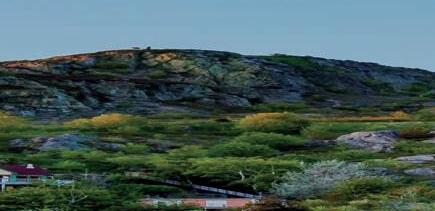

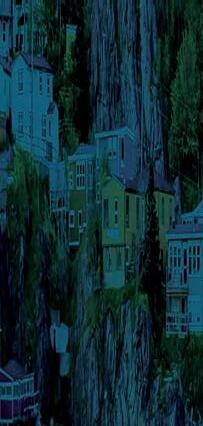
The Wanderlust Club has a great range of exclusive offers, competitions and events for our members – here are just a few. Already a member? Head to wanderlustmagazine. com/your-wanderlust to find out more.

25% OFF Water-to-Go Sugarcane water bottles
Completely free of single-use plastic, this revolutionary plant-based bottle is reusable, recyclable, durable and light. What’s more, the filter technology eliminates 99.9999% of bacteria, viruses, chlorine, fluoride and heavy metals, allowing you to safely drink the water anywhere in the world.

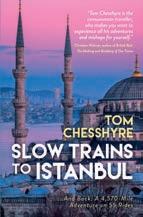

WIN!
A copy of Slow Trains to Istanbul
Travel writer and train enthusiast Tom Chesshyre hit the tracks on a 7,350km interrailing adventure along the old Orient Express route from London to Istanbul. The result is an illuminating and enjoyable read that sums up everything that we love about rail travel. We have three copies to give away.


25% OFF Purchases on the Stanfords website
Stanfords, the UK’s leading specialist retailer of maps, travel books and accessories, has been beloved by explorers and keen travellers since 1853. Members can get 25% off all purchases of the books featured in ‘Read This’ (see p40), and 15% off any other purchases from the Stanfords website.



30% OFF
Bradt Guides books
Award-winning independent publisher Bradt Guides has been specialising in slow travel, off-the-beaten-track destinations, wildlife adventures and quality travel writing for 50 years. Whether you are looking to explore Britain by rail or take a trip to Hokkaido, Bradt Guides is for you. Now members can get 30% off their next purchase.

15% OFF Lorton & Horn
You’ll never struggle to find your passport at check-in again with Lorton & Horn’s stylish organisers, which come in a soft, supple leather (vegan leather is available too). As a Wanderlust Club member, you can get 15% off any of the company’s enticing range of bags, organisers and notebook covers.
Lorton & Horn; Gandy’s; Water to Go
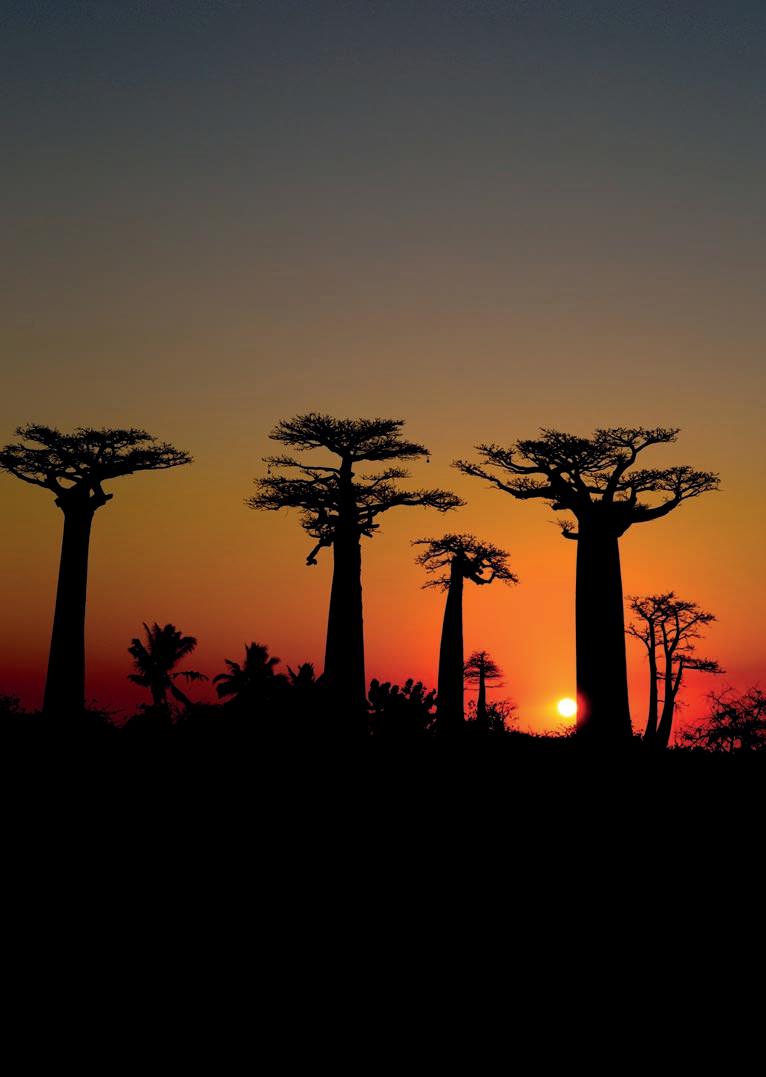

discover
Learn how Oslo became Europe’s next culture star, why Zambia’s safari operators are turning to community tourism and what makes Jersey special, plus lots more
Oslo, Norway
The Norwegian capital has revitalised its cultural scene with the addition of some of the largest museums in the Nordic region, writes Robyn Wilson
Ahuge swathe of investment in recent years has put Oslo’s museum scene on the map. Positioning itself as a cultural magnet to compete with the best in Europe, it has more than made good on its aim, adding two world-class museums and a strikingly designed public library to a roster of architectural landmarks which already includes a magnificent Opera House that visitors can scale for panoramic views of the capital, and a City Hall that reveals itself to be an Art-Deco masterpiece when you step inside.
Among the brightest new stars in Oslo’s cultural firmament are the Munch Museum, one of the largest museums in the world dedicated to a single artist, and the new National Museum, which spans a massive 54,600 sqm. The city’s Nobel Peace Center and the Ski Museum & Tower have also had revamps, with both reopening to the public at the tail end of 2023.
Many of the big-hitting cultural attractions are neatly positioned along Oslo’s harbour promenade, a 9km stretch between Frognerkilen and Kongshavn. Along the way you
can hoover up the Munch Museum and the Astrup Fearnley modern art museum, as well as City Hall, the Opera House and the impressive new Deichman Bjørvika public library. Be sure to also make time to visit one of the many floating saunas along the harbour; a dip in the ice-cold fjord is a weekly ritual for most residents of the city.
Beyond the waterfront, there’s plenty more to explore. Take a day trip to Oslo’s Bygdøy peninsula where a cluster of cultural highlights are found, including the Fram Museum, which examines the heroic age of polar exploration; the Kon-Tiki Museum, where you can learn about the exploits of Norwegian adventurer Thor Heyerdahl; and museums dedicated to Nordic folk culture and maritime history.
A 24-hour Oslo Pass (£39; visitoslo.com) allows free or discounted entry to most attractions, plus free public transport. If all that doesn’t quench your thirst, Oslo has 50-plus museums in total, covering everything from the arts, sculpture parks and architecture to lesser-known history and the world’s first digital Viking museum,The Viking Planet, which is good fun if you have the time.

In with the new (this page; clockwise from left) The roof of Oslo’s Opera House slopes down to the waterfront, so you can walk up it; the Munch Museum is home to 26,000 works; the National Museum has a room dedicated to artist Edvard Munch; (right page; clockwise from top left) the National Museum has 13,000 sqm of exhibition space; there are four versions of The Scream in the Munch collection; the Astrup Fearnley Museum appears to float on the water
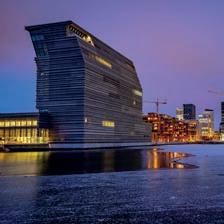

Alamy


NATIONAL MUSEUM
Having opened its doors in 2022, the new National Museum explores four major disciplines – modern and historic art, design, architecture –in one behemoth building, forming the largest museum in the Nordic region.With more than 400,000 objects in its collection, only a fraction (6,500) make it to the exhibit halls; these cover everything from antiquity to the present day.
On the first floor, you can see everything from Roman busts and the Baldishol Tapestry (one of the oldest surviving tapestries in Norway) to contemporary fashion and design.The second floor is packed with modern and historical art, including rooms dedicated to Norwegian artist Edvard Munch and architect Sverre Fehn.The museum’s third floor has been transformed into a vast, luminous exhibition space known as the Light Hall, which runs temporary exhibitions.
Once you’re done here, head over to the neighbouring Nobel Peace Center (see sidebar), located in the city’s beautifully converted 1872 train station. Closed Monday. nasjonalmuseet.no
MUNCH MUSEUM
The story goes that before becoming Norway’s most famous and prolific painter, struggling artist Edvard Munch would try and sell his paintings – including famous works such as The Sick Child and Madonna – to waiters at the city’s iconic Grand Café in exchange for steak and wine. Luckily for us, these have now been collated alongside 26,000 other artworks by the painter for the first time, in what is one of the largest museums dedicated to a single artist in the world. Spread across 13 floors, with 11 exhibition spaces, be prepared to lose yourself in Munch’s dark and captivating works, visiting themes of death, love, anxiety and loneliness. Among them are several versions of The Scream on permanent rotating display, as well as temporary exhibitions that explore his inspiration and process. Once you’re finished, be sure to admire the building itself, which has quickly become an Oslo landmark since opening in 2021.
However, if you’re short on time, visiting the National Museum’s dedicated Munch room is a great way to get a quick primer on the artist, as well as see versions of some of his most famous paintings. Open daily. munchmuseet.no
ASTRUP FEARNLEY MUSEUM
Surrounded by the Tjuvholmen Sculpture Park and with great views of Oslo’s harbour, the Astrup Fearnley Museum displays its collection of international contemporary art across two striking buildings cut asunder by a strip of water.These have been designed by the renowned Italian architect Renzo Piano. Inside, its extensive collection includes significant works by artists Matthew Barney, Paul Chan, Nicole Eisenman, Ida Ekblad and Damien Hirst.The installations are particularly captivating, with pieces such as Børre Sæthre’s My Private Sky seducing and disturbing the viewer in equal measure; it draws its inspiration from the history of cinema and science fiction, and remains on display throughout 2024. Outside, the surrounding sculpture park has several thought-provoking artworks, including Eyes by the late Louise Bourgeois and Ugo Rondinone’s playful 2.5m-high Moonrise busts. Closed Monday. afmuseet.no

BEST OF THE REST
The Fram Museum Delve into the era of early polar exploration at the Fram Museum, located on Oslo’s Bygdøy peninsula. Named after Norway’s first polar ship, which sailed the waters between 1893 and 1912, visitors today can board this huge wooden ship, which is exhibited alongside the Gjøa, the first vessel to sail through the infamous Northwest Passage. frammuseum.no
Ibsen Museum & Theatre
Visit the former home of Oslo’s most famous literary resident, the world-renowned playwright Henrik Ibsen. With its original interiors still intact, this is where Ibsen spent the last 11 years of his life and wrote his final two dramas. An onsite museum provides a deeper insight into his creative process and lasting cultural importance. ibsenmt.no
Nobel Peace Center
This recently refurbished centre guides visitors through the history of the coveted Nobel Peace Prize (named after a Swedish chemist and inventor) while paying tribute to its laureates. It also has temporary exhibitions, such as an ongoing deep-dive into the world of Japanese artist Yoko Ono (until Sep 2024). nobelpeacecenter.org
Ski Museum & Tower
Established in 1923, the planet’s oldest ski museum is located next to the Holmenkollen ski jump hill, which offers fantastic panoramic views of Oslo. For its 100-year anniversary, several of the museum’s exhibitions were refurbished. Learn about skiing’s entry into Norwegian history and how it forms a central part of the country’s identity. skiforeningen.no
Zambia
As Zambia’s safari operators increasingly delve into cultural tourism, both travellers and the country’s many Indigenous communities are feeling the benefit, writes Emma Gregg
Across the world, greetings demonstrate friendliness and mutual respect. In many African cultures, however, they’re considered so crucial that it would be unthinkable to launch into any kind of conversation without them, and taking the time to learn a few greetings during your travels on the continent will almost certainly pay off. But what if you’re exploring a country like Zambia, which has more than 70 distinct languages and dialects?Where do you even start?
While English is Zambia’s official language, you’re likely to hear several others, including Bemba, Kaonde, Lozi, Lunda, Luvale, Nyanja andTonga. Of these, Nyanja is widely used in Lusaka and Livingstone, and is effectively a lingua franca. Begin with ‘Muli bwanji’ (Hello), followed by ‘Muli shani?’ (How are you?), and you’ll be on the right track.
When on safari, try asking your guide about the language they speak; it may lead naturally to a deeper conversation about their background and home life. Zambian culture is very open; to learn more, consider requesting a visit to a local community. Not all Zambian safari companies include cultural activities in their standard daily itineraries; however, village visits can usually be arranged on request.
South Luangwa National Park is especially good for community-based travel. It’s close to the village of Mfuwe, which is home to a variety of community crafts, conservation and development projects, as well as schools
that receive support from safari operators and their visitors.The Bushcamp Company (bushcampcompany.com), for example, co-created the Luangwa Conservation and Community Fund in 2009; since then, it has launched an initiative to provide more than 2,500 schoolchildren with nutritious daily meals, and has drilled over 150 boreholes to supply 36,000 villagers with safe drinking water. Its guided tours allow you to visit Mfuwe to chat to community members about everyday issues and solutions.

It’s also possible to visit the nearby Kawaza Village, a settlement with strong links to Robin Pope Safaris (robinpopesafaris.net). Here, the local Kunda community invites visitors to experience aspects of their culture: you can meet the village chief, visit a clinic and traditional healer, and spend time with local women on their terms, as they go about collecting water, grinding maize and cooking.
For your best chance of an insightful and authentic cultural experience, however, you’ll need to step away from the safari circuit. By timing your trip to coincide with a cultural festival or celebration, you’ll add an unforgettable dimension to your experience.While most festivals are intended for the benefit of the community, respectful guests are welcome.To appreciate and understand the occasion, visit with a local guide who can interpret the event as it unfolds.
the generations; a traditional dance held in the Kawaza Village, where the local Kunda community welcomes visitors wanting to learn more about their culture
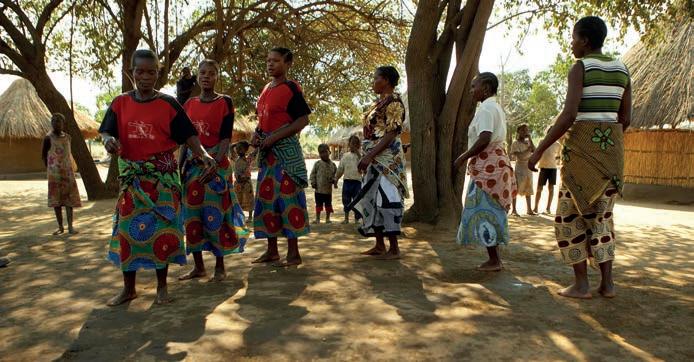
Alamy
Local charm (this page; top–bottom) Textile workshops in the village of Mfuwe can teach visitors about skills that have been passed down through

1 N’cwala
In late February, the Ngoni people of Eastern Province, who trace their origins to the Zulu Nation, converge on the village of Mtenguleni, near Chipata. Here they praise God for the harvest, pay their respects to their ancestral spirits and offer their Paramount Chief gifts of various foods.
The chief, his attendants and the many local dance troupes that take part dress for the occasion in traditional-style capes, kilts and head bands. These were typically made from leopard skins in generations past; however, in a bid to be more wildlife-friendly, most men now opt for fabrics that have been created using man-made fur.
2
Kuomboka
When the long rains taper off and the flood waters of the Upper Zambezi are rising (typically in March or April), the Lozi people of Mongu in Zambia’s Western
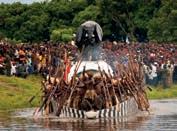
Province come together for a famously spectacular festival to mark the change in the seasons. Kuomboka, which roughly translates as ‘Get out of the water’, is a one-day event in which the Litunga (the Lozi king) and his entourage relocate from their summer palace on the floodplains of Lealui to their winter palace in Limulunga, which sits on much higher, less sodden ground.
Expect an impressive flotilla of canoes with dozens of polers bedecked in scarlet hats, plus plenty of music, ceremony and celebration.
3
Ukusefya Pa Ng’wena
The Bashilubemba, the royal family of the Bemba people, Zambia’s largest ethnic group, host an impressive festival in Ng’wena, near Kasama, during either August or September. This event celebrates their history and heritage, as well as their past victories.
The highlight is the re-enactment of the Bemba people’s journey from Kola (in modern-day Angola) to Lubemba (in Zambia). When they reached the banks of the River Milando, they came across a crocodile, and since Bemba rulers belong to the Crocodile Clan, they took this as a sign that they should claim the land as theirs.To commemorate this, the Paramount Chief, or Chitimukulu,
is paraded through the crowds on a sedan chair shaped like a crocodile.
4 Mutomboko
The Lunda people celebrate their historic migration across the Luapula River and into Zambia with a two-day festival in July that is held in Mwansabombwe.When the festival reaches its peak, the Mwata (or Paramount Chief), dressed in a voluminous skirt called a mukonso and holding a ritual sword known as a mpoko, performs a victory dance.
During his performance, the Mwata points his sword south, north, east and west, then directs it downwards and flings it up so as to indicate that only God is above him.
5 Likumbi Lya Mize
Dancing shoes (this page; clockwise from top left–bottom) The N’cwala ceremony celebrates the first fruits of the year; masked Makishi dancers help young Luvale boys on their path to adulthood; a flotilla of canoes mark the Kuomboka, when the Lozi king heads for higher ground as the plains flood
The Luvale people celebrate Likumbi Lya Mize towards the end of August. Held on both sides of the Zambezi River in North Western Province, this festival features drumming, singing and frenetic dancing by those wearing huge, hand-painted masks of Makishi,ancestral spirits that have returned to the living to assist young boys (aged eight to 12) in their journey to adulthood. Some of their dance moves act out the life skills that every boy is expected to learn.
The masquerade forms the final part of the boys’ mukanda initiation, a rite of passage that can last months, and it is recognised by UNESCO for its importance to Zambia’s Intangible Cultural Heritage.

Five festivals where you can experience Zambian culture

San Cristóbal de la Laguna, Tenerife
Look familiar? The original capital of the Canary Islands went on to become the much-replicated blueprint for colonial Spanish cities across the Americas, writes Debbie Ward. But it all began on Tenerife…
“Santa Cruz was nothing… a tiny town, a fisherman’s town,” guide Jaime Muñoz scoffed, referring to one of the two present-day capitals of the Canary Islands. He presented a 500-year-old map of Tenerife and pointed to San Cristóbal de la Laguna, which was around the same size as it is today; this, he explained, was the first capital, the first European-style development on the island and, crucially, the first Spanish colonial town without walls.
The usual fortifications were dispensed with in favour of a naturally defensive position in a valley, hidden from would-be attackers arriving by sea.This approach is partly why La Laguna, as it’s known locally, has World Heritage status today; it allowed for a different way of building a town.
While the upper section was largely unplanned, the lack of fortifications meant the lower town was able to be to built more strategically, using a pioneering grid-style layout with wide streets wrapping a main square. It would become the blueprint for future Spanish expansion, replicated across its colonies in the Americas.The town’s design and architecture is now familiar in cities ranging from Lima and Old Havana to Cartagena and Quito.
“People come here and say it is similar to these places, but no, it’s the other way around,” Jaime told me.
“The town’s design and architecture is now familiar in cities ranging from Old Havana to Cartagena”
It wasn’t just geography that shaped La Laguna; the Spanish took their influences from Africa, referencing Moorish riads and geometric carvings in the architecture of the town, which, according to UNESCO, ‘combin[es] Islamic and European elements’.
Today’s visitors to La Laguna can savour cobbled streets that wrap four main squares, lined with mansions shaded in hues of pastel and terracotta. Its public buildings and cafés retain their hidden courtyards, edged with carved balconies supported by pillars of hard-wearing dark pine. Sat in the shade of a palm tree, with the soothing trickle of a fountain for company, they offer pleasing respite from the sun.
You can get an aerial glimpse of the old town from the five-storey bell tower of the Church of the Immaculate Conception. Many of the city’s mansion houses are also open to
A true original (this page; above) Following the invasion of Tenerife by Spain in 1496, La Laguna became the island’s first capital, making it the heart of political power here until it lost its title to coastal Santa Cruz in the early 18th century, which by then had grown into a busy port. Today, you can still see the relics of its early heyday in the colourful townhouses that line the streets
visitors; these include the 17th-century Casa Salazar, a former bishop’s residence with a decorative exterior, as well as the 18th-century Cayetano Gómez Felipe House Museum, the one-time home of a notable Canarian collector. Further suggestions can be gleaned from the tourist office, which occupies the 17th-century Casa de los Capitanes Generales.
An hour’s drive from the popular resorts of the south coast, La Laguna is the sort of place that those involved in the recent overtourism protests in the Canaries would rather responsible travellers visit, instead of the oversaturated coast. It also works well as a base of exploration for nearby Anaga Rural Park and can be easily combined with the lower-key northern resorts of Puerto de la Cruz and Garachico.
The vibe is more old-school Spain here. Instead of all-day English breakfasts, you’ll find family-run bakeries, their windows lined with pastries stuffed with sweet potato and guava. More local produce is piled high in the morning food market, where cactus fruits, the island’s famous black potatoes and short bananas sit alongside peppercorns, meat, fish and cheese.
As recently as a century ago, arable farming was the main business here. Historically, La Laguna’s attic rooms, identifiable by their circular windows, were often used for grain storage, indicating the town’s wealthier homeowners – typically those who’d helped with
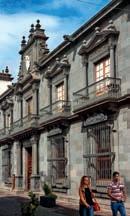
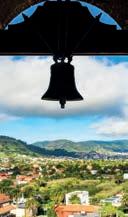
the Spanish conquest of the Americas and been rewarded with land.
“Early tourism was seen as a positive because it started to redistribute wealth more equally,” Jaime explained. The arrival of Tenerife’s first university also helped the city become a cultural hub, and its abundance of independent galleries is one of many boons.
Among the more curious aspects of La Laguna is its name.The ‘laguna’ refers to what UNESCO calls an ‘insalubrious lagoon’ around which the settlement was first formed. It no longer exists, having been drained in the 19th century to rid the streets of mosquitoes. But while the lake may be gone, you can still people-watch beside a fountain in shady Plaza del Adelantado, the founding square from which not only La Laguna evolved but also, ultimately, cities across Latin America.
Stroll through time (this page; clockwise from top left) The 17thcentury exterior of Casa Salazar hides an exhibition hall and a glorious central courtyard within; climb the bell tower of the Church of the Immaculate Conception for views across the old town; though it lost its title of capital, La Laguna remained the cultural centre of the island for centuries – the first university on Tenerife was even founded here in 1792

Need to know


Location
San Cristóbal de la Laguna lies in the north-west of Tenerife, around 11km from Santa Cruz.


When to go
Tenerife’s sub-tropical climate means year-round sunshine, though La Laguna’s elevation makes it cooler than on the coast. The city is also the best place on the island to see the annual Easter processions


Getting there & around
La Laguna lies 63km from the South Airport, which receives multiple direct flights from regional UK airports. Airlines servicing this route include Jet2 (jet2.com), easyJet (easyjet.com), British Airways (ba.com) and Ryanair (ryanair.com). The North Airport connects to other Canary Islands and mainland Spain.
On the island, the MTSA tram runs between La Laguna and Santa Cruz (40 minutes). TITSA buses (titsa.com) operate throughout Tenerife and are useful for exploring further.
Guide Jaime Muñoz of Feel Tenerife (feeltenerife.com) offers visits to La Laguna as part of wider tours by electric MPV.


Carbon offset
A return flight from London to Tenerife produces 350kg of carbon per passenger. Wanderlust encourages you to offset your travel footprint through a reputable provider. For advice on how to find one, visit wanderlustmagazine.com/ inspiration/sustainable-travel.


Where to stay
The four-star Laguna Nivaria (lagunanivaria.com; B&B doubles from £112pn) lies behind the façade of a 16th-century mansion. La Laguna Gran Hotel (lalagunagranhotel.com; doubles from £93pn) is a converted 18th-century manor house with a rooftop pool.


Further information
Visit the Tenerife Tourism Corporation’s site for more ideas (webtenerife.co.uk).
Madagascar
With the endemic flora and fauna of the world’s fourth-largest island under threat, does tourism offer fresh hope for saving its critically endangered species, asks Harry Rakotosalama?
Location is everything, or so the old estate agent’s maxim goes. If you ever needed proof that this extends beyond the property market, consider the island of Madagascar, 400km off the south-east coast of Africa. Some 165 million years ago, this landmass broke away from the Late Precambrian-era supercontinent of Gondwana, eventually settling in the Indian Ocean. Today, it’s home to an array of unique flora and fauna that owe everything to its remote location. Madagascar’s geological history helped it to foster a biodiversity estimated to include 200,000 species of plant and animal life, of which 80% to 90% are endemic. The reason for this is simple: millions of years of isolation. This was among the last major landmasses to have been permanently settled by humans, between 2,000 and 10,000 years ago. By then, the island had already evolved a diverse range of habitats, including rainforests, dry forests, sub-desert spiny forest, wetlands and coastal ecosystems. For travellers, Madagascar’s landscapes are spectacle enough, protected across some 40-plus national parks and reserves that range from the sandstone rises of the Isalo (south) to the forestlike spires of karst rock, known as ‘tsingy’, that stretch across huge tracts of the island, the largest spanning 1,500 sq km in the west. In the more remote corners, particularly in the lesser-visited
far north, the land is largely untouched, with few, if any, facilities; camping is often the only option for intrepid visitors, though even here you’ll find luxurious outliers such as the remote and luxurious Anjajavy resort or Masoala Forest Lodge.
Not all areas are so pristine, though. While human interference may have arrived late on Madagascar, reports suggest that illegal logging and habitat destruction has led to the loss of 25% of the island’s forests in the last 20 years alone, with one iconic animal suffering in particular: the lemur. More than 110 species of lemur live here, and only here! But thanks to deforestation, these prosimians now constitute the world’s most endangered group of mammals, with 98% facing extinction within two decades (IUCN).
It’s a complicated situation. Today’s Malagasy, descended from Austronesian settlers and centuries of arrivals from Arabia, India and East Africa, retain a strong connection to the land and sea, which manifests as a deep respect for the environment.Yet the history of conservation on Madagascar (still one of the poorest nations in the world) has often pitted its people’s needs against those of the island’s wildlife. In the growth of nature-based tourism, however, which offers locals a financial incentive to preserve the forests, there lies the potential of a lifeline for both the Malagasy and the incredible biodiversity found here. It’s a dream that is worth chasing.
Utterly unique (right page) Madagascar’s iconic ring-tailed lemurs spend around a third of their time on the ground, more than any other lemur species, and can often be spotted sunbathing in the mornings; (bottom left) the centuriesold Avenue of the Baobabs has miraculously survived the deforestation that has afflicted much of the island


Alamy
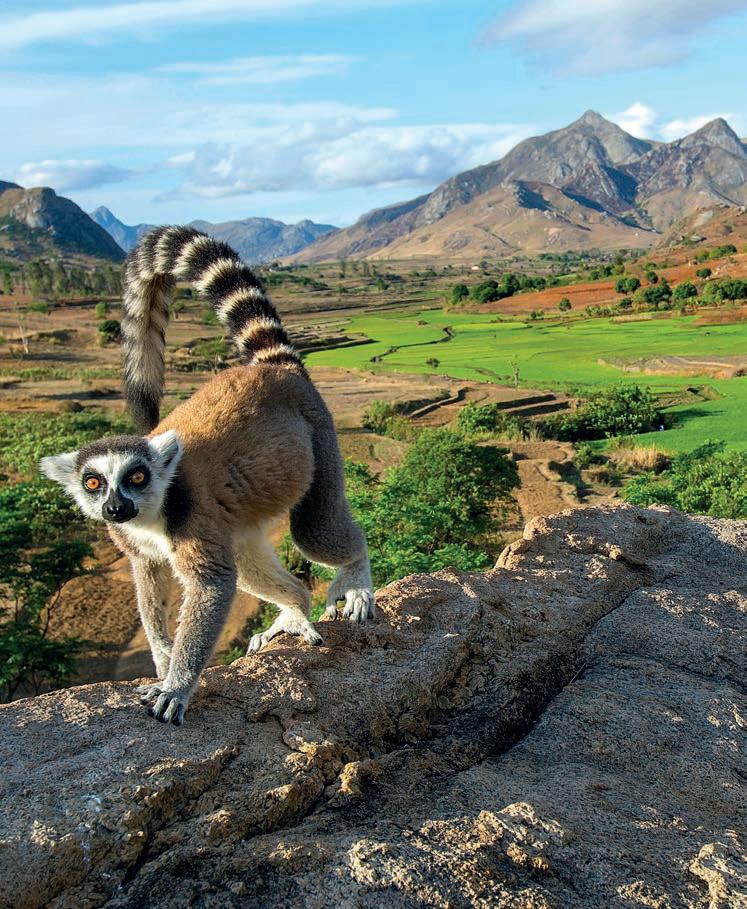

Menabe region
The wider Menabe region is known for its Avenue of the Baobabs, a photogenic road lined with ancient Adansonia grandidieri trees towering up to 25m high. Most visitors, however, head to the region for Kirindy Forest, which claims the world’s highest density of primates for its size. Look out in particular for the Verreaux sifaka, known for its ‘dancing’ gait when on the ground, resembling a kind of sideways shimmy. If you’re lucky, you might even spot the critically endangered Madame Berthe mouse lemur, the planet’s smallest primate, which weighs just 30 grammes.There are giant jumping rats too, which are found only in the Menabe region. Best for: The star sighting for many visitors to Kirindy Forest is the fossa, a cat-like mammal and relation of the mongoose. It is Madagascar’s largest predator (mostly of lemurs), and this is the best place to spot them on the island.
Andasibe
The vast rainforest of Andasibe-Mantadia National Park lies just four hours’ drive east of capital Antananarivo. Here you’ll see a variety of lemurs, including the diademed sifaka, blackand-white ruffed lemur and, most famously, the indri.The adjoining Analamazoatra Reserve, too, is home to habituated groups of indri, making sighting them easier.Visitors can hike through the rainforest in search of a wide range of endemic birds, including the country’s largest forest-dwelling bird species, the Madagascar crested ibis, as well as the impressive Parson’s chameleon (the heaviest on the planet), leaftailed geckos and more than 100 frog species. Best for: Known for their teddy bear-like faces and eerie-sounding calls, the indri are among the largest lemurs on the island and live entirely up among the canopies, able to leap as far as ten metres between branches in search of food.

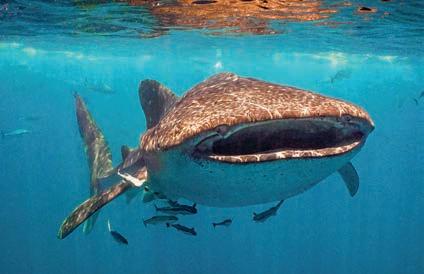
Nosy Be & Sainte-Marie islands
While Madagascar is known for its forest wildlife, its waters are just as compelling. Nowhere is this more apparent than the island of Nosy Be, off the north-west coast, which is an excellent place to swim with whale sharks (Oct–Dec). Be sure to check out its Lokobe Reserve too, home to the rare black lemur and panther chameleon. Alternatively, Sainte-Marie island, off the mainland’s east coast, was a notorious pirate stronghold in the 17th and 18th centuries; now its waters are better known as a worldclass spot for seasonal whale watching.
Best for: Migrating pods of humpbacks arrive off Sante-Marie’s west coast every year (Jul–Sep) to breed and calve in the shelter of the strait. Guided boat tours (often led by marine researchers) can take you close enough to see their elaborate courtship displays in full.
Where else?
Tsingy de Bemaraha National Park
This UNESCO-listed park in the island’s far west is a labyrinthine landscape of razor-sharp pinnacles (tsingy), narrow canyons and caves. Most esxciting of all, the challenging terrain creates isolated microhabitats home to rare endemic species, including Decken’s sifaka and the Madagascar fish eagle.
Isalo National Park
The Isalo is characterised by its sandstone formations, deep canyons and palm-lined oases, which form inviting natural swimming pools. The variety of landscapes that you’ll find here is truly astonishing, ranging from dry deciduous forests to grasslands and wetlands.Take advantage of the picturesque hikes and the chance to spyVerreaux’s sifaka and both red-fronted brown and ring-tailed lemurs.
Ranomafana National Park
Through the spine of Madagascar runs a ridge of mountains known as the Central Highlands; Ranomafana lies on its fringes, covering 40,000 hectares of high-altitude rainforest. On its trails, tourists can seek out some very rare species indeed, including the greater bamboo and golden bamboo lemur for which the park was originally created to protect.
Anja Community Reserve
This small reserve at the base of a large cliff, near the town Ambalavao, is managed by the local community and is particularly notable for its thriving population of ringtailed lemurs.
Anjajavy
Anjajavy, a remote and exclusive resort area on the north-west coast, is reachable only by air. It is known for its pristine natural beauty, luxurious accommodation and 10,803 hectares of private nature reserve. The area is also home to 1,800 species of plant as well as localised lemurs such as the tiny Danfoss’s mouse lemur.
Marojejy National Park
Set in the remote and little-seen northeast of the island, this park is a haven for birdwatchers and hikers, thanks to its mountainous terrain. This poses its own issues for visitors, but should you want to test your legs, the challenging multi-day Mantella and Simpona treks reward with the possibility of sighting the critically endangered and ghost-like silky sifaka.
Masoala National Park
The Masoala peninsula, high in the north-east, is home to the largest stretch of lowland rainforest on the island and is accessible only by boat.Those who arrive here are lucky indeed, and should look out in particular for the red-ruffed lemur, a rare species that is endemic to the area.
Ankarana National Park
Known for its tsingy formations and underground caves and rivers – some of which contain crocodiles and blind cave fish – an air of adventure surrounds this park in the remote northern tip of the island. Keep an eye out for sightings of the crowned lemur, which is found only in the north.

Need to know


When to go Winter (May–Oct) is the dry season and busiest time on the island, while the shoulder months (Mar/Oct) offer a more relaxed period. Summer (Nov–Apr) sees the rains arrive, with roads in some parks becoming impassable; cyclone season lasts from January to March.
Whale-watching season in Sainte-Marie runs from July to September; whale sharks can be spotted in Nosy Be from October to December.


Getting there & around
There are no direct flights between Madagascar and the UK. Connecting services from London typically go via Paris or Addis Ababa with Air France (airfrance.co.uk) or Ethiopian (ethiopianairlines.com) respectively. These cost from around £657 return and take about 14 hours.
Many roads on the island are in poor condition, and travel can be slow. A 4WD vehicle is a must for remote areas, while internal flights are often used for travelling long distances. A lack of lodges in the busier wildlife areas also means that stays can be fully booked for up to a year in advance, so plan ahead.
Tour operators offering tailor-made trips to Madagascar include Rainbow Tours (rainbowtours.co.uk).


Carbon offset
A return flight from London to Antananarivo via Paris produces 1,140kg of carbon per passenger. Wanderlust encourages you to offset your travel footprint through a reputable provider. To find one, visit wanderlustmagazine.com/ inspiration/sustainable-travel.


Currency & visa
Currency: Malagasy ariary (MGA), currently around MGA5,680 to the UK£. Visa: Not required by UK visitors for stays of up to 15 days.


Further information
Madagascar tourism –madagascar-tourisme.com
A rugged land (above) Sunset over Tsingy de Bemaraha National Park; (left page; top to bottom) wildlife ranges from the giant Parson’s chameleon to shuffling Verreaux’s sifaka and whale sharks
Jersey
Katie Scott discovers that the past is never far from the surface on the southernmost Channel Island, as she explores Jersey’s medieval castles, prehistoric sites and wartime relics
It was the unmistakable sound of metal on metal that confirmed to detectorists Reg Mead and Richard Miles that, after nearly 30 years of exploration, they had uncovered treasure in a field in Jersey: a hoard of nearly 70,000 late Iron Age and Roman coins. As it was removed from the ground, the two men knew they’d found something unique. It’s a feeling that is common to visitors in this corner of the English Channel. History sits close to the surface on Jersey, a 120 sq km island that lies nearer to France than to England, where German gun placements and 14th-century ruins still glower across the sea and cows graze around Neolithic dolmens.This frontier land has witnessed prehistoric migrations, Napoleonic battles and occupation during the SecondWorldWar; it also still has the capacity to surprise. Proof of this lies in a visit to La Hougue Bie, one of the oldest buildings in the world, where you can now glimpse the coin horde uncovered by Reg and Richard in its museum. It’s not just ancient history that you’ll find here. In capital St Helier, you’ll see nods to the island’s
prolific shipbuilding past, an era when more than 800 vessels passed through the shipyards of St Aubin’s Bay. Elsewhere, Gorey’s fishermen once ventured as far as Newfoundland on trips that sometimes lasted years before they saw the village’s looming Mont Orgueil Castle once more. With such a history of seafaring, it’s no shock that Jersey has a tale or two to tell. In Bouley Bay, for example, a monstrous black dog was reported to have haunted residents for years, although this particular story may be rooted in another aspect of the island’s maritime past, having likely been a cunning ruse by smugglers to avoid prying eyes. Jersey’s shipbuilding industry may be gone, but one legacy of its seafaring history still present is the mingling of cultures that have filtered through its port down the centuries.While the modernday equivalent of this is the foreign-accented financiers who spill into the bars of St Helier on Friday nights, pick a more bucolic setting for the evening and you might still catch the odd word of Jèrriais (Jersey’s old Norman dialect) as locals share their own tales of island life.
49.1805° N, 2.1032° W

Ask a local
“The [German] occupation is the event that people can most readily relate to, but Jersey was also invaded in 1781 by the French, and that’s commemorated here too. Militarisation has hugely impacted the island; you can also see our domestic history everywhere, from cider presses to early farm buildings.”
Author, historian and tour guide, Ian Ronayne


Alamy; Dreamstime; Ian Ronayne

The history Channel (this page) Climb the 200 steps to the top of Mont Orgueil Castle, which was a key English defence on Jersey when it was built in the early 13th century, though it was finally conquered in 1461 after a deal was struck by the wife of the recently deposed King Henry VI, Margaret of Anjou, to secretly deliver it into French control; (left page) relics of the Second World War are everywhere on Jersey, which was occupied by Germans troops (1940–1945) during the Second World War when the British opted to neither defend nor evacuate the Channel Islands, instead leaving it to locals to decide their fate
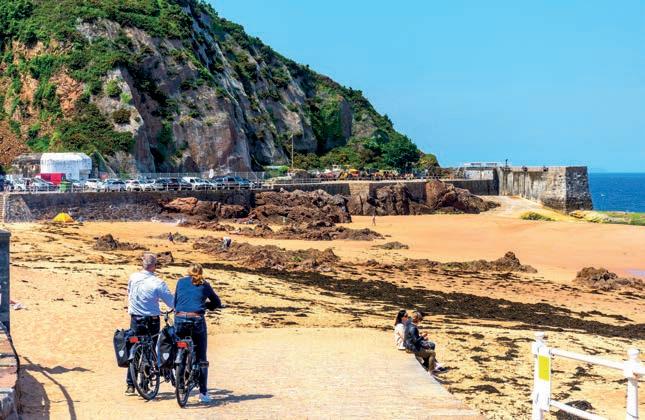
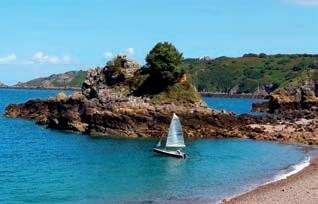



Time and tide (this page; clockwise from top left) Greve de Lecq beach straddles the parishes of St Mary and St Ouen and is fringed by forested slopes and charming country pubs worth exploring; the 150-year-old La Corbière lighthouse can be reached via a causeway at low tide; Plémont Bay is wrapped by sea caves and even has its own fresh-water falls; wander the ruins of the 14th-century Grosnez Castle, which Philippe de Carteret held against the French even after half the island fell to the invaders in 1461; boating in Bouley Bay, home of Mad Mary’s café and a popular spot for kayaking, sailing and diving



DAY 1
Start off at Grève de Lecq beach in the north; Colleen’s (01534 481420) is always popular, so get there early for a big breakfast. Next, head to the nearby barracks, which date from 1810; from there you can admire the Napoleonic-era Round Tower in the bay. You can also scan the horizon for dolphins playing off Les Pierres de Lecq from the terrace of the The Prince of Wales (theprinceofwalesjersey.com).
Now head to the ruined 14th-century Grosnez Castle, and then on to spy puffins (Mar–Aug) and German defences at nearby Plémont
Take a moment to think about the prisoners of war who built the walls and bunkers, then stroll the Five Mile Road to watch surfers and some of the biggest tides in the world. Stop off at the Jersey Wetland Centre for views of La Mare au Seigneur (SSI), a nature reserve home to more than 200 bird species, then follow the coast south to La Corbière lighthouse, first lit 150 years ago to guide sailors away from the wild Atlantic coast. Watch the sun go down from here, or better still, with dinner at the Corbière Phare (corbierephare.com) restaurant and bar.




DAY 2
Begin the day with a cuppa at Mad Mary’s (07797 724964) in serene Bouley Bay, near to where the naturalist and writer Gerald Durrell founded Jersey Zoo. In the island’s interior lie the War Tunnels, a Second World War-era underground hospital complex built under German occupation (1940–45) using forced labour; the exhibitions inside bring the lost voices of those who dug these passages to life. Nearby lies Le Moulin de Quétivel, a working mill that was built in the 18th century, although activity on this site traces back to 1309; buy some flour that has been milled onsite and then stroll the surrounding water meadows. Head further back in time at La Hougue Bie, site of a Neolithic passage grave (4,000–3,500 BC) that is one of the oldest buildings in the world and a museum housing the planet’s largest Celtic coin hoard. Above the grave sits a 16th-century Christian chapel. Finish back on the coast at the pastel-hued village of Rozel; the old fort next to the beach is now a beautiful private home. End your day by watching the fishing boats bob by as you tuck into the fare of the Hungry Man café.
Getting there: You can reach the island by sea or air. Condor Ferries (condorferries.co.uk) depart from Poole or Portsmouth. Several carriers currently fly into Jersey from the UK and Ireland, including British Airways (ba.com) and EasyJet (easyjet.com). Download the Jersey Taxi and LibertyBus apps while you’re waiting to travel. Stay at: Jersey Heritage (jerseyheritage.org) lets you book from a selection of self-catering cottages that offer a taste of local life; try the 1930s seaside folly known as the Seagull, which sits among the dunes at St Ouen’s Bay. If you want a bit more cosseting, L’Horizon in St Brelades Bay (handpickedhotels.co.uk/lhorizon) boasts sea views, a relaxing spa and famously attentive staff.
4 TOP THINGS TO DO
HIKE the Jersey Coastal Path, a 77km circular ramble taking in Martello towers, beaches and sea views. If you prefer a shorter stroll, visit Val de la Mare Arboretum, a haven for trees from around the world that has a charming 4.5km circuit, or follow the Railway Walk (6.5km) along a disused line from St Aubin to Corbière. Details of all these routes can be found on jersey.com.
LEARN
about the history of the island. Jersey Heritage (jerseyheritage. org) offers a Heritage Pass allowing access to four historic sites or museums for the price of three (£44). Visit the towering Mont Orgueil castle, drop by a 15th-century farm estate or witness a 6,000-year-old dolmen while unpicking the story of Jersey.
SURF with those who know the tides. Grab a board out in St Ouen’s Bay under the guidance of a seasoned surfer from the Splash Surf Centre. The team offer private coaching as well as group lessons. splashsurf.uk
DRINK a glass of wine at La Mare Wine Estate, Jersey’s only vineyard and distillery. If you join a tour (from £16.95), be sure to pick up a jar of black butter at the end to bring home. lamarewineestate.com

Alamy; Jersey Heritage
Island life (this page; clockwise from top left) POWs were forced to dig tunnels beneath Jersey during German occupation in the Second World War; La Hougue Bie was used for ancient rituals; stroll the island’s only vineyard and distillery; you can now spend the night in Seymour Tower, which is cut off from land twice a day by the tide
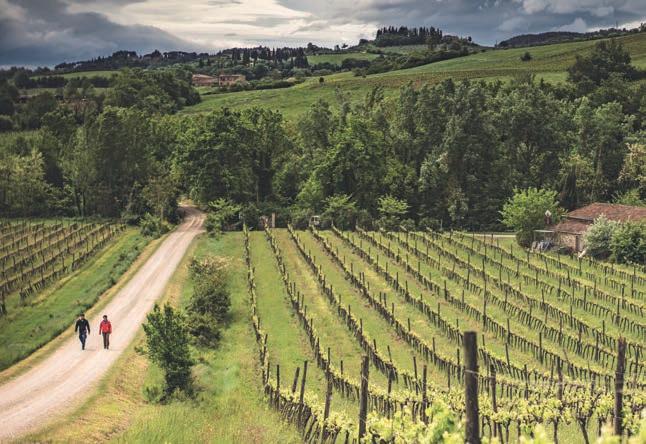






















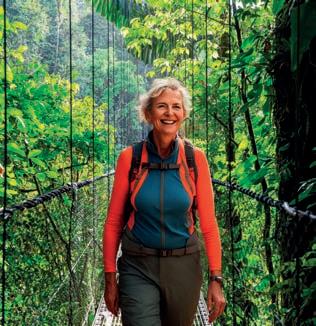


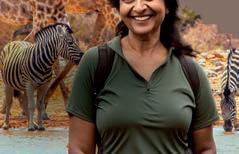

Next issue on sale 19 September 2024

+ MEGA 260-page issue!
The world’s best new railway journeys Greenland (without a cruise) 52USsecrets The soul of Hawaii

The best expedition cruises Anatolia across history An intergenerational travel odyssey Isle of Man

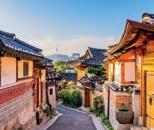

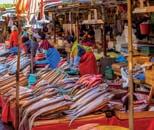

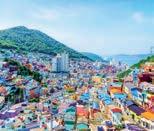


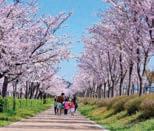



South Korea quiz
South Korea is at the epicentre of a cultural wave washing over the world. But while you might be able to tell K-pop from kimchi, how much do you really know about it?
1Seoul was the power centre for the Joseon dynasty for 500 years. How many royal palaces is it famously home to?
a. One
b. Three
c. Five
d. Ten
2The Bukchon ‘village’ in Seoul is famed for its concentration of 900 hanok. What are they?
a. Temples
b. Traditional houses
c. Museums
d. Soju distilleries
3
Jeju island is known for its haenyeo, a community of women who practise a unique, UNESCO-listed profession. What is it?
a. Stitching pojagi quilts
b. Guiding visitors
c. Freediving for seafood
d. Milking snakes
4In which city can you visit Jagalchi, the largest seafood market in South Korea?
a. Busan
b. Incheon
c. Seoul
d. Daegu
5Which island is famous for both its eponymous dog breed and ‘Miracle Sea Road’ – a 2km-long crossing revealed by the tide for a short time in April?
a. Seongapdo
b. Udo
c. Wolmido
d. Jindo
6
The colourful village of Gamcheon, near Busan, is known as the ‘______ of South Korea’?
a. Venice
b. Santorini
c. Pompeii
d. Birmingham
7UNESCO City of Gastronomy
Jeonju is particularly associated with which Korean dish whose name translates as ‘mixed rice’?
a. Tteokbokki
b. Bulgogi
c. Galbi
d. Bibimbap
8
The Hwacheon Ice Festival sees thousands of people turn up to catch what?
a. Mountain trout
b. A cold
c. Each other
d. Snowballs
9What public facility in Gangneung became an iconic tourist stop after it featured on the cover of a BTS album?
a. A metro station
b. A bus stop
c. A swimming pool
d. A public toilet
10
Gyeongju is known as the ‘museum without walls’, and has put in place a ban to ensure it retains its historic character. What has it outlawed?
a. Chewing gum in public
b. Building high-rises
c. Taking selfies
d. Digital watches
11What name is given to the street of major entertainment labels in Seoul where the Gangnamdols (bear statues that represent K-pop idols) are found?
a. K-Star ROAD
b. Blackpink STREET
c. K-Bear AVENUE
d. Superstar BOULEVARD
12The World Peace Gate was erected to mark the year Seoul hosted the Olympics. In what year did the Summer Games arrive?
a. 2012
b. 2000
c. 1988
d. 1972

Peter Momoh Bassie
Highly commended at Wanderlust’s 2023 World Guide
Awards, Peter has been a guide in Sierra Leone all his adult life. He tells us about using his personal story to help visitors
Much of the history of Sierra Leone–fromtheslavetradetothe civilwar(1991–2002)–isdifficult. How do you make it engaging without it becoming too heavy?
It’s about how you present it.The civil war, for example, is part of the modern story of our country, along with slavery. I tell our history from pre-colonial times to the present day, but when I get to the war, I explain my own story. When I say that I was a child soldier, everyone wants to know more about it.
You weave your life into tours?
One of the places I look forward to showing people is the province where I was born and where I was captured aged 11.My village is where my mother was buried in a mass grave during the war. I refer to this as impact tourism.
Howdidyougofromchildsoldier to becoming a tour guide?
After the war, I travelled home to my village. I saw my brothers and they were scared of me. I didn’t even sleep in the house; I slept outside. If you looked at me, I’d be angry with you.

At this time there were lots of organisations, missions and programmes to help counsel people. I began counselling and became a practising Catholic.That helped me a lot.
At the age I was captured, I was in secondary school. Six years later, after the war, I went back to school.When I’d finished, a man explained to me the benefits of tourism. Because of the condition of the country then, many people came on behalf of NGOs, businesses and missions, and they needed guides. Now they come for tourism.
Whatarepeople’sreactionswhen they visit historical sites such as the slave fort on Bunce Island?
Curiosity. People want to know our history; they want to know its stories and how Sierra Leoneans feel – especially when it comes to slavery. In some visitors you can even see remorse for what their country has done.
Beyond capital Freetown, where should visitors go?
There is great nature here, in the wildlife sanctuary of Tiwai Island or our highest peak Bintumani Mountain (1,945m). Go to Tacugama Chimpanzee Sanctuary to see the chimps, or to Gola Rainforest National Park for pure jungle – it’s so big that it spreads over the border into Liberia. There are chimps in Gola too, and it’s also where local people would travel to get traditional medicines.
A tale to tell (top & below) Peter Momoh Bassie has been guiding visitors to Sierra Leone since leaving school, and uses his own story to ground the often tragic modern history of his country in something that travellers can relate to
When I’m in Gola forest, it reminds me of when I was a young boy in the Secret Society (a rite of passage among children in many Sierra Leonean villages).These are traditional schools for training young boys and girls.We were shown how to set traps and take care of the home, and to look for signs in the forest for finding directions.
Any tips for first-time visitors?
Bring disposable cash. There are ATMs here, but they are not all over.
What is the strangest question you’ve been asked as a guide?
Here in Sierra Leone you see people carrying things on their head, such as baskets of charcoal – I’ve seen nine, maybe ten baskets at a time. Guests ask: “Where do they learn this?” But there is no college for that, my friend.
Peter is a guide atTourism is Life (tourismislife.com)
Peter Momoh
Bassie
